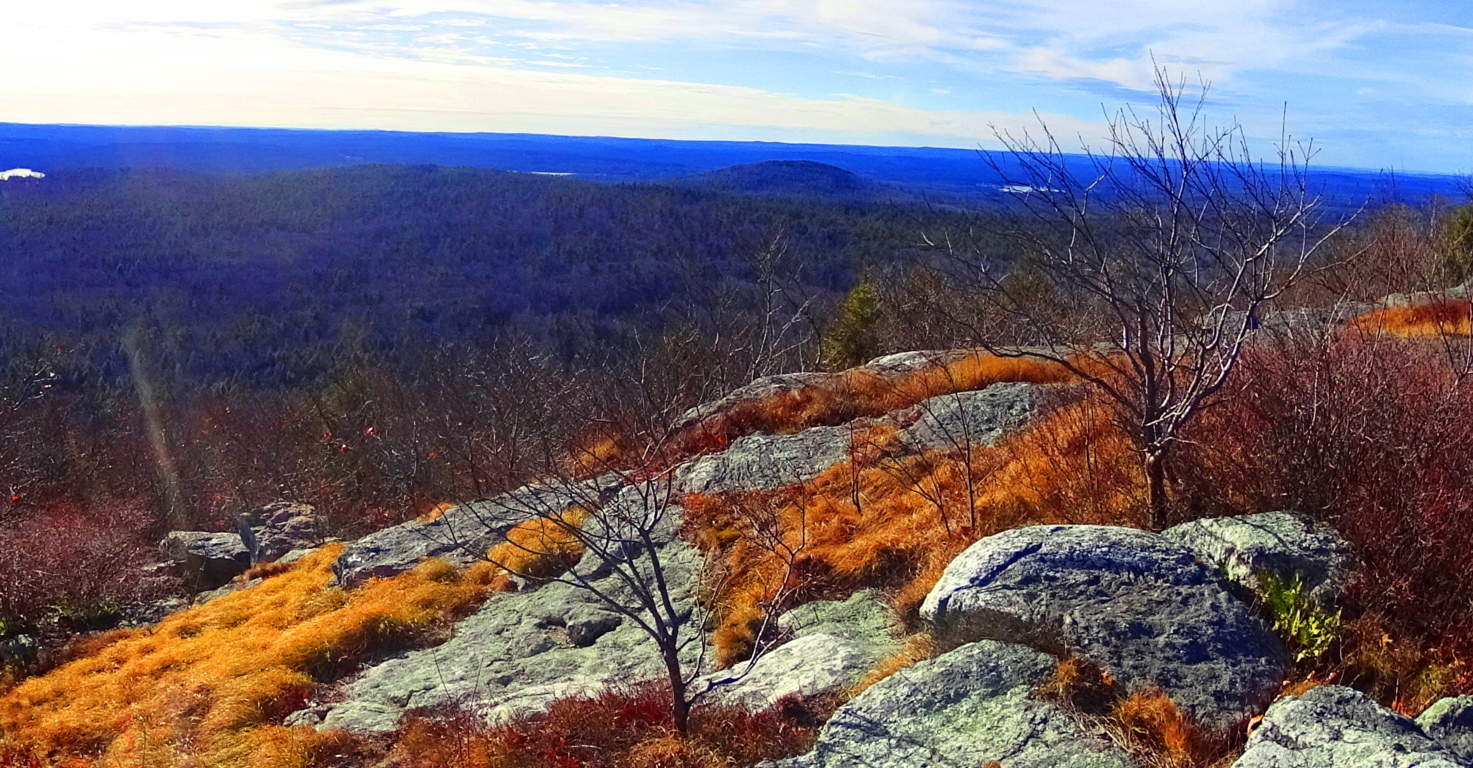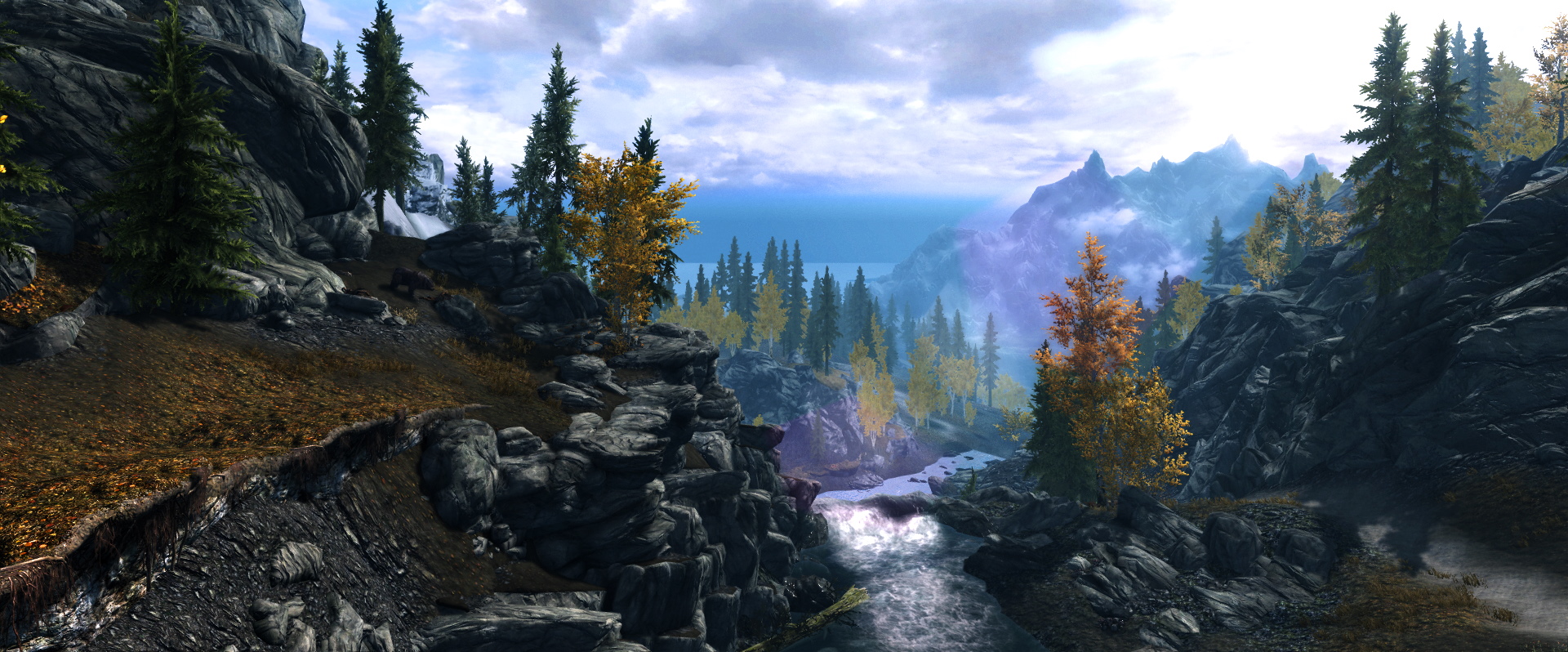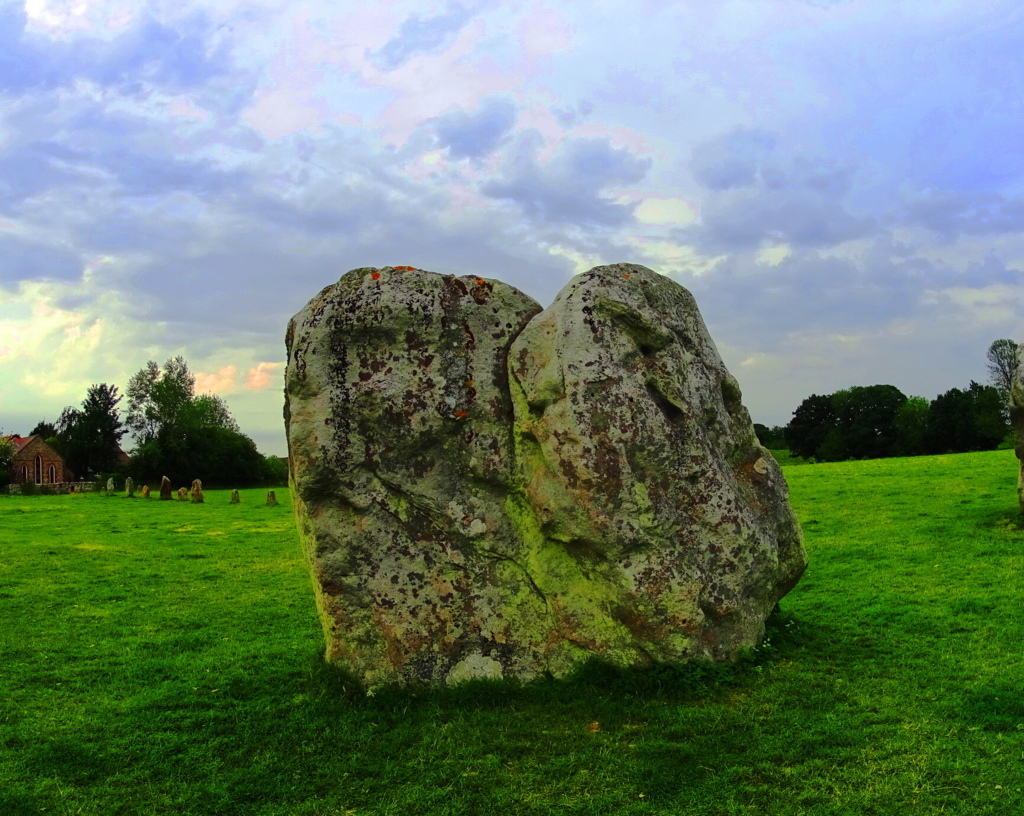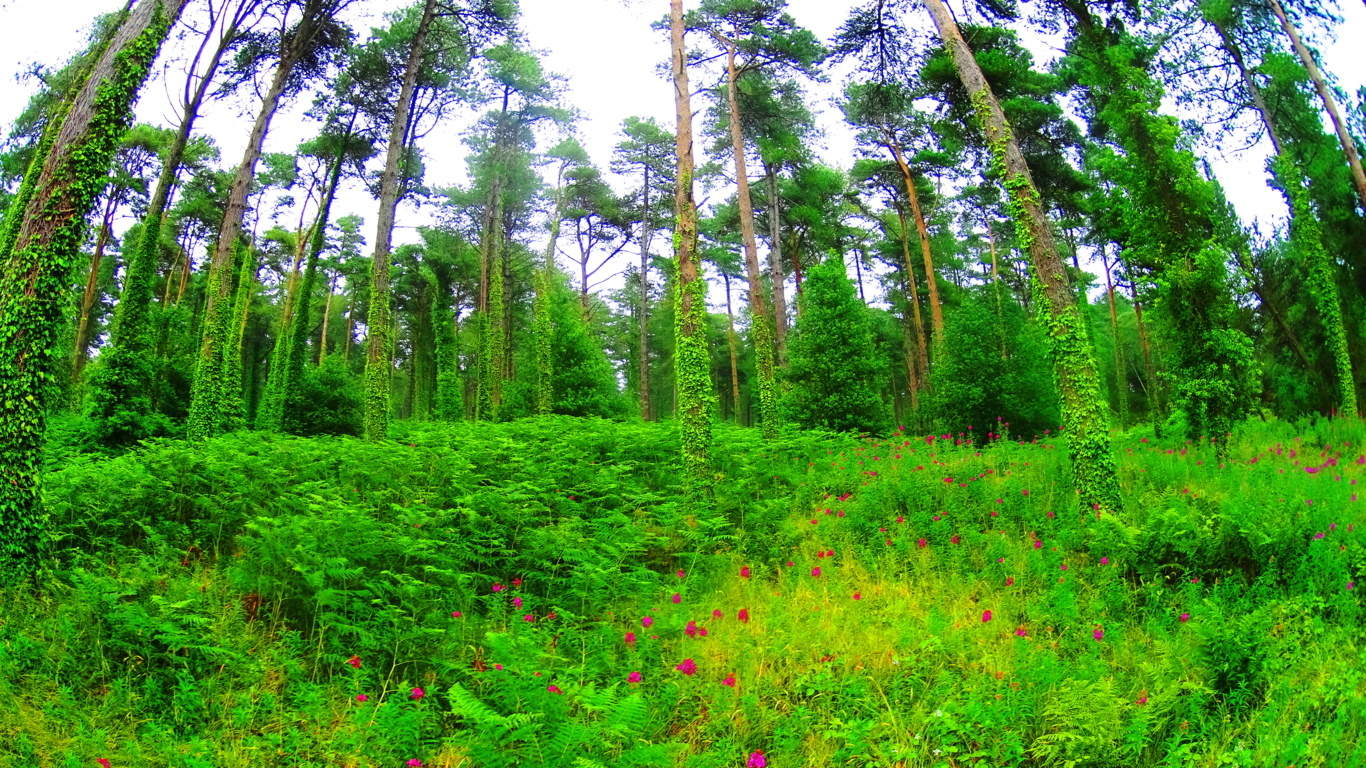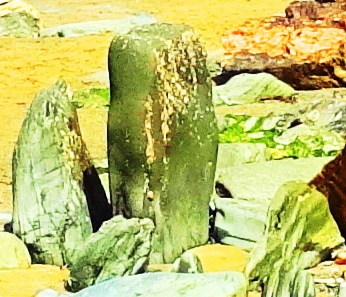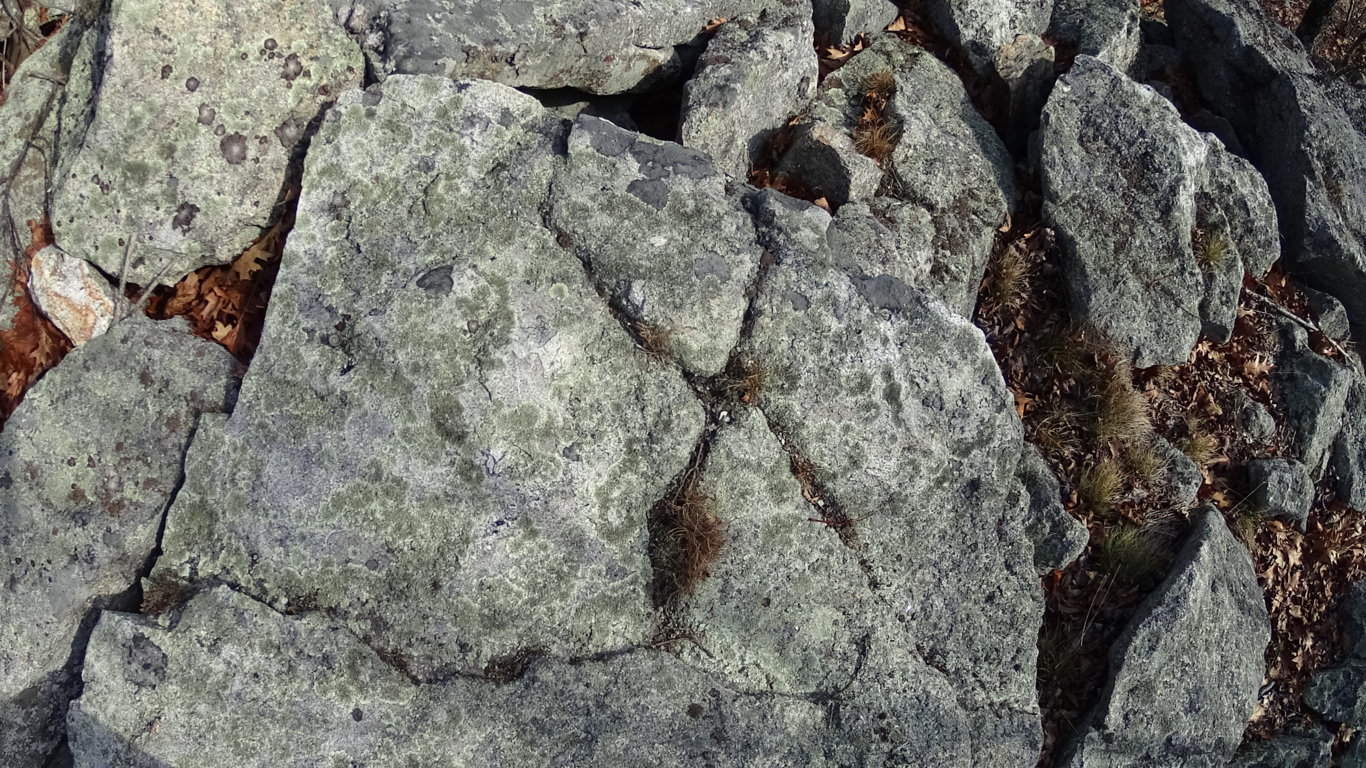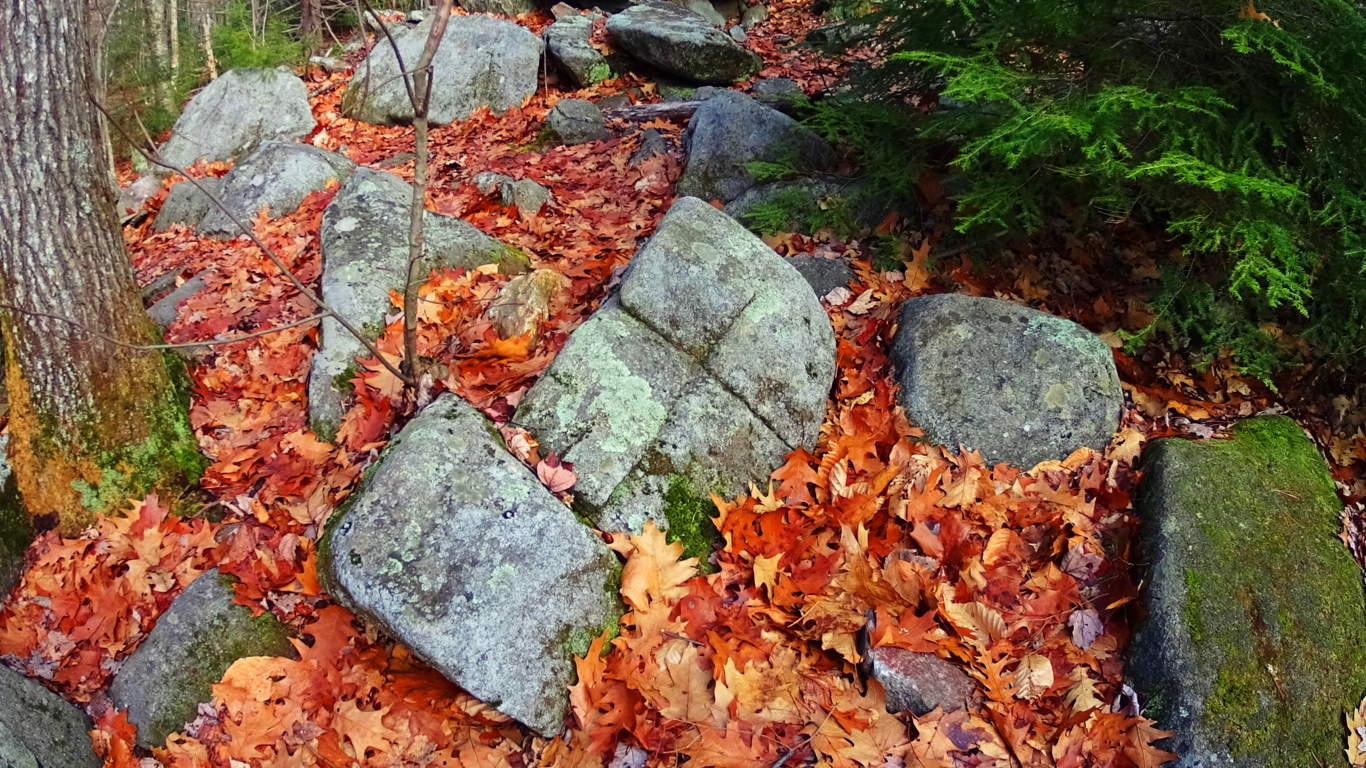Heath Altar Stones
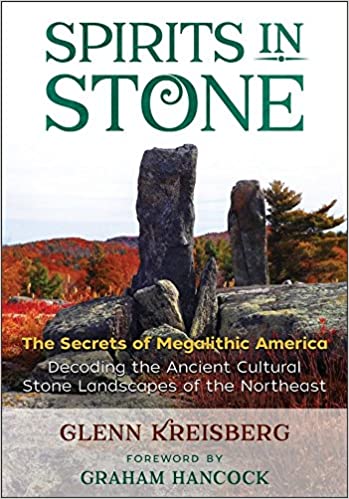 Loc
Loc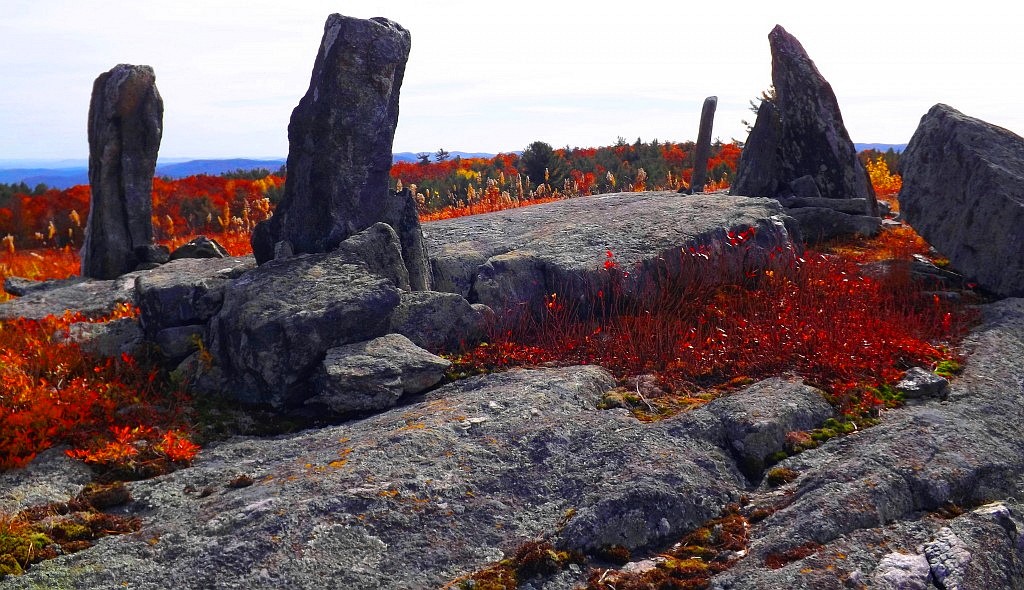 ation: Town of Heath, Massachusetts/USA
ation: Town of Heath, Massachusetts/USA
Note: The Heath Altar is an incredible Megalithic Period statement, set squarely at the top of a quartz riddled hill, in the town of Heath, in Western Massachusetts. When I took the photograph for the cover of Glenn Kreisberg’s interesting book about ‘Megalithic America’, I did so on my own, without asking permission. I did this because I believe that the Heath Altar is a National Heritage Site, not a rock-pile to be guarded by “KEEP OUT OR GET SHOT’ signs of some old and bitter son-of-a-bitch, in his rocking chair. If any researchers have a problem with this action that I took, get in touch with me via: jpv@stonestrider.com, and we can talk, face to face. Otherwise, grow some balls, and do the work yourself. And check out the book, its an important work for people interested in this megalithic thing’;)
Sad Note About America: America has become a scary place, filled with control freak legislators and rule makers, and Facebook-tough-guys, with a spineless, utterly malleable population of cowards, and forgetful bots, that literally no longer think for themselves, or challenge any authority or narratives. These researchers now talk about me on their corny, stuffy, presumptive websites, and on Facebook, like schoolgirls. Well guess what, local Massachusetts researchers who have never taken a single chance for their research, or ever climbed a single mountain, or spoken with a single farmer in the fields; I’m not waiting around for your dueschbag approval, or anyone else’s, for that matter. I want to find sacred places and see them, up close, for myself. I want to collect evidence, up close. I took pictures inside New Grange, even though the signs said not to; and took pictures at The Heath Altar, because thats exactly why these monuments were left behind, to be studied up close, by us. I don’t have time for the fake researchers, and the bureaucracies of the World ruining everything, to approve. And guess what, I got the photograph for the cover of this book, and inside New Grange, because I had heart. Deal with it.
Altars: There are laymen researchers here in New England who struggle with the identity of the makers of this Altar. The ashlar-cut boulders go as deep into the ground, as they do protrude. These boulders are lock-set, like a key in a keyhole, and are too heavy to budge. These stones are set around a square flatted slab of granite, that looks much like a table for performing any amount of varies actions. Local researchers pushing the narrative that Native American tribes built this place, have completely disregarded mass amounts of evidence from similar constructs in Megalithic Ireland, England, Wales, Scotland, France, Italy, and Greece. The Heath Altar is a Neolithic Period construct, created by a Culture that embraced working with massive stones, all throughout New England. The similarity of The Heath Altar, to European Altars, is beyond argument. Below is an image if the Laraghirril Altar Stones, in Ireland. The similarity is un deniable, and has nothing to do with “Native Americans”. 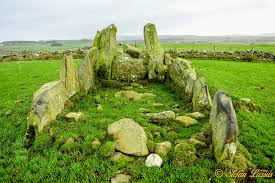 The Celtic Native Tribes did not build the Megalithic Altars in Europe, just as the Native American Tribes did not build the megaliths in America. There was an earlier Culture, with specific memes, logos, and cultural morays, that can be related through directly connecting the blatant symbolism, and coding, of the construct of the megaliths. The abundance of evidence is what this website is about. Look at the most recent discoveries and recent stories; the evidence is there. Equilateral triangles cut not granite, orientations of stones, stone-linings running straight up mountain sides, all of megalithic size, and scale, with quartz harvests in the stonework, along with celestial orientations; all present in the megalithic works. The megaliths show scientific/mathematical evidence of being present long before Celtic or Abenaki/Iroquois Tribes existed in regions where they stand. Just deal with it. The beautiful Native American tribes in the Northeast United States were seasonally nomadic, minimal in their possessions, averse to ego-driven labor and taking constant orders, and humbly simple in their technology and tools. Native Americans do not claim to have built this Altar, and they shouldn’t. The Heath Altar was built by the Megalithic Culture, the first culture on Earth.
The Celtic Native Tribes did not build the Megalithic Altars in Europe, just as the Native American Tribes did not build the megaliths in America. There was an earlier Culture, with specific memes, logos, and cultural morays, that can be related through directly connecting the blatant symbolism, and coding, of the construct of the megaliths. The abundance of evidence is what this website is about. Look at the most recent discoveries and recent stories; the evidence is there. Equilateral triangles cut not granite, orientations of stones, stone-linings running straight up mountain sides, all of megalithic size, and scale, with quartz harvests in the stonework, along with celestial orientations; all present in the megalithic works. The megaliths show scientific/mathematical evidence of being present long before Celtic or Abenaki/Iroquois Tribes existed in regions where they stand. Just deal with it. The beautiful Native American tribes in the Northeast United States were seasonally nomadic, minimal in their possessions, averse to ego-driven labor and taking constant orders, and humbly simple in their technology and tools. Native Americans do not claim to have built this Altar, and they shouldn’t. The Heath Altar was built by the Megalithic Culture, the first culture on Earth. 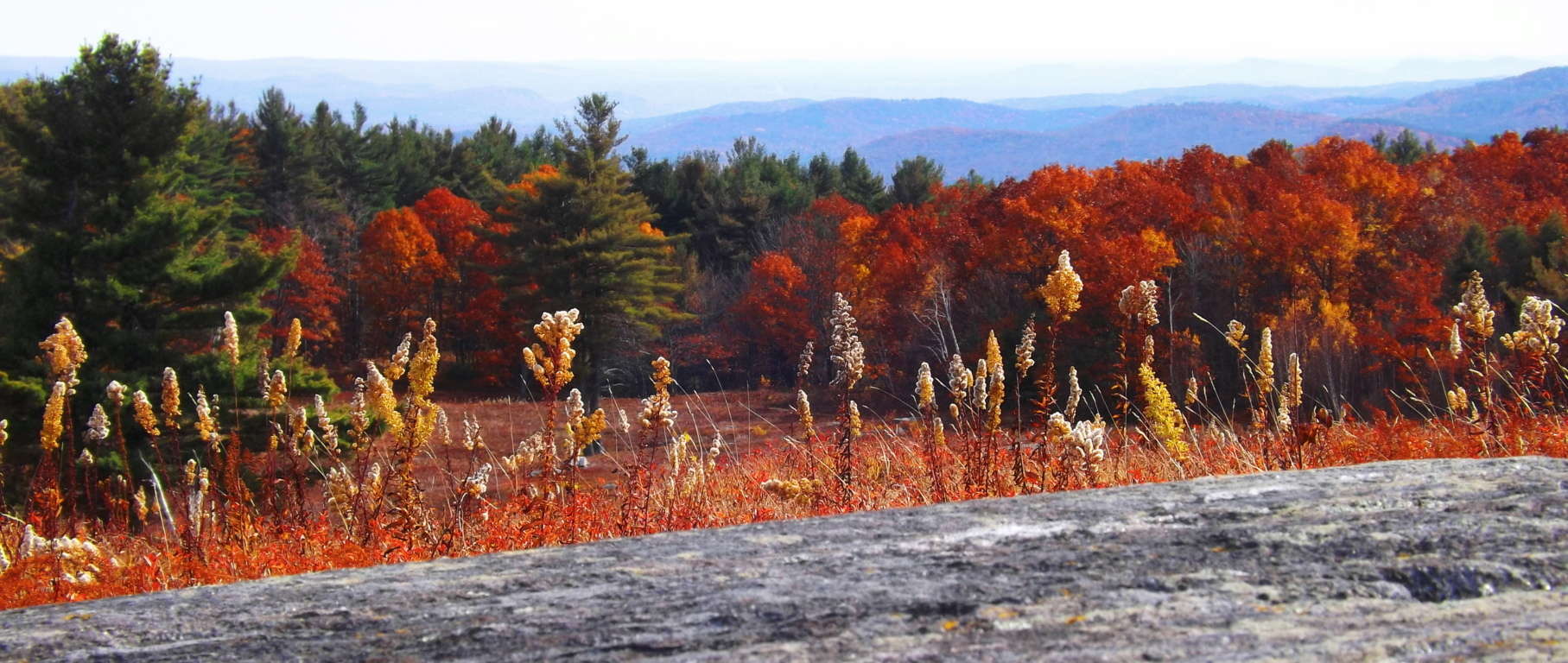 The Town of Heath: The rustic countryside on the boarder of Vermont and central Massachusetts, on the northeastern coast of the U.S, is as picturesque as any scene. Small mountains, rocky hills, Pines, Birches, and Hemlocks, all dot the landscape. The four classic seasons flux distinctly in this part of the world, with a most captivating Autumn.
The Town of Heath: The rustic countryside on the boarder of Vermont and central Massachusetts, on the northeastern coast of the U.S, is as picturesque as any scene. Small mountains, rocky hills, Pines, Birches, and Hemlocks, all dot the landscape. The four classic seasons flux distinctly in this part of the world, with a most captivating Autumn.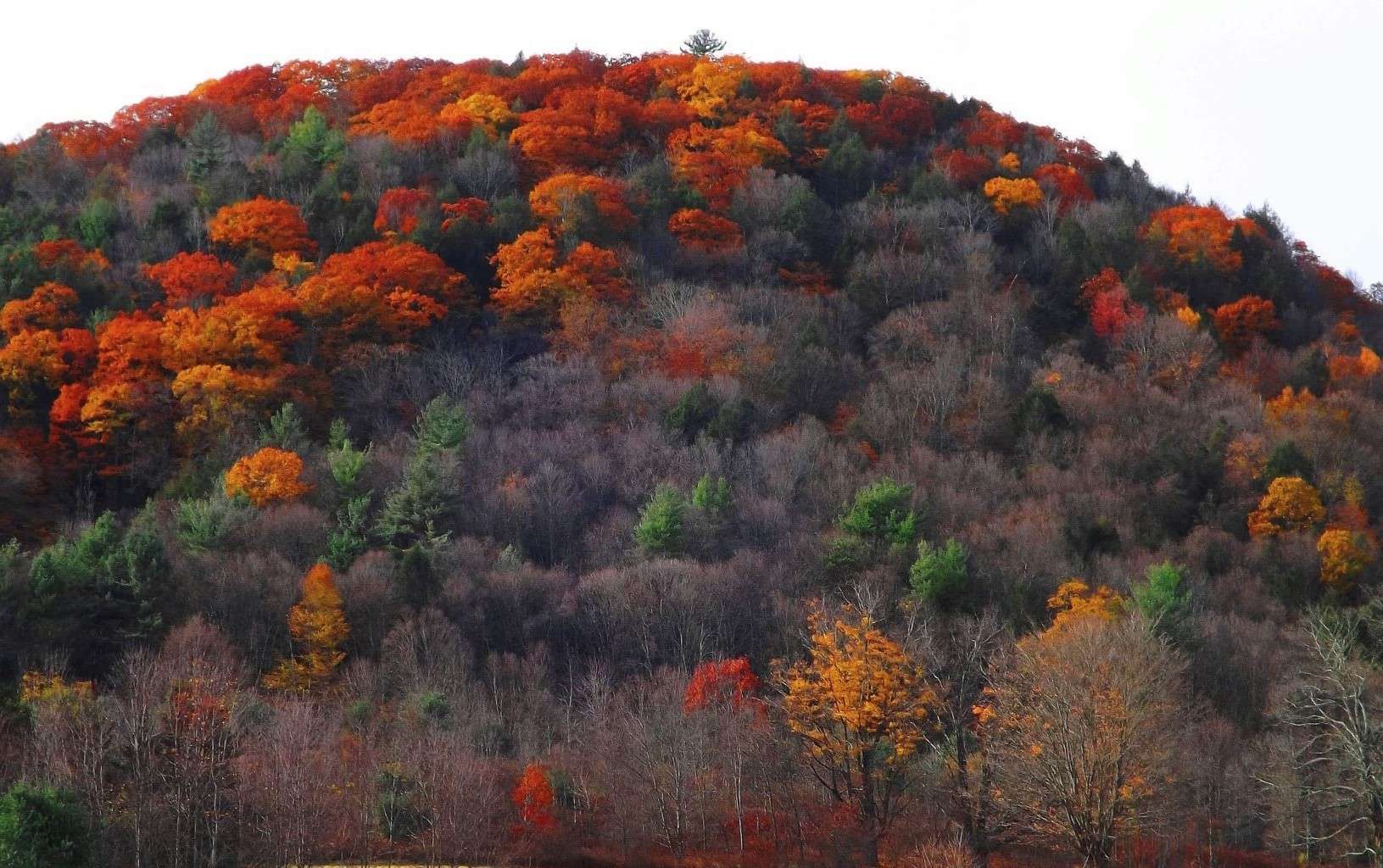 The Green Mountains of Vermont are 15 miles northwest of Heath, along with state preserved trails at Mount Watatic, Monument Mountain, Savoy Falls, and Bears Den, are all within an hour of here (and featured on this site). New England’s first layer is the Megalithic Stones and its Culture. The second layer is the Native American movements, and seasonal migrations, with minimal effect on the landscape. The third layer became the Colonial invasion, and the fourth, and most dominant layer, is of course the modern sub-urban domination of towns and small cities, uprooting and confusing the true history of the landscape in so many regions. But there are still distinct signs and works of the megalithic Culture in the untouched areas, and it is like this in many parts of the world. Where there in modernization, we find megalithic stone works.
The Green Mountains of Vermont are 15 miles northwest of Heath, along with state preserved trails at Mount Watatic, Monument Mountain, Savoy Falls, and Bears Den, are all within an hour of here (and featured on this site). New England’s first layer is the Megalithic Stones and its Culture. The second layer is the Native American movements, and seasonal migrations, with minimal effect on the landscape. The third layer became the Colonial invasion, and the fourth, and most dominant layer, is of course the modern sub-urban domination of towns and small cities, uprooting and confusing the true history of the landscape in so many regions. But there are still distinct signs and works of the megalithic Culture in the untouched areas, and it is like this in many parts of the world. Where there in modernization, we find megalithic stone works. 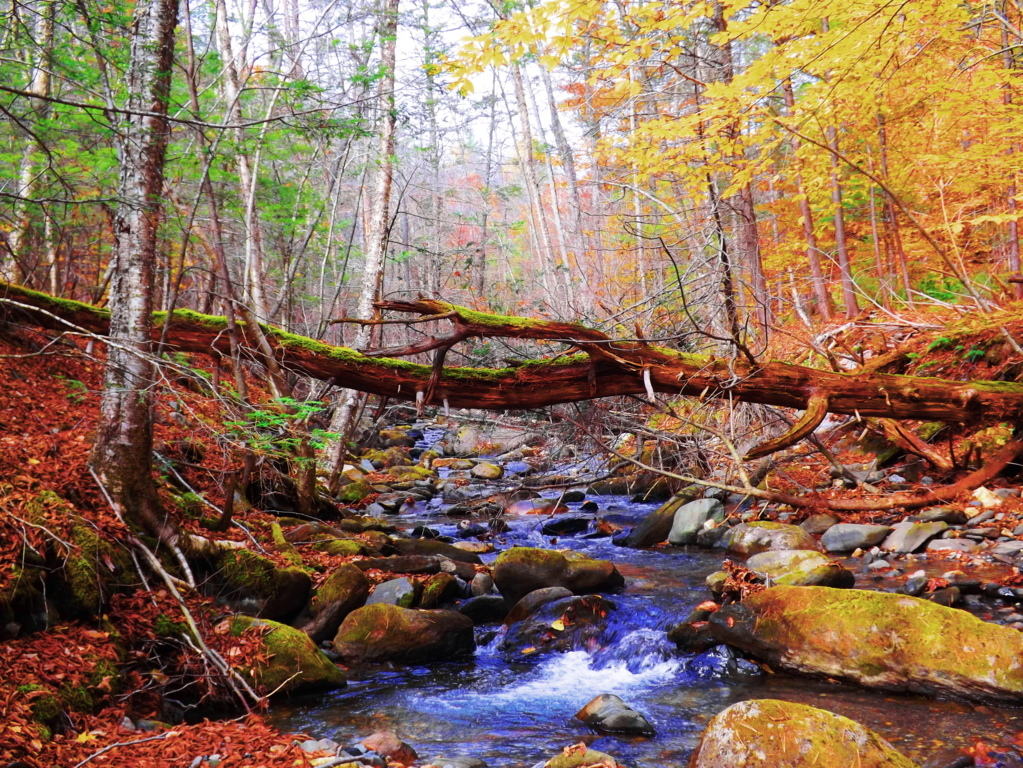 For example, along the streams approaching the area in Heath are megalithic scale irrigation walls that provide ‘pivots’ in the landscape for streams to flow by. This 12 foot high, and beautifully leveled, work of irrigation is only 4 miles from the Heath Altar, adding to the mystique of the overall area.
For example, along the streams approaching the area in Heath are megalithic scale irrigation walls that provide ‘pivots’ in the landscape for streams to flow by. This 12 foot high, and beautifully leveled, work of irrigation is only 4 miles from the Heath Altar, adding to the mystique of the overall area.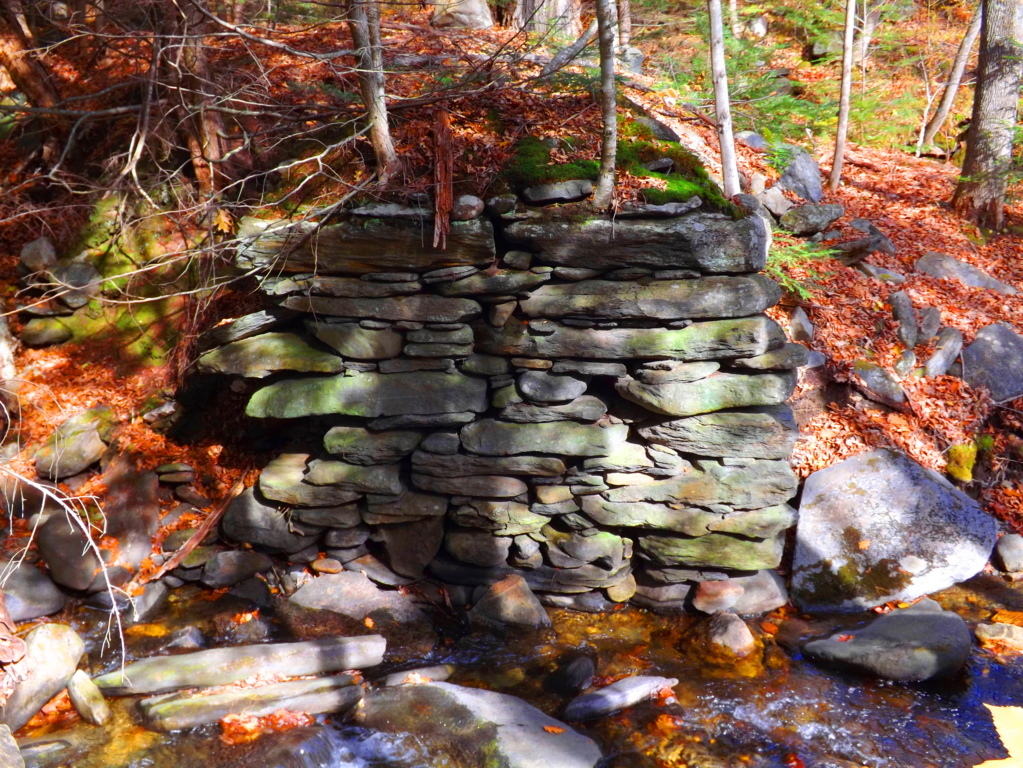 The dry rocky plateau on which the Heath Altar sits radiates hallowed vibrations. This is among the oldest cultural structures on earth. There is a loose symmetry to the scene, with a bed of flat granite at the highest point of the broad hill, guarded at each of it’s four corners by deeply incised, and notched, standing stones. The standing stones here are not flimsy, as depicted in most old articles. These are broad and intimidating megaliths, which can be seen here. (Image/Below) This is the photographic justice this site demands, capturing the grandeur of the overall area as well, not obscured images from old newspaper articles, or desperately zoomed photos from 100 yards away from fearful on-lookers. Everything about this place says Megalithic, not Colonial farmer’s “pet project”, which is what many writers and researchers would also have people attributing credit to. In the United States, the idea of colonials having possibly built these megaliths is often mentioned. It is infuriating, and totally irresponsible. Nothing about this area says ‘colonial’, or Native American, for that matter.
The dry rocky plateau on which the Heath Altar sits radiates hallowed vibrations. This is among the oldest cultural structures on earth. There is a loose symmetry to the scene, with a bed of flat granite at the highest point of the broad hill, guarded at each of it’s four corners by deeply incised, and notched, standing stones. The standing stones here are not flimsy, as depicted in most old articles. These are broad and intimidating megaliths, which can be seen here. (Image/Below) This is the photographic justice this site demands, capturing the grandeur of the overall area as well, not obscured images from old newspaper articles, or desperately zoomed photos from 100 yards away from fearful on-lookers. Everything about this place says Megalithic, not Colonial farmer’s “pet project”, which is what many writers and researchers would also have people attributing credit to. In the United States, the idea of colonials having possibly built these megaliths is often mentioned. It is infuriating, and totally irresponsible. Nothing about this area says ‘colonial’, or Native American, for that matter.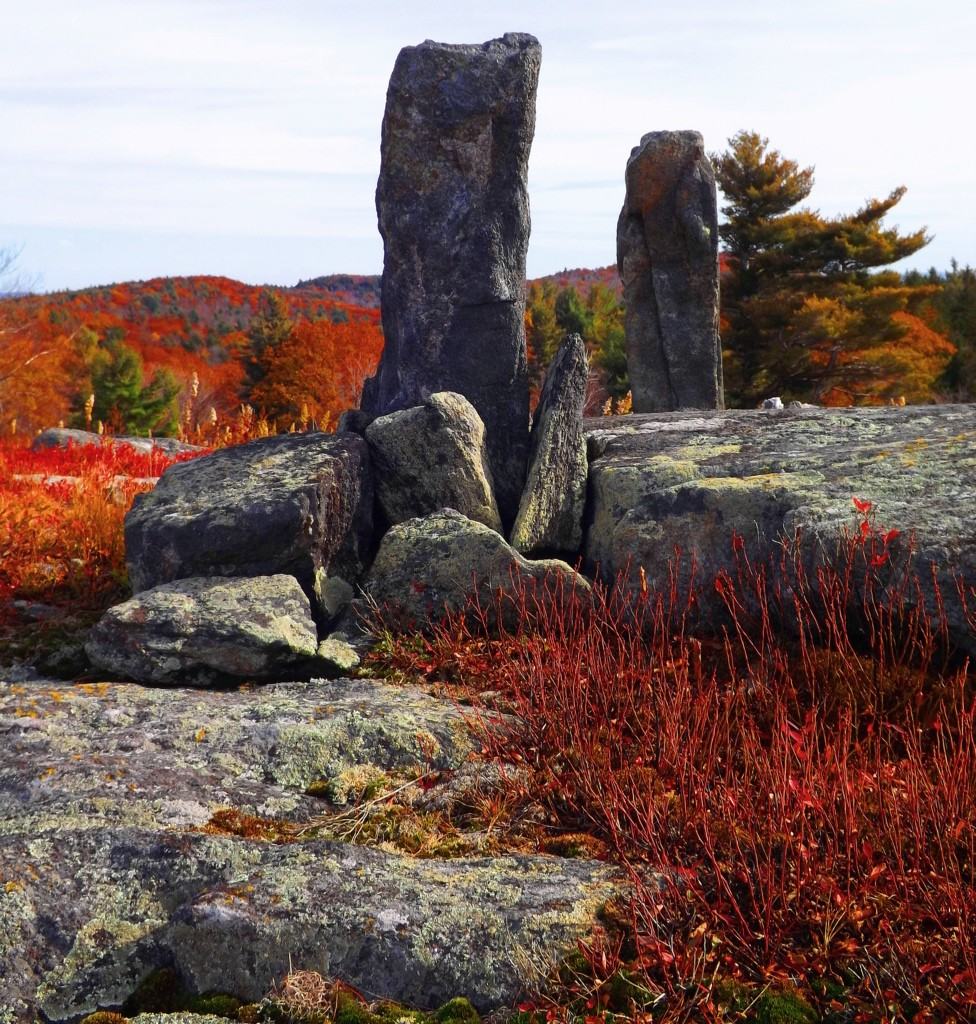 The standing stones are each about 6 feet in height, and a single foot in width. Just beyond the Altar is a fifth standing stone that serves as a kind of head-stone. The ‘stone table’ may have served to support a bonfire, or perhaps it was more of a literal ‘large table’, used for sacrificial rites, or skinning hunted game. Whatever happened at this spot, the builders of this place made it distinct, so it is clear that this was considered a sacred place.
The standing stones are each about 6 feet in height, and a single foot in width. Just beyond the Altar is a fifth standing stone that serves as a kind of head-stone. The ‘stone table’ may have served to support a bonfire, or perhaps it was more of a literal ‘large table’, used for sacrificial rites, or skinning hunted game. Whatever happened at this spot, the builders of this place made it distinct, so it is clear that this was considered a sacred place. Radiating away from the Altar are smaller standing stones.
Radiating away from the Altar are smaller standing stones.
Smaller Standing Stones near by: Here is look at a smaller white marble, 3 feet tall standing stone, almost 50 yards from the top of the hill. Stones like this may have served as a boundary, or warning stone, for others approaching the Alter. It is obvious that this particular stone was also chosen for its beauty.There is also a distinct possibility that these smaller stones are celestially oriented. 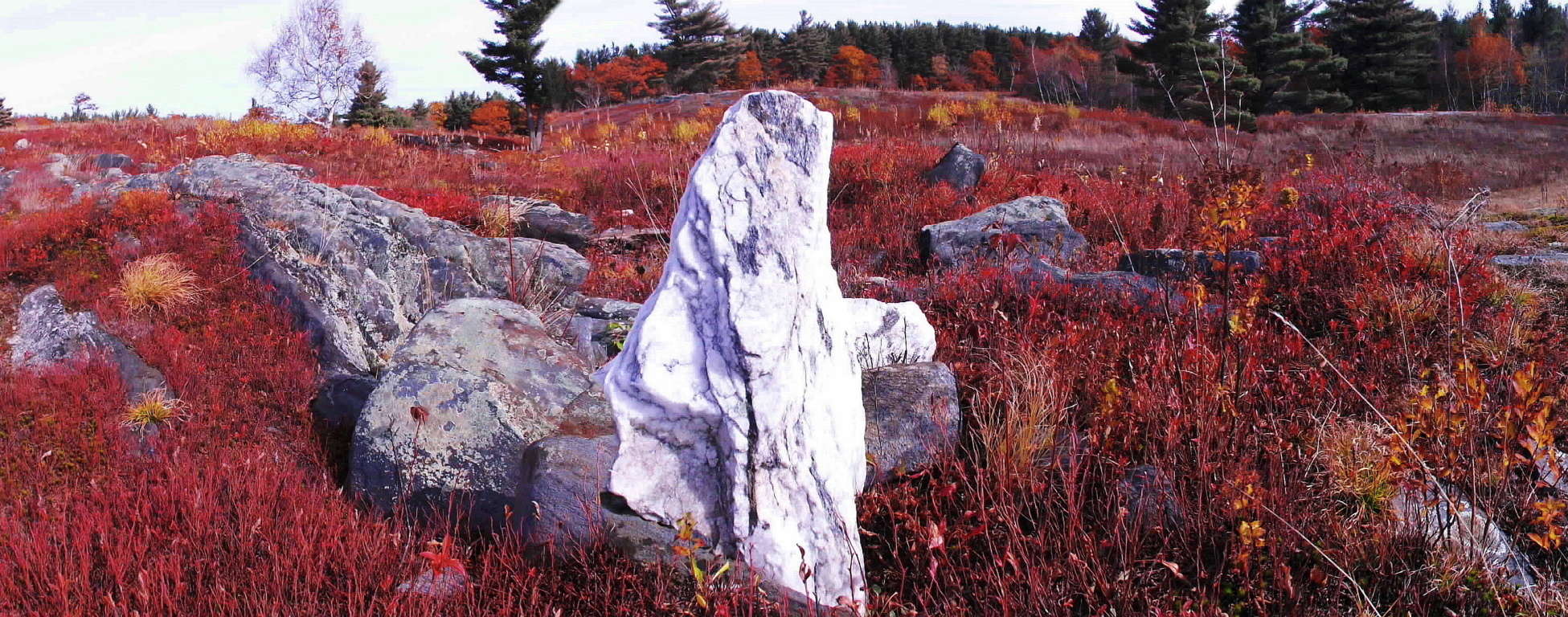 In another area away from the Altar site, possibly fixed to the northerly cardinal direction, sits another standing stone, deep in the ground, and somewhat tilted. This one looks to have been about 8 feet long, although only about 3 feet is above ground, with a darker colored rock face pointing towards Vermont.
In another area away from the Altar site, possibly fixed to the northerly cardinal direction, sits another standing stone, deep in the ground, and somewhat tilted. This one looks to have been about 8 feet long, although only about 3 feet is above ground, with a darker colored rock face pointing towards Vermont. Facing cardinal South is another amazing standing stone that has a 45 degree angular cut, with an ‘arrowhead top’, standing roughly 3 feet high, and 6 inches thick. (Second Image/Below/White Color) This particular type of stone can be found in other parts of New England as well, supporting the idea that it is a singular megalithic culture that occupied this natural space. Pictured below is a massive 45 degree angle New England standing stone with the exact same dimensions as the smaller Heath standing stone. The area that the smaller Heath standing stone is directs our attention to is gorgeous.
Facing cardinal South is another amazing standing stone that has a 45 degree angular cut, with an ‘arrowhead top’, standing roughly 3 feet high, and 6 inches thick. (Second Image/Below/White Color) This particular type of stone can be found in other parts of New England as well, supporting the idea that it is a singular megalithic culture that occupied this natural space. Pictured below is a massive 45 degree angle New England standing stone with the exact same dimensions as the smaller Heath standing stone. The area that the smaller Heath standing stone is directs our attention to is gorgeous.  The trees here are stunning at this time of year. Notice also that even the flat granite stones along the ground seem to have been leveled and cut on their sides. The amount of cultural stonework happening here gives the area a type of energy, perhaps like at the Hill of Tara in Ireland, or at the Avebury stone circle in England. The feeling is just overwhelming that someone, a very long time ago, loved this place enough to mark it out in amazingly playful way, with massive stones, that would remain forever.
The trees here are stunning at this time of year. Notice also that even the flat granite stones along the ground seem to have been leveled and cut on their sides. The amount of cultural stonework happening here gives the area a type of energy, perhaps like at the Hill of Tara in Ireland, or at the Avebury stone circle in England. The feeling is just overwhelming that someone, a very long time ago, loved this place enough to mark it out in amazingly playful way, with massive stones, that would remain forever. 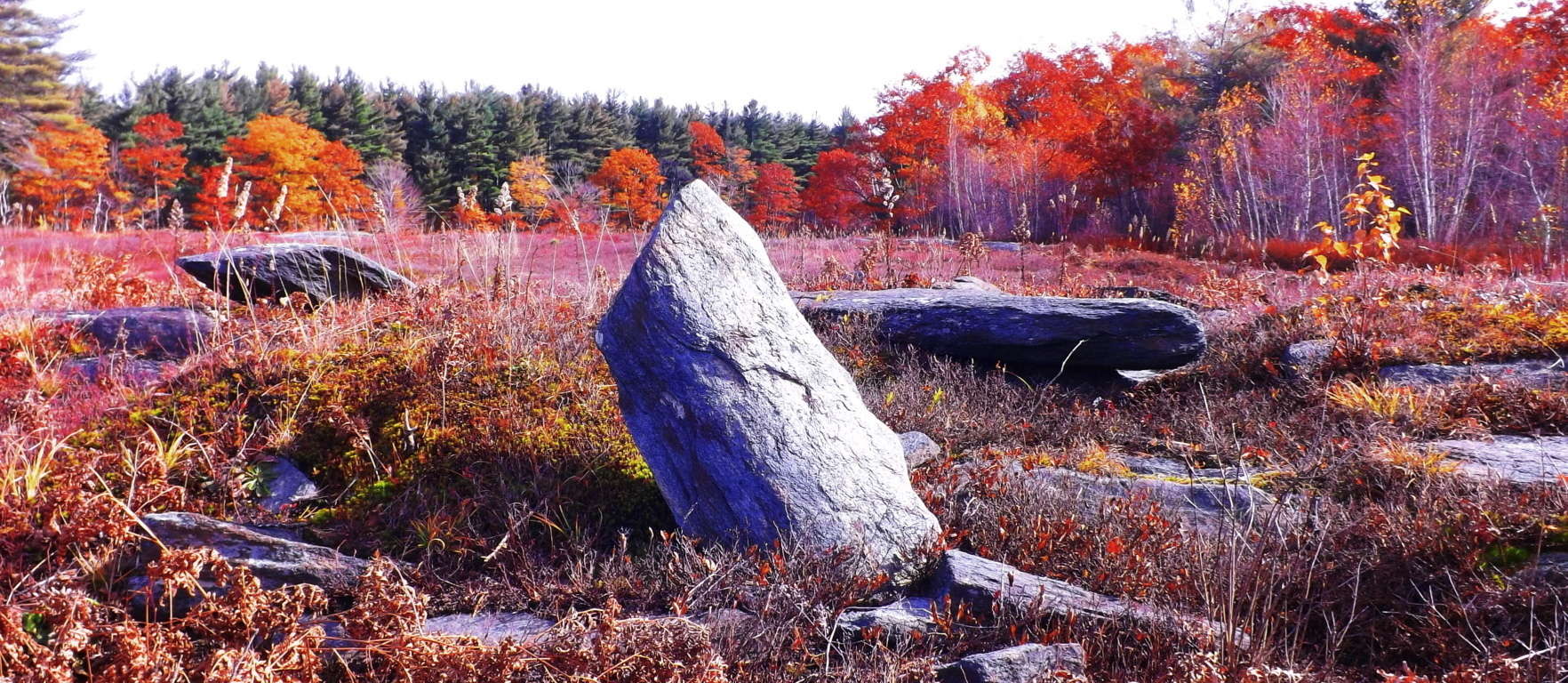 Quartz stones and classic stone-linings: The energy-storing and transferring properties of quartz are well known. Also on this sacred rocky plateau sits one of the most abundant quartz faces in all of New England. The surreal vision it creates against the dry red brush is striking, looking almost like snow. This a clear quartz concentration or harvest, which is very similar to many megalithic areas in Europe.
Quartz stones and classic stone-linings: The energy-storing and transferring properties of quartz are well known. Also on this sacred rocky plateau sits one of the most abundant quartz faces in all of New England. The surreal vision it creates against the dry red brush is striking, looking almost like snow. This a clear quartz concentration or harvest, which is very similar to many megalithic areas in Europe.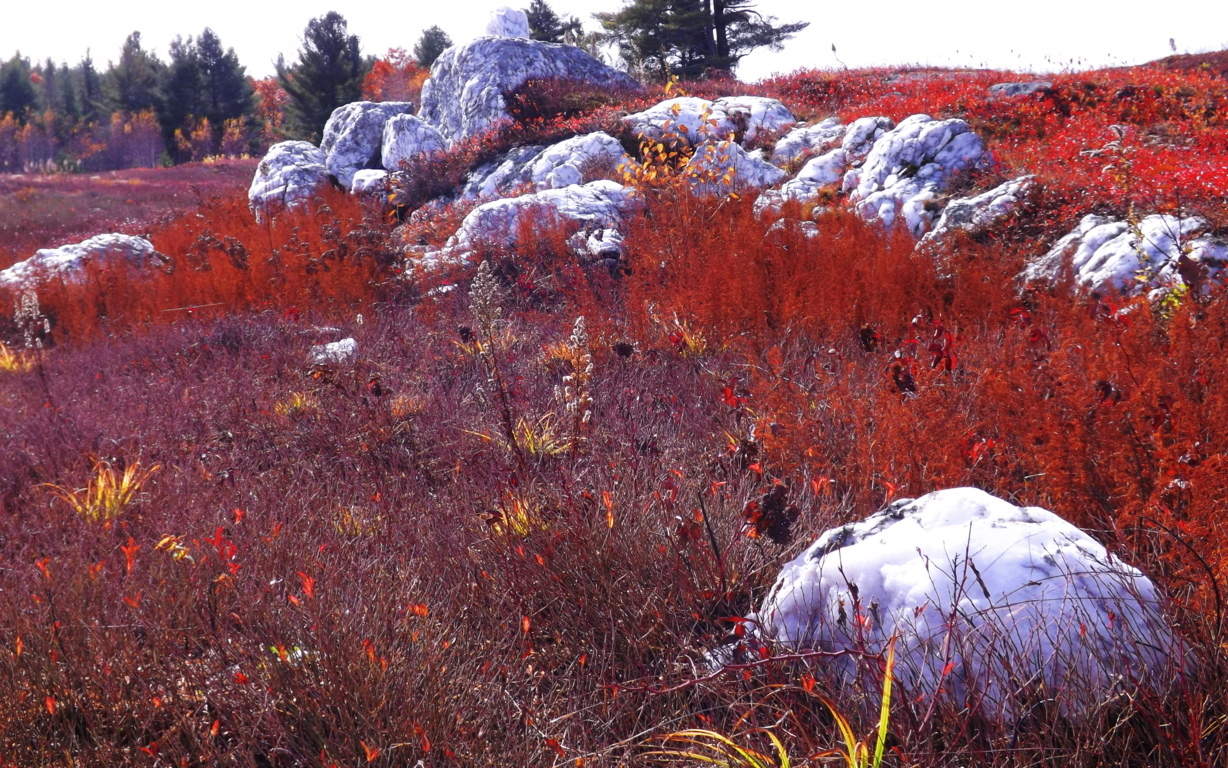 If quartz boulders are purposely scattered throughout the area, it would make sense that this place is a designed kind of ‘energy center’,with quartz absorbing energy from the Sun and connecting stones. This piece below looks to weigh at least half a ton, set proudly above a cut granite slab, near the Heath Altar.
If quartz boulders are purposely scattered throughout the area, it would make sense that this place is a designed kind of ‘energy center’,with quartz absorbing energy from the Sun and connecting stones. This piece below looks to weigh at least half a ton, set proudly above a cut granite slab, near the Heath Altar. 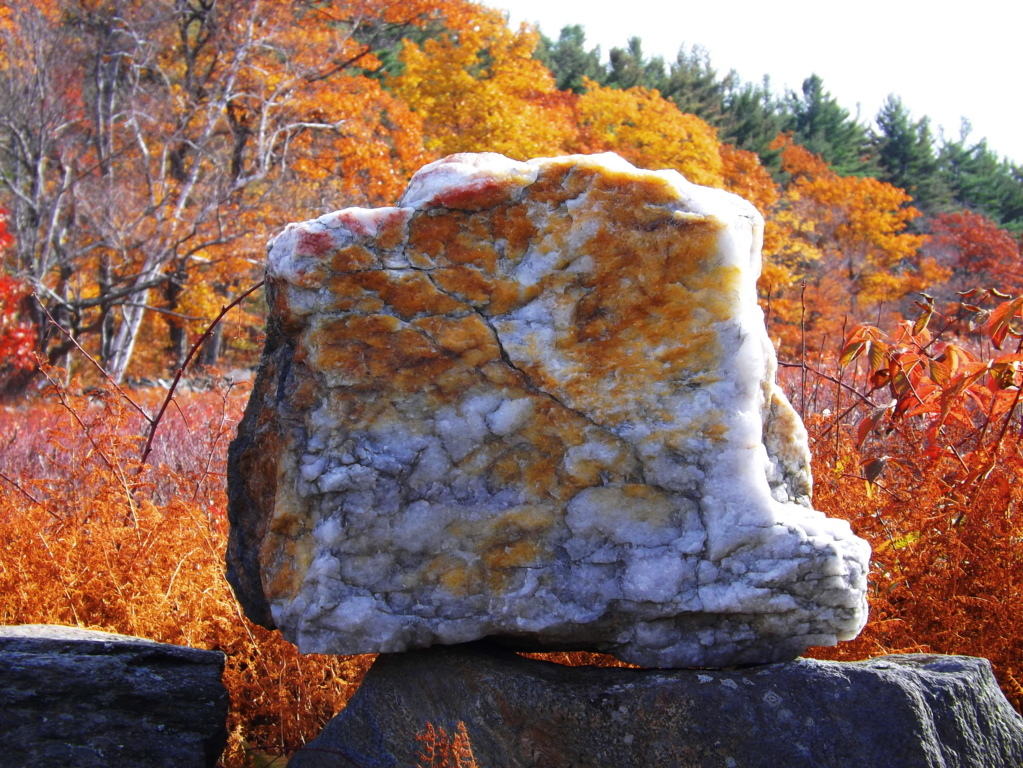 It’s as if megalithic anthropological sites are revealing a knowledge of the properties of stones. If this is true, then this entire area is a type of engineered energy center. Further to the north are classic stone-linings running through the area. These can be found in Cavan Burren National Park in a very similar style, connecting peaks, from hill top to hill top. There are enough of these linings in New England to circle the earth six times, with probably just as many in Ireland and England. This is a monument larger than the great pyramid, simply laid out in a different format. Native Americans mention nothing of building stone-linings enough times to circle the Earth 6 times. Not a word. Someone else did this colossal work.
It’s as if megalithic anthropological sites are revealing a knowledge of the properties of stones. If this is true, then this entire area is a type of engineered energy center. Further to the north are classic stone-linings running through the area. These can be found in Cavan Burren National Park in a very similar style, connecting peaks, from hill top to hill top. There are enough of these linings in New England to circle the earth six times, with probably just as many in Ireland and England. This is a monument larger than the great pyramid, simply laid out in a different format. Native Americans mention nothing of building stone-linings enough times to circle the Earth 6 times. Not a word. Someone else did this colossal work. 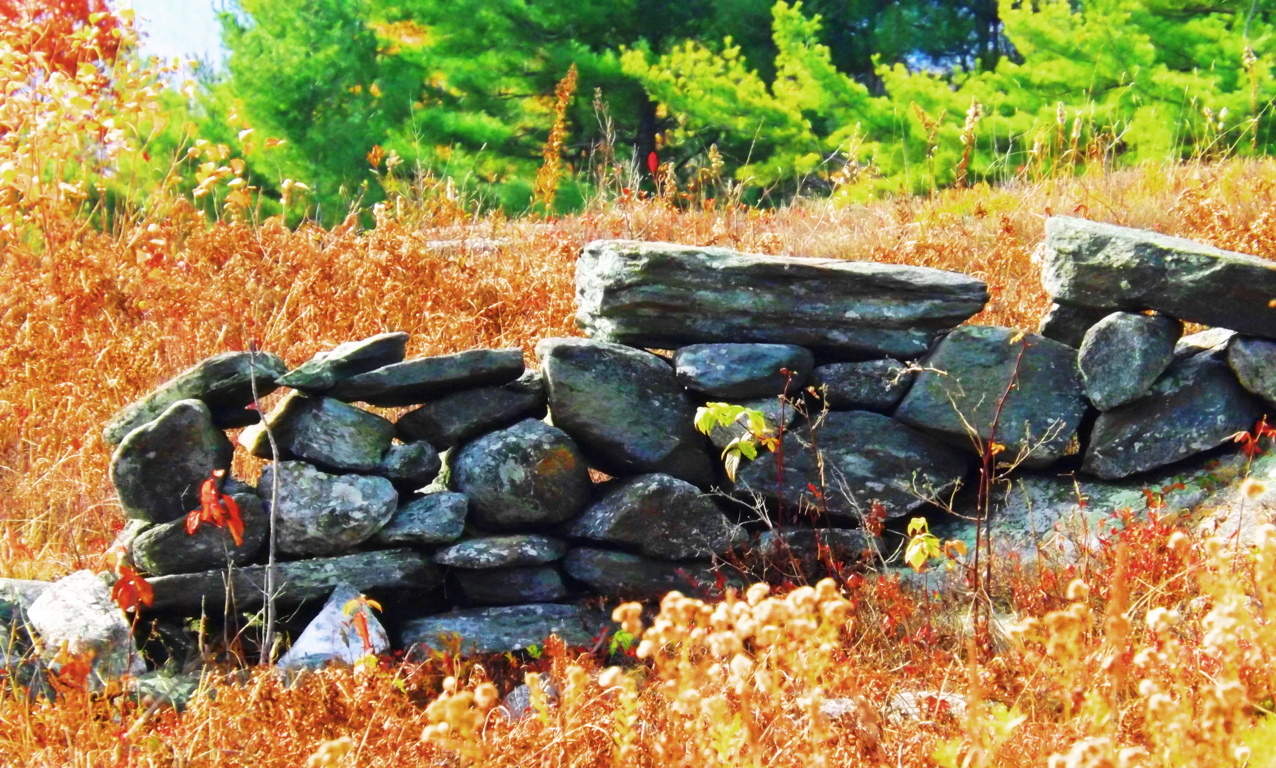 Megalithic New England: There are beautiful subtleties to understand about this place. The elevation of the rocky hill; the distance to the tree’s below, the Altar in the high clearing; as well as the fauna of the tall reeds, mingling with the stones, looking like so many other megalithic zones in Europe. Take a look at the overall similarity between this hill in Heath, and the hill top above Kinnitty Forest in Ireland, where stone-linings and irrigation walls exist in the landscape as well. (Images/Below) It’s as if the landscapes are paternal twins, with exactly similar scaling, with just the different colors to distinguish them. The elevations and patterns of sacred Neolithic places are similar because it was a similar Culture that built them.
Megalithic New England: There are beautiful subtleties to understand about this place. The elevation of the rocky hill; the distance to the tree’s below, the Altar in the high clearing; as well as the fauna of the tall reeds, mingling with the stones, looking like so many other megalithic zones in Europe. Take a look at the overall similarity between this hill in Heath, and the hill top above Kinnitty Forest in Ireland, where stone-linings and irrigation walls exist in the landscape as well. (Images/Below) It’s as if the landscapes are paternal twins, with exactly similar scaling, with just the different colors to distinguish them. The elevations and patterns of sacred Neolithic places are similar because it was a similar Culture that built them. 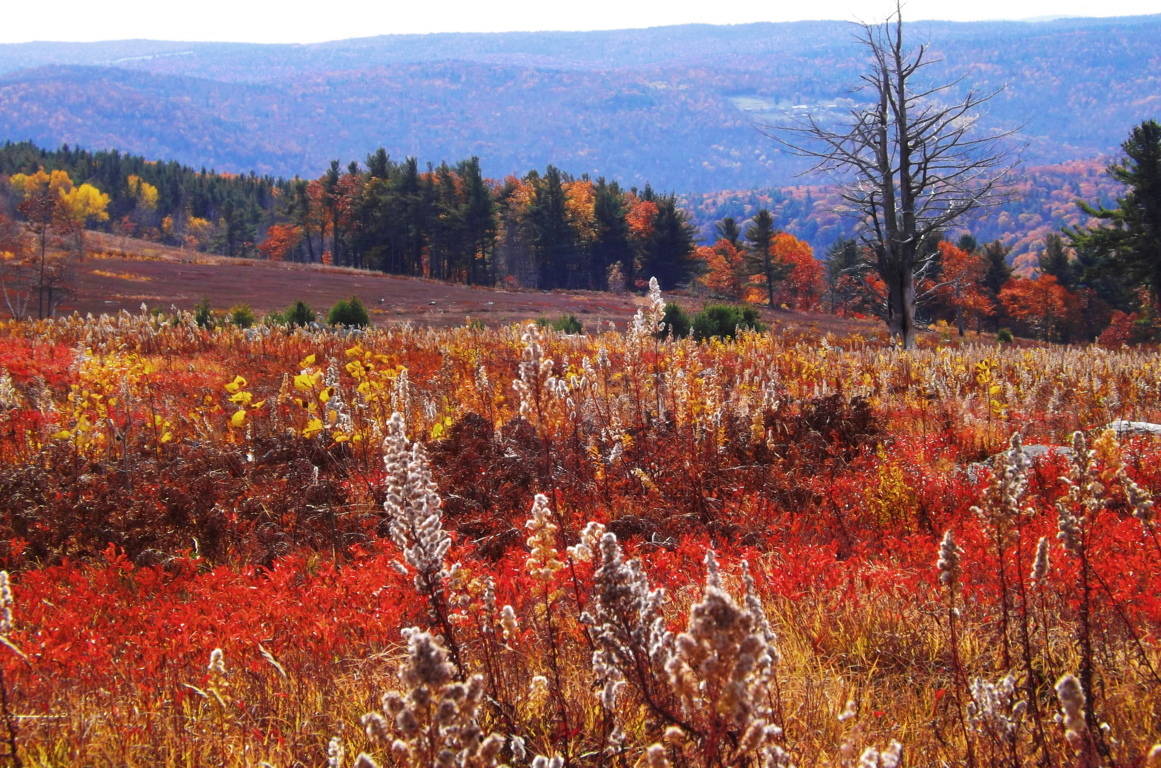 Heath Hilltop (Image/Above)
Heath Hilltop (Image/Above)
 Here is the hilltop at Kinnitty (Image/Above)
Here is the hilltop at Kinnitty (Image/Above)
Summary: Look at all these features at Heath. It’s overwhelming, and obviously a Megalithic Cultural center. Once upon a time these advantageous vistas were chosen by a Megalithic culture. They were absolutely of the same mind, as to what areas were worth inhabiting. The similarity of these chosen areas, the elevations, the circumference of the rocky clearings, the distance to the running streams, and the types of stone being utilized as megalithic, all reveal compelling evidence towards a single ancient Culture, present both in the American Northeast, and the ancient European hills. The Heath Altar Stones are a direct anthropological connection to the Megalithic world, and yet this information is considered ‘alternative‘. It’s absurd when seen first hand, what the academics are clearly ignoring. There is an energy and beauty in central Massachusetts that is on-par with any of the preserved pastoral natural spaces of the European Megalithic world. All it takes is an exploratory hike in the forests and rocky hills of Heath, and you will see, and feel, it for yourself. And that is the more important point, to see it, and feel it for yourself. Don’t let anyone tell you what something is before analyzing it for yourself, or it won’t be long before not one of your ideas will actually be your own. When you find a sacred place, it reveals the sacred potential in you. Go for it.
Skyrim
Note: During the winter of 2014 in New England, 107.6 inches of snow fell around Boston. An Arctic weather system blasted the entire east coast of the United States for six months straight. Temperatures dropped to an average of 30 degrees, and many times as low as -14. Massachusetts declared a state of emergency. Public transportation and public schools were closed. Piles of snow reached 15 feet high on every street corner, and the snow was level with the windows. It was grey and dark everyday.  It was a full Arctic winter. Take a look at my home in this picture. Finding things to do inside became a real challenge. Reading is healthy but can get boring after a few hours each evening. Going on-line is fun, but it can give you a headache after extended periods as well. As the winter reached it’s peak in late January, I was going snow-blind, and stir crazy. I had become so accustomed to seeing bright-white literally everywhere, that my depth perception was completely blurry. I realized I needed to find something fun to do inside, something that involved bright colors, as crazy as that sounds. I went to Best Buy to find something playful to do. At the entrance, as if literally waiting for me, was a large poster of what I felt, at that particularly color-starved moment, was the most beautiful landscape I had ever seen. I was completely blown away. I asked the attendant about the poster. He told me that the landscape was from an Xbox ‘quest game’ called Skyrim. He told me the game was a ‘universe of landscapes’ to explore. I spent $550 as if it was 50 cents, and walked out of the store in less than three minutes with a new Xbox, and a single game, Skyrim.
It was a full Arctic winter. Take a look at my home in this picture. Finding things to do inside became a real challenge. Reading is healthy but can get boring after a few hours each evening. Going on-line is fun, but it can give you a headache after extended periods as well. As the winter reached it’s peak in late January, I was going snow-blind, and stir crazy. I had become so accustomed to seeing bright-white literally everywhere, that my depth perception was completely blurry. I realized I needed to find something fun to do inside, something that involved bright colors, as crazy as that sounds. I went to Best Buy to find something playful to do. At the entrance, as if literally waiting for me, was a large poster of what I felt, at that particularly color-starved moment, was the most beautiful landscape I had ever seen. I was completely blown away. I asked the attendant about the poster. He told me that the landscape was from an Xbox ‘quest game’ called Skyrim. He told me the game was a ‘universe of landscapes’ to explore. I spent $550 as if it was 50 cents, and walked out of the store in less than three minutes with a new Xbox, and a single game, Skyrim.
The Birth of Stonestrider: I went home and played the game. It was a Celtic fantasy ‘quest game’, with an epic interactive landscape. At this point in my life I had yet to even think of going to Celtic places, but as I played the game I began to wonder what it would be like. I am a college educated person. I have a Degree in Western Literature. I had read the essential Celtic myths, inclusive of Beowulf, Mallory’s Le Morte d’Artur, Gawain and The Green Knight, and Tolkien’s masterpiece novel The Lord of The Rings, and yet for some reason I had never galvanized my thoughts about the myths of Celtic places, and how much of it might be true. The range of subject matter in Skyrim is awe inspiring. It was obvious to me that the writers of this game did an incredible amount of research regarding Celtic myths. But the Skyrim writers went one step further and made cultural connections about mythical subjects that historians and anthropologists were embarrassed to talk about. For instance, standing stones and free-sitting boulders in Skyrim were not placed at random, presumably from glacial displacement, but were found in places specifically designated by a culture. Those designated spaces were inhabited by giants. Where did Skyrim get that idea from? Certainly not from academic history, although religious history texts have an abundance of content about giants.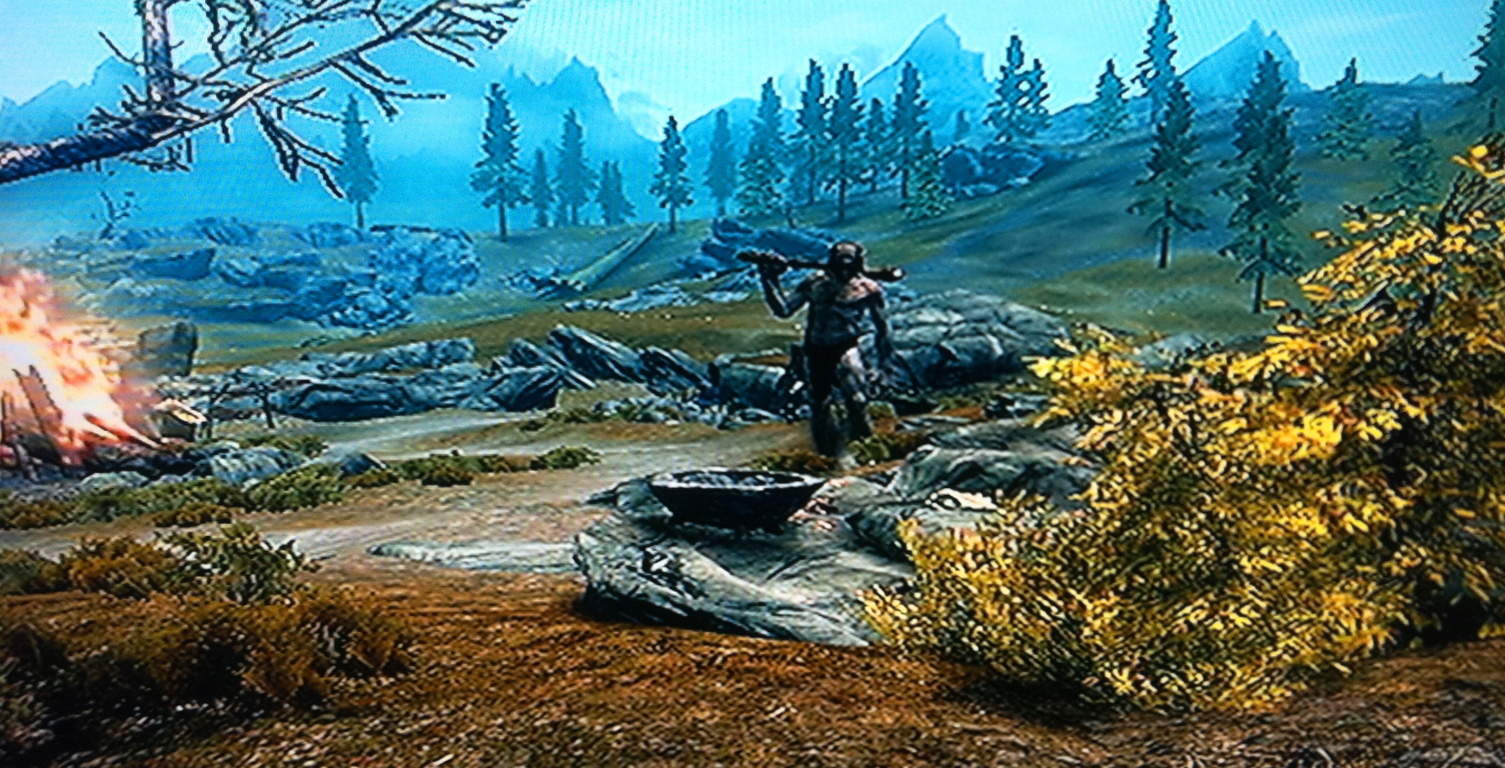 In Skyrim there are Dolmens, Standing Stones, Cairns, Free-Sitting Boulders, and Stone-Circles, all inhabited by giants, most of which also contain astrological significance. Suddenly Astrology, History, and Anthropology were ignited in my thoughts. It seemed to me that the designers of this game were signaling something to us, saying “wake up people, something amazing happened in the world once”. They had made a seamlessly logical scenario out of the Celtic universe, the ancient and half-forgotten world that we have only guessed at in this late phase of history. I began to wonder if these themes were really out there, in the actual world. If the Megaliths were cultural, then nobody could’ve moved them. I would just have to find them if I could. And that was my epiphany. I decided that when the snow melted, and the Spring finally came, I would go on my own real-time quest to find the Megalithic culture. Stonestrider.com would be born. My life has never been the same. I would like to use this post to just express some of the similarities between the game, and what I found in real time.
In Skyrim there are Dolmens, Standing Stones, Cairns, Free-Sitting Boulders, and Stone-Circles, all inhabited by giants, most of which also contain astrological significance. Suddenly Astrology, History, and Anthropology were ignited in my thoughts. It seemed to me that the designers of this game were signaling something to us, saying “wake up people, something amazing happened in the world once”. They had made a seamlessly logical scenario out of the Celtic universe, the ancient and half-forgotten world that we have only guessed at in this late phase of history. I began to wonder if these themes were really out there, in the actual world. If the Megaliths were cultural, then nobody could’ve moved them. I would just have to find them if I could. And that was my epiphany. I decided that when the snow melted, and the Spring finally came, I would go on my own real-time quest to find the Megalithic culture. Stonestrider.com would be born. My life has never been the same. I would like to use this post to just express some of the similarities between the game, and what I found in real time.
Waterfalls: Take a look at this waterfall I came across in the town of Mullaghduff, in Donegal, Ireland. It was totally untouched. No trails, signs, or markers of any kind. As far as I could tell, this Celtic waterfall was in its original state. More fantastic for me were the stones around the main Fall, which seemed curved, and cut, specifically into place, with smoothed arches and right angles actually hanging over the water. I couldn’t see how this configuration of stones would occur naturally. Look also to the left of the main Fall, there is a completely separate stone-cut path with beautifully crafted steps funneling the water. The level elevated bedrock of the main flow of water, combined with the crafted stones which are clearly curved and fitted above it, along with the separate funnel on the left, makes this seem like an engineered area, not a glacial miracle. That’s what I believe this is, an engineered waterway. There are also free-standing boulders that look more like markers heading progressively up the mountain directly beyond this waterway, which makes the area a prime candidate for an ancient Celtic, megalithically cultural center, just like what Skyrim depicts in the game.
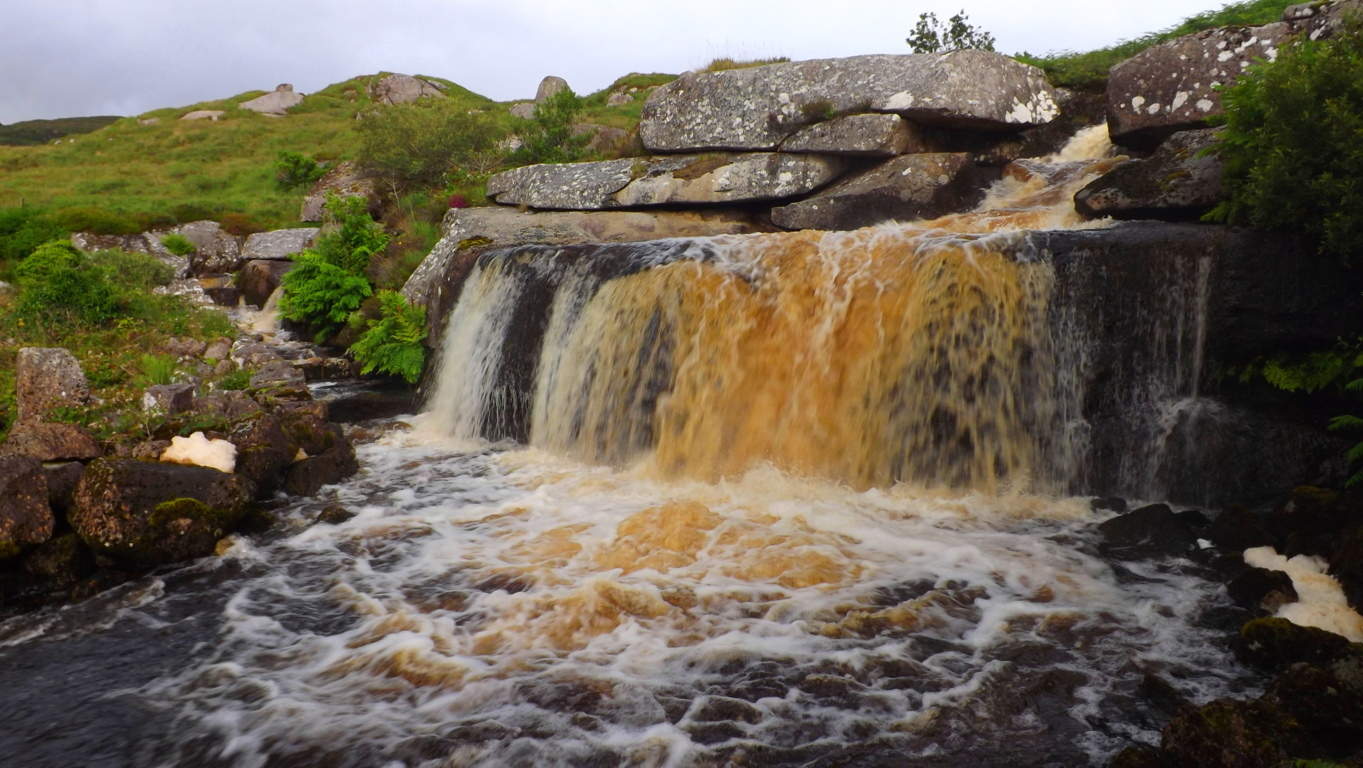 What’s even more interesting, is that this very real waterfall in Mullaghduff has more mysterious components to it than this very fictional waterfall in Skyrim. The main similarity between the two waterfalls is that they both focus on the idea that the water is centered and flowing through a specific, and elevated, rocky precipice, while otherwise surrounded by gorgeous grassy brush and hilly topography beyond. It’s as if both scenes are trying to tell us that something special happens at the rocky points of water-flow.
What’s even more interesting, is that this very real waterfall in Mullaghduff has more mysterious components to it than this very fictional waterfall in Skyrim. The main similarity between the two waterfalls is that they both focus on the idea that the water is centered and flowing through a specific, and elevated, rocky precipice, while otherwise surrounded by gorgeous grassy brush and hilly topography beyond. It’s as if both scenes are trying to tell us that something special happens at the rocky points of water-flow.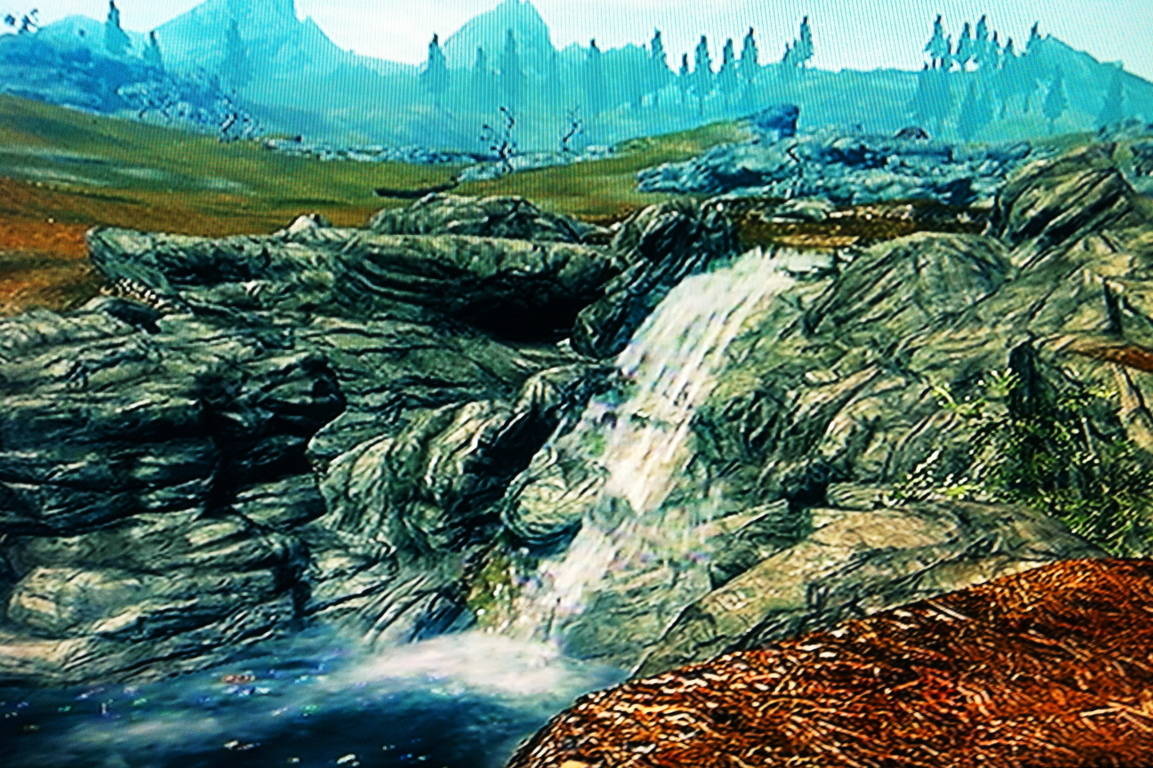 Mountain Streams: Here is a look at a mountain stream headed towards a Celtic alter in the heights of the Black Valley in the southern portion of Killarney National Park, Ireland. Take a look at the stones on the outer edge of the run of the water. The stones are not rounded, but they’re cut distinctly, seemingly directing the water in a funnel towards the center. The most obvious example is the largest stone in the center of this image; it is clearly cut, and with the directional purpose of funneling the water inward. I would also like to point out, that if you were to follow this stream up the mountain, you will come to a massive cut alter, with Celtic rings etched in its side.
Mountain Streams: Here is a look at a mountain stream headed towards a Celtic alter in the heights of the Black Valley in the southern portion of Killarney National Park, Ireland. Take a look at the stones on the outer edge of the run of the water. The stones are not rounded, but they’re cut distinctly, seemingly directing the water in a funnel towards the center. The most obvious example is the largest stone in the center of this image; it is clearly cut, and with the directional purpose of funneling the water inward. I would also like to point out, that if you were to follow this stream up the mountain, you will come to a massive cut alter, with Celtic rings etched in its side.
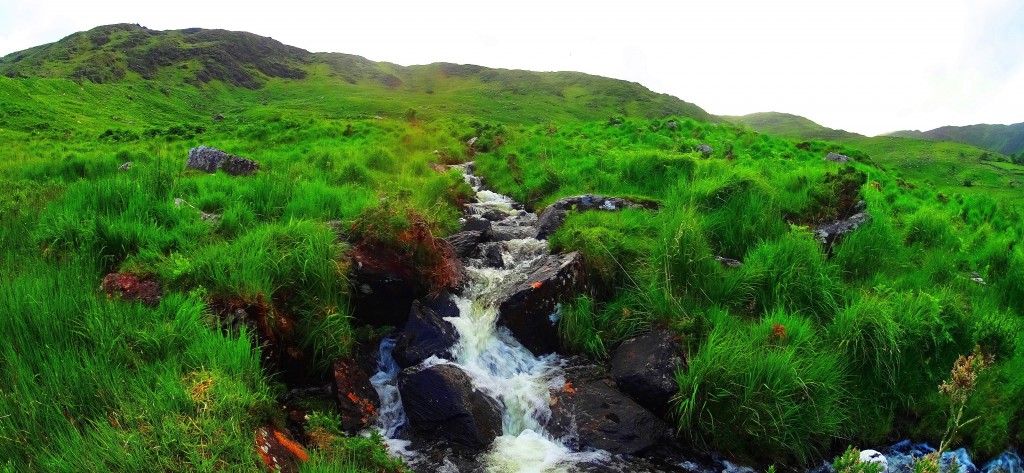 In Skyrim there are waterways that appear in the elevations, and they follow the flow of specifically dotted stone paths. I really feel that the game’s engineers noticed the stony designation of Celtic waterways. Whether or not they knew that the real life waterways were in many instances engineered, is for us to decide.
In Skyrim there are waterways that appear in the elevations, and they follow the flow of specifically dotted stone paths. I really feel that the game’s engineers noticed the stony designation of Celtic waterways. Whether or not they knew that the real life waterways were in many instances engineered, is for us to decide. 
Celtic Rings in Stone: Here is a look at the alter to be found at the top of the mountain stream in the Black Valley in Killarney. The rings cut into it are smooth and perfectly concentric, and hardly look like the work of a chisel at all.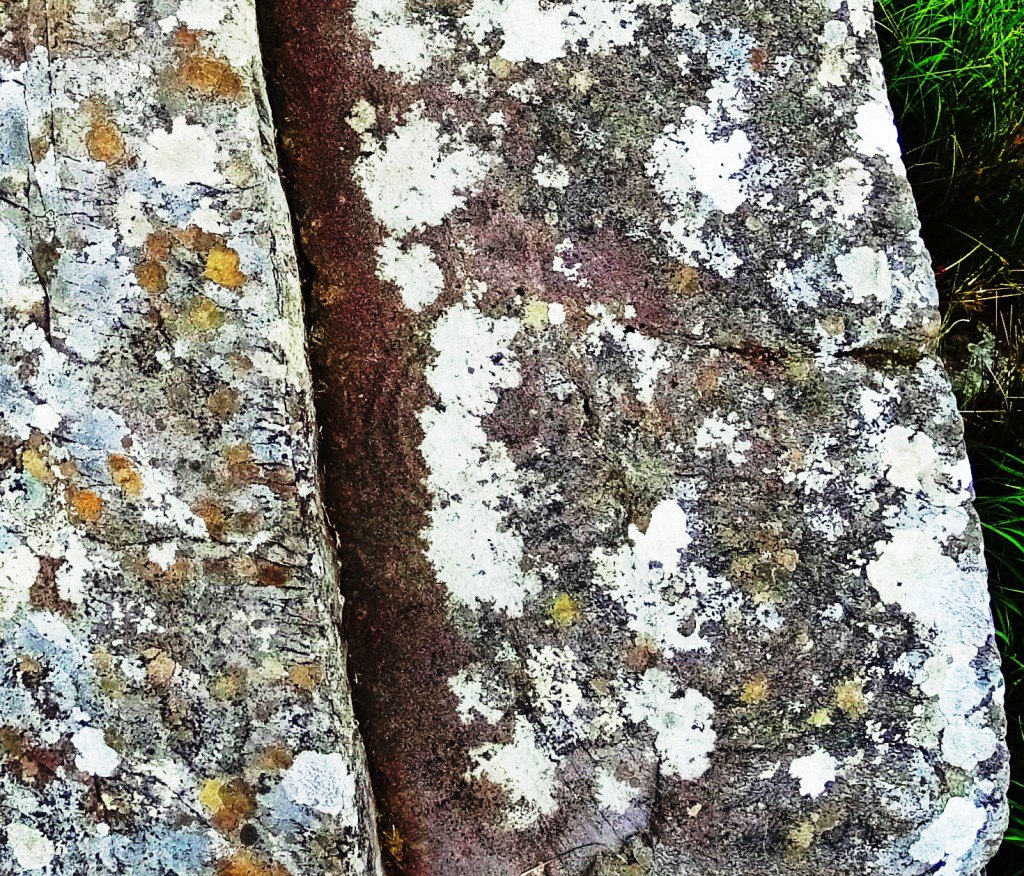 The rings are thousands of years old and hard to see now, shown just below center of the right slab, if you look close. It is clear that this slab was carved into linear sections, and ‘squared’. Even more incredible is that its location is near the top of a mountain. None of the other stones near by look even remotely like this. One last thing to take note of in this scene is that these slabs seem to be facing directly towards the central feature of the valley beyond, which is the beautiful lake Brinn, splitting the two mountains. There is just so much to consider when looking at Celtic ruins. It seems to me that they are far more than primitive markings. There is meaning in the direction in which stones face, what they depict, and where they are found. All of this is far from primitive, it’s actually elegant.
The rings are thousands of years old and hard to see now, shown just below center of the right slab, if you look close. It is clear that this slab was carved into linear sections, and ‘squared’. Even more incredible is that its location is near the top of a mountain. None of the other stones near by look even remotely like this. One last thing to take note of in this scene is that these slabs seem to be facing directly towards the central feature of the valley beyond, which is the beautiful lake Brinn, splitting the two mountains. There is just so much to consider when looking at Celtic ruins. It seems to me that they are far more than primitive markings. There is meaning in the direction in which stones face, what they depict, and where they are found. All of this is far from primitive, it’s actually elegant.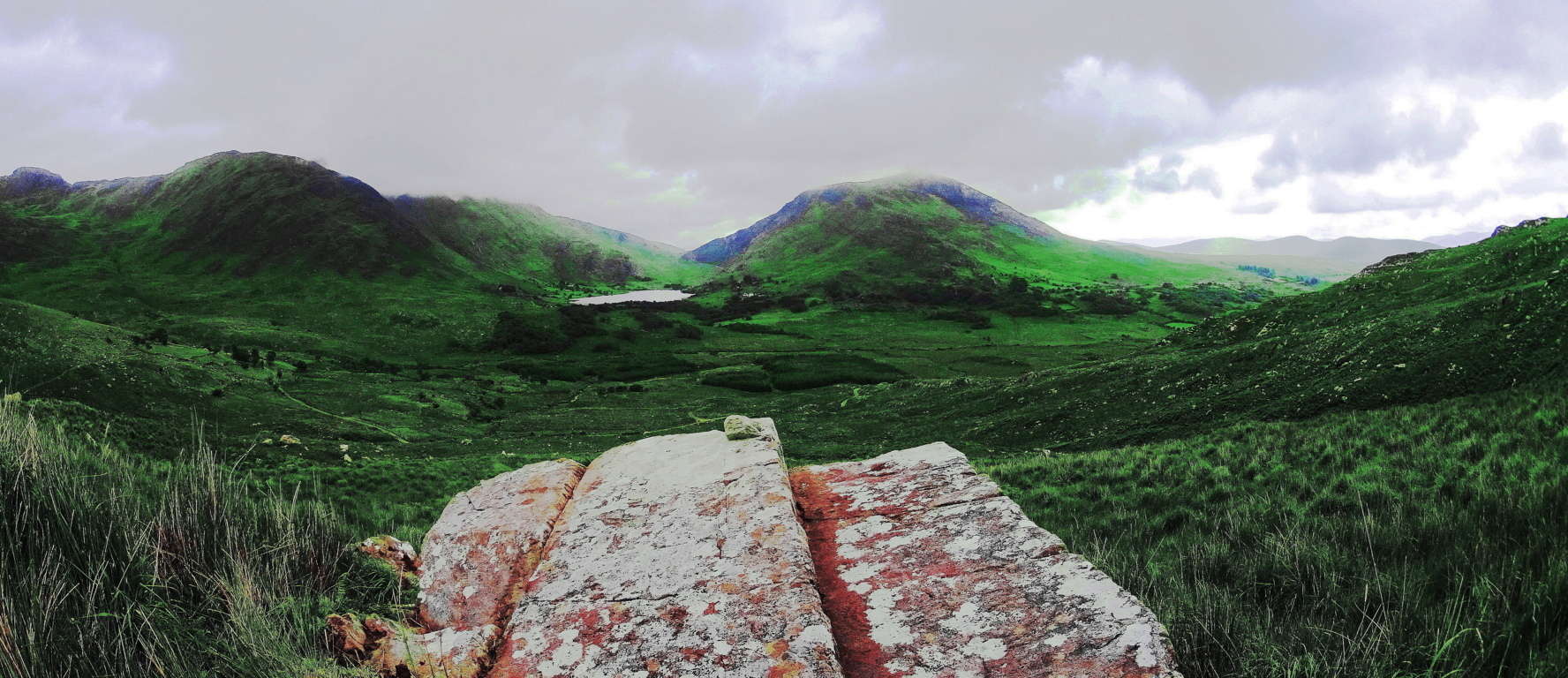 Now here is a view of a squared stone slab with semi-concentric rings on its face in Skyrim. Yet again, the more amazing and mysterious stone, is actually the real one.
Now here is a view of a squared stone slab with semi-concentric rings on its face in Skyrim. Yet again, the more amazing and mysterious stone, is actually the real one.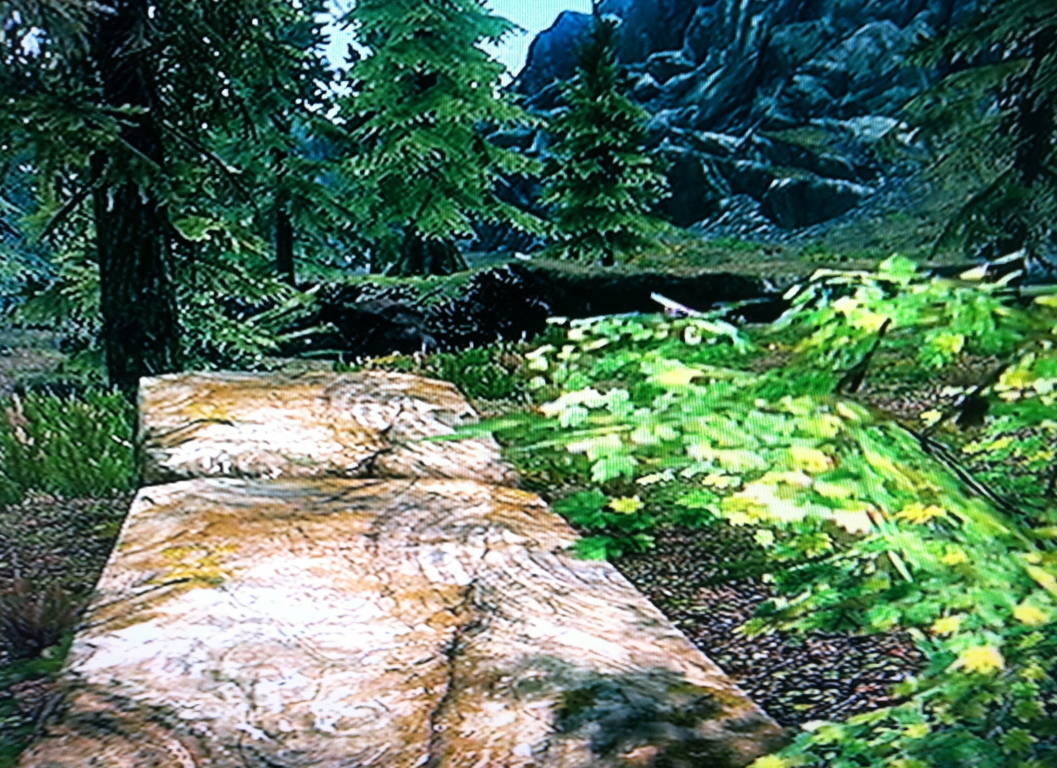 Free Sitting Boulders: I am sure that there are boulders that have been moved by glaciers. But I am equally sure that there are boulders that have not been moved by glaciers.
Free Sitting Boulders: I am sure that there are boulders that have been moved by glaciers. But I am equally sure that there are boulders that have not been moved by glaciers. Free-sitting-boulders can most often be found guarding areas where sacred Dolmens or Wedge Tombs are directly near by. Here is an example of a free-sitting-boulder that I came across placed 30 yards from the incredible Wedge Tomb at Cavan Burren National Park in Ireland (Image on Right, click on it to look closer/Additionally, at this Wedge Tomb, are three stone-linings all converging directly on it/the linings are energy transfers, not walls). I am absolutely certain that this boulder was placed here as a marker to display the area as ‘occupied’. I imagine that this was a fair warning, a way of saying, “if you cross this massive marker, you will have to deal with the individual who is strong enough to put this here”. Notice how the boulder is placed exactly over another granite face below it. Scientists want us to believe that this boulder came to rest exactly on top of this other rock face beneath it, moved at random by glacial displacement? The odds are beyond gastronomical. I’m sorry, but no. This is a megalithic cultural statement, a boundary, near a Wedge Tomb.
Free-sitting-boulders can most often be found guarding areas where sacred Dolmens or Wedge Tombs are directly near by. Here is an example of a free-sitting-boulder that I came across placed 30 yards from the incredible Wedge Tomb at Cavan Burren National Park in Ireland (Image on Right, click on it to look closer/Additionally, at this Wedge Tomb, are three stone-linings all converging directly on it/the linings are energy transfers, not walls). I am absolutely certain that this boulder was placed here as a marker to display the area as ‘occupied’. I imagine that this was a fair warning, a way of saying, “if you cross this massive marker, you will have to deal with the individual who is strong enough to put this here”. Notice how the boulder is placed exactly over another granite face below it. Scientists want us to believe that this boulder came to rest exactly on top of this other rock face beneath it, moved at random by glacial displacement? The odds are beyond gastronomical. I’m sorry, but no. This is a megalithic cultural statement, a boundary, near a Wedge Tomb. Here is the equivalent in Skyrim. This free sitting boulder is directly on the edge of a Cairn inhabited by giants in the game. It becomes increasingly clear that the Skyrim writers know something the general population has yet to imagine possible, or has perhaps forgotten.
Here is the equivalent in Skyrim. This free sitting boulder is directly on the edge of a Cairn inhabited by giants in the game. It becomes increasingly clear that the Skyrim writers know something the general population has yet to imagine possible, or has perhaps forgotten.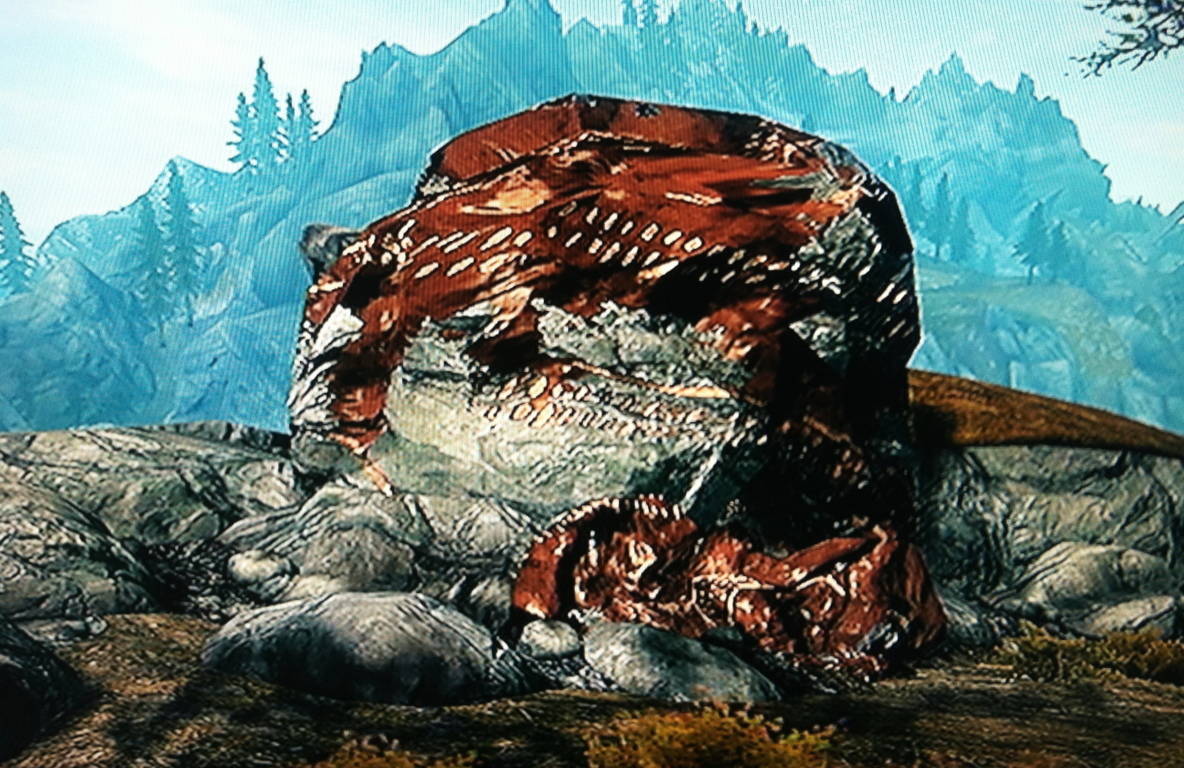 Standing Stones: The simple wonder of standing stones can move you. Here is an 8 foot standing stone in the heights of the Conwy Valley, Wales. Again, this stone weighs at least two tons. Moving this, and to such an elevation from the valley below, would seem crazy by human standards. I believe this standing stone is another type of marker, placed by the individual(s) who wanted to live away from the common collectives of people down below, and it served as a warning to them. More compelling is the fact that this stone is 100 yards from beautiful Dolmen just down the Roman pathway.
Standing Stones: The simple wonder of standing stones can move you. Here is an 8 foot standing stone in the heights of the Conwy Valley, Wales. Again, this stone weighs at least two tons. Moving this, and to such an elevation from the valley below, would seem crazy by human standards. I believe this standing stone is another type of marker, placed by the individual(s) who wanted to live away from the common collectives of people down below, and it served as a warning to them. More compelling is the fact that this stone is 100 yards from beautiful Dolmen just down the Roman pathway. 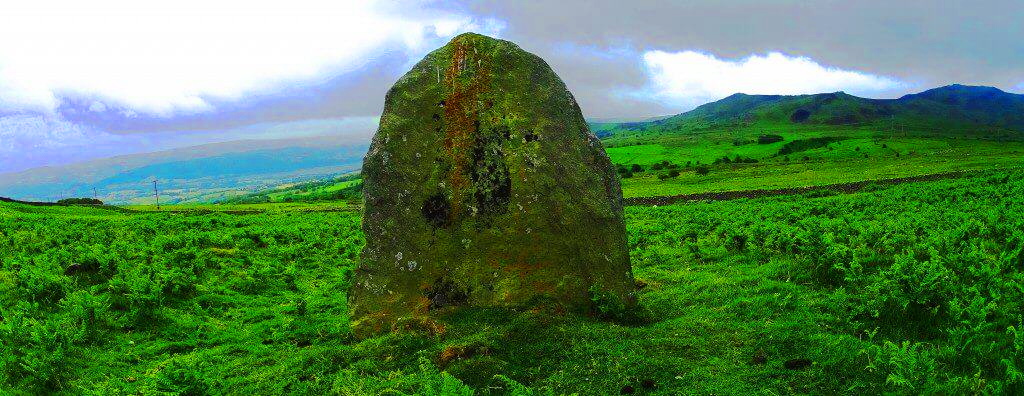 Here is an image of a nice standing stone in Skyrim with what looks like similar dynamics.
Here is an image of a nice standing stone in Skyrim with what looks like similar dynamics.
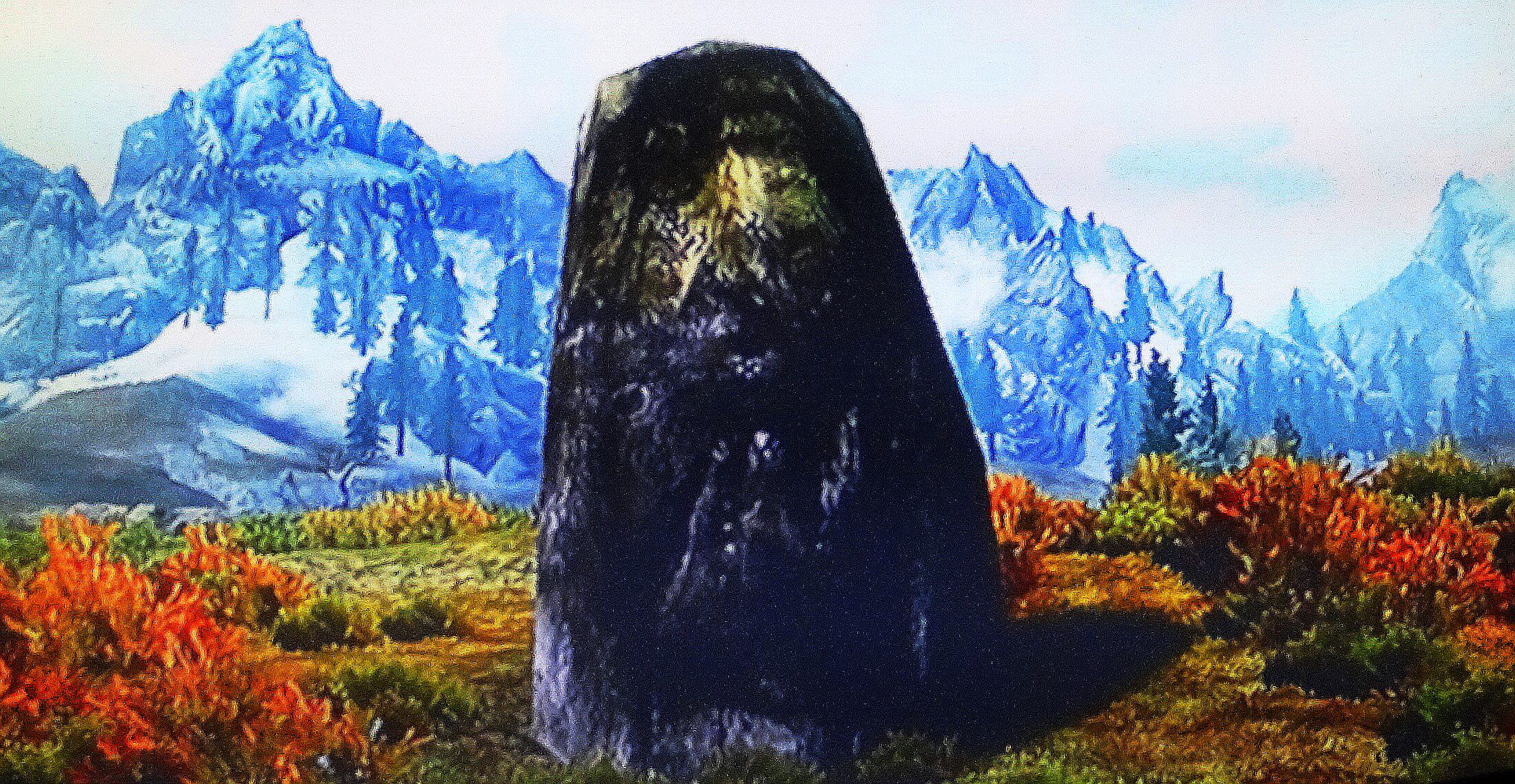 Stacked and level megaliths: The most obvious and famous example of stacked and level megaliths is Stonehenge. The mystery of Stonehenge is one of the most important and fascinating in the world. There is so much that goes into creating sections like these, including grand notches that are cut and fit to be fixed into place like Jurassic Legos. To do this with sarsen stone, the hardest stone in the world, is almost inconceivable for a primitive culture at the start of history. Here is a look at just one section of Stonehenge.
Stacked and level megaliths: The most obvious and famous example of stacked and level megaliths is Stonehenge. The mystery of Stonehenge is one of the most important and fascinating in the world. There is so much that goes into creating sections like these, including grand notches that are cut and fit to be fixed into place like Jurassic Legos. To do this with sarsen stone, the hardest stone in the world, is almost inconceivable for a primitive culture at the start of history. Here is a look at just one section of Stonehenge.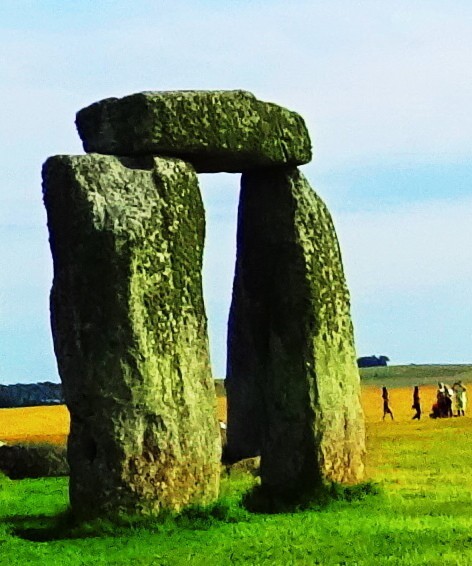 And here is a look at one section of an entrance to a cairn in Skyrim. Same proportions. Same idea.
And here is a look at one section of an entrance to a cairn in Skyrim. Same proportions. Same idea.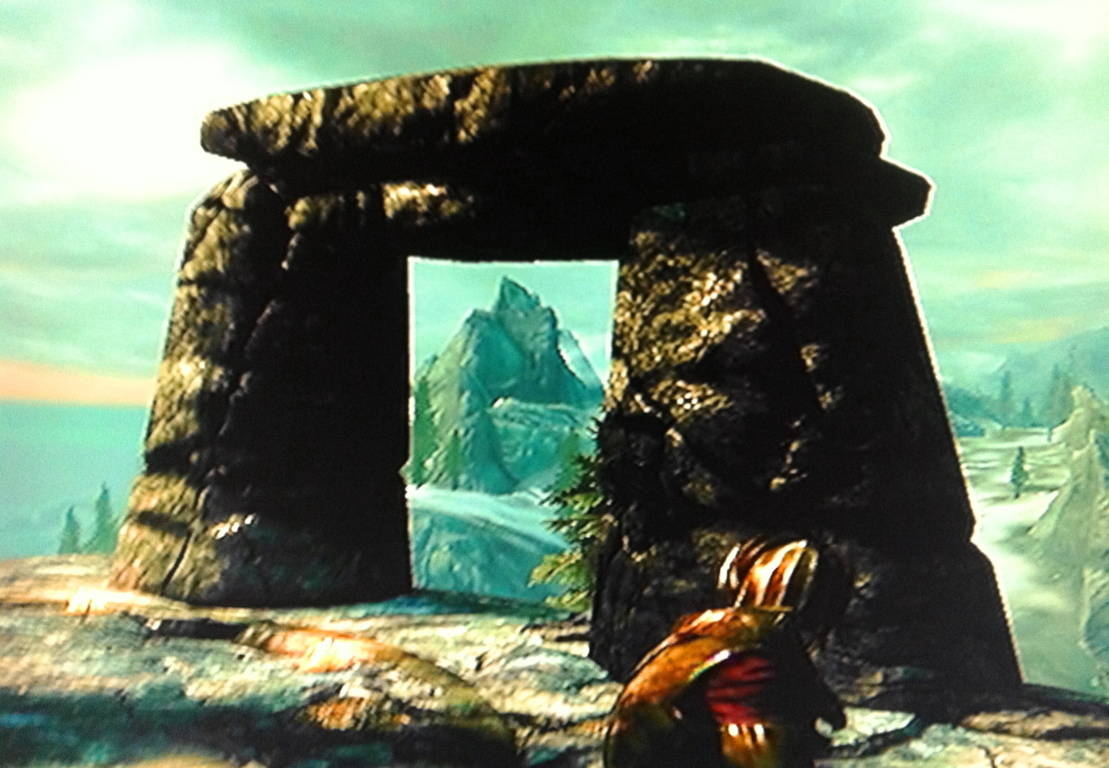 Amazing Natural Beauty: It is so important not to forget the natural beauty surrounding the mystery of Celtic culture. Mountains and valleys are simple and worthy reasons for celebration. I just want to mix and match some actual scenes that I was lucky enough to come across, with scenes from Skyrim below.
Amazing Natural Beauty: It is so important not to forget the natural beauty surrounding the mystery of Celtic culture. Mountains and valleys are simple and worthy reasons for celebration. I just want to mix and match some actual scenes that I was lucky enough to come across, with scenes from Skyrim below.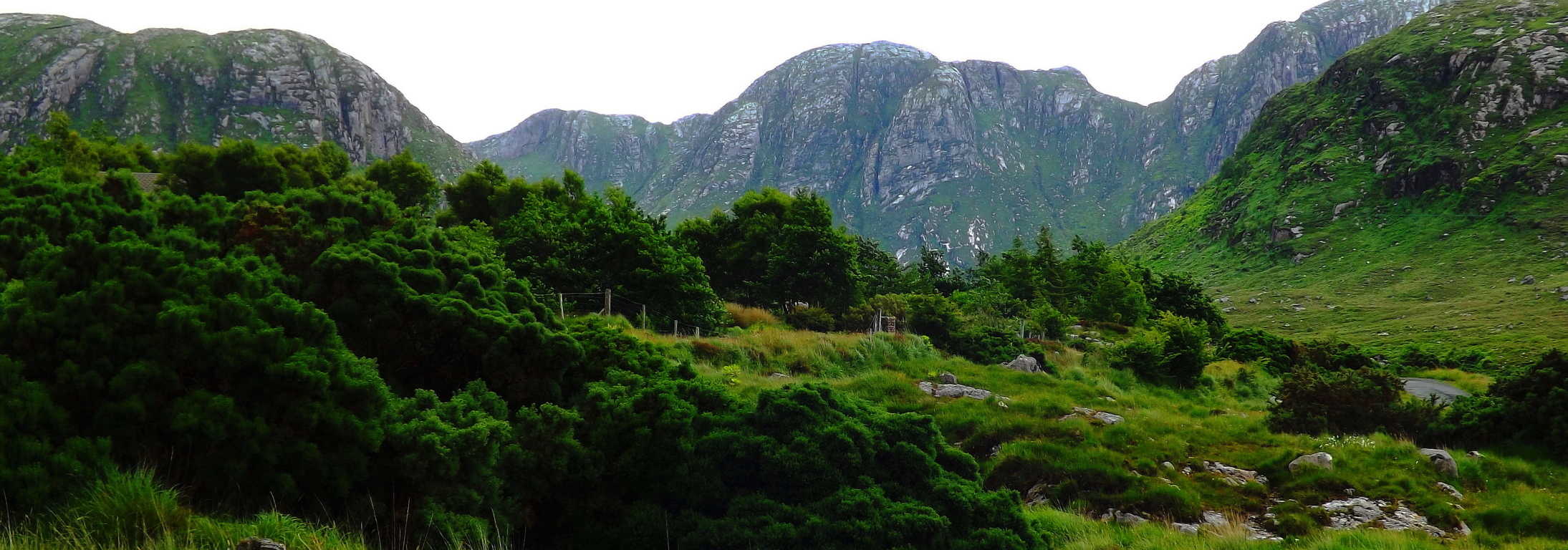 The fantastic images in Skyrim should inspire you to try to climb mountains and explore valleys, however distant from you.
The fantastic images in Skyrim should inspire you to try to climb mountains and explore valleys, however distant from you.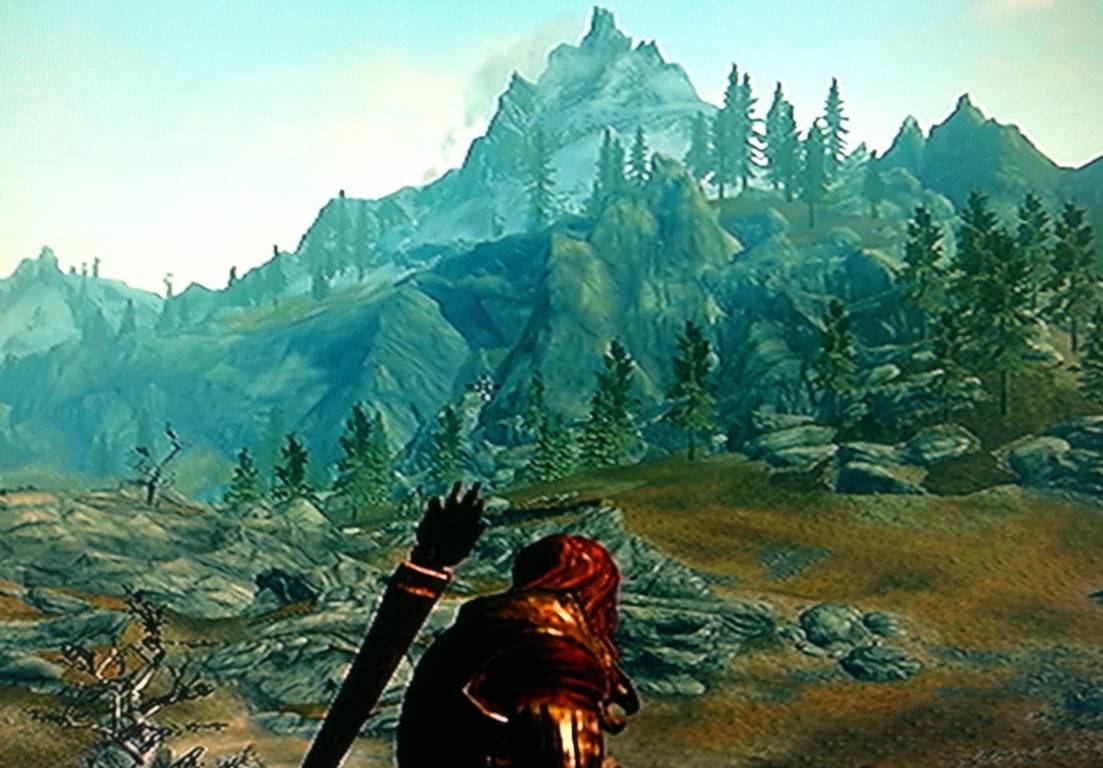 You can do it! Something tremendous is revealed when you get out and take a close look at wild natural spaces. There is a hidden megalithic culture beneath us, and in some preserved places, totally visible.
You can do it! Something tremendous is revealed when you get out and take a close look at wild natural spaces. There is a hidden megalithic culture beneath us, and in some preserved places, totally visible. The Skyrim engineers have somehow put together a vision in their game that taps into the myths in a way that is almost signaling us, warning us, that there is more going on in this world than we are being told by commercial banks, governments, and people.
The Skyrim engineers have somehow put together a vision in their game that taps into the myths in a way that is almost signaling us, warning us, that there is more going on in this world than we are being told by commercial banks, governments, and people.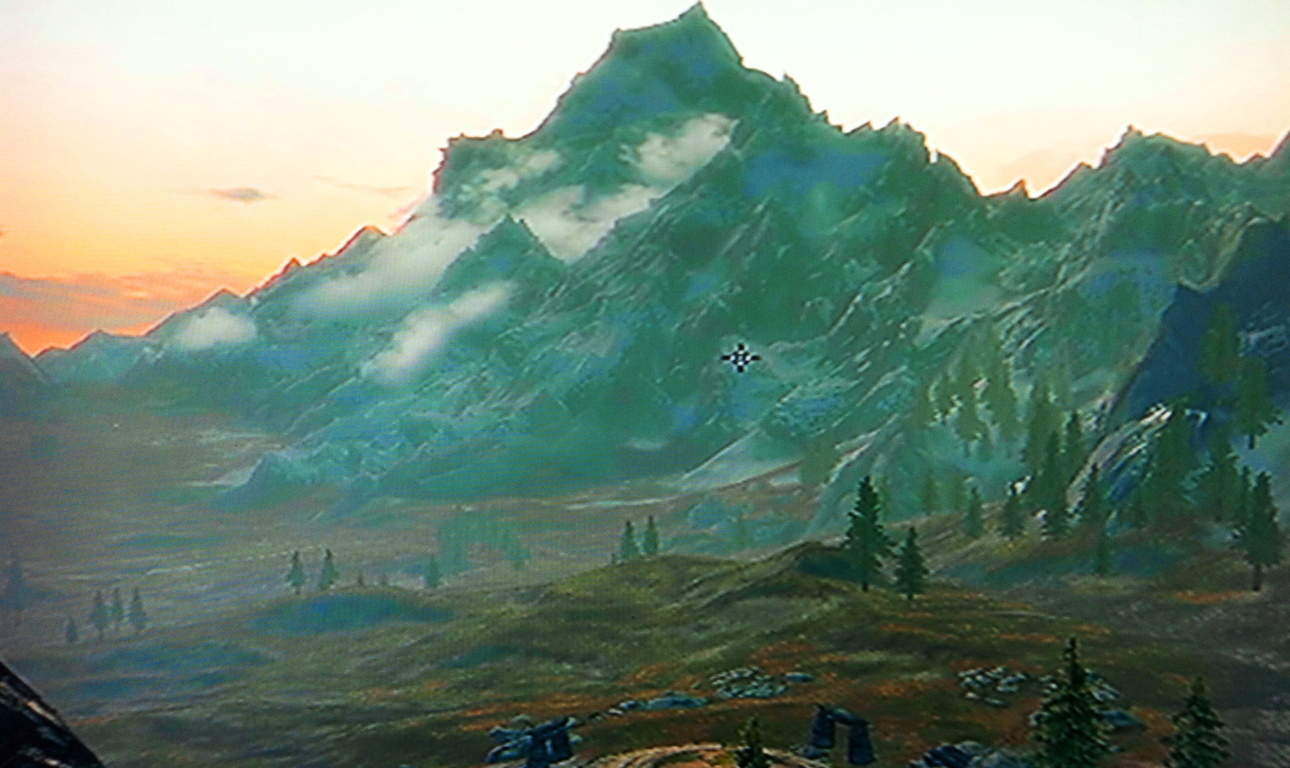 I would like to thank the makers of Skyrim for inspiring me to think and wonder for myself just how much of what they are proposing might be true…
I would like to thank the makers of Skyrim for inspiring me to think and wonder for myself just how much of what they are proposing might be true…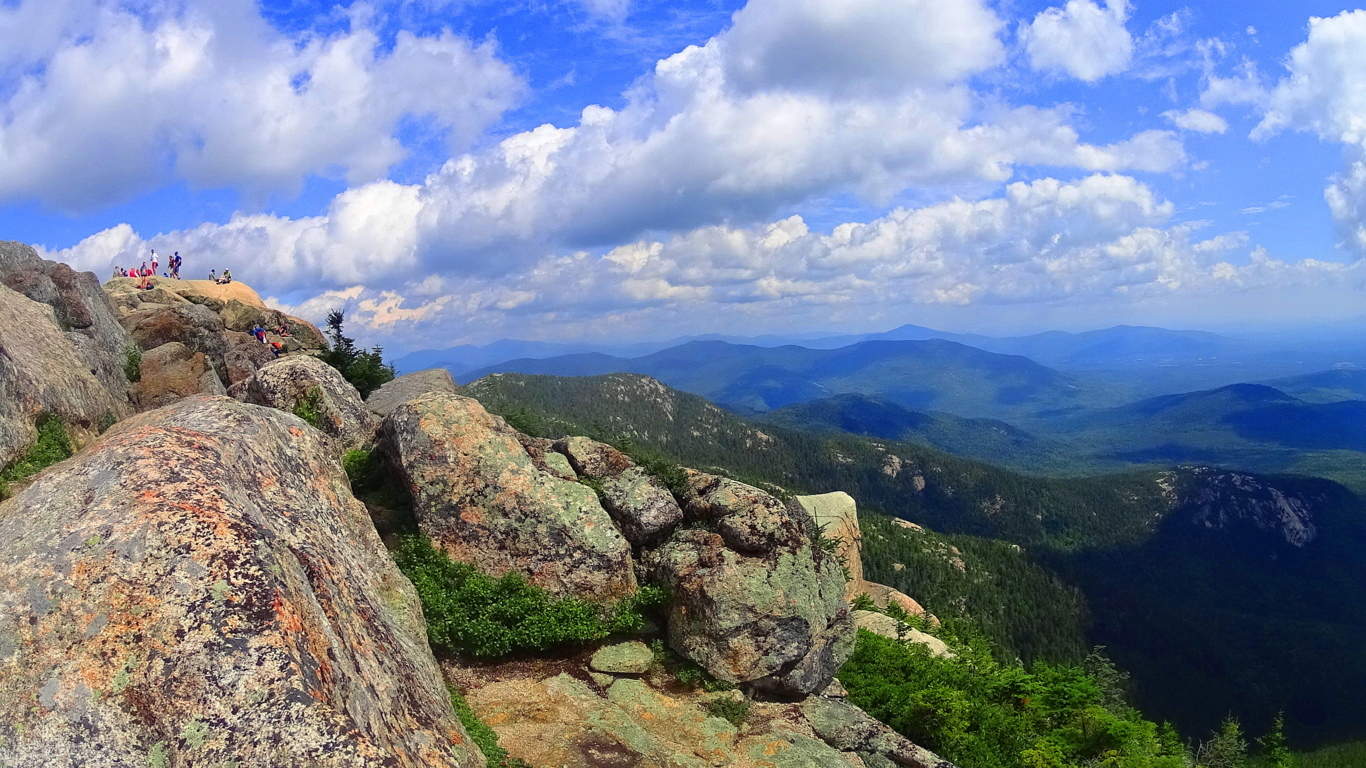 ..which is far more than I would’ve known, had I not gone in search after the miserable winter of 2014. I will end this post with this statement: Biblical scriptures and the Dead Sea Scrolls speak of giants in the land, before, and after Noah. There are entire narratives dedicated to this premise about giants. “Seek and Find the Sacred” is not just a nifty cliche, its your personal invitation to understand the most mysterious and amazing things first hand, not relying on some other persons opinion, but developing your own. The megaliths are there, in dynamic positions, with symbols and angles, waiting to be understood. All of this takes place in a naturally beautiful, and often romantically distant places, far from the manic urban centers. You have nothing to lose by letting go, and going for it. I hope to see you out there. And however far out “out there” might be, the better.
..which is far more than I would’ve known, had I not gone in search after the miserable winter of 2014. I will end this post with this statement: Biblical scriptures and the Dead Sea Scrolls speak of giants in the land, before, and after Noah. There are entire narratives dedicated to this premise about giants. “Seek and Find the Sacred” is not just a nifty cliche, its your personal invitation to understand the most mysterious and amazing things first hand, not relying on some other persons opinion, but developing your own. The megaliths are there, in dynamic positions, with symbols and angles, waiting to be understood. All of this takes place in a naturally beautiful, and often romantically distant places, far from the manic urban centers. You have nothing to lose by letting go, and going for it. I hope to see you out there. And however far out “out there” might be, the better. 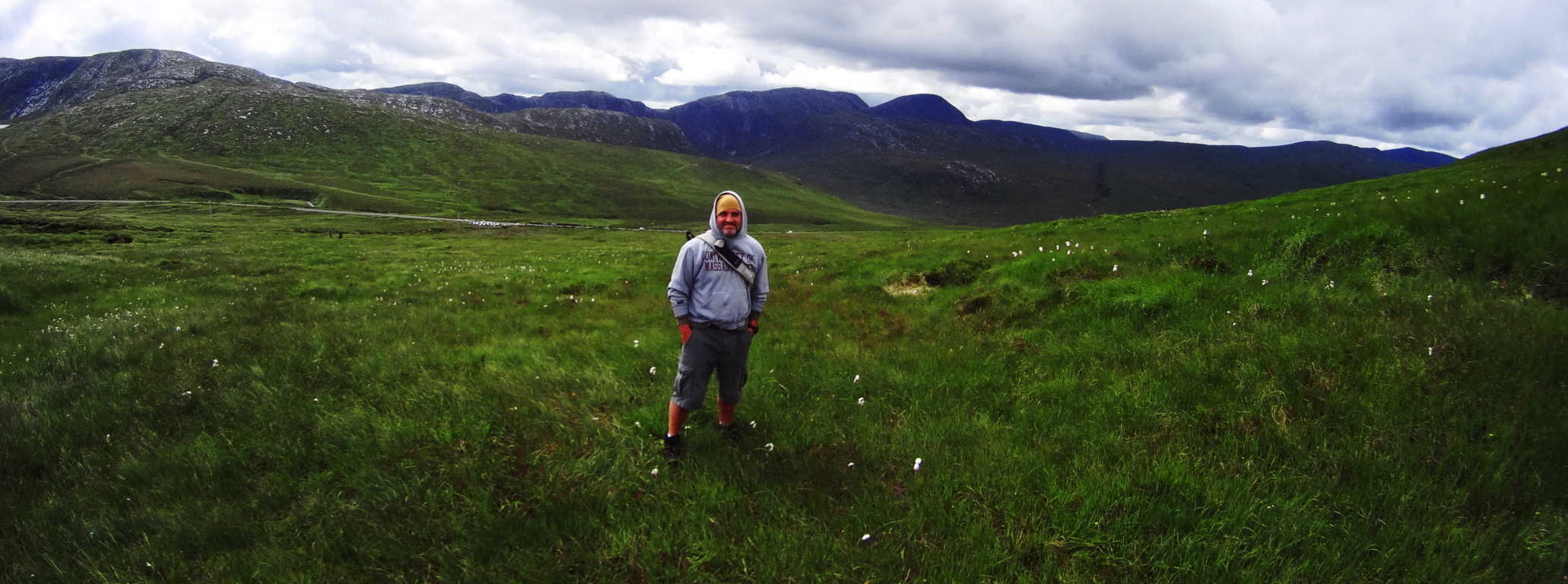
Avebury Stone Circle
Note: The broad and beautiful rolling hills southwest of London is home to some of the most mysterious wonders in the world. This designated area has a rather unassuming name, considering the undeniable mysteries it contains, known simply as ‘Wiltshire’. It could be called something more relevant, like “Temple-haven”, or “God-stone-shire”, but the humble title remains. The district of Wiltshire is basically a 50-by-50-mile zone extending from the cities of Ashton Keynes at the northern edge, down to Salisbury in the south, not far from England’s gorgeous southern coast. During the dry season in England, which is late summer, this area is host to campers, hikers, bikers, and anthropologists. Teams of hikers can be found attempting expeditions from the southern tip of nearby Cornwall, north to Snowdon Range in Wales, all the way up to Glencoe Scotland. Many of these outdoor enthusiasts begin here, in Wiltshire. The Wiltshire hills and fields feel at least four to five times more broad then in Ireland, Scotland, or New England. In antiquity England was known as Albion, which means: “Land of Giants”, and on this wide open Celtic plain, the title seems appropriate.
The district of Wiltshire is basically a 50-by-50-mile zone extending from the cities of Ashton Keynes at the northern edge, down to Salisbury in the south, not far from England’s gorgeous southern coast. During the dry season in England, which is late summer, this area is host to campers, hikers, bikers, and anthropologists. Teams of hikers can be found attempting expeditions from the southern tip of nearby Cornwall, north to Snowdon Range in Wales, all the way up to Glencoe Scotland. Many of these outdoor enthusiasts begin here, in Wiltshire. The Wiltshire hills and fields feel at least four to five times more broad then in Ireland, Scotland, or New England. In antiquity England was known as Albion, which means: “Land of Giants”, and on this wide open Celtic plain, the title seems appropriate. It becomes easy to imagine giants roaming across these fields, tending flocks, roasting lamb over great bonfires, and watching the stars in the fair season, very much like they are depicted in the Celtic Xbox game, Skyrim.
It becomes easy to imagine giants roaming across these fields, tending flocks, roasting lamb over great bonfires, and watching the stars in the fair season, very much like they are depicted in the Celtic Xbox game, Skyrim.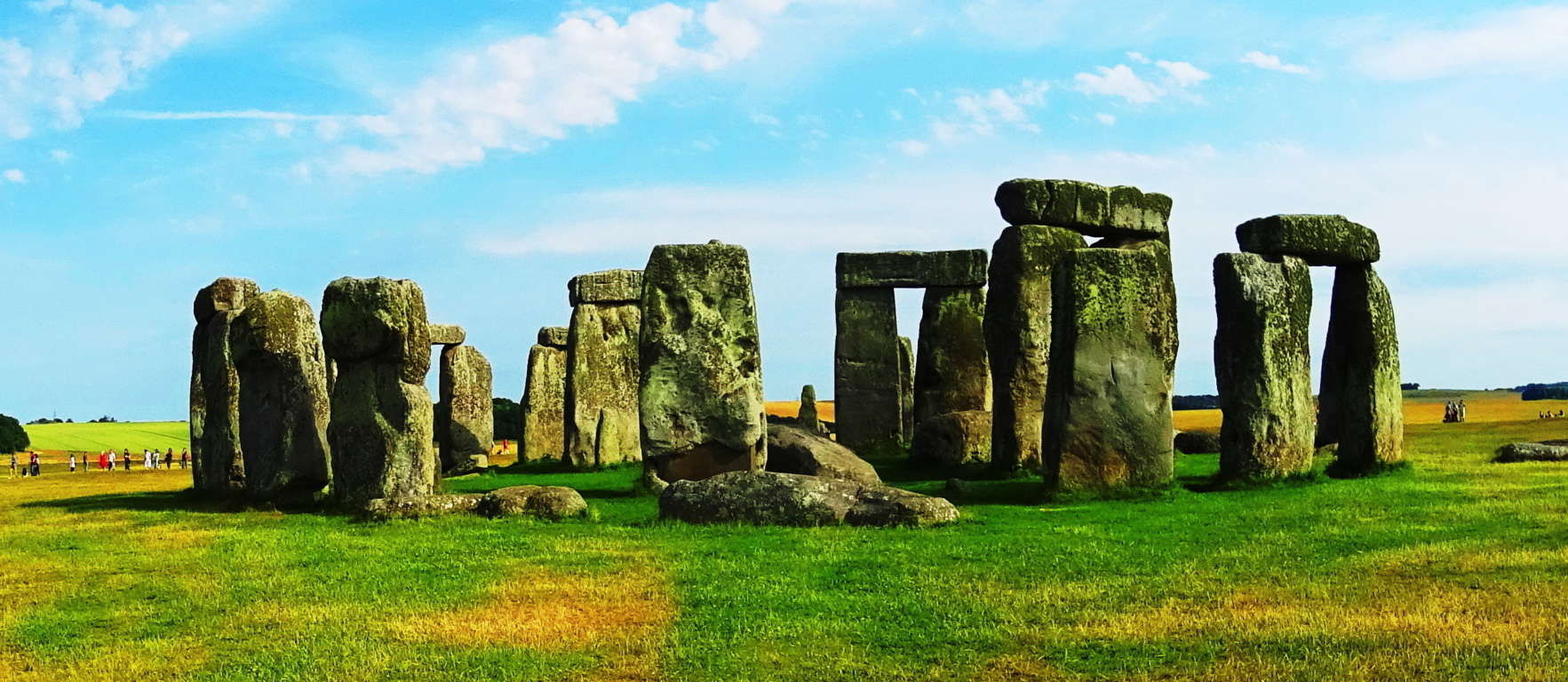 This is an extremely picturesque open space, with hedges, crops, and surviving ancient old-growth trees standing stoically against a universe of looming green fields. The fascinating, and world renown Stonehenge, is within the boarders of Wiltshire, receiving international visitors numbering into the thousands every year. However, an equally incredible and mysterious megalithic place exists just 20 miles south of Stonehenge, a place which most people don’t seem to know about, that place being Avebury Stone Circle. Avebury is nothing less than the largest stone circle on earth.
This is an extremely picturesque open space, with hedges, crops, and surviving ancient old-growth trees standing stoically against a universe of looming green fields. The fascinating, and world renown Stonehenge, is within the boarders of Wiltshire, receiving international visitors numbering into the thousands every year. However, an equally incredible and mysterious megalithic place exists just 20 miles south of Stonehenge, a place which most people don’t seem to know about, that place being Avebury Stone Circle. Avebury is nothing less than the largest stone circle on earth.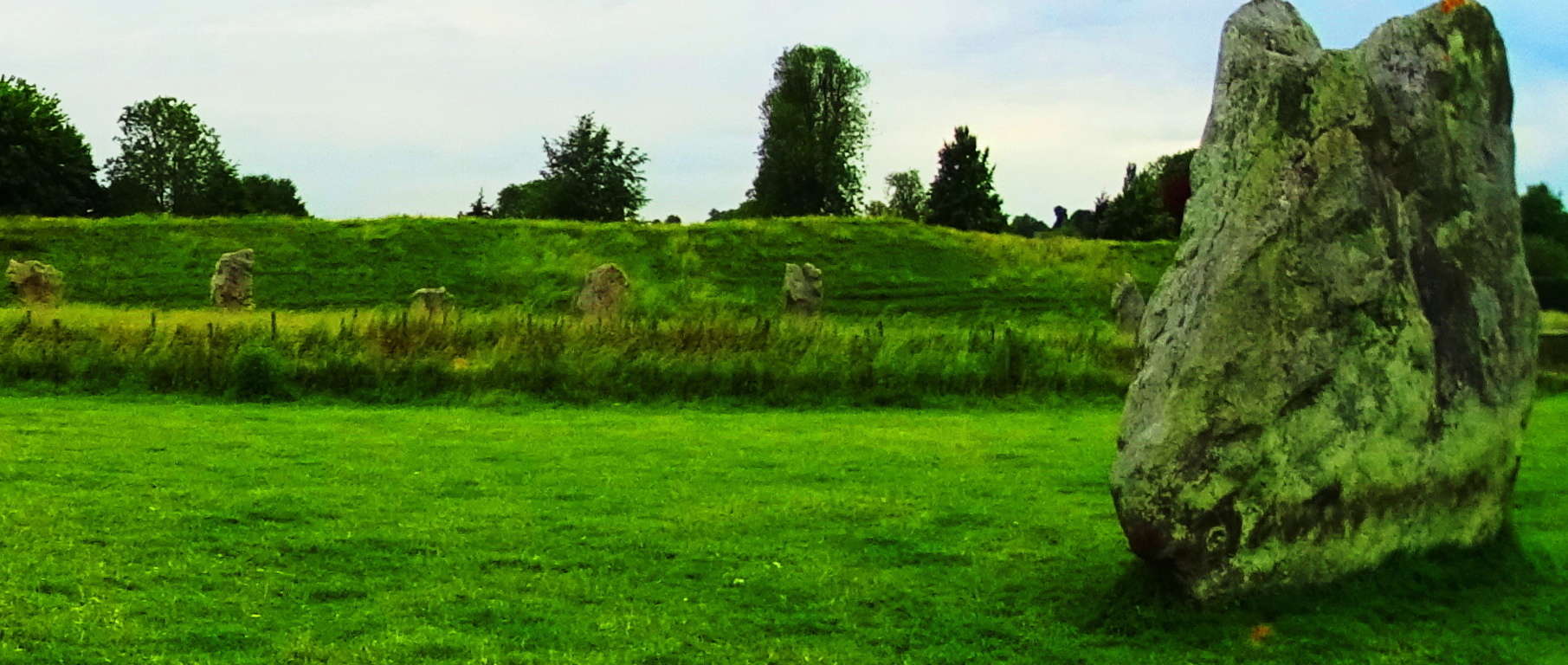 Not only is the radius of the outer circle about a mile long, but the 98 Sarsen stones that make this circle are without a doubt the largest possible standing stones that could’ve been placed here.
Not only is the radius of the outer circle about a mile long, but the 98 Sarsen stones that make this circle are without a doubt the largest possible standing stones that could’ve been placed here. Each stone is, at a minimum, 12 feet tall, by 3 feet in width, and some are larger. These standing stones range from 50 to 60 tons each. It’s boarding on impossible. That’s roughly 12 MILLION pounds of stone in one place. Here are some examples of perhaps the largest standing stones on earth below…
Each stone is, at a minimum, 12 feet tall, by 3 feet in width, and some are larger. These standing stones range from 50 to 60 tons each. It’s boarding on impossible. That’s roughly 12 MILLION pounds of stone in one place. Here are some examples of perhaps the largest standing stones on earth below…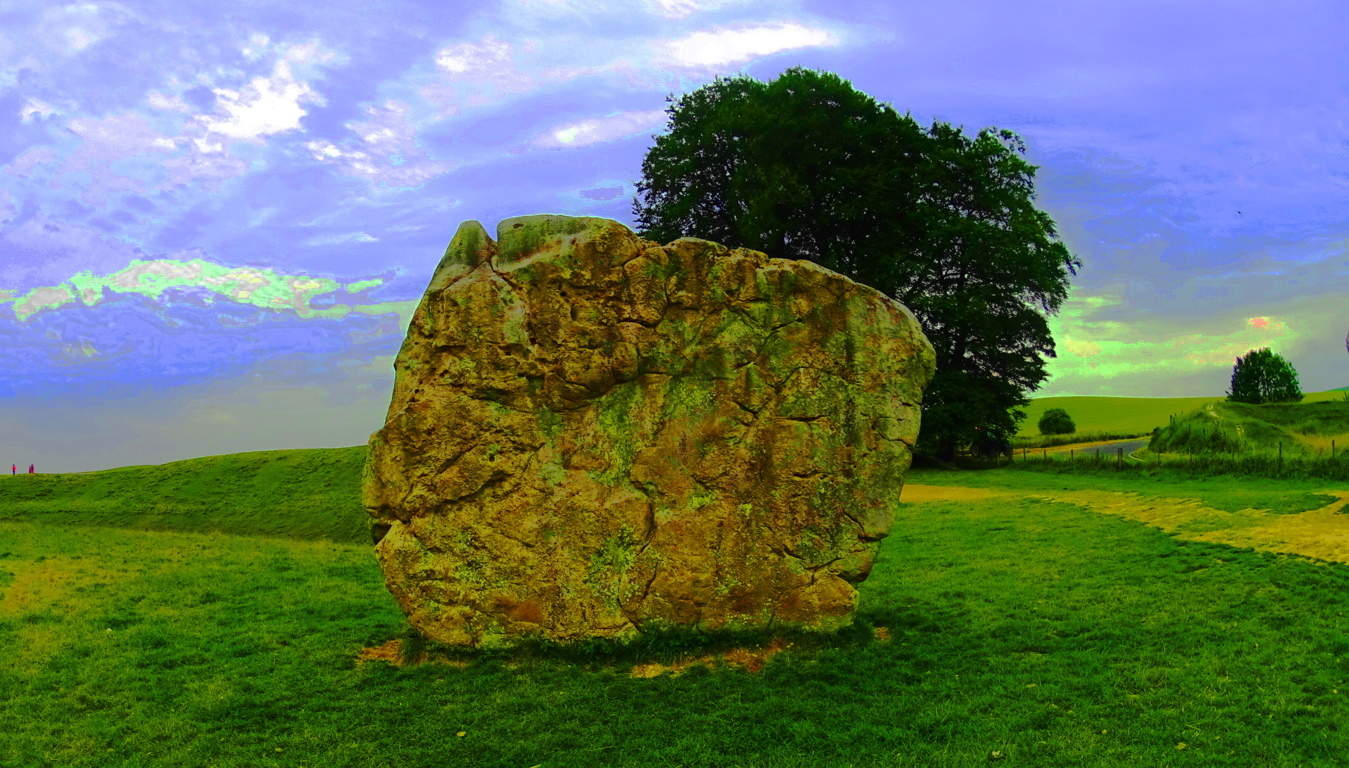 There are also two smaller inner stone circles within the overall ring, with more customary stones that are about 6 feet high and 2 foot in width, but several of those stones are now missing. Altogether, this is a grandly concentric scene, with circles within circles of impossibly placed stones, like interwoven gears in a Jurassic size clock.
There are also two smaller inner stone circles within the overall ring, with more customary stones that are about 6 feet high and 2 foot in width, but several of those stones are now missing. Altogether, this is a grandly concentric scene, with circles within circles of impossibly placed stones, like interwoven gears in a Jurassic size clock.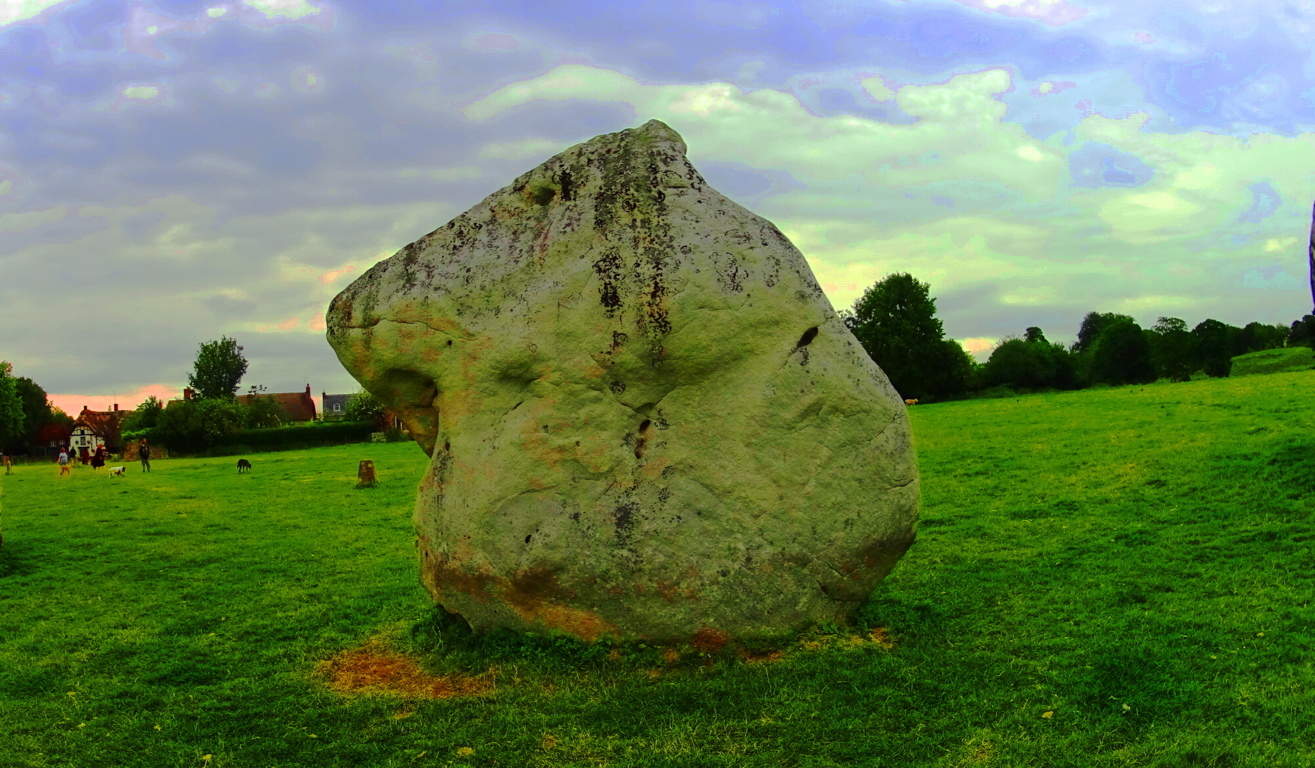 A hike within these rings is a dreamlike experience. Each stone has an absolutely distinct character and individuality, unlike the sarsens at Stonehenge, which are uniform in character, most likely indicating a different meaning. Each standing stone is a type of unique masterpiece, an essay on individuality. If you study standing stones enough, it is hard not to look at people the same way, with subtle nuances and individual markings that make them unique and amazing. Incredibly, standing stones convey many such meanings like this, without a single etched word anywhere. It is simply the nature of the statement itself, the stone as an expression, that draws out our faculties to find the meaning. It would indicate that whoever put these standing stones here was, at minimum, aware of the meanings they would convey forever after. And yet there is so much mystery.
A hike within these rings is a dreamlike experience. Each stone has an absolutely distinct character and individuality, unlike the sarsens at Stonehenge, which are uniform in character, most likely indicating a different meaning. Each standing stone is a type of unique masterpiece, an essay on individuality. If you study standing stones enough, it is hard not to look at people the same way, with subtle nuances and individual markings that make them unique and amazing. Incredibly, standing stones convey many such meanings like this, without a single etched word anywhere. It is simply the nature of the statement itself, the stone as an expression, that draws out our faculties to find the meaning. It would indicate that whoever put these standing stones here was, at minimum, aware of the meanings they would convey forever after. And yet there is so much mystery.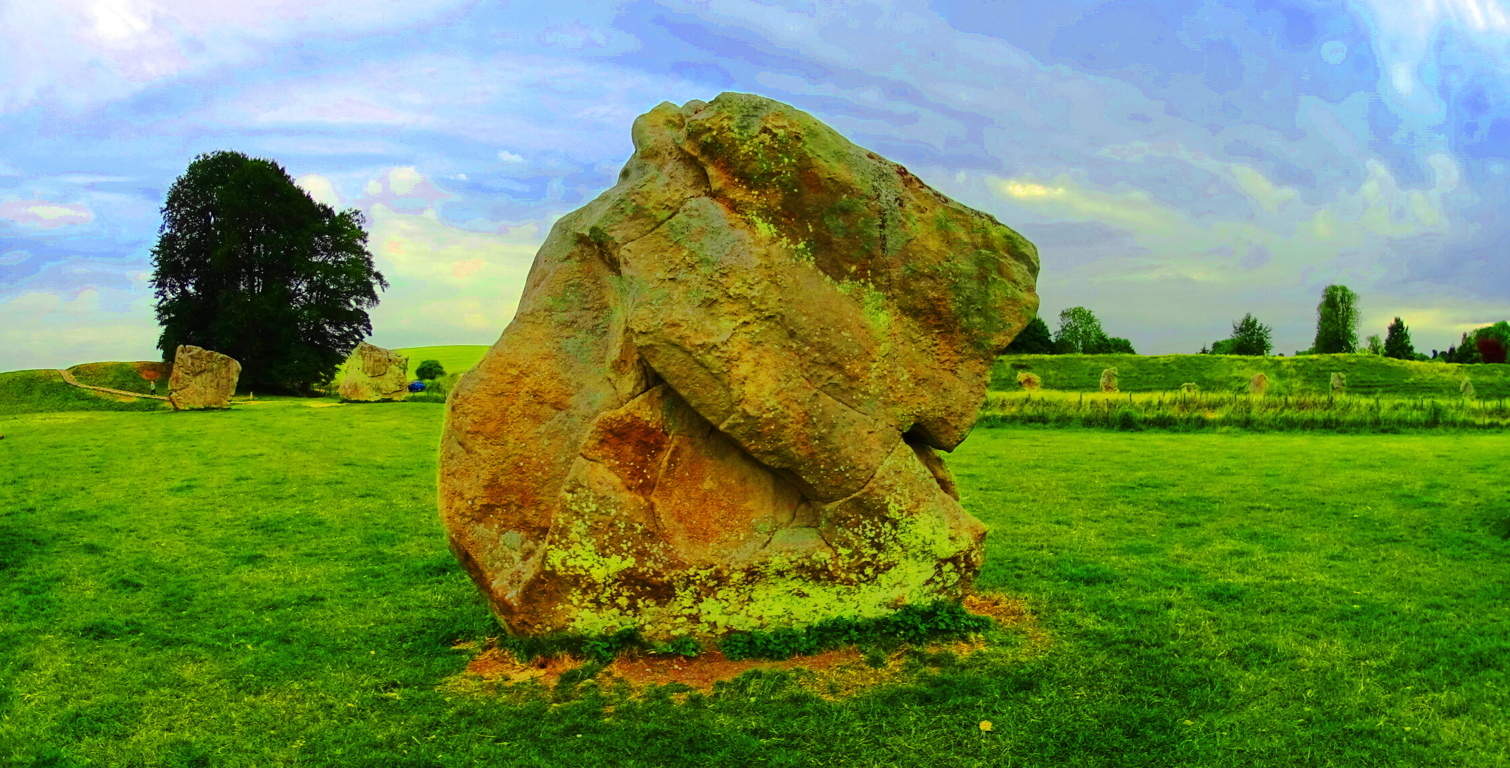 It would seem clear that each stone was chosen specifically for its attributes at Avebury. It becomes impossible not to wonder how these stones came to be here, and why each was chosen.
It would seem clear that each stone was chosen specifically for its attributes at Avebury. It becomes impossible not to wonder how these stones came to be here, and why each was chosen.
The amount of work that it would’ve required to move 12 million pounds of stone in the Neolithic period is incomprehensible. The undertaking would’ve cost hundreds, perhaps thousands of lives, and for several reasons. Neolithic England was a place of Celtic tribal hunter-gatherers, and these tribes would’ve guarded their territories against any trespassers or invaders with deadly force. Moving 98, sixty-ton stones, slowly across a hostilely protected landscape (perhaps with wooden rolling logs and ropes) seems totally illogical.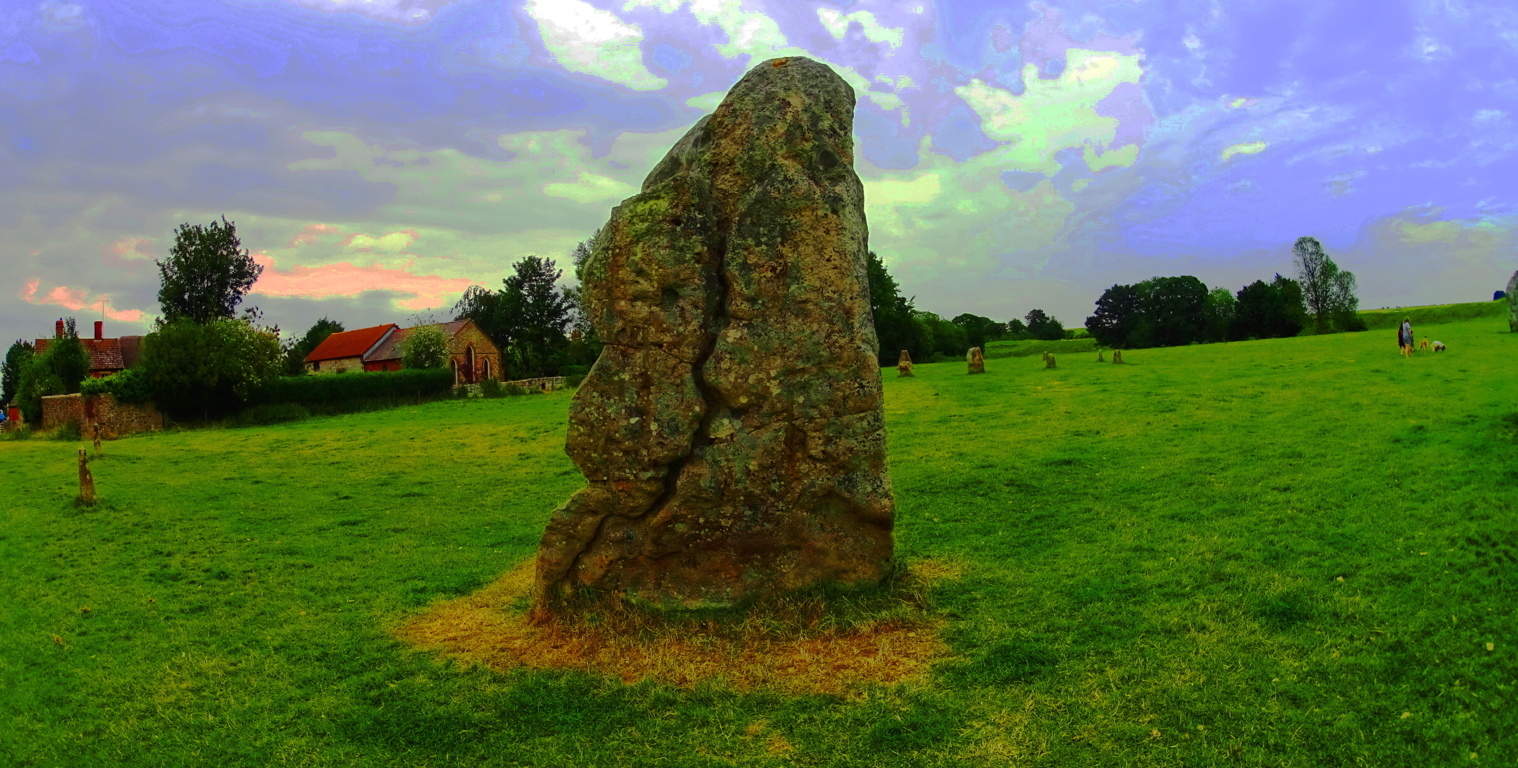 And how many miles have the stones been moved from wherever they came from? This is 12 million pounds of stone we’re taking about, so it presumably makes sense that this effort took several generations, and all of this effort just to create something for which the function is not entirely known? Pretty crazy.
And how many miles have the stones been moved from wherever they came from? This is 12 million pounds of stone we’re taking about, so it presumably makes sense that this effort took several generations, and all of this effort just to create something for which the function is not entirely known? Pretty crazy.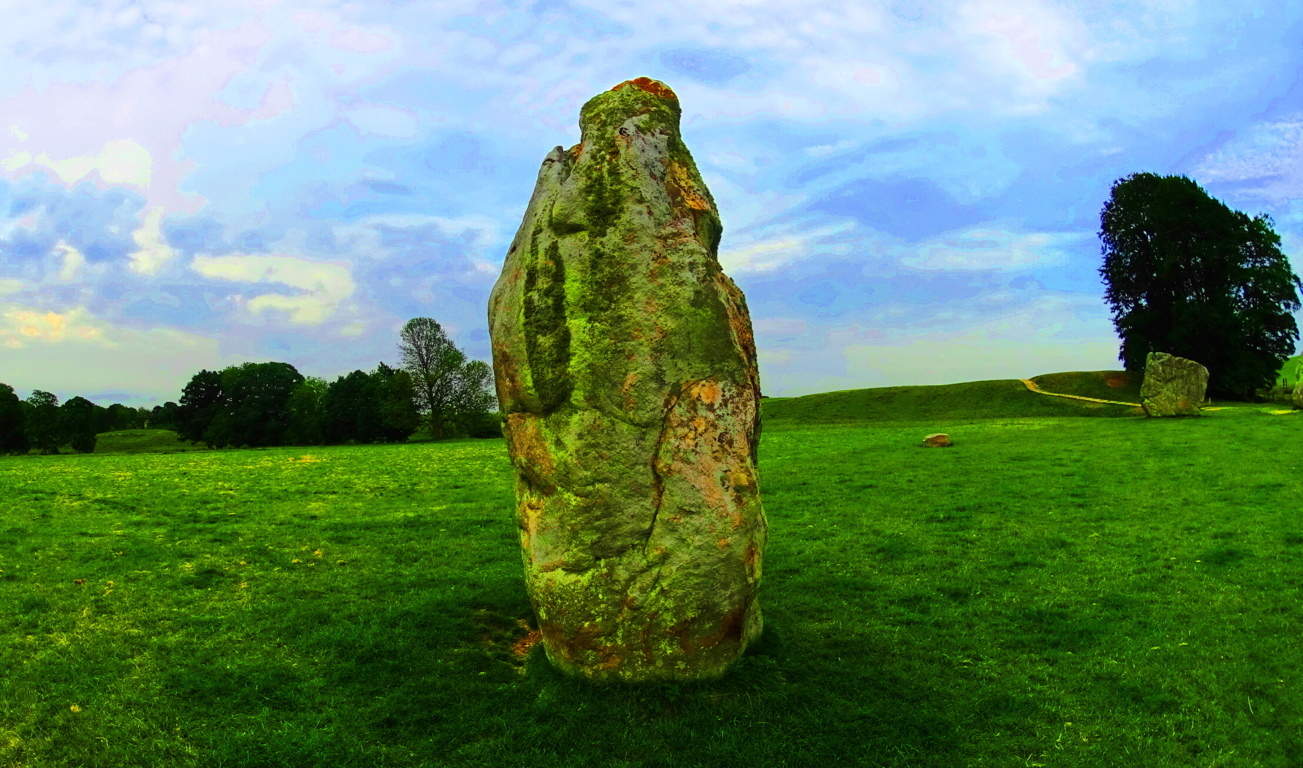 Interestingly enough, if you place your hand on these stones for more than a minute, you can literally feel some kind of charge moving through them. With all the mystery surrounding this place, you could hardly be surprised.
Interestingly enough, if you place your hand on these stones for more than a minute, you can literally feel some kind of charge moving through them. With all the mystery surrounding this place, you could hardly be surprised.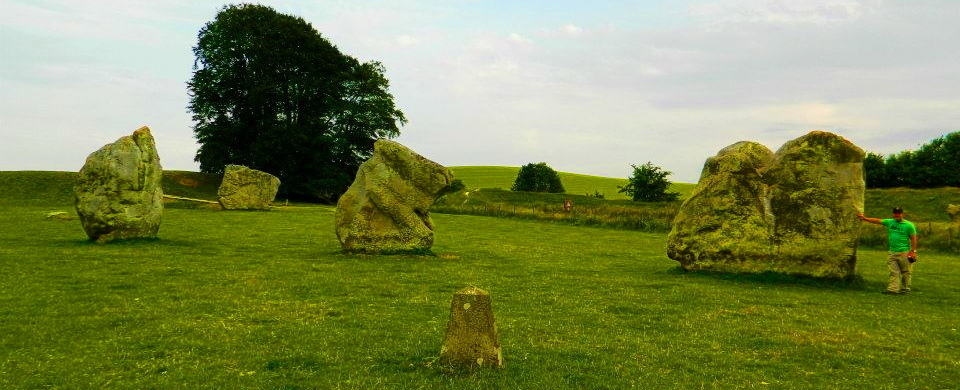 Avebury is obviously a Celtic spiritual center, and one of the most important in the world. The history here goes back to the very beginning of recorded time.
Avebury is obviously a Celtic spiritual center, and one of the most important in the world. The history here goes back to the very beginning of recorded time.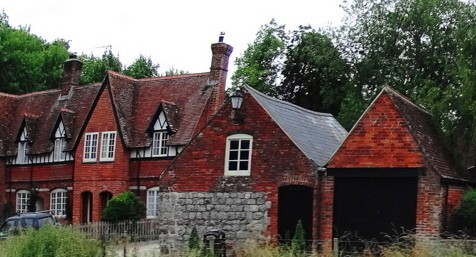 Druids and Celtic peoples would’ve come here to perform their sacred rites. The classic medieval Tudors in the backdrop behind these ancient stones display a middle age period alive and well in the present day. It is understandable that an author like J.R.R Tolkien so adeptly created his amazing novel not far from here in Oxford, weaving very human themes into mysterious magical memes so seamlessly, influenced by places like this for certain. Avebury is a living crossroads for all of these themes. The exact significance of the placement of these stones is not known. Like so many megalithic sites, it may well be that there are astrological/historical connections that we have yet to understand. I believe that the actual truth about who built this place, and why, is still unknown, and suppressed. If you ever get to Avebury, put your hand on one of the megaliths for two minutes, you will understand, from the subtle but significant charge that runs up your arm, that something more is going on at megalithic sites than just “big rocks in the grass”. I hope you make it there soon. Find your way.
Druids and Celtic peoples would’ve come here to perform their sacred rites. The classic medieval Tudors in the backdrop behind these ancient stones display a middle age period alive and well in the present day. It is understandable that an author like J.R.R Tolkien so adeptly created his amazing novel not far from here in Oxford, weaving very human themes into mysterious magical memes so seamlessly, influenced by places like this for certain. Avebury is a living crossroads for all of these themes. The exact significance of the placement of these stones is not known. Like so many megalithic sites, it may well be that there are astrological/historical connections that we have yet to understand. I believe that the actual truth about who built this place, and why, is still unknown, and suppressed. If you ever get to Avebury, put your hand on one of the megaliths for two minutes, you will understand, from the subtle but significant charge that runs up your arm, that something more is going on at megalithic sites than just “big rocks in the grass”. I hope you make it there soon. Find your way.
The Blue Hills Wildlife Preserve
 Location Milton, Massachusetts
Location Milton, Massachusetts
Note: The Blue Hills is a quintessential New England hiking area, with the perfect combination of rocky pathways, quiet groves, elevated vistas, and mysterious stones. Trails include the Walcott Loop, the Skyline Trail, Rattlesnake Trail, Great Blue Hill, and dozens of minor trails to be discovered. Great Blue Hill is the highest elevation here at 695 feet. There is over 6000 acres to explore, with the option to mountain-bike, which thousands of people enjoy during the Spring season. There is preserved old-growth forest, inclusive of 100 foot Pines, small Birch groves, Hemlocks, and Oaks. Some of the trails are wide pathways lined with small cut stones, while others are staircases cut right out of the hills.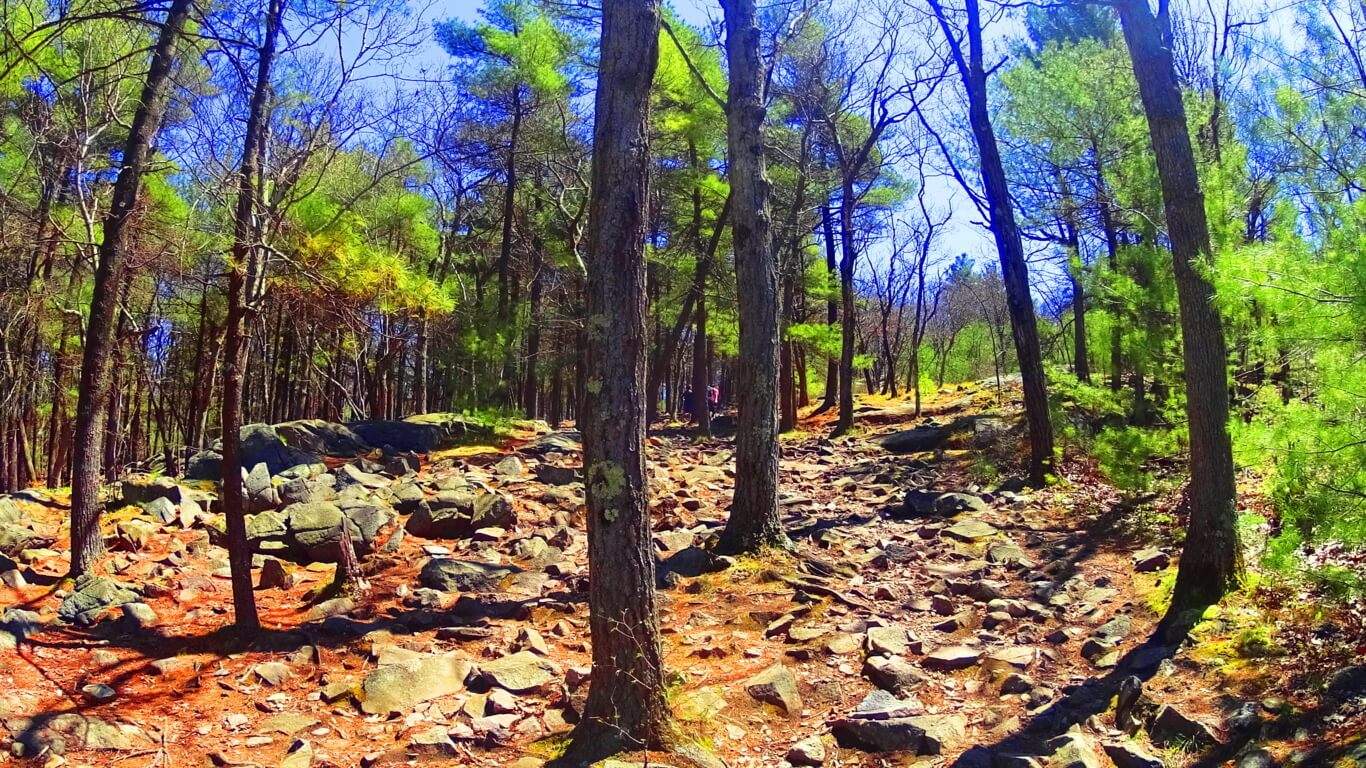 Blue Hills was a sacred place for the Native Americans for thousands of years before the Europeans arrived. We can certainly see why. The Colonials that arrived in the “New World” were fleeing what they considered to be a completely bought-out scene in England, Scotland, and Ireland. Lords and Men-of-property owned, and taxed, all the land, from the Medieval period into the Colonial. The 17th century in Europe was actually a “late’ period in terms of land ownership. Everything was owned. There was nothing left. Christian Puritans found the state of affairs in London, and elsewhere, intolerable. They decided to take their chances on getting their own land across the Atlantic Ocean. When these mostly poor pilgrims, explorers, trappers, and farmers arrived, and began to explore the forests and hills of this wilderness, what they found, in places like Blue Hills, would absolutely astonish them.
Blue Hills was a sacred place for the Native Americans for thousands of years before the Europeans arrived. We can certainly see why. The Colonials that arrived in the “New World” were fleeing what they considered to be a completely bought-out scene in England, Scotland, and Ireland. Lords and Men-of-property owned, and taxed, all the land, from the Medieval period into the Colonial. The 17th century in Europe was actually a “late’ period in terms of land ownership. Everything was owned. There was nothing left. Christian Puritans found the state of affairs in London, and elsewhere, intolerable. They decided to take their chances on getting their own land across the Atlantic Ocean. When these mostly poor pilgrims, explorers, trappers, and farmers arrived, and began to explore the forests and hills of this wilderness, what they found, in places like Blue Hills, would absolutely astonish them. 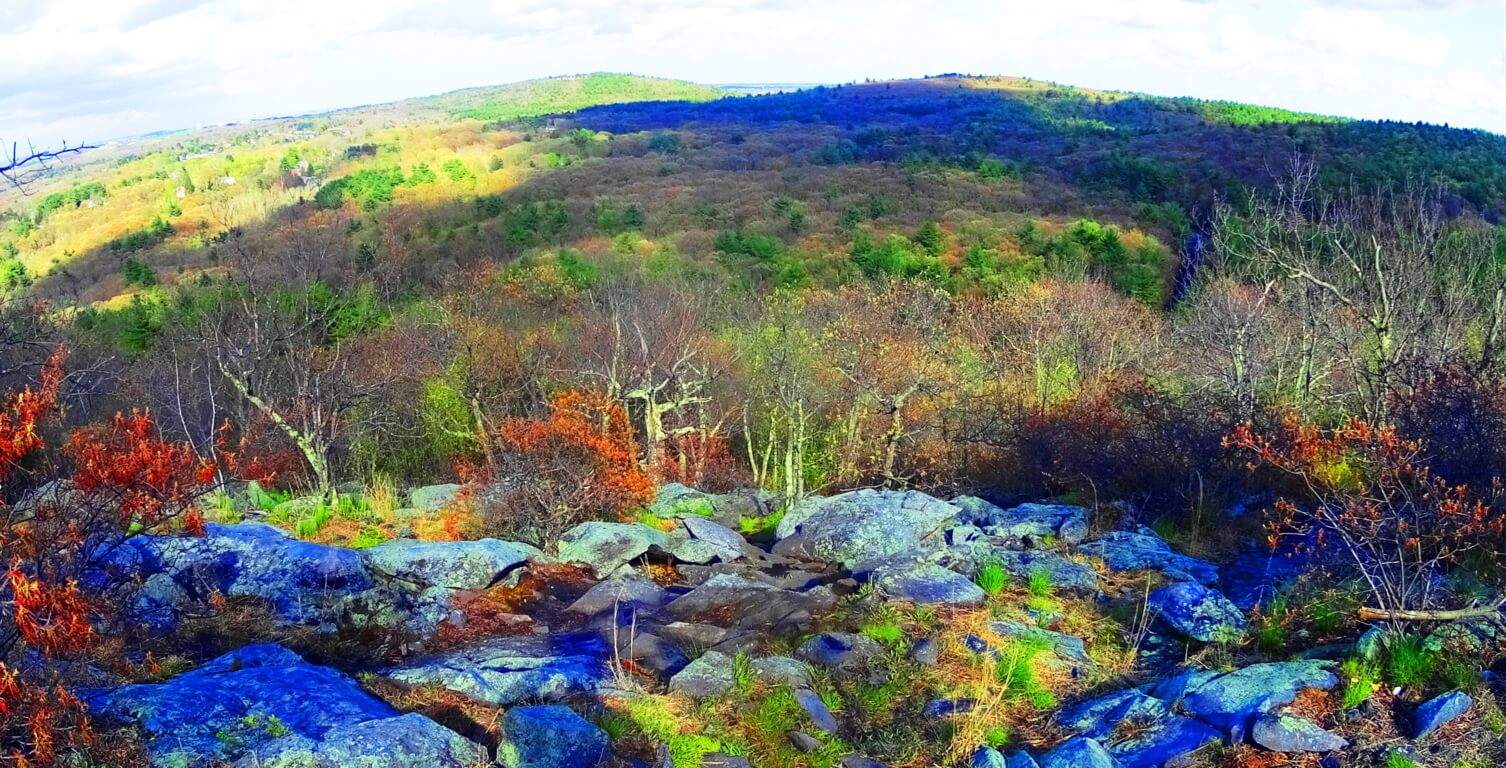 Secret History: The image above is a look at the countryside southwest of the beautiful city of Boston in April 2016. It was in this exact season in 1775 that King George of England issued a mandate to General Thomas Gage for the disarmament of the resistant colonials living in this beautiful region. It was yet another attempt to expand England, and possess these abundantly fertile hills. I have to believe, looking at this picture, that the colonials felt this was a place, if ever there was one, that was absolutely worth fighting for. There is something even deeper about the landscape that colonial farmers must have noticed in their appreciation of the terrain.
Secret History: The image above is a look at the countryside southwest of the beautiful city of Boston in April 2016. It was in this exact season in 1775 that King George of England issued a mandate to General Thomas Gage for the disarmament of the resistant colonials living in this beautiful region. It was yet another attempt to expand England, and possess these abundantly fertile hills. I have to believe, looking at this picture, that the colonials felt this was a place, if ever there was one, that was absolutely worth fighting for. There is something even deeper about the landscape that colonial farmers must have noticed in their appreciation of the terrain.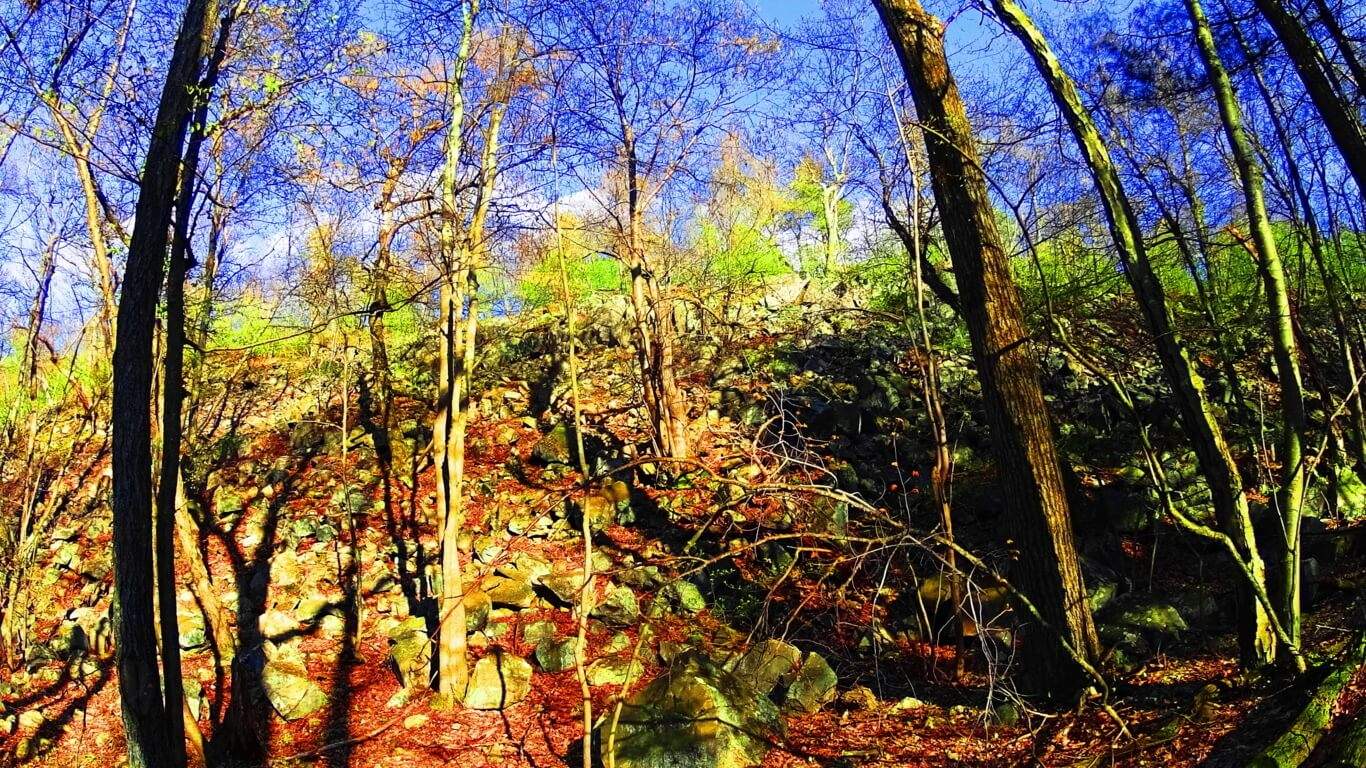 Colonial frontiersmen would have looked for advantageous areas to live, strategically smart elevations close to running streams, with crop potential and forestry for building. Celtic homesteads had been established for almost 1400 years already under the Medieval system back in Ireland and Scotland. Lords possessed the lands with Titles, the best of which long maintained crops, and were often inclusive of megalithic stonewalls that followed riversides to Cairns and Dolmens built in the Celtic era. Men-of-property certainly made the connection that Cairns and Dolmens were a sign of ideal land, almost always placed near resources and advantageous elevations. So it must have seemed miraculous to Colonial frontiersmen when they wandered into the forests and mountains of the “New World” only to discover megalithic stone ‘walls’ already running along the riversides, leading to the most advantageous plots, near streams, peaks, and good soil. Imagine their amazement when they found stone Cairns in these lush areas, with corbel craftsmanship, identical to that of Celtic Cairns in Ireland and England. Native Americans did not claim the stonework. Natives were seasonally nomadic, and were in no way inclined to build stone cities. This is not dismissive of Native American anthropological development. Wooden ‘villages’ expanded into the hundreds of thousands in population in many areas, and were highly sophisticated, but they simply did not work with megalithic stones.
Colonial frontiersmen would have looked for advantageous areas to live, strategically smart elevations close to running streams, with crop potential and forestry for building. Celtic homesteads had been established for almost 1400 years already under the Medieval system back in Ireland and Scotland. Lords possessed the lands with Titles, the best of which long maintained crops, and were often inclusive of megalithic stonewalls that followed riversides to Cairns and Dolmens built in the Celtic era. Men-of-property certainly made the connection that Cairns and Dolmens were a sign of ideal land, almost always placed near resources and advantageous elevations. So it must have seemed miraculous to Colonial frontiersmen when they wandered into the forests and mountains of the “New World” only to discover megalithic stone ‘walls’ already running along the riversides, leading to the most advantageous plots, near streams, peaks, and good soil. Imagine their amazement when they found stone Cairns in these lush areas, with corbel craftsmanship, identical to that of Celtic Cairns in Ireland and England. Native Americans did not claim the stonework. Natives were seasonally nomadic, and were in no way inclined to build stone cities. This is not dismissive of Native American anthropological development. Wooden ‘villages’ expanded into the hundreds of thousands in population in many areas, and were highly sophisticated, but they simply did not work with megalithic stones.
The Unspoken Thing: The unspoken thing about New England, the secret that has gone to the graves of almost every Native American tribe and Colonial woodsmen, is that America was once occupied by a megalithic culture, just like Ireland and England. Imagine if you were a Colonial farmer and you discovered this secret, that the soil and stonework of the ‘New World’ was of the same mystical sanctity of the lands Lords and Title holders had been possessing in domineering fashion throughout European history. Not only was the land giving you the essential signs of quality you were hoping for, but it went a step further, and somehow was revealing Celtic features that you could not in your wildest dreams have imagined existed in this part of the world. It was so completely familiar, but in an entirely new place. They absolutely would’ve taken this as a sign from God, and therefor fought with everything they had to keep it. I truly believe that this was a significant part of the reason why Colonial militiamen met the British on the field of Battle on July 4th of 1776. Colonial farmers must have had in-depth conversations about what they were finding in the woods, Celtic style stone-works that British Lords coveted and valued on their estates for centuries. It would’ve been the ultimate incentive to fight. The Blue Hills Reservation is one of the most beloved remaining testaments to these wonders of the old growth forests, filled with Celtic stonework running along streams, small mountains, and rocky elevations. They are still there today, as the builders obviously intended.
Connections to Ireland: The image below is a stone staircase at one of the main trails at Blue Hills. Notice how this first step is positioned, displaying the markings like an invitation, shown on the top frontal face, rather than tucking it out of sight as masons are trained to do. Whoever built this staircase wanted us to notice the craftsmanship. Everything about it says “notice me”. 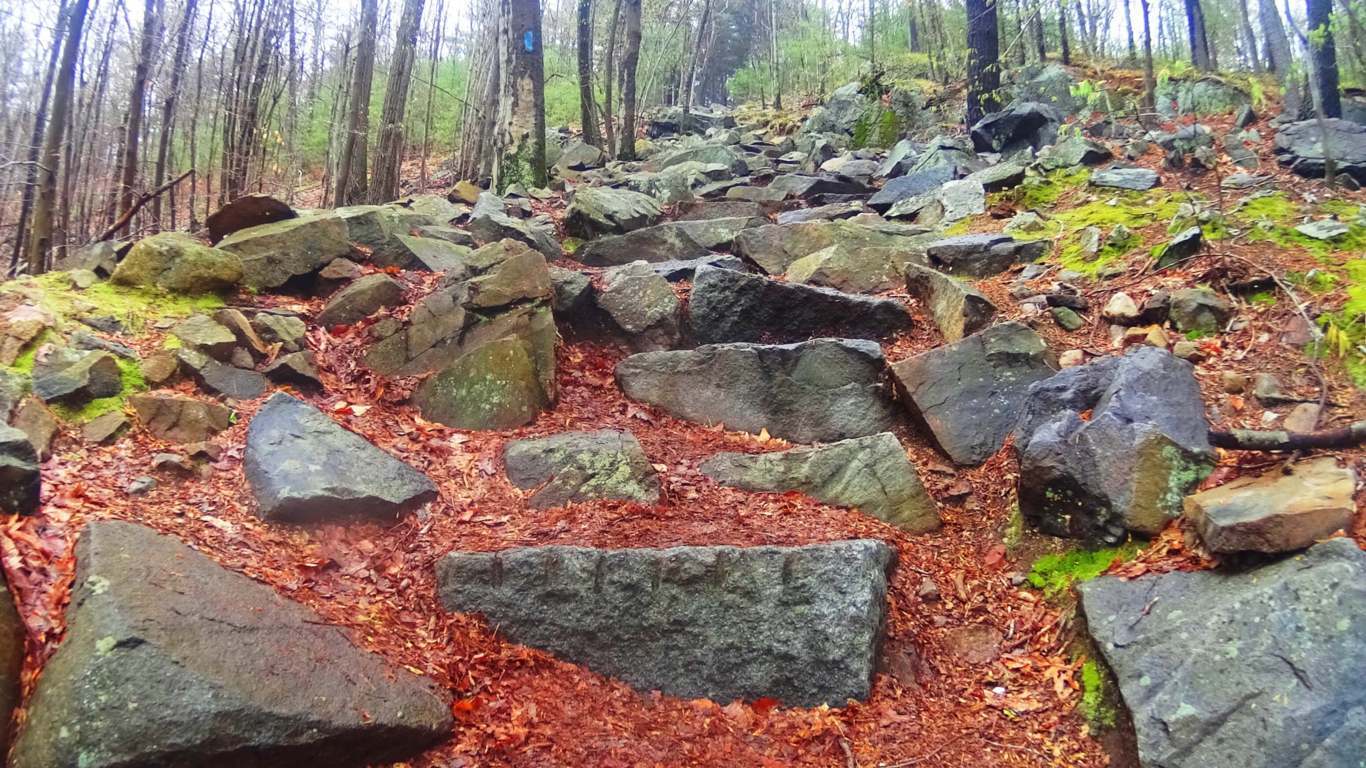 The style of incremented cuts on this blue granite stone is in the exact same style as cuts made to white granite on high elevation staircases at Mount Bearnagh, in the beautiful Mourn Mountain Range of northeast Ireland. Here is a look at one of those stones below, quarried in the heights by stone stairs leading up the mountain, but was never placed in the ground for some reason. The styles are identical
The style of incremented cuts on this blue granite stone is in the exact same style as cuts made to white granite on high elevation staircases at Mount Bearnagh, in the beautiful Mourn Mountain Range of northeast Ireland. Here is a look at one of those stones below, quarried in the heights by stone stairs leading up the mountain, but was never placed in the ground for some reason. The styles are identical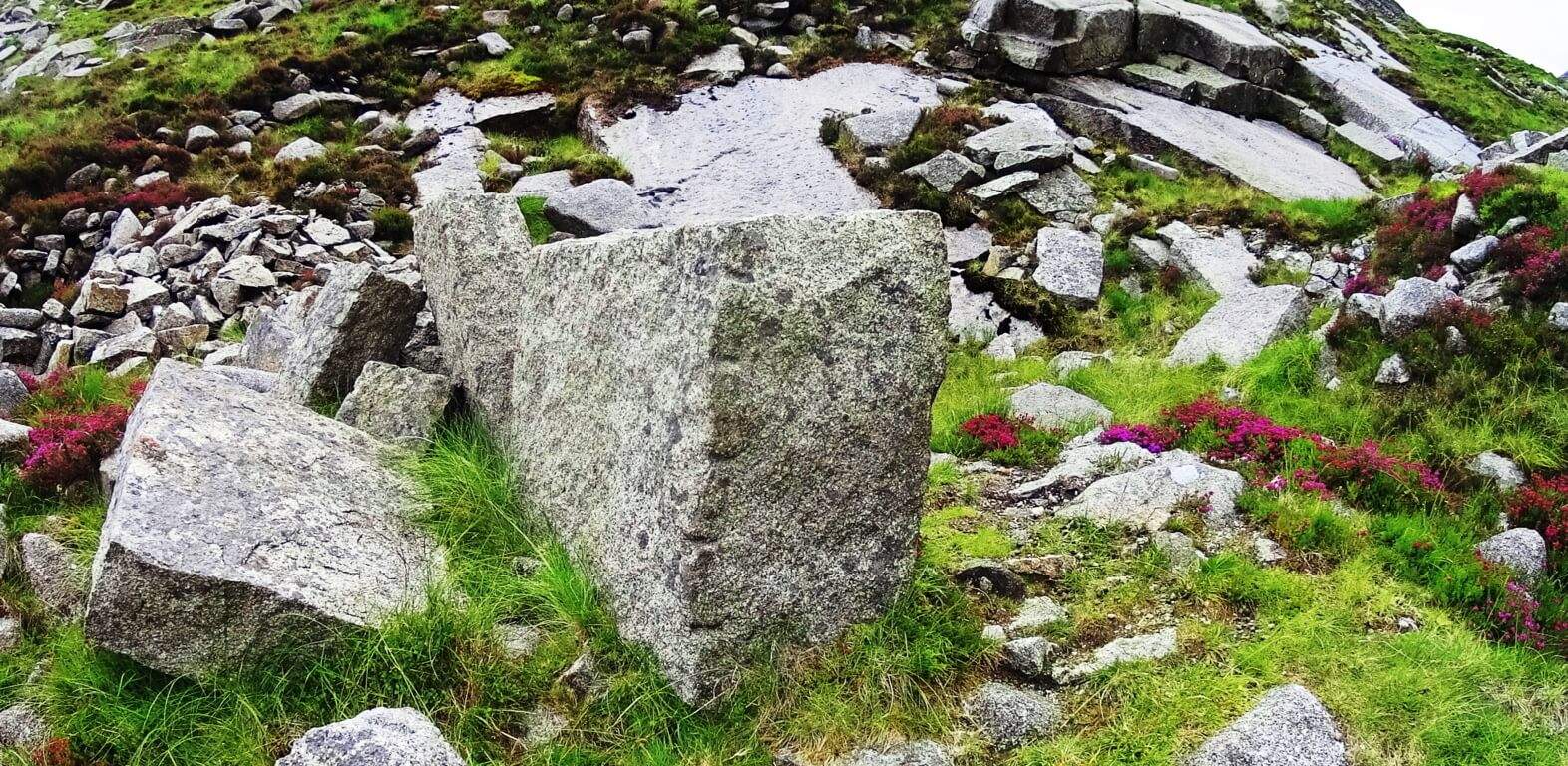 . And just like at Blue Hills, Mount Bearnagh is inundated with other stones all around, that have incremented markings, smoothed surfaces, and right angles.
. And just like at Blue Hills, Mount Bearnagh is inundated with other stones all around, that have incremented markings, smoothed surfaces, and right angles.
Features of Blue Hills: Take a look at this amazing granite standing-stone that rests in a beautiful old growth Pine-glade at Blue Hills. It looks like something out of Game of Thrones. It stands at about 7 feet high, and 3 feet in width. There is no other stone comparable to it within the vicinity.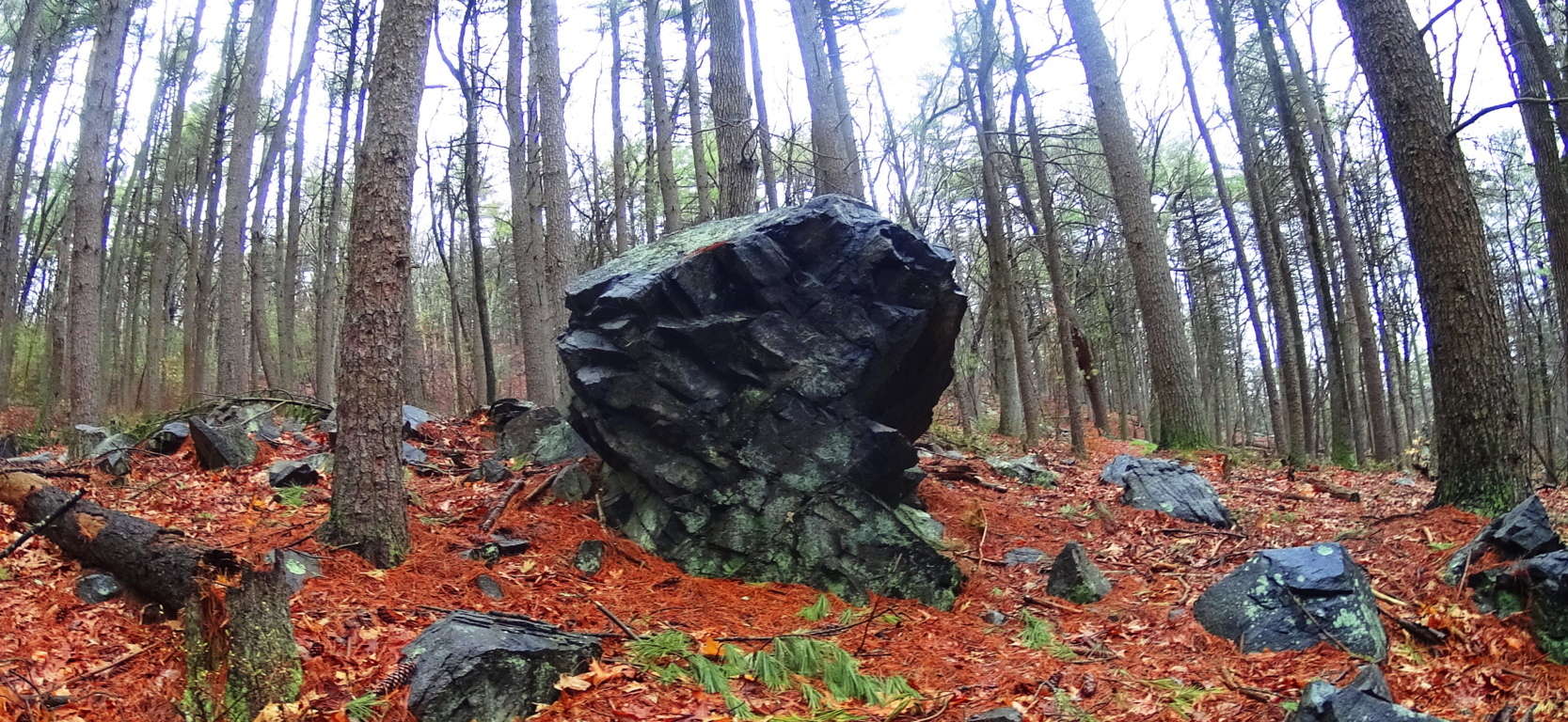 There are angles specifically cut into its sides. It has clearly been worked on. Not only are the angles obvious, but the stones that were cut away are placed all around the area. It looks to be some kind of expression. There are hundreds of thousands of granite pieces that have been worked on all throughout the forests here. Of course, the next question from that statement will be: “What could they do with such a massive amount of cut stones if this happened all over the forests?”
There are angles specifically cut into its sides. It has clearly been worked on. Not only are the angles obvious, but the stones that were cut away are placed all around the area. It looks to be some kind of expression. There are hundreds of thousands of granite pieces that have been worked on all throughout the forests here. Of course, the next question from that statement will be: “What could they do with such a massive amount of cut stones if this happened all over the forests?”
More Irish Connections/Stone-linings: The answer to the question is literally all around the woods: the Stone-linings. What modern anthropologists have mistakingly (and lazily) called “walls”, are more accurately understood to be ‘Stone-linings’ that run, like connecting cables, from peak to peak, and even zig-zag up entire hillsides in some areas. Who builds stone walls that zig zag up a mountain? No one. This Stone-lining phenomenon is also found at Mount Bearnagh in Ireland. Here is a spot in Ireland that illustrates my point clearly; Please take a look at this image of two separate stone projects at the Pass in the heights of Mount Bearnagh; It clearly distinguishes the two structures as absolutely different.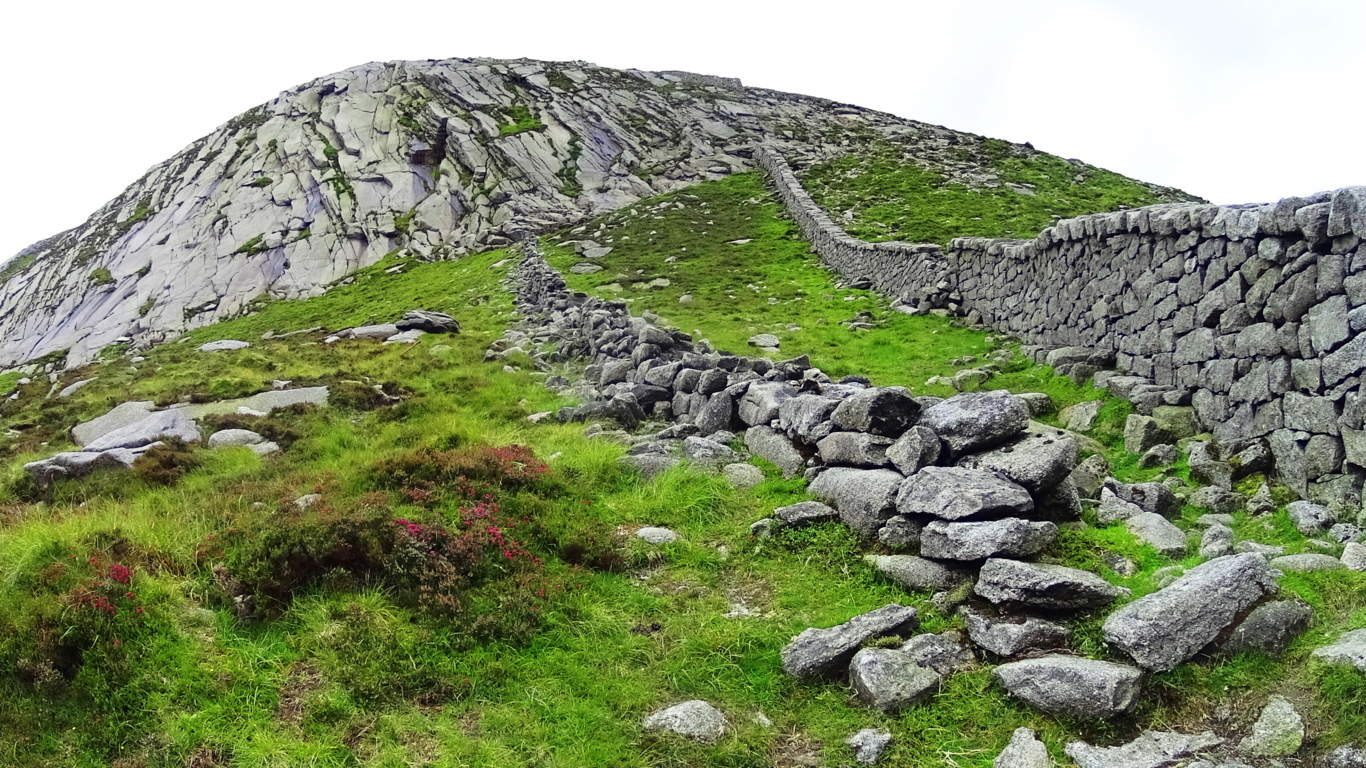
The stones on the far right of this image are clearly crafted as a wall, meant to contain flocks and cattle from drifting into the next valley. It was built by Irish masons in the 17th, or late 18th century. Notice how the stones of this wall are not aligned with the direct center of the mountain beyond, but is right-of-center of the peak, simply stopping once it reaches the cliff side. Since domesticated Cows and Sheep don’t climb vertical cliffs, the purpose of the structure is obviously complete, as a wall. The project on the left in the image, however, is a Stone-lining. It obviously cannot stop the movement of anything. I believe this ‘Lining’ was built by the very first culture in Ireland. As you can see, the stones specifically align towards the center of the mountain beyond, and actually continues up the mountain in massive stacked shelves (if you look close), all the way to the center. What this image doesn’t show us is that in the other direction, the Lining continues towards the center of the opposite peak in the same way. It is evident that this megalithic period structure was intended to connect the peaks, like cables connecting power sources. I have found this same phenomenon at Glenveagh National Park, Ireland, Mount Chocorua New Hampshire, and Mount Monadnock, New Hampshire, as well as dozens of other places. (Noted here on Stonetstrider.com.) One more important thing to consider is that the Irish did not take stones from the Linings to build the wall; Why not? It’s right there, why not use it? The answer is, the Lining is ancient, and sacred, and the Irish know it. They would not touch it. If we now understand that Linings are sacred, and the Blue Hills is literally covered in massive megalithic Linings, that makes the entire Blue Hills Reserve sacred.
Stone-linings (Linings) at Blue Hills: The Blue Hills is a Stone-lining universe. Colonials would’ve seen these stones and been absolutely stunned. Some of them connect the peaks, others zig-zag up the hills as i mentioned before, and some “crown” the massive stone ledges around the peaks, like at Mount Watatic, Massachusetts, (also featured here on Stonestrider.com.) The image below is an example of a fine Lining found on one of the elevated porches at Blue Hills.
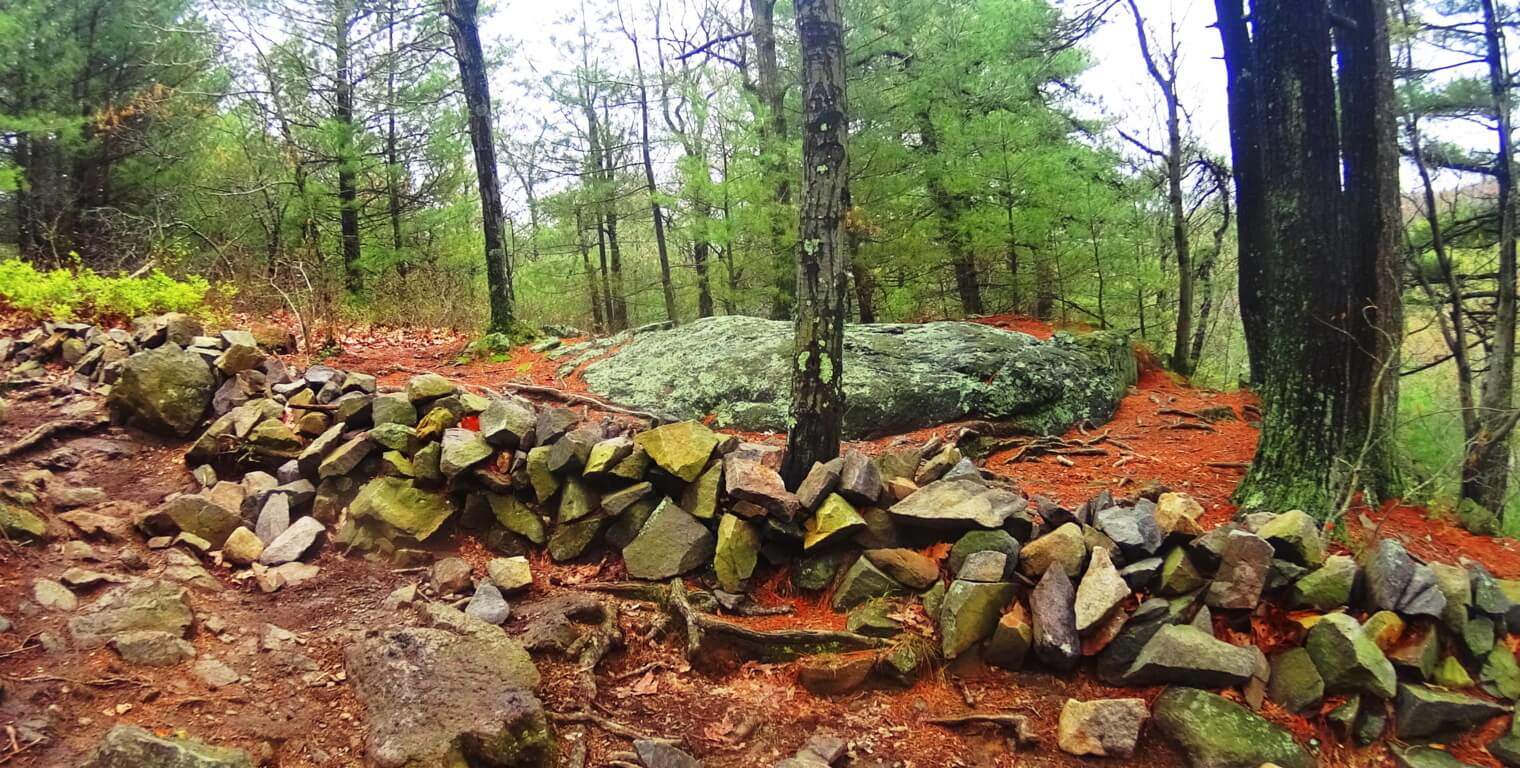 The next Lining is much more substantial, and running straight up the side of one of the small mountains at Blue Hills. There are literally hundreds of these Linings, requiring more work and tools than any team of New England craftsman could ever in ten lifetimes complete. And where are the tools that quarried and crafted these stones? No signs of them, anywhere.
The next Lining is much more substantial, and running straight up the side of one of the small mountains at Blue Hills. There are literally hundreds of these Linings, requiring more work and tools than any team of New England craftsman could ever in ten lifetimes complete. And where are the tools that quarried and crafted these stones? No signs of them, anywhere.
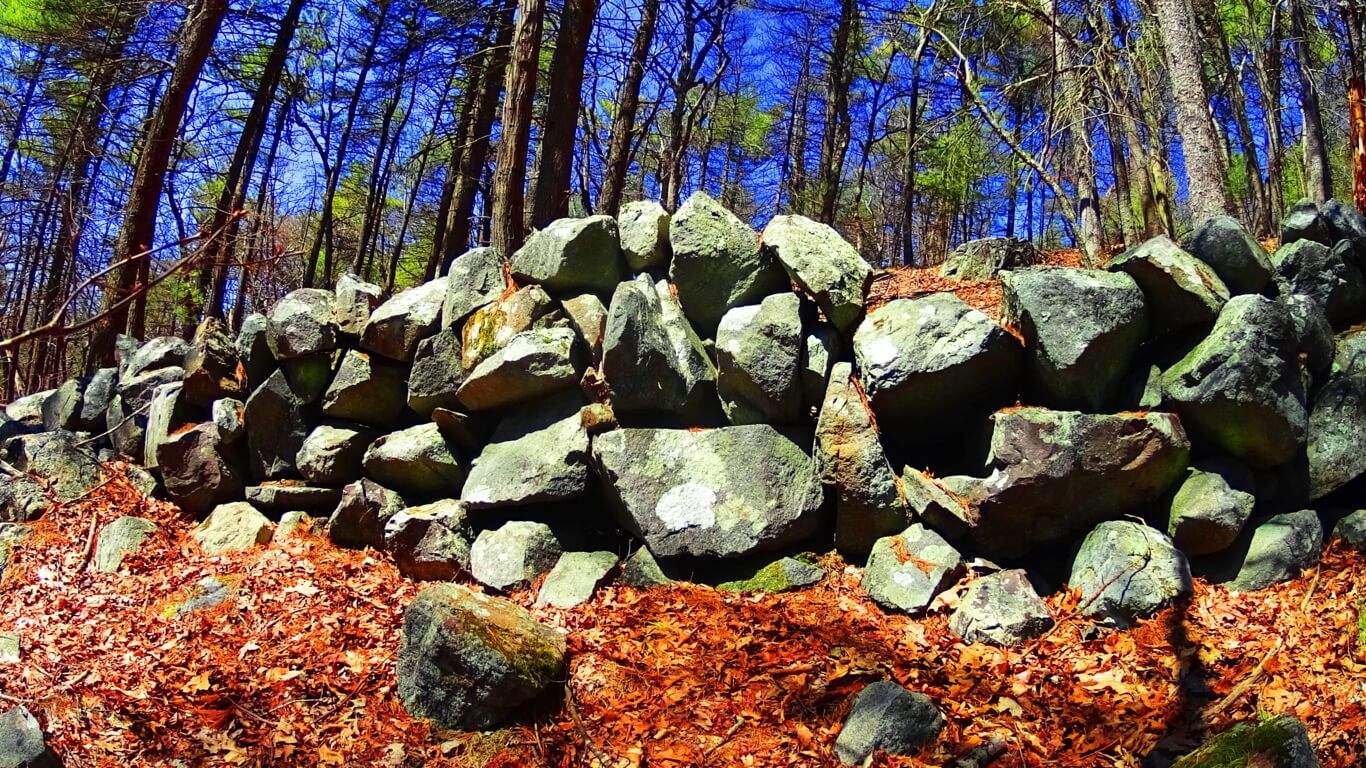 Here is a dizzying look at several Linings zig-zagging up the mountain side just off one of the trails at Blue Hills. I believe that the stones were part of this scene long before the trees were there. At one time, this hillside looked a lot more like Celtic hills, unobstructed visually. It is harder to see megalithic patterns in New England with countless layers of leaves and trees, but there is some kind of pattern here. Its almost as if the entire hillside is a megalithic statement. The picture below is a hill about 100 yards high, with Linings of 100 to 1000 pound stones everywhere. Unreal. A glacier ripping this hillside would’ve discombobulated any pattern in the stones, not stacked them into Linings that looked to modern eyes like dilapidated walls. Ice did not do this.
Here is a dizzying look at several Linings zig-zagging up the mountain side just off one of the trails at Blue Hills. I believe that the stones were part of this scene long before the trees were there. At one time, this hillside looked a lot more like Celtic hills, unobstructed visually. It is harder to see megalithic patterns in New England with countless layers of leaves and trees, but there is some kind of pattern here. Its almost as if the entire hillside is a megalithic statement. The picture below is a hill about 100 yards high, with Linings of 100 to 1000 pound stones everywhere. Unreal. A glacier ripping this hillside would’ve discombobulated any pattern in the stones, not stacked them into Linings that looked to modern eyes like dilapidated walls. Ice did not do this. If you follow the Linings through the woods at Blue Hills you will often come across what look to be megalithic size markers, Standing-stone scale slates or boulders that seem almost decorative, or for marking the territory. Take a look at this 7 foot long, 1 foot thick, slab placed along the Lining by one of the lower trails. It looks to be at least 1 ton in weight (2000 pounds). There are cuts on the lower right side of this slab rendering some kind of meaning. It was clearly placed there. It may mark a certain point of the Sun or Moon along the mountainside, or be indicating a direction to follow, all of which are possibilities that the Megalith builders were absolutely concerned with.
If you follow the Linings through the woods at Blue Hills you will often come across what look to be megalithic size markers, Standing-stone scale slates or boulders that seem almost decorative, or for marking the territory. Take a look at this 7 foot long, 1 foot thick, slab placed along the Lining by one of the lower trails. It looks to be at least 1 ton in weight (2000 pounds). There are cuts on the lower right side of this slab rendering some kind of meaning. It was clearly placed there. It may mark a certain point of the Sun or Moon along the mountainside, or be indicating a direction to follow, all of which are possibilities that the Megalith builders were absolutely concerned with.
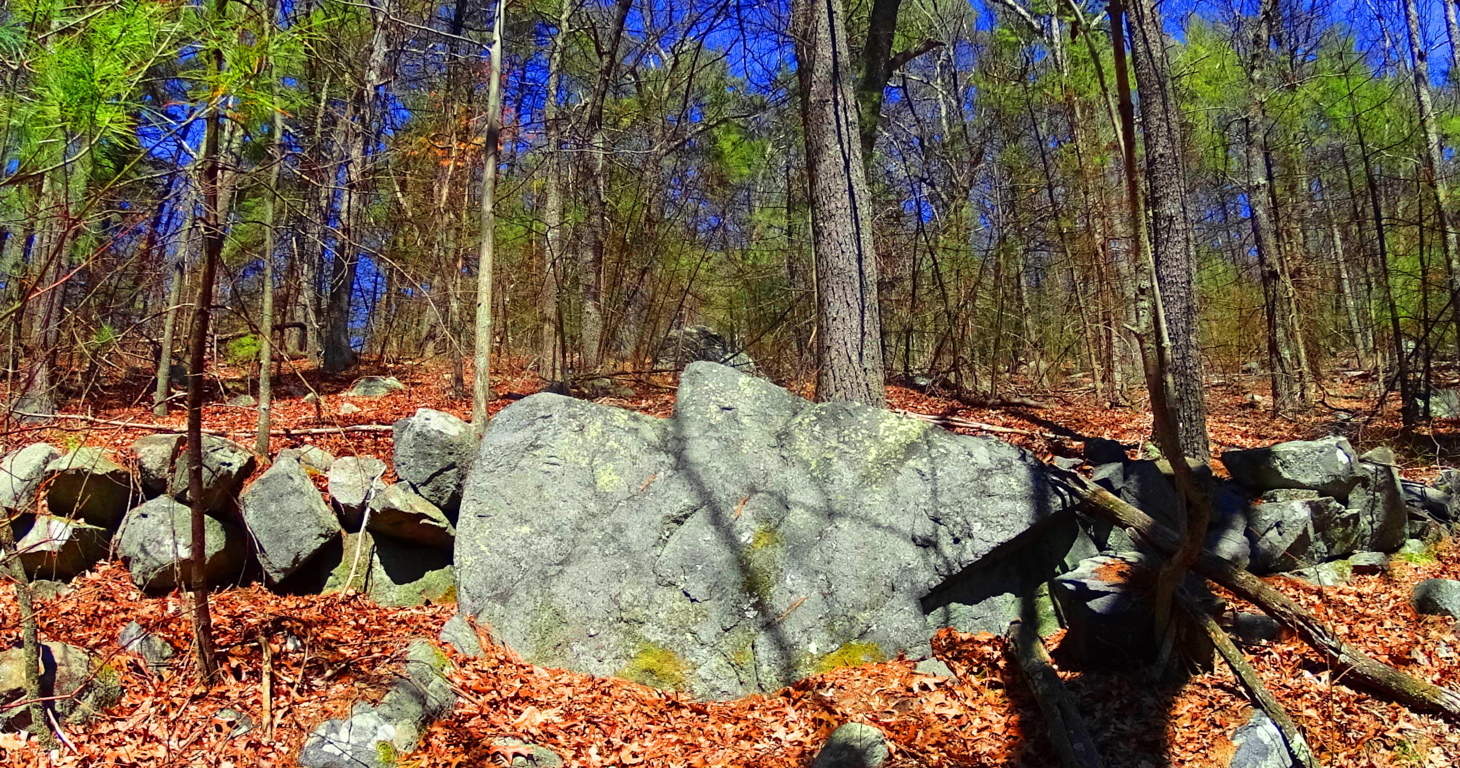 Elevated Trails at Blue Hills: People from this area of New England love hiking here. With all the stonework taking place beneath the trees, it is impossible for a hiker not to be curious what might be taking place at the hilltops, under the Sun. There are trails that loop in a lengthy approach to the smooth stone porches above, but there are also very direct trails with serious inclines that will take you to the best peaks within 15 intense minutes. One peak has a direct view of Boston twenty miles away, with beautiful, Celtic looking, old growth fauna along the ledges (Image below). You can just make out Boston in the distance.
Elevated Trails at Blue Hills: People from this area of New England love hiking here. With all the stonework taking place beneath the trees, it is impossible for a hiker not to be curious what might be taking place at the hilltops, under the Sun. There are trails that loop in a lengthy approach to the smooth stone porches above, but there are also very direct trails with serious inclines that will take you to the best peaks within 15 intense minutes. One peak has a direct view of Boston twenty miles away, with beautiful, Celtic looking, old growth fauna along the ledges (Image below). You can just make out Boston in the distance.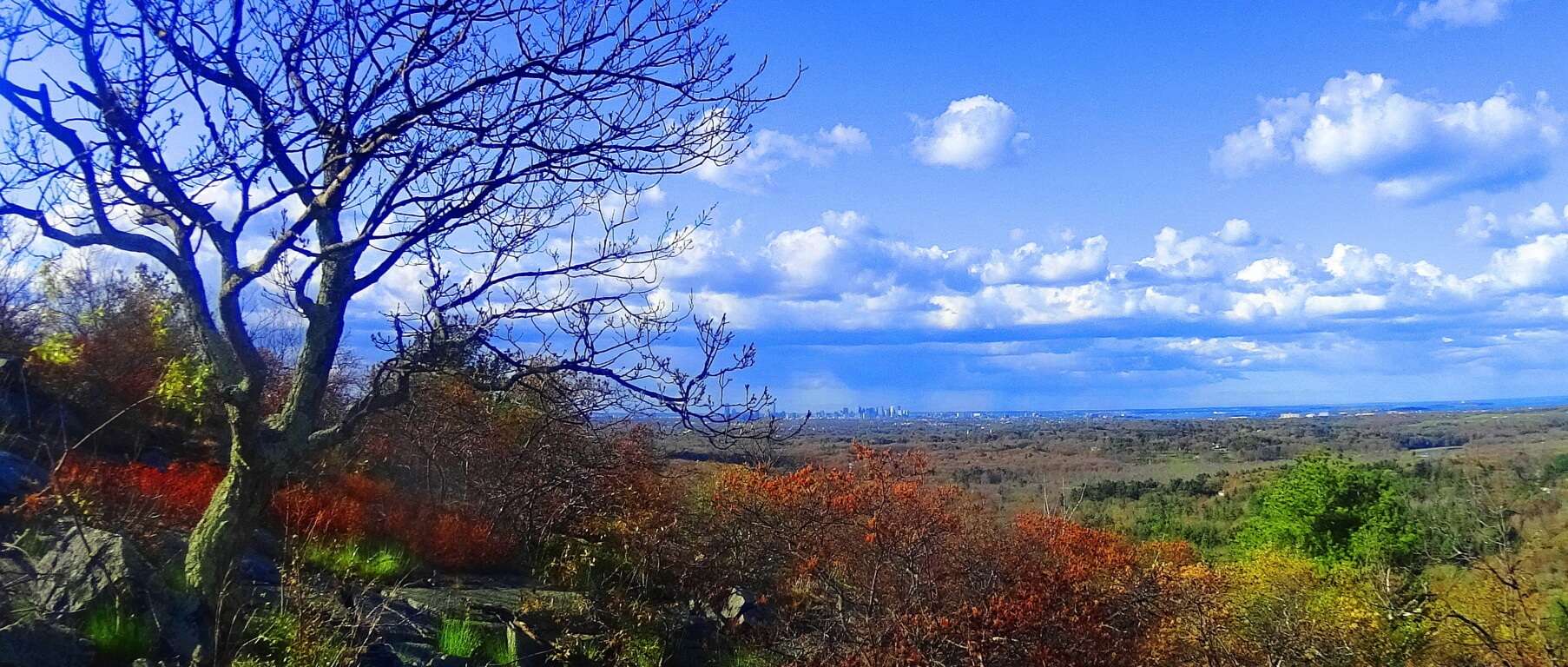 Along these smooth rock porches are stones that are obviously crafted, and serving as markers of some kind. Take a look at these stones on the upper path of “Skyline Trail”, the most popular trail at Blue Hills:
Along these smooth rock porches are stones that are obviously crafted, and serving as markers of some kind. Take a look at these stones on the upper path of “Skyline Trail”, the most popular trail at Blue Hills: 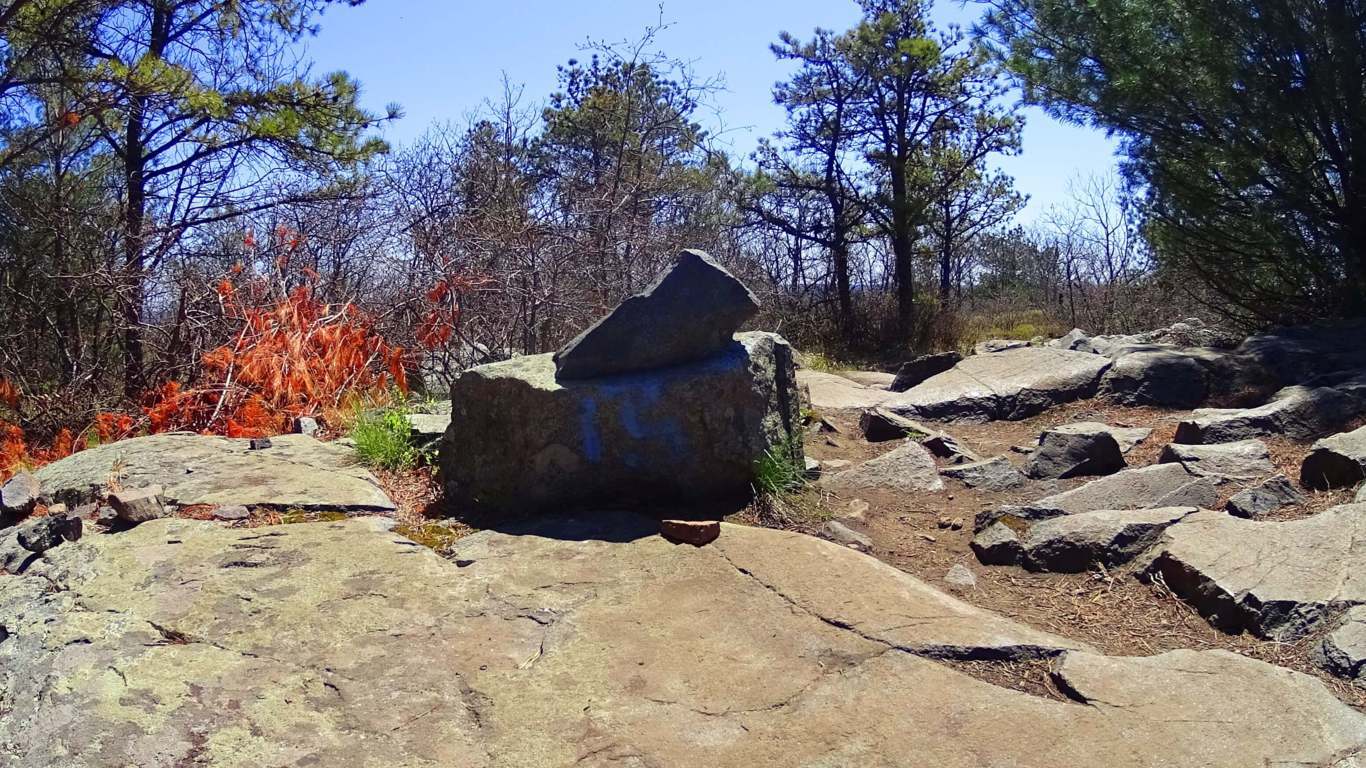 This stone is clearly crafted. Furthermore, looking from this exact stone down the direct path of the trail, are two more crafted, free sitting boulders, perfectly aligned like 1,2,3.
This stone is clearly crafted. Furthermore, looking from this exact stone down the direct path of the trail, are two more crafted, free sitting boulders, perfectly aligned like 1,2,3.
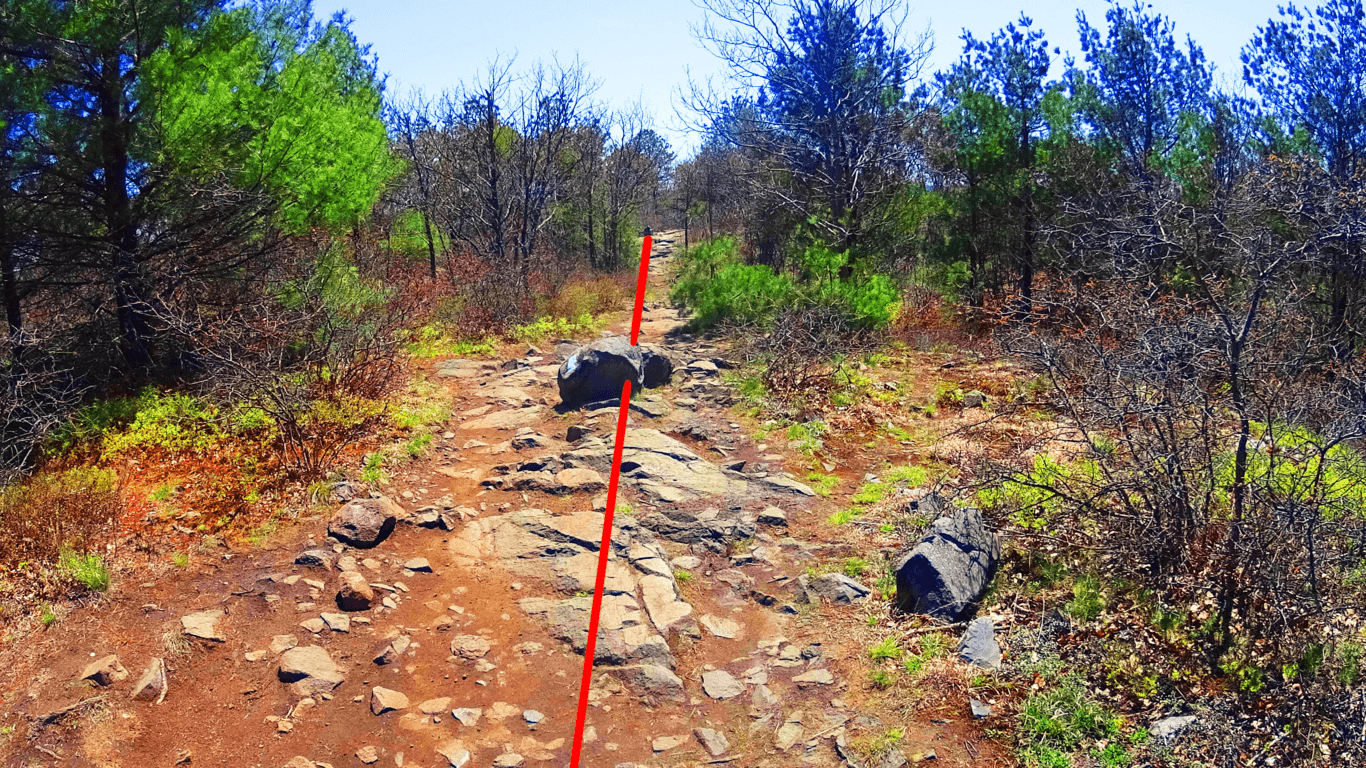 Around this area are also stones that have clearly been cut away from cliff faces. Take a look at these triangular stones, still standing near the exact indents from which they were cut away from.
Around this area are also stones that have clearly been cut away from cliff faces. Take a look at these triangular stones, still standing near the exact indents from which they were cut away from. 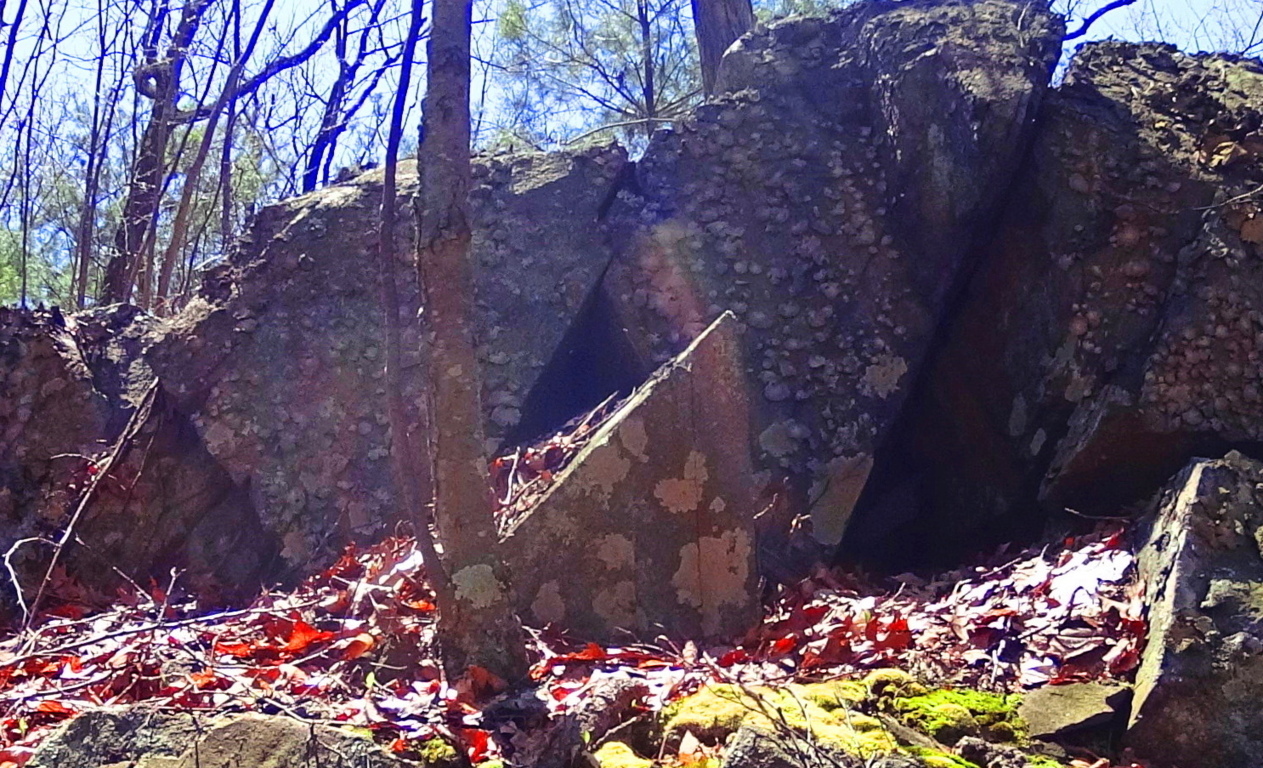 Just for clarity, I highlighted this image so you could see the exact spaces of the cutting, and the right angled triangle stone.
Just for clarity, I highlighted this image so you could see the exact spaces of the cutting, and the right angled triangle stone.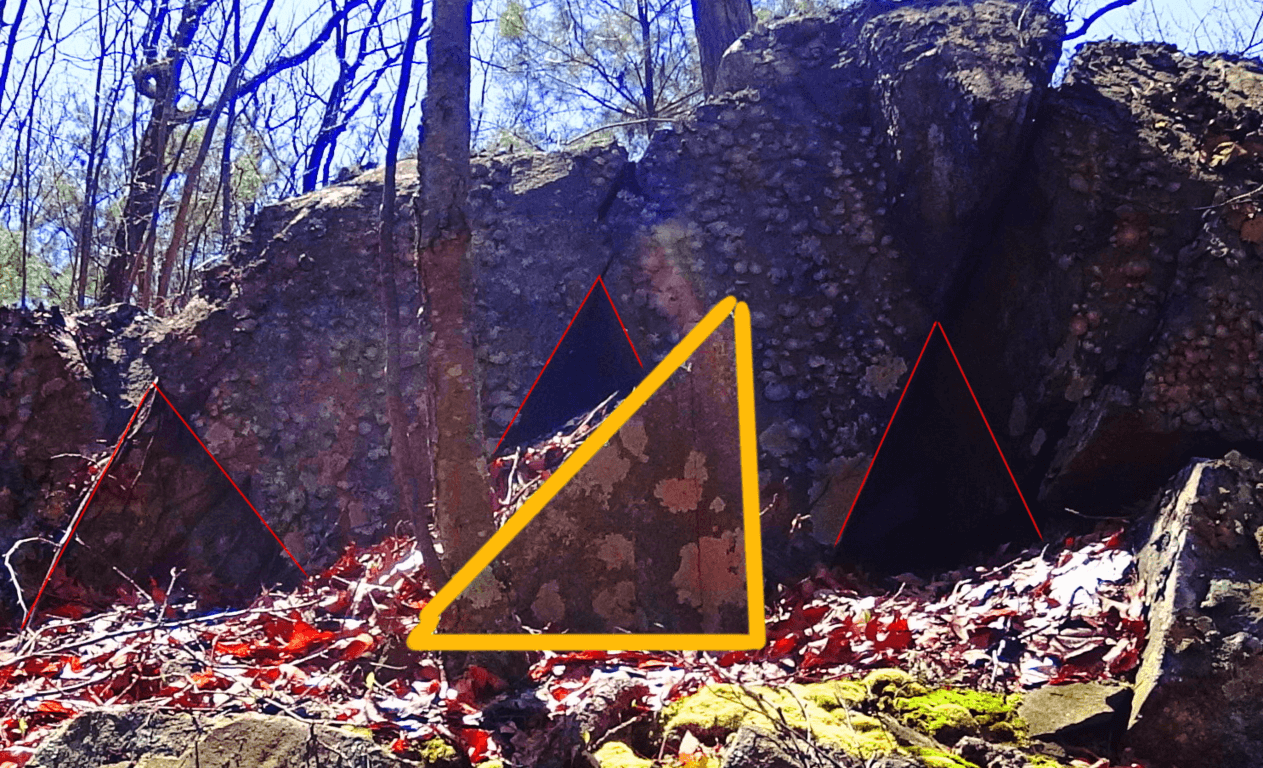 This is evidence of extremely intelligent craftsmanship, conscious of geometric principles. There are also more minor cuts in the stones along the trails, with triangular features. Below is just one example of thousands. They seem directional.
This is evidence of extremely intelligent craftsmanship, conscious of geometric principles. There are also more minor cuts in the stones along the trails, with triangular features. Below is just one example of thousands. They seem directional. 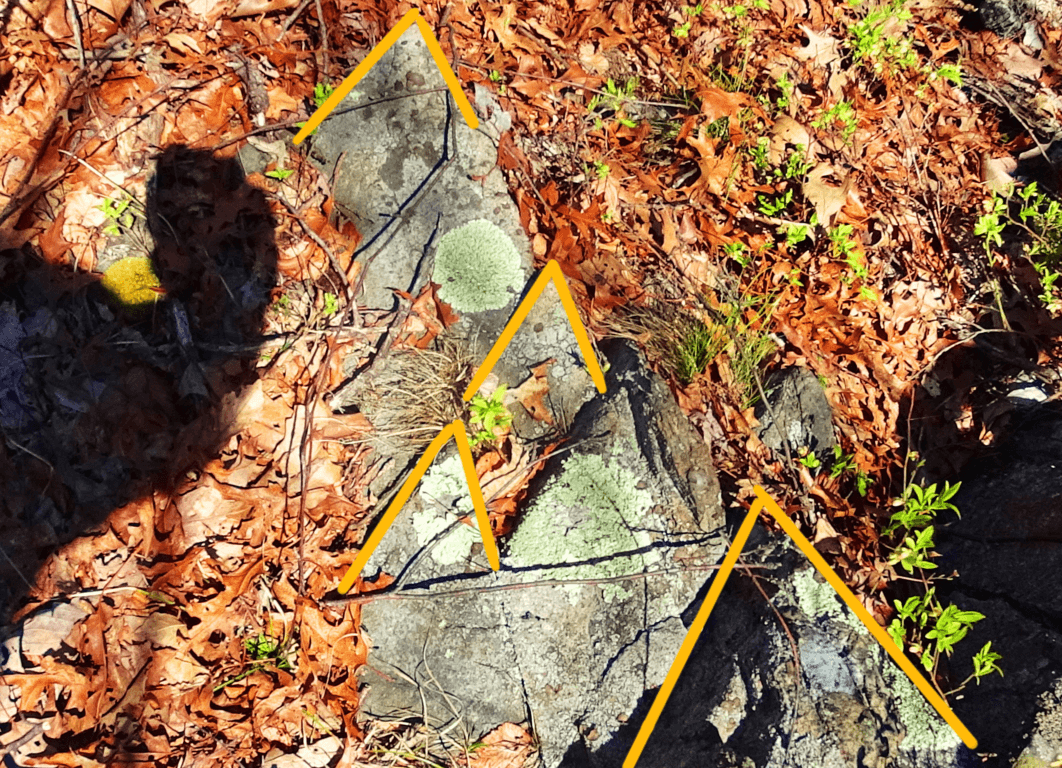 Amazing. The view from the top of Skyline Trail is a classic New England picture. The shadows on the dark granite ledges give a bluish hue to the stones, most likely where the name for this beautiful place derives (top images). We should remember also, that these trails were used by the Native American tribes for thousands of years, before it became “New England”. For the most part, they have taken their sacred knowledge with them into history. Take a hike through the Blue Hills, and see for yourself the unspoken reasons why a community of poor colonial farmers risked their lives against the greatest empire the world had ever known. They knew what we are quickly forgetting, that something entirely mystical took place on this sacred land. Find it, if you can, and go strong.
Amazing. The view from the top of Skyline Trail is a classic New England picture. The shadows on the dark granite ledges give a bluish hue to the stones, most likely where the name for this beautiful place derives (top images). We should remember also, that these trails were used by the Native American tribes for thousands of years, before it became “New England”. For the most part, they have taken their sacred knowledge with them into history. Take a hike through the Blue Hills, and see for yourself the unspoken reasons why a community of poor colonial farmers risked their lives against the greatest empire the world had ever known. They knew what we are quickly forgetting, that something entirely mystical took place on this sacred land. Find it, if you can, and go strong.
Gortnavern
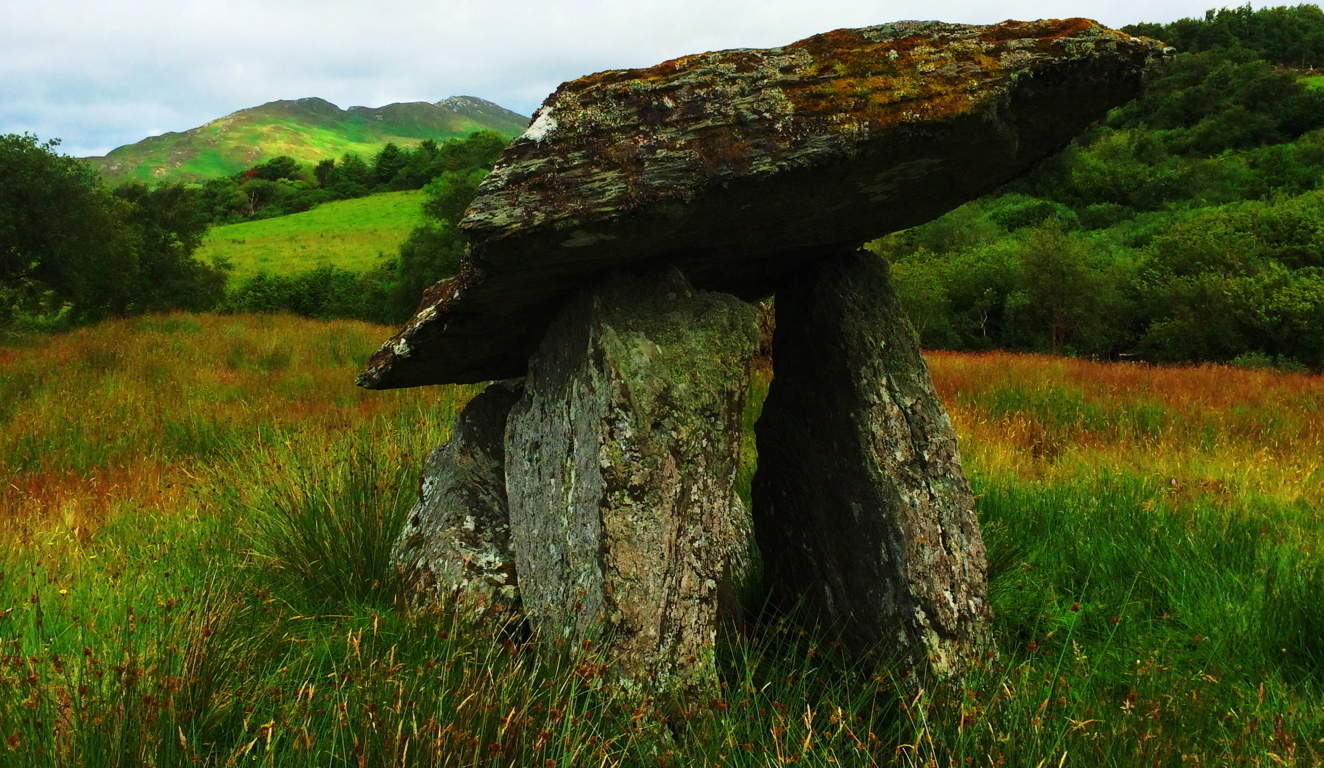 Location: Kerrykeel/Ranny Mountain/Ireland
Location: Kerrykeel/Ranny Mountain/Ireland
Note: It is hard to know how to begin when talking about a place like Gortnavern. It really isn’t a place that you will find in a tourism guidebook. It’s a rugged and cloudy place, with dark oily soil in the heights. Known as ‘Ranny’ to the locals, the small black mountain peak here overlooks Mulroy Bay, an inlet extending out to the stark Atlantic edge of Ireland’s northernmost coastline.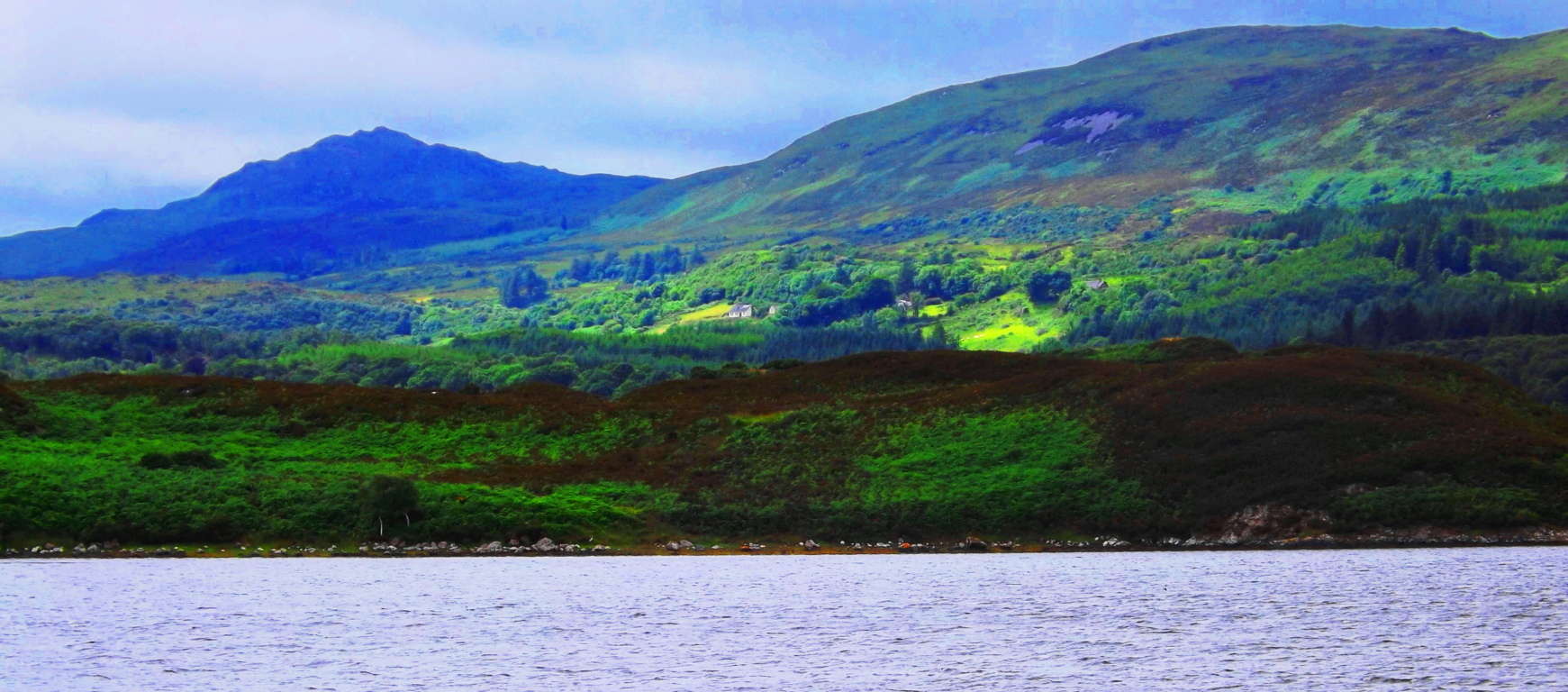 There are no trails here, just farmers roads, and fields upon fields. In the distance to the northeast is a rim of mountains that create a saturated basin of nearly picture perfect rolling hills and streams.
There are no trails here, just farmers roads, and fields upon fields. In the distance to the northeast is a rim of mountains that create a saturated basin of nearly picture perfect rolling hills and streams.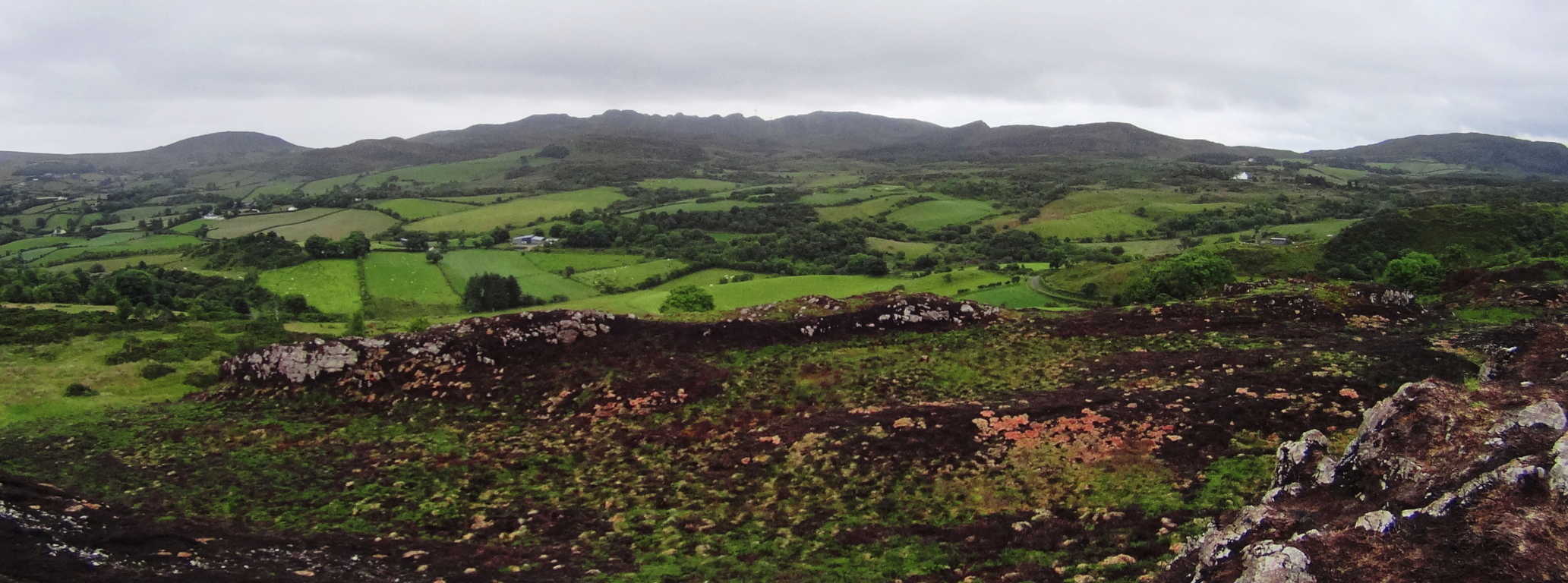 What looks like a simple and approachable climb through these heights is actually a phalanx of thick hedges, stony streams, tall grass, rocky knolls, spongy moss, and tough roots.
What looks like a simple and approachable climb through these heights is actually a phalanx of thick hedges, stony streams, tall grass, rocky knolls, spongy moss, and tough roots.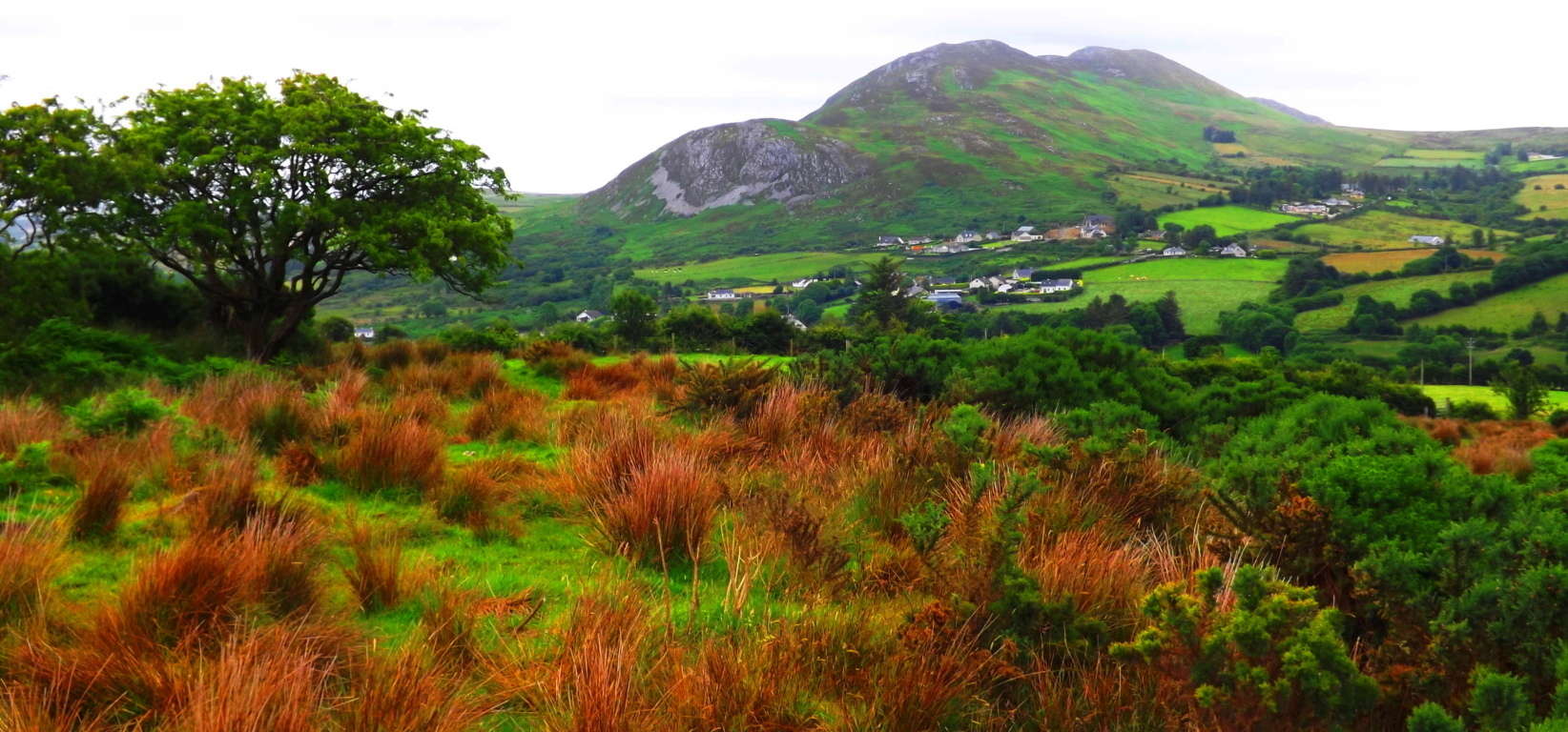 You will need all your gear, tall boots, and rain suit, to hike without fear. At the dark peak of Ranny wild goats graze and look on. It is easy to see that people do not come here often, judging from the looks on their faces.
You will need all your gear, tall boots, and rain suit, to hike without fear. At the dark peak of Ranny wild goats graze and look on. It is easy to see that people do not come here often, judging from the looks on their faces. There are plants and fauna here that I have never seen before, with winding undergrowth and tunnels of tough branches. To achieve the peak at Ranny you will have to pass through them.
There are plants and fauna here that I have never seen before, with winding undergrowth and tunnels of tough branches. To achieve the peak at Ranny you will have to pass through them.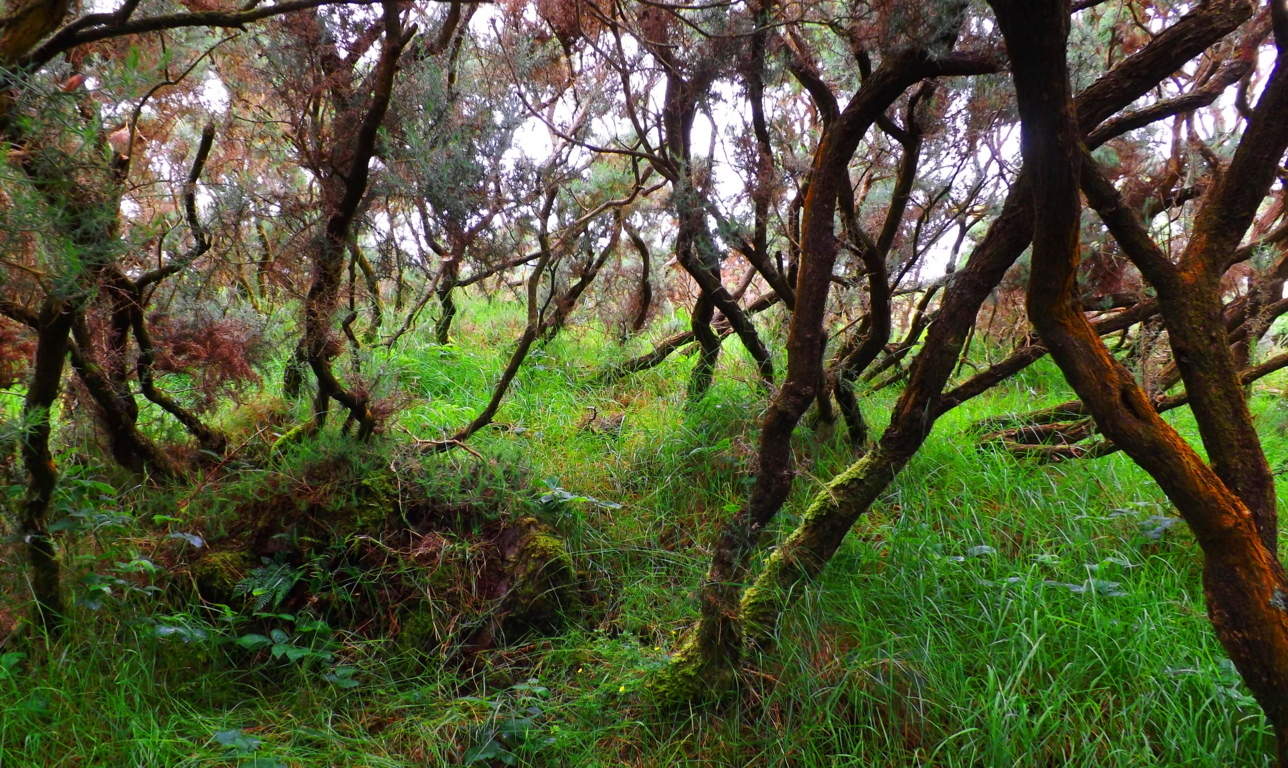 Not only that, but you will have to cross streams, climb fences, and avoid bulls in the fields. At this point you’ll probably want to ask: ” Well then, why the hell would you want to go hiking there?”
Not only that, but you will have to cross streams, climb fences, and avoid bulls in the fields. At this point you’ll probably want to ask: ” Well then, why the hell would you want to go hiking there?”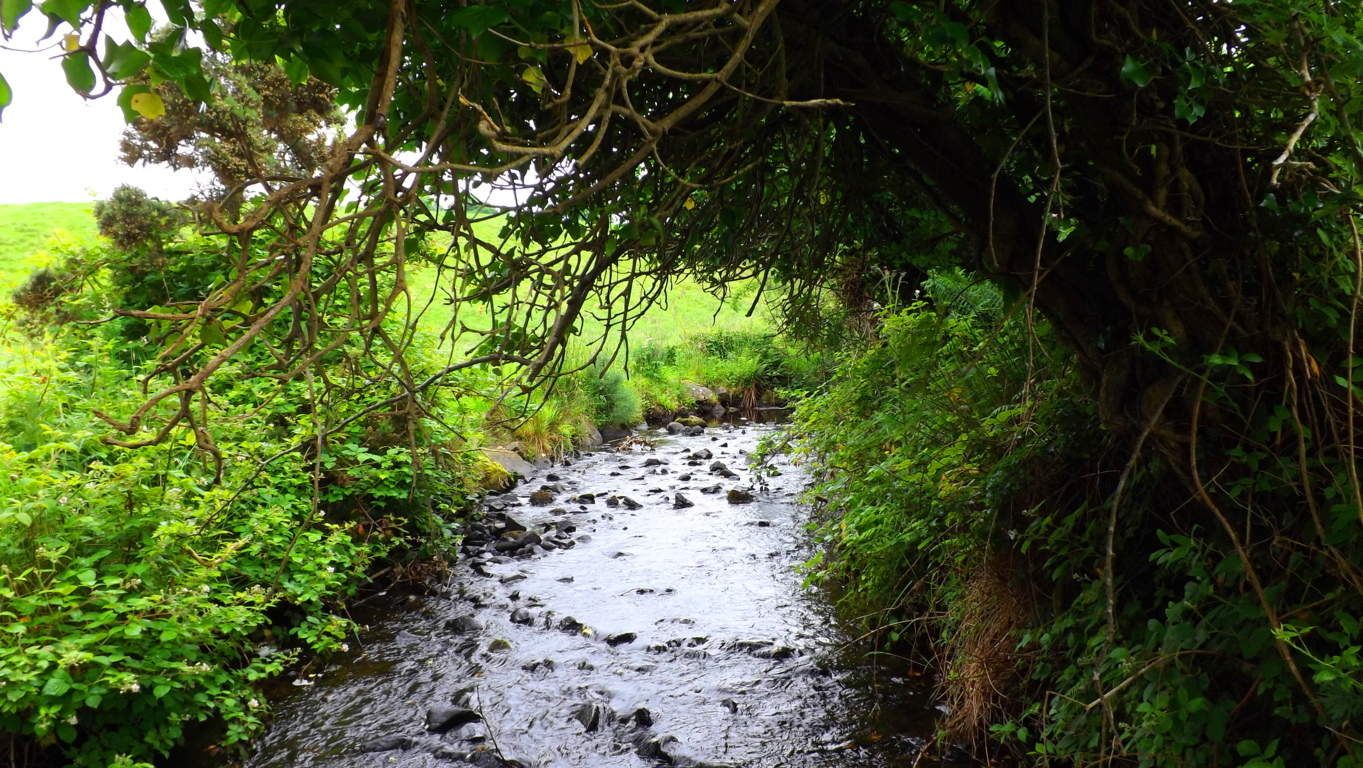 It’s a good question, with a worthy explanation. The Dolmen. The misty heights of Ranny is home to one of the few remaining undisturbed Celtic Dolmens in this part of the world. Other Dolmens remain, but are reinforced, rebuilt, or tampered with, in various ways; But not the Gortnavern Dolmen. It is in situ, in it’s original state; A beyond-priceless expression from an era gone by, built by the first culture that this part of the world had ever seen.
It’s a good question, with a worthy explanation. The Dolmen. The misty heights of Ranny is home to one of the few remaining undisturbed Celtic Dolmens in this part of the world. Other Dolmens remain, but are reinforced, rebuilt, or tampered with, in various ways; But not the Gortnavern Dolmen. It is in situ, in it’s original state; A beyond-priceless expression from an era gone by, built by the first culture that this part of the world had ever seen. Irish archaeologists date the building of most Dolmens somewhere around 4000 to 6000 B.C.E, but in truth, there is really no way of knowing just how old this megalith is. This is an exquisite example of the Portal Tomb, which is a spiritual statement of a crafted, massive, stone satellite, meant for catapulting souls from this world, to the stars. The 10 ton, elevated capstone, supported by five huge pillar pieces beneath, is forever tipping its brim towards the beautiful Gortnatraw Mountain in the distance. If you can get to this spot, it feels as if whoever created this Dolmen, wanted us to see how beautiful they felt this very scene was, which is why, perhaps, they chose to face the capstone in that specific direction. If that is the case, then as you look, you are sharing a moment with someone who lived 6000 years ago.
Irish archaeologists date the building of most Dolmens somewhere around 4000 to 6000 B.C.E, but in truth, there is really no way of knowing just how old this megalith is. This is an exquisite example of the Portal Tomb, which is a spiritual statement of a crafted, massive, stone satellite, meant for catapulting souls from this world, to the stars. The 10 ton, elevated capstone, supported by five huge pillar pieces beneath, is forever tipping its brim towards the beautiful Gortnatraw Mountain in the distance. If you can get to this spot, it feels as if whoever created this Dolmen, wanted us to see how beautiful they felt this very scene was, which is why, perhaps, they chose to face the capstone in that specific direction. If that is the case, then as you look, you are sharing a moment with someone who lived 6000 years ago.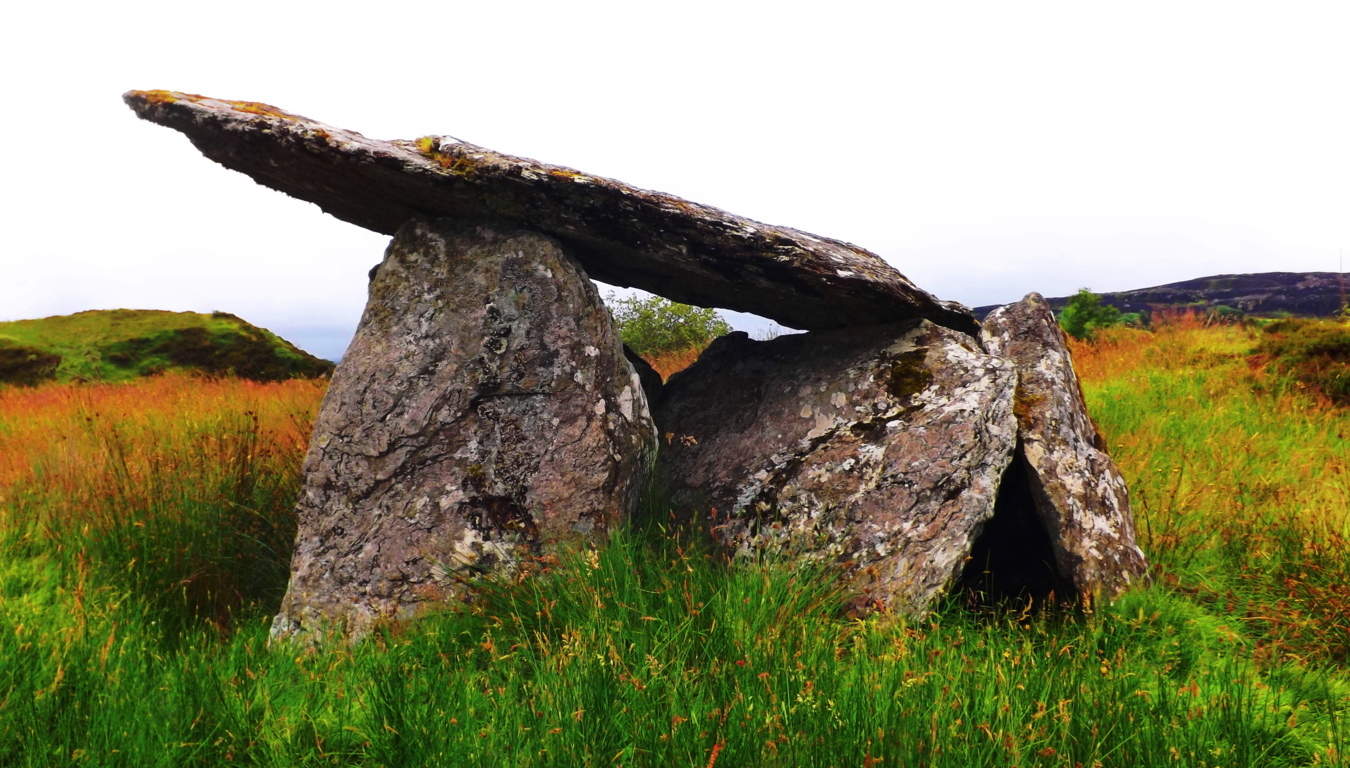 What could be a more worth while hiking goal? Whatever you do, stop to appreciate the the strange darkened peaks, of a style i had never seen before, or since. In the end, you will have to decide what your goals in a rustic scene like this will be.
What could be a more worth while hiking goal? Whatever you do, stop to appreciate the the strange darkened peaks, of a style i had never seen before, or since. In the end, you will have to decide what your goals in a rustic scene like this will be.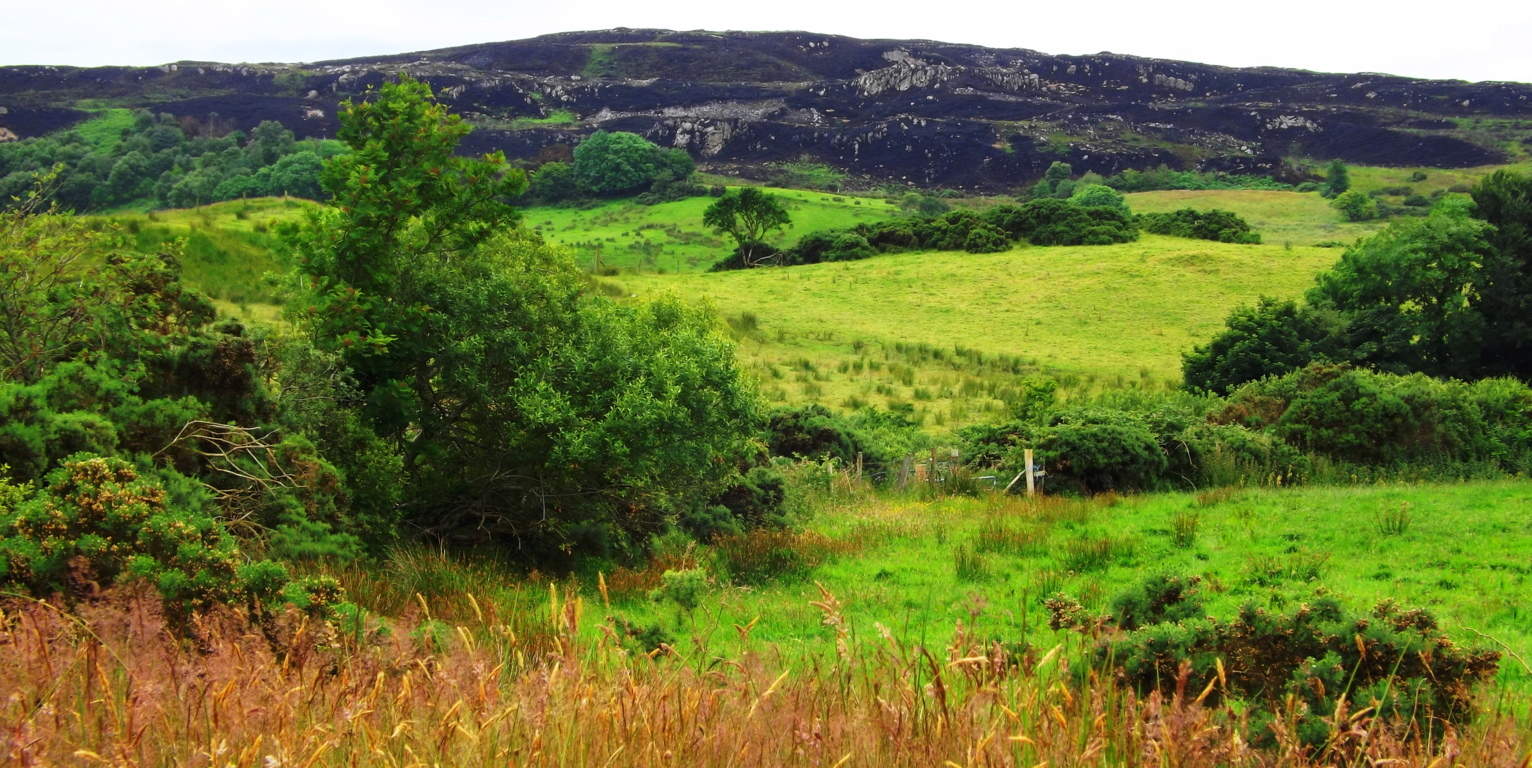 If hiking to the top of Mount Ranny is your goal, be prepared to cross farmers fields, and travail the obstacles, with a tough incline as you go. If finding the Gortnavern Dolmen is your goal, you must find Drumatrumman Road. Pass the farm at the top of Drumatrumman Road, and continue about a half mile further up the hedgy dirt path. You will need to look right; At about 75 yards to the right of the lane, beyond cows in the fields, just to the next gully, beyond the stream, you will see the Dolmen. Beyond the hedges behind the cattle in the image below, the Dolmen is just out of view at this vantage from the road. Keep clear of the bull, follow the hedge to the left.
If hiking to the top of Mount Ranny is your goal, be prepared to cross farmers fields, and travail the obstacles, with a tough incline as you go. If finding the Gortnavern Dolmen is your goal, you must find Drumatrumman Road. Pass the farm at the top of Drumatrumman Road, and continue about a half mile further up the hedgy dirt path. You will need to look right; At about 75 yards to the right of the lane, beyond cows in the fields, just to the next gully, beyond the stream, you will see the Dolmen. Beyond the hedges behind the cattle in the image below, the Dolmen is just out of view at this vantage from the road. Keep clear of the bull, follow the hedge to the left. 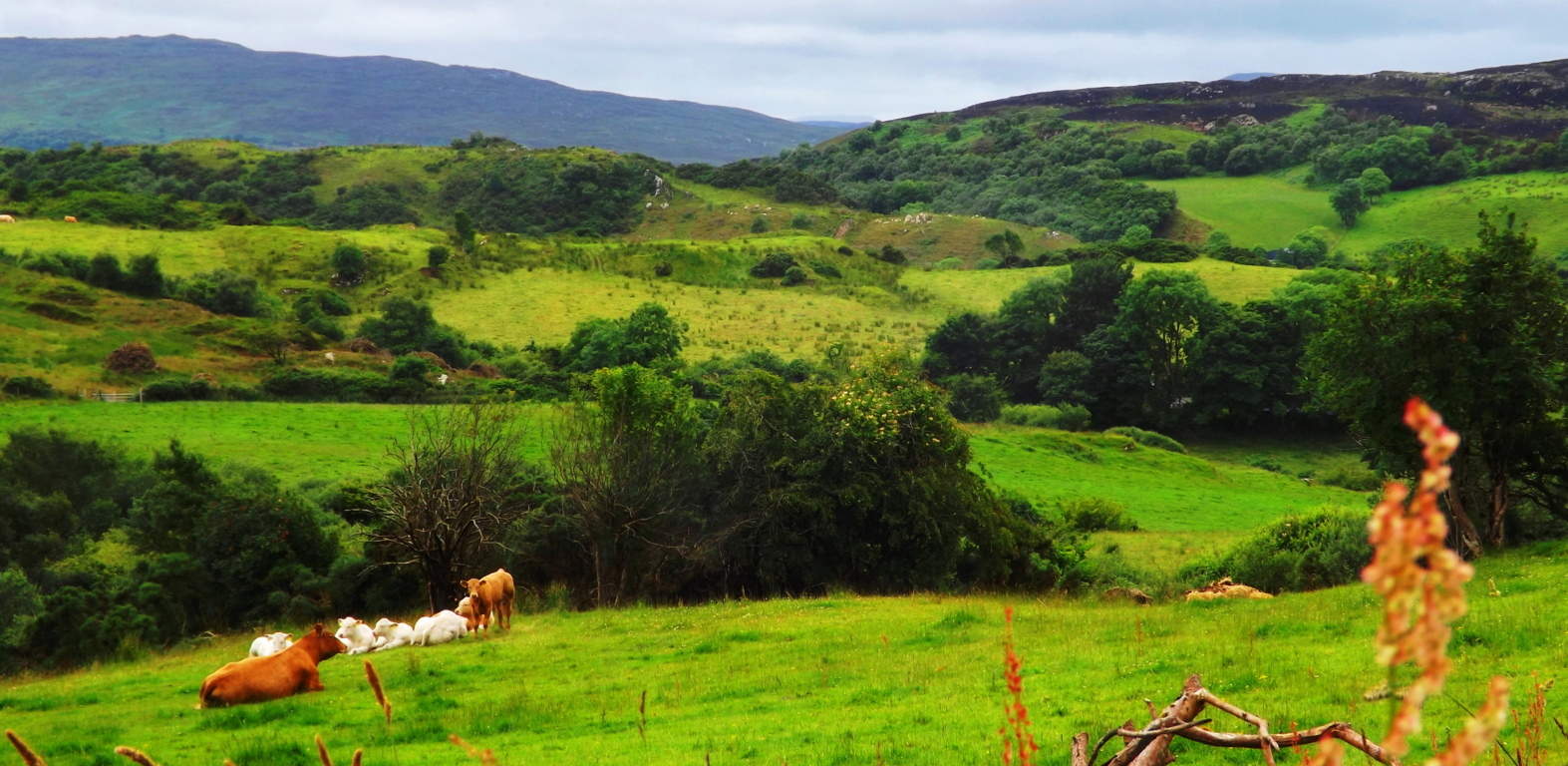 More generally, approaching this scene, there is a sign for the ‘Gortnavern Dolmen’ from the main road just outside Kerrykeel center, but from there you should plan to ask for help, and bring your GPS/Phone, you will need it. Many of the roads do not have names, so approach farmers with humble honesty and respect. You are on their land. If you tell them you would like to see the Dolmen, they will gladly show you the way, but DO NOT JUST WAVE AT THEM AND PASS BY. This is a real rural community, with functional farms and generational families at work, be respectful.
More generally, approaching this scene, there is a sign for the ‘Gortnavern Dolmen’ from the main road just outside Kerrykeel center, but from there you should plan to ask for help, and bring your GPS/Phone, you will need it. Many of the roads do not have names, so approach farmers with humble honesty and respect. You are on their land. If you tell them you would like to see the Dolmen, they will gladly show you the way, but DO NOT JUST WAVE AT THEM AND PASS BY. This is a real rural community, with functional farms and generational families at work, be respectful.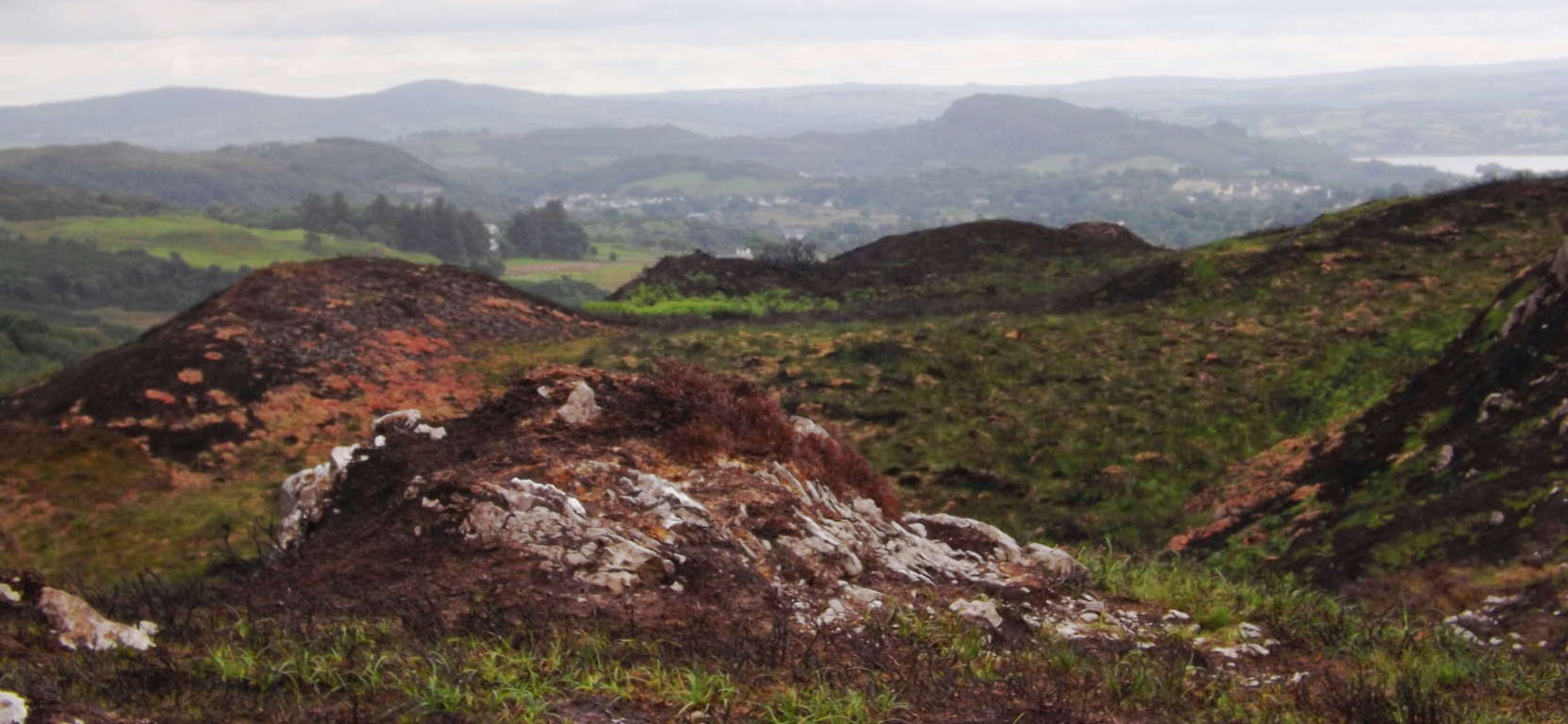 If you can get to Gortnavern, you have already achieved something which most people, even seasoned hikers, will never do. These are the rare places, the wild unmarked terrains, where you will discover more about yourself in the challenge, than any commercially advertised trek can offer. This is the real Celtic experience. Go strong, bring plenty of water, and may the road rise to meet you.
If you can get to Gortnavern, you have already achieved something which most people, even seasoned hikers, will never do. These are the rare places, the wild unmarked terrains, where you will discover more about yourself in the challenge, than any commercially advertised trek can offer. This is the real Celtic experience. Go strong, bring plenty of water, and may the road rise to meet you.
The Raven Wildlife Preserve
Note: Along the gorgeous south-west coast of Ireland, which runs all the way down to a baby-blue Irish Sea, sits the rare, old-growth, Celtic forest known as The Raven. There are a few reasons why it’s rare; The first being the British incursion of Ireland, which took place from the early Medieval period into the Colonial. The British occupation made it possible to extort vital resources for England, such as timber for the imperial fleet, starting in the mid 1500’s. 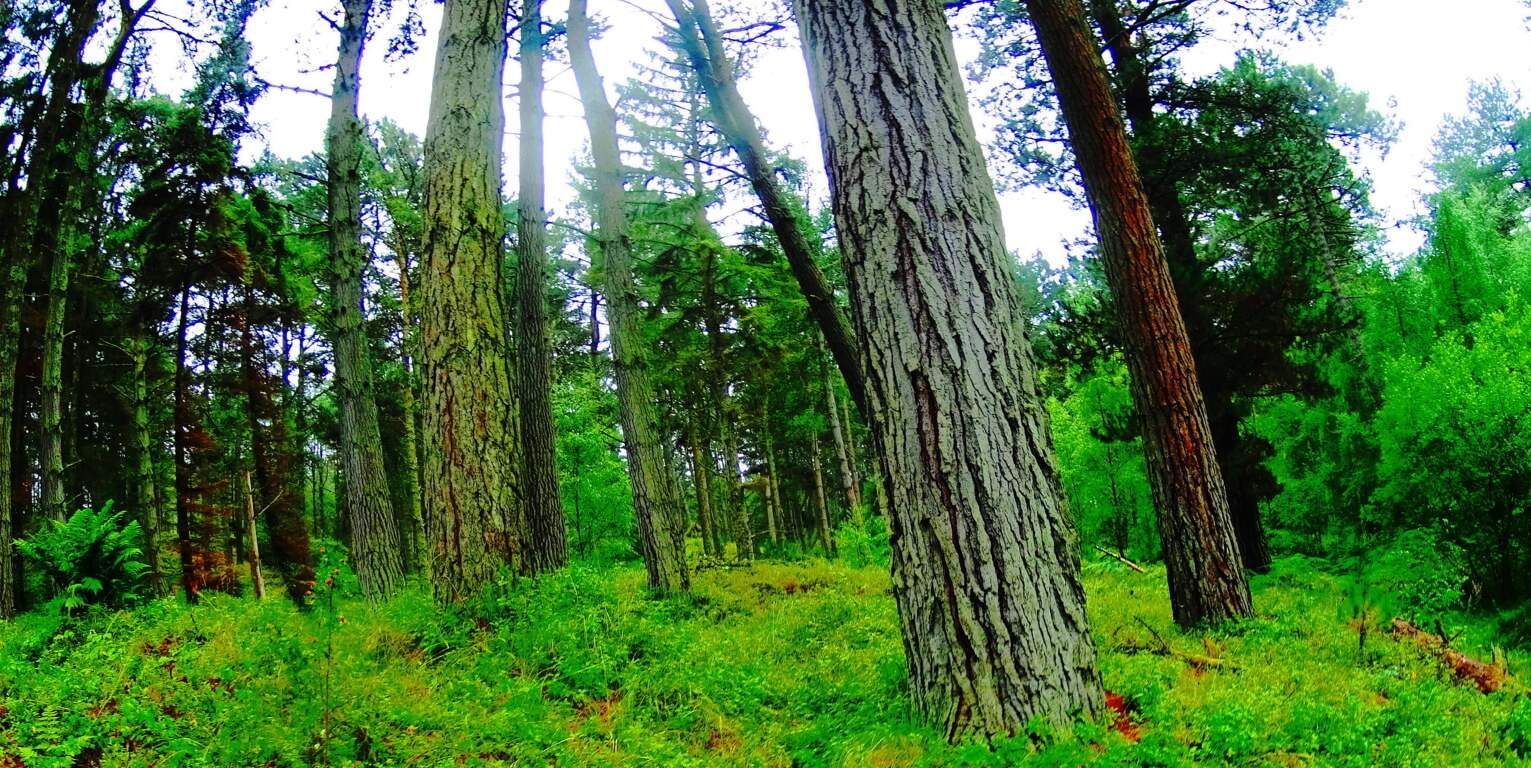 Luckily The Raven survived. The second reason for the rarity of this place is that The Raven has been a protected wildlife Reserve since the 1880’s, making it a priceless time capsule of trees and flowers that have almost vanished. It is the only place left in the country where you can find the wildflower known as Wintergreen, which is mingled among Devil’s-Bits, Foxgloves, and Bluebells in the grassy dunes. This is a place to let your imagination go, and daydream about the feeling of old Celtic regions. It is a natural kingdom of preserved fauna and wildlife that Celtic peoples felt was sacred.
Luckily The Raven survived. The second reason for the rarity of this place is that The Raven has been a protected wildlife Reserve since the 1880’s, making it a priceless time capsule of trees and flowers that have almost vanished. It is the only place left in the country where you can find the wildflower known as Wintergreen, which is mingled among Devil’s-Bits, Foxgloves, and Bluebells in the grassy dunes. This is a place to let your imagination go, and daydream about the feeling of old Celtic regions. It is a natural kingdom of preserved fauna and wildlife that Celtic peoples felt was sacred.
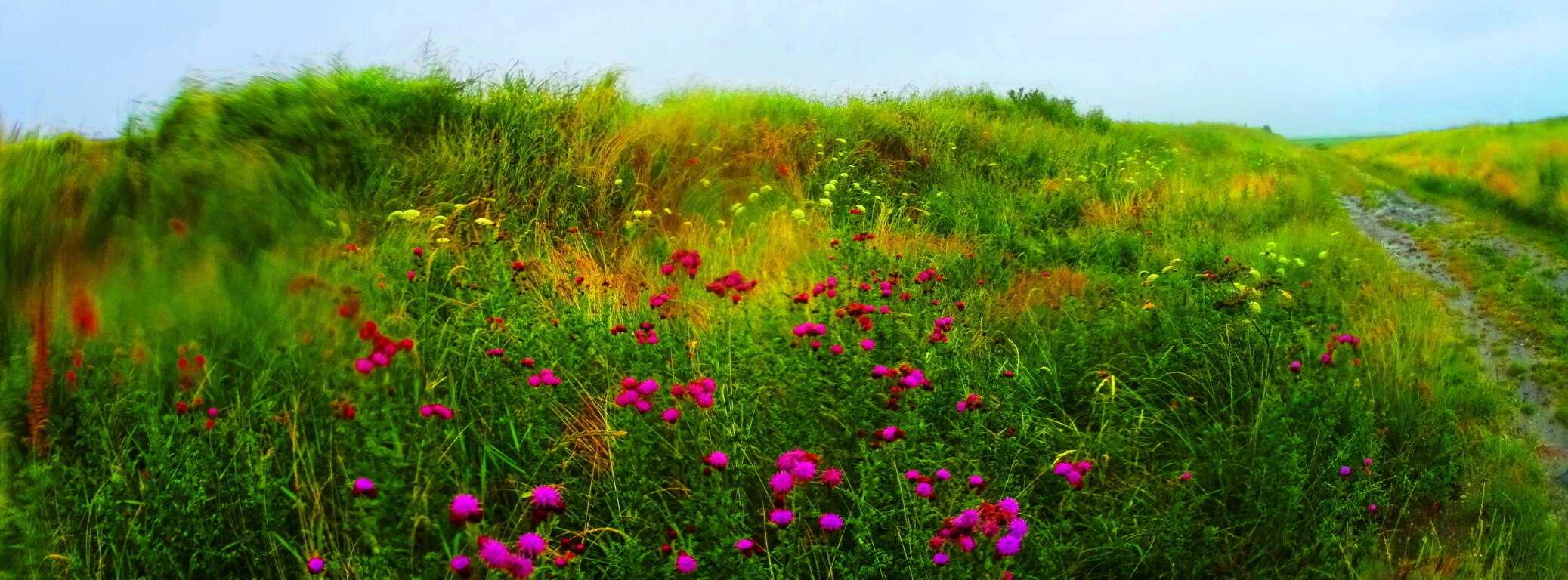 Beautiful trails extend around, and through this forest of towering Irish Pines and Evergreens. One of the trails is a basic circular loop around the edge of the old glades. S0me tree’s are standing over 150 feet tall, above broad beds of rolling clover, tall grass, and shiny white sand.
Beautiful trails extend around, and through this forest of towering Irish Pines and Evergreens. One of the trails is a basic circular loop around the edge of the old glades. S0me tree’s are standing over 150 feet tall, above broad beds of rolling clover, tall grass, and shiny white sand.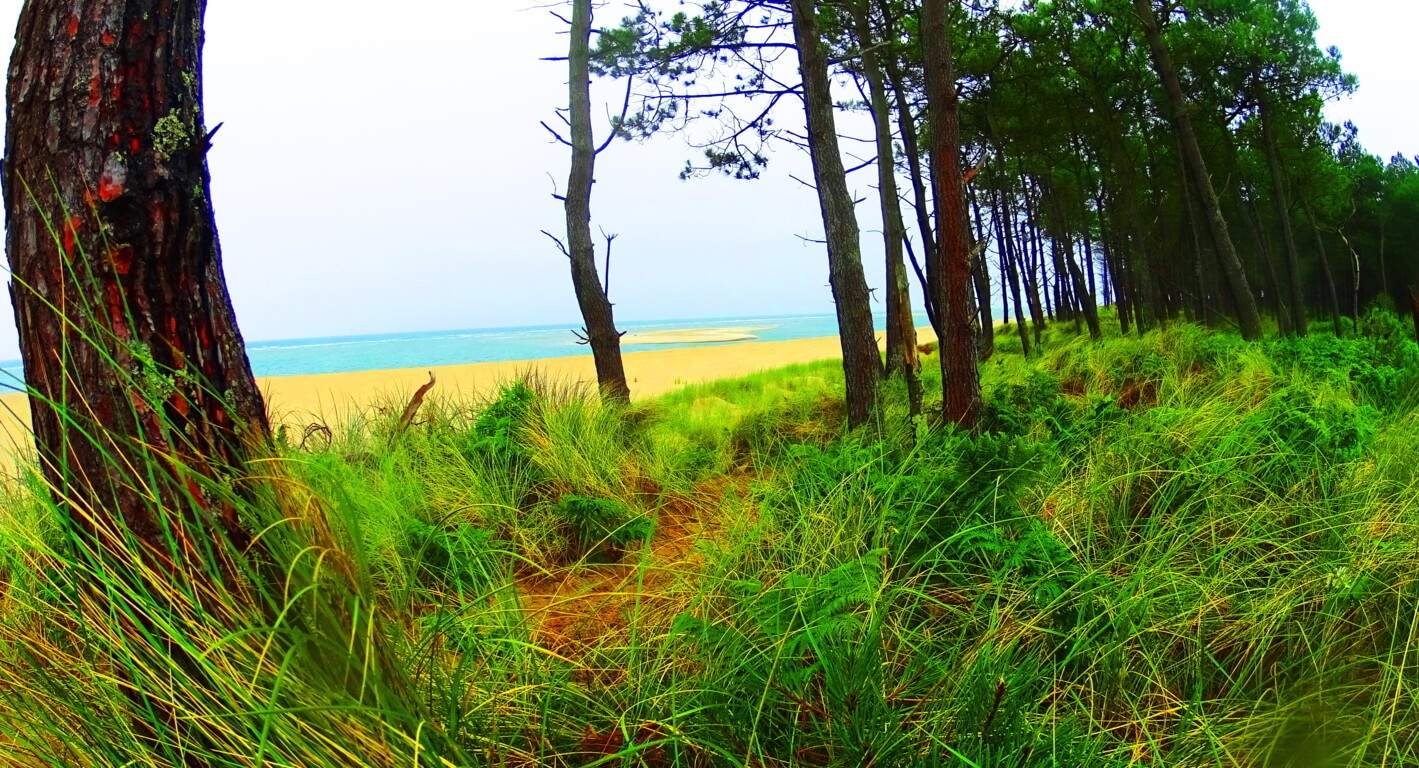 If you add the element of the striking blue-crystaline color of the Irish Sea, the overall scene becomes worthy of wonder. There are fantastic minor trails that branch off into the forest, creating a direct pathway from the beach, about halfway around the larger outer loop.
If you add the element of the striking blue-crystaline color of the Irish Sea, the overall scene becomes worthy of wonder. There are fantastic minor trails that branch off into the forest, creating a direct pathway from the beach, about halfway around the larger outer loop.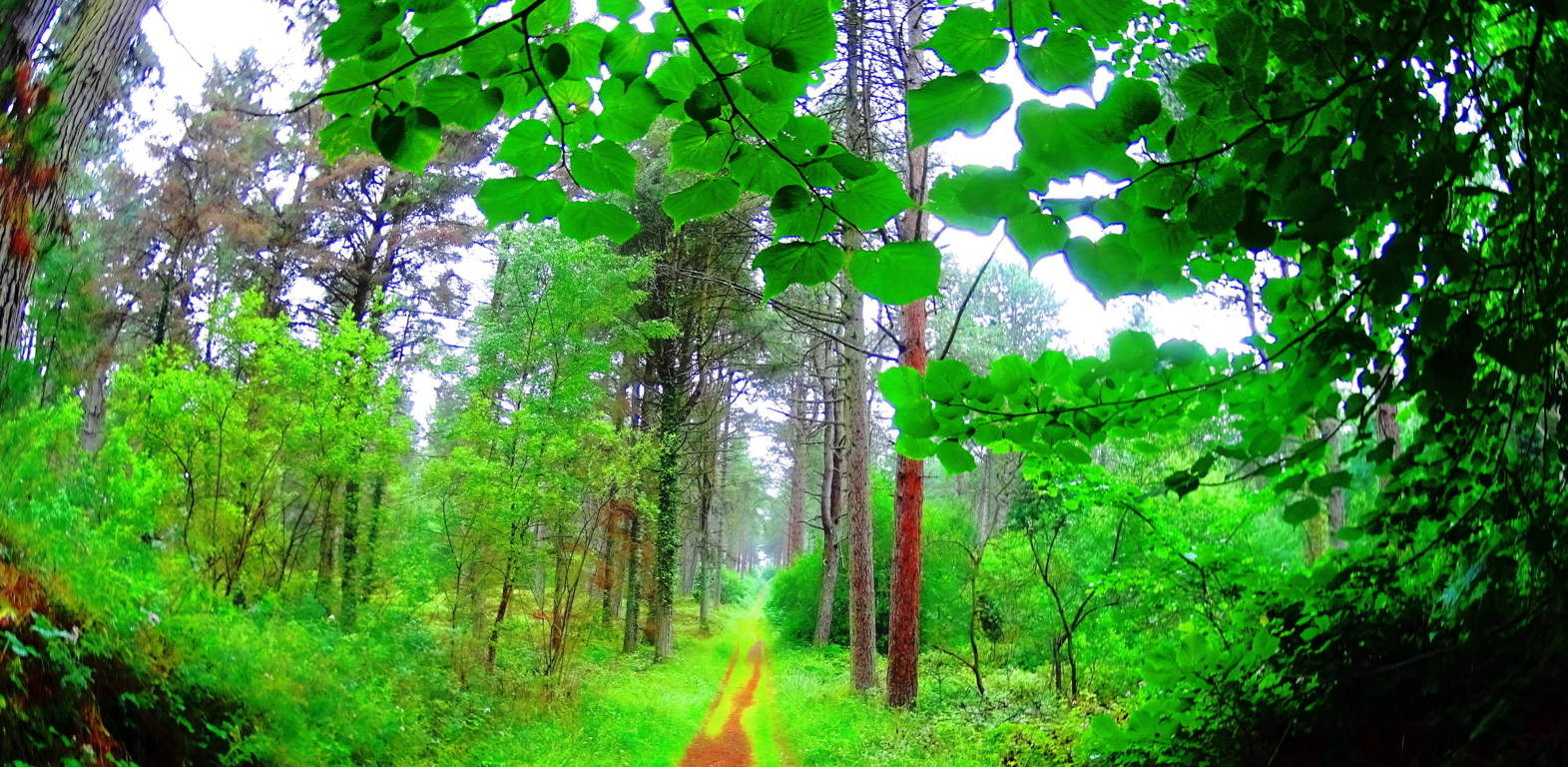 These pathways are nearly perfect for mountain-biking as well. An extended adventure is possible for those who wish to try a more rustic challenge of approaching the Raven from further off. If you park at Adcavan business park, about 3 miles away, you can bike the small dirt road that runs parallel to The Raven in the distance. Riding from the main road, you will need to lift your bike over a simple gate, and ride 2 miles, eventually reaching a dilapidated stone archway. This archway marks the path that runs directly towards the forest.
These pathways are nearly perfect for mountain-biking as well. An extended adventure is possible for those who wish to try a more rustic challenge of approaching the Raven from further off. If you park at Adcavan business park, about 3 miles away, you can bike the small dirt road that runs parallel to The Raven in the distance. Riding from the main road, you will need to lift your bike over a simple gate, and ride 2 miles, eventually reaching a dilapidated stone archway. This archway marks the path that runs directly towards the forest. 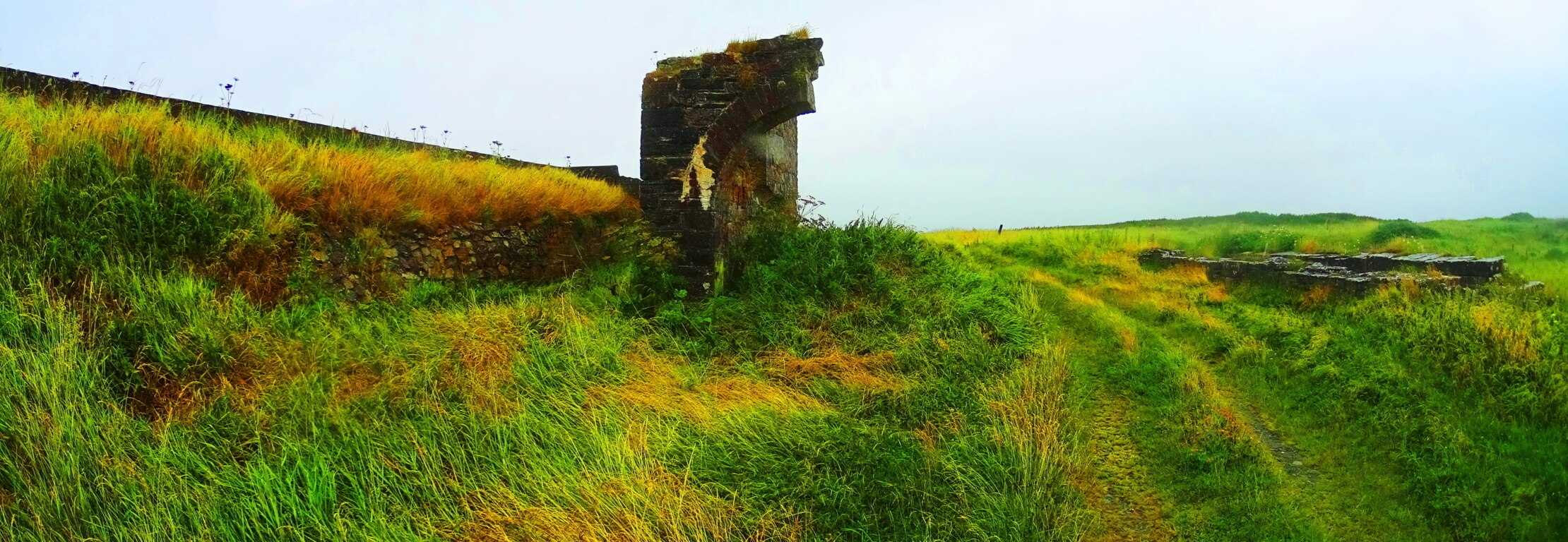 This route is rustic and challenging, with rocky paths that run along a huge ocean channel lined with golden wildflowers while you approach. At times you may need to walk your bike, but it leaves time to get a picture of the channel with The Raven beyond.
This route is rustic and challenging, with rocky paths that run along a huge ocean channel lined with golden wildflowers while you approach. At times you may need to walk your bike, but it leaves time to get a picture of the channel with The Raven beyond.
 Once you reach the forest you may wish to explore the beach before continuing to ride. Lock your bike around a tree and climb over the dunes to get a glimpse of the Irish Sea. Smaller side paths lead through thickets on the edge of the dunes that are tempting to follow.
Once you reach the forest you may wish to explore the beach before continuing to ride. Lock your bike around a tree and climb over the dunes to get a glimpse of the Irish Sea. Smaller side paths lead through thickets on the edge of the dunes that are tempting to follow.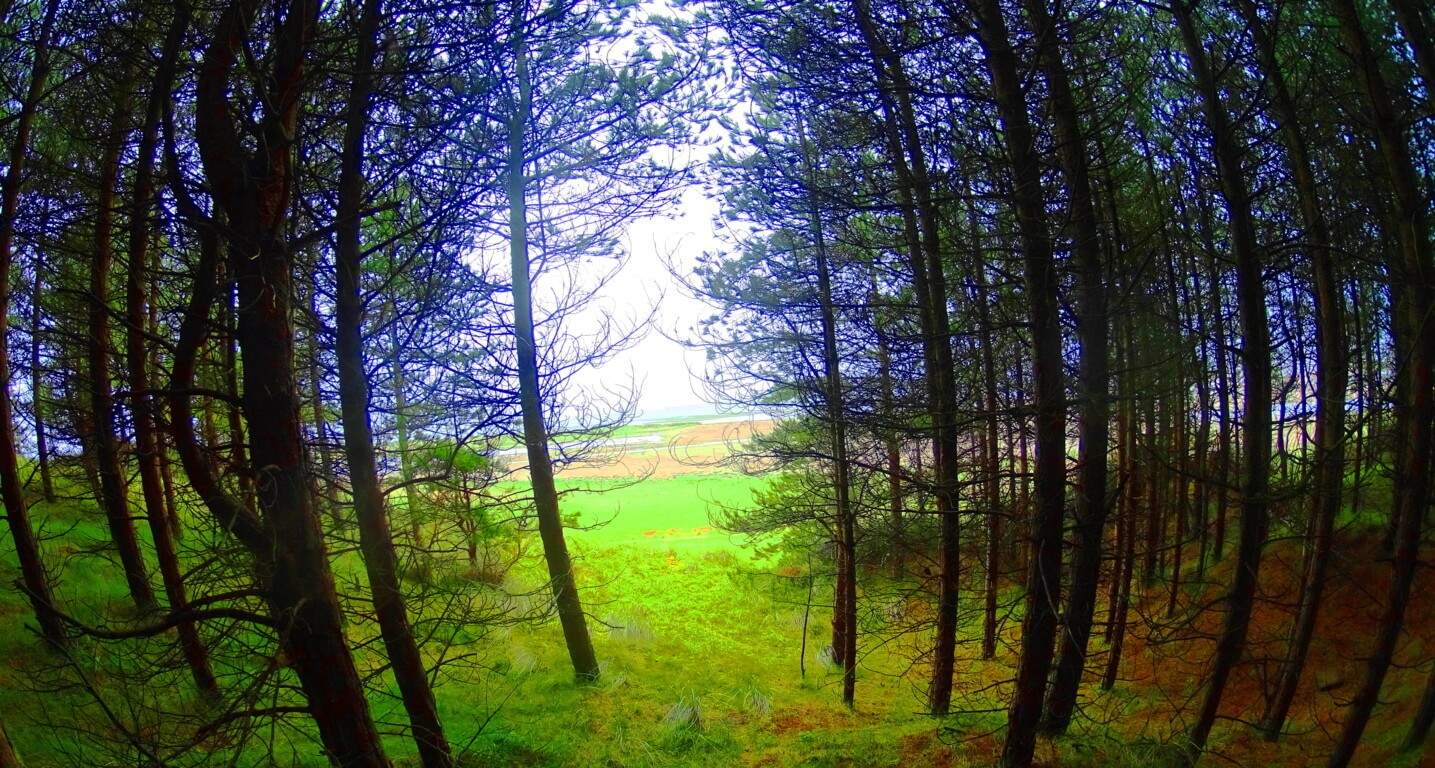 The Pines run to the edge of the dunes, opening up to a spectacular scene, one which the ancient mariners of England, and the Vikings, must have admired while approaching to raid. A view like this is also most likely what a young Saint Patrick must have seen, and had to return to, even after captivity.
The Pines run to the edge of the dunes, opening up to a spectacular scene, one which the ancient mariners of England, and the Vikings, must have admired while approaching to raid. A view like this is also most likely what a young Saint Patrick must have seen, and had to return to, even after captivity.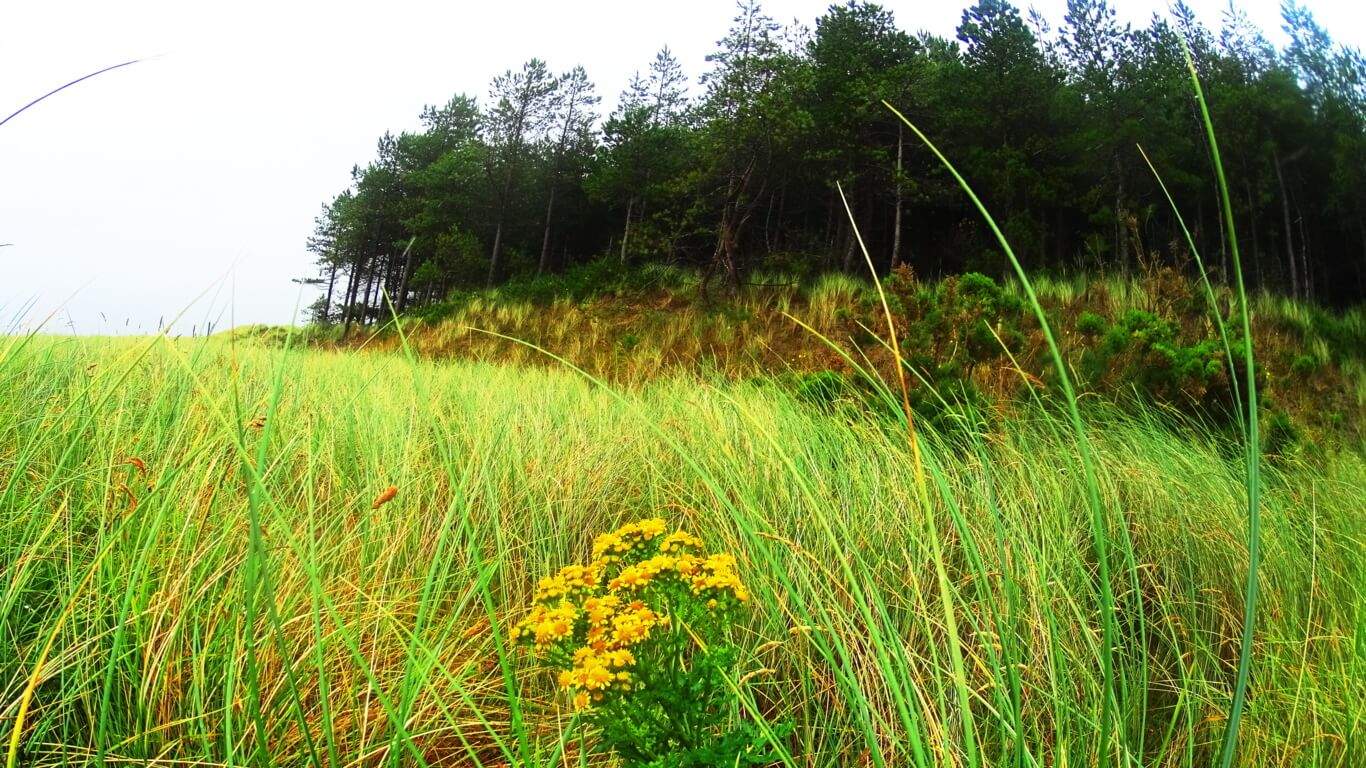 This place is hauntingly beautiful, even on a cloudy day. Enjoy the opportunity to relax and wander in a rare wildlife scene from long ago. All options for exploration are possible at The Raven. Good luck as you go:) Seek and find.
This place is hauntingly beautiful, even on a cloudy day. Enjoy the opportunity to relax and wander in a rare wildlife scene from long ago. All options for exploration are possible at The Raven. Good luck as you go:) Seek and find.
Monument Mountain
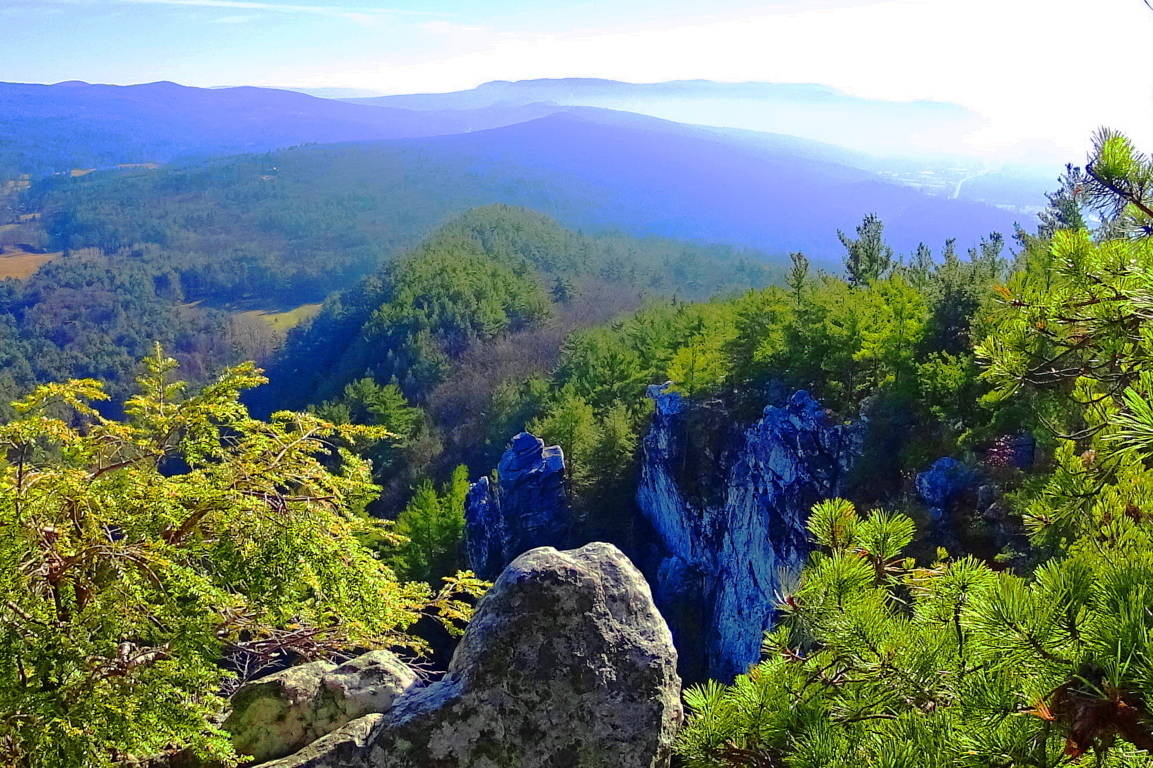 Location: Great Barrington, Massachusetts/USA
Location: Great Barrington, Massachusetts/USA
Elevation: 1,642 ft
Note: Monument Mountain is a rare natural gem for Massachusetts. It is not connected to the rolling hills of eastern New England, but rather the beautiful Berkshire Mountain range, which runs through the southwest corner of Massachusetts, before continuing northwest into New York State. In early November the hillsides around Monument Mountain practically glow from the morning frost in the Sunrise, giving it a unique New England appeal…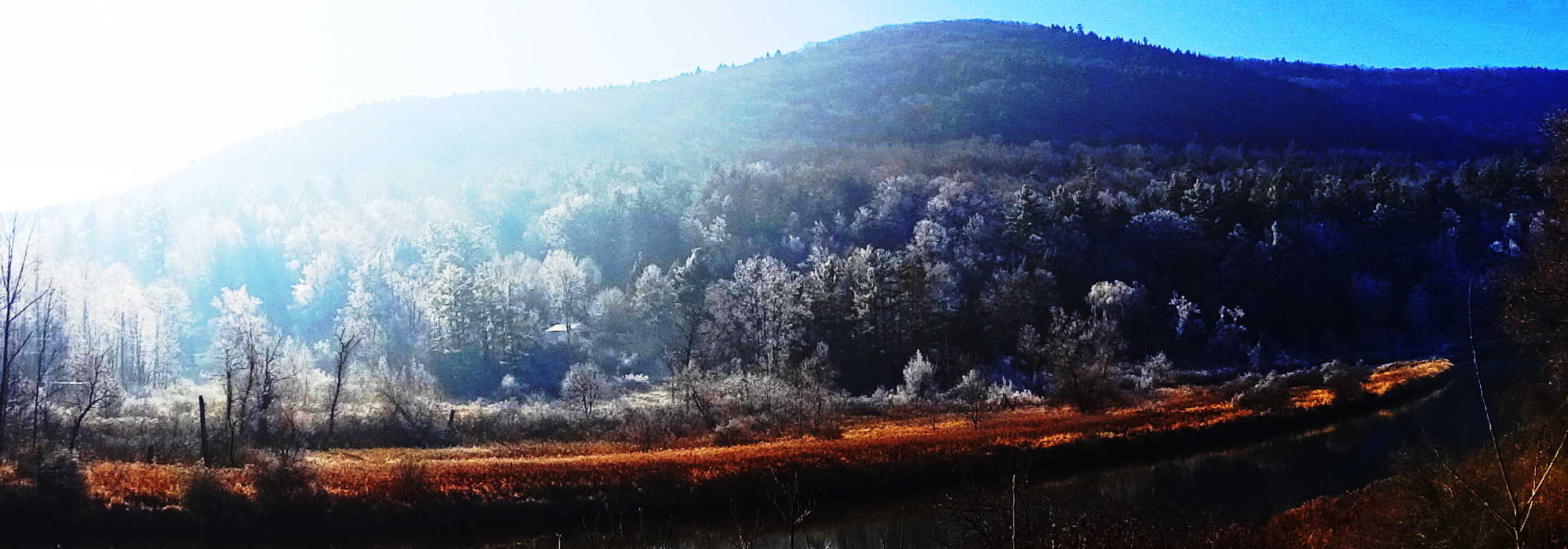 From top to bottom, massive shelves of white-quartzite line the mountainside, with jagged cliffs looming hundreds of feet above the trails, leading to what is known as ‘Squaw-Peak’. Alternative trails are known as “Indian Monument, and”Hickey Trail”, but are both essentially part of the same loop leading to Squaw Peak. As hard as it might be to believe, this is the Macchu Piccu of Massachusetts.
From top to bottom, massive shelves of white-quartzite line the mountainside, with jagged cliffs looming hundreds of feet above the trails, leading to what is known as ‘Squaw-Peak’. Alternative trails are known as “Indian Monument, and”Hickey Trail”, but are both essentially part of the same loop leading to Squaw Peak. As hard as it might be to believe, this is the Macchu Piccu of Massachusetts.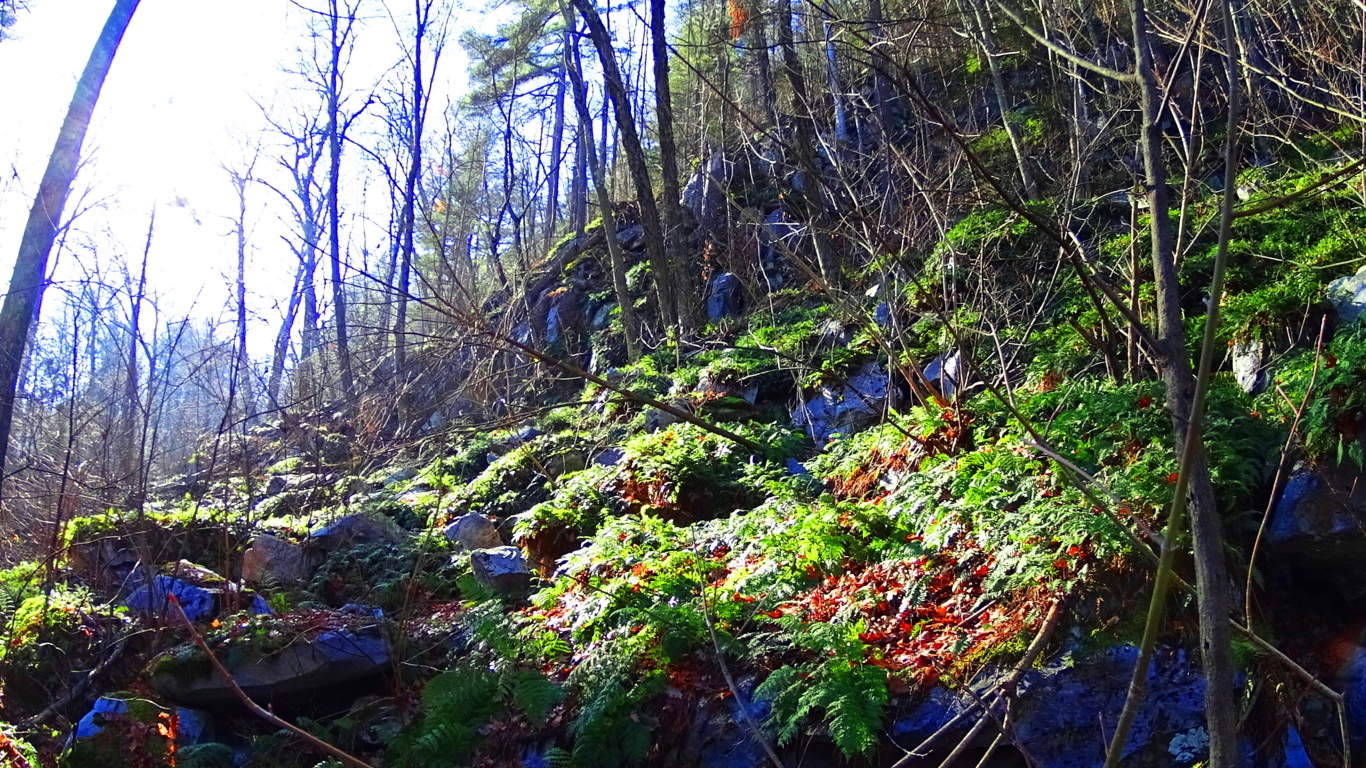 The trails here lead through glades of old growth forest and quartzite glens. There are White Pines, Hemlocks, Maples, and Birches in the elevated areas, that change the feeling of the trail as you go. The forest is a barrage of overgrowth and ledges, with craggy shelves at every turn.
The trails here lead through glades of old growth forest and quartzite glens. There are White Pines, Hemlocks, Maples, and Birches in the elevated areas, that change the feeling of the trail as you go. The forest is a barrage of overgrowth and ledges, with craggy shelves at every turn.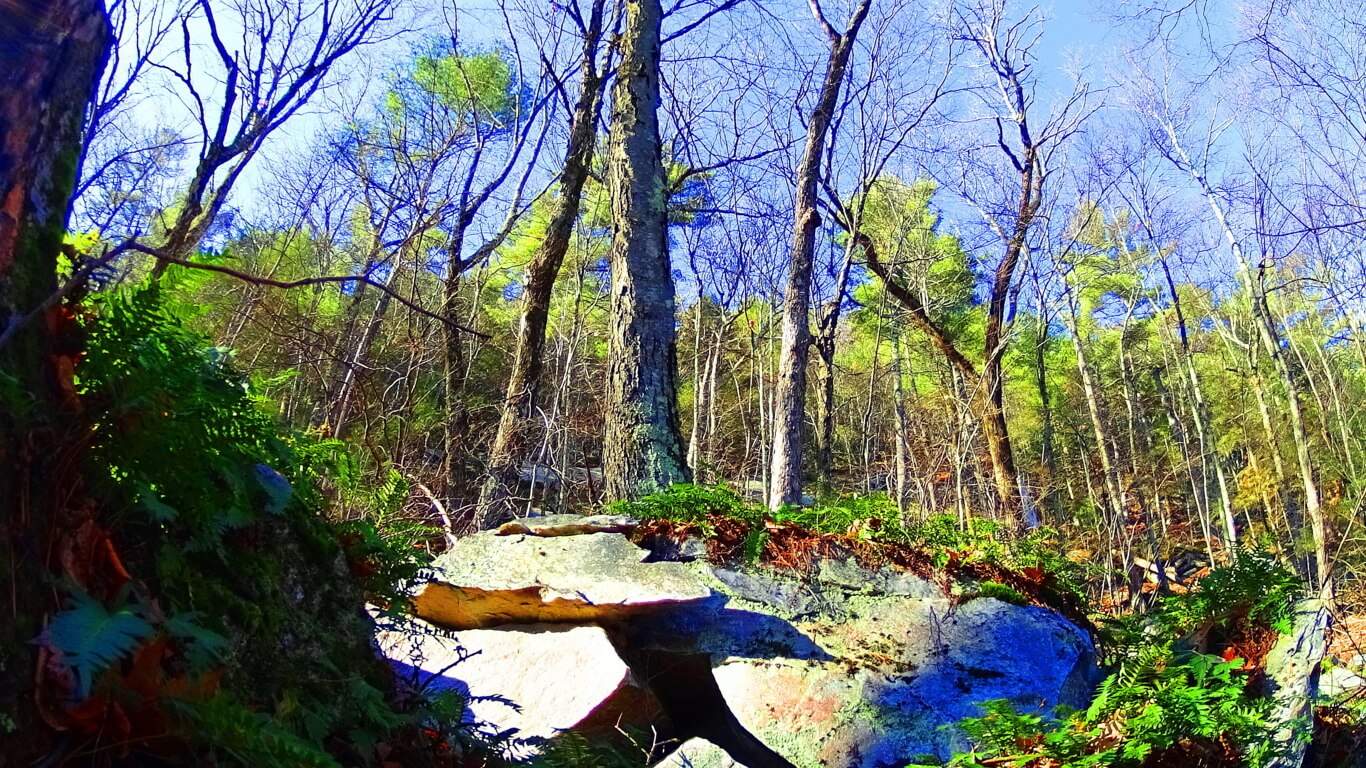 Some fixtures were obviously toppled by a glacial game that was played over 10,500 years ago, while other stones do not seem random at all.
Some fixtures were obviously toppled by a glacial game that was played over 10,500 years ago, while other stones do not seem random at all.
The Solar Stones: The initial trail runs through a glade of towering Pines for about a half mile. Soon you will encounter an incline in the path that will lead you into Birch groves, baby Pines, and stony footing. As the trail to Squaw Peak begins to elevate, there are stairs that are clearly cut out of the mountain, leading up to smooth rounded porches.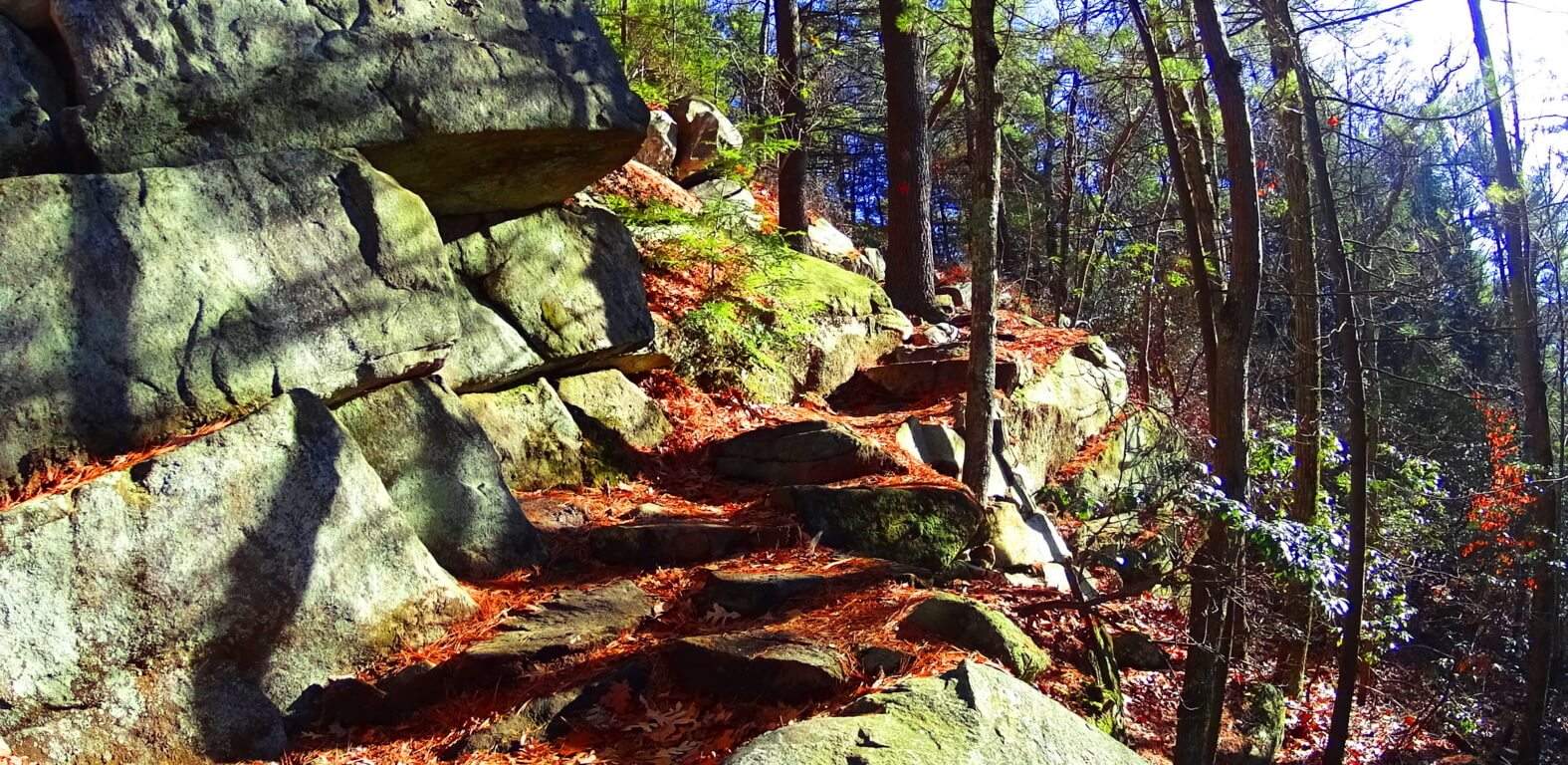 On these porches are stones that have specific angular cuts that are pointing directly at the Sun at mid-day. These stones appear at other sites in New England too. The image below is a prime example of the Solar Stone type at Monument Mountain, approaching Squaw Peak. Before coming to Monument” I had found several stones that were cut exactly like this, shown below. I felt that if stones were cut specifically to be “pointing” at something significant, it would most likely be the Sun. So on this day at Monument Mountain I tested my theory. I climbed to reach Squaw Peak just before Noon, and using this method I came across this exact stone, which points directly at the Sun at Noon. These are the moments that hikers live for. Trail features become both an exploration into natural beauty, and anthropological. Standing there, as the Sun was directly above this stone, I felt as if I was momentarily peeking through a keyhole connected to a culture from the beginning of Time. The “Solar Stones” geometry is essentially: a single long-side leading up to a 45 degree angle, which is then cut, creating an arrow head, or apex, pointing straight up; Then the cut goes back down 45 degrees, to a shorter side, which runs parallel to the long side. These cuts are made in solid granite. Take a look below…
On these porches are stones that have specific angular cuts that are pointing directly at the Sun at mid-day. These stones appear at other sites in New England too. The image below is a prime example of the Solar Stone type at Monument Mountain, approaching Squaw Peak. Before coming to Monument” I had found several stones that were cut exactly like this, shown below. I felt that if stones were cut specifically to be “pointing” at something significant, it would most likely be the Sun. So on this day at Monument Mountain I tested my theory. I climbed to reach Squaw Peak just before Noon, and using this method I came across this exact stone, which points directly at the Sun at Noon. These are the moments that hikers live for. Trail features become both an exploration into natural beauty, and anthropological. Standing there, as the Sun was directly above this stone, I felt as if I was momentarily peeking through a keyhole connected to a culture from the beginning of Time. The “Solar Stones” geometry is essentially: a single long-side leading up to a 45 degree angle, which is then cut, creating an arrow head, or apex, pointing straight up; Then the cut goes back down 45 degrees, to a shorter side, which runs parallel to the long side. These cuts are made in solid granite. Take a look below… 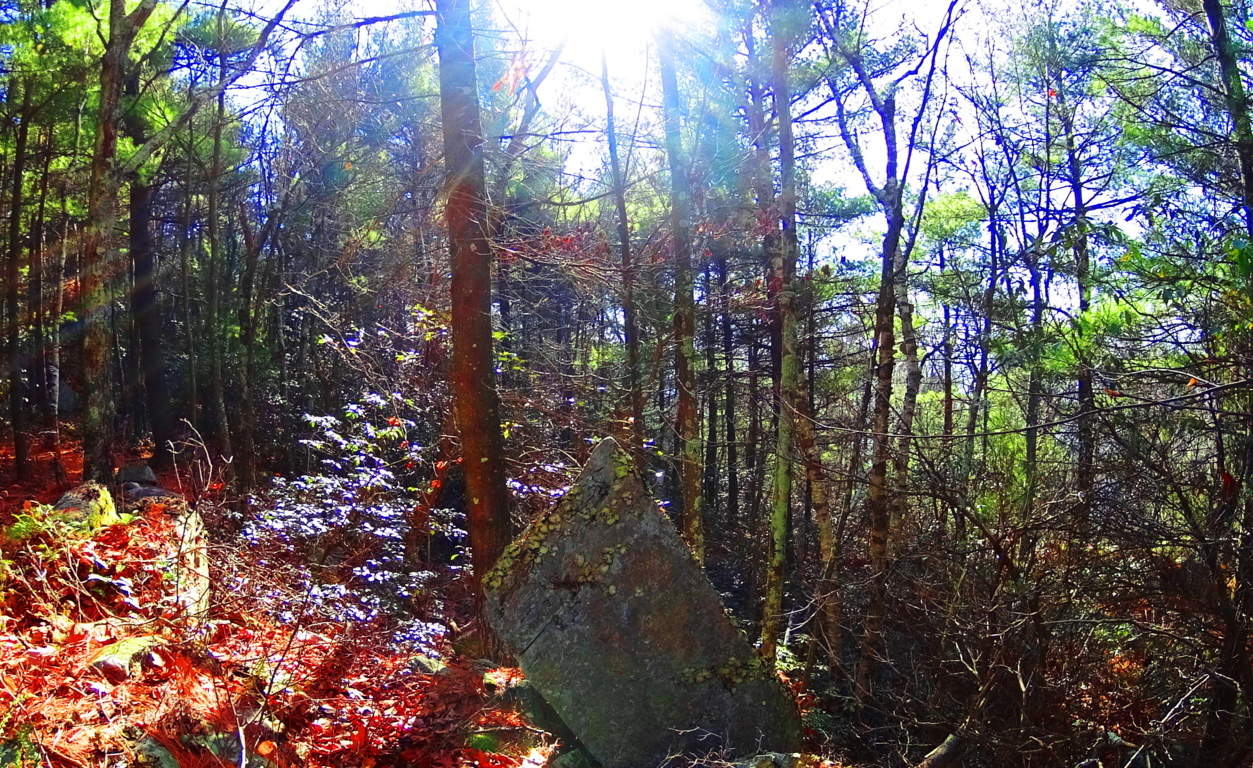 If this were the only stone that I had seen like this, then I would hesitate to publish it here, but I offer some other examples of beautifully cut Solar Stones with the exact same angles and features.
If this were the only stone that I had seen like this, then I would hesitate to publish it here, but I offer some other examples of beautifully cut Solar Stones with the exact same angles and features.  This Solar Stone pictured above is located near one of the most significant “Celtic style” alter’s in New England: the Heath Alter, of Massachusetts. Notice the identical angles.
This Solar Stone pictured above is located near one of the most significant “Celtic style” alter’s in New England: the Heath Alter, of Massachusetts. Notice the identical angles.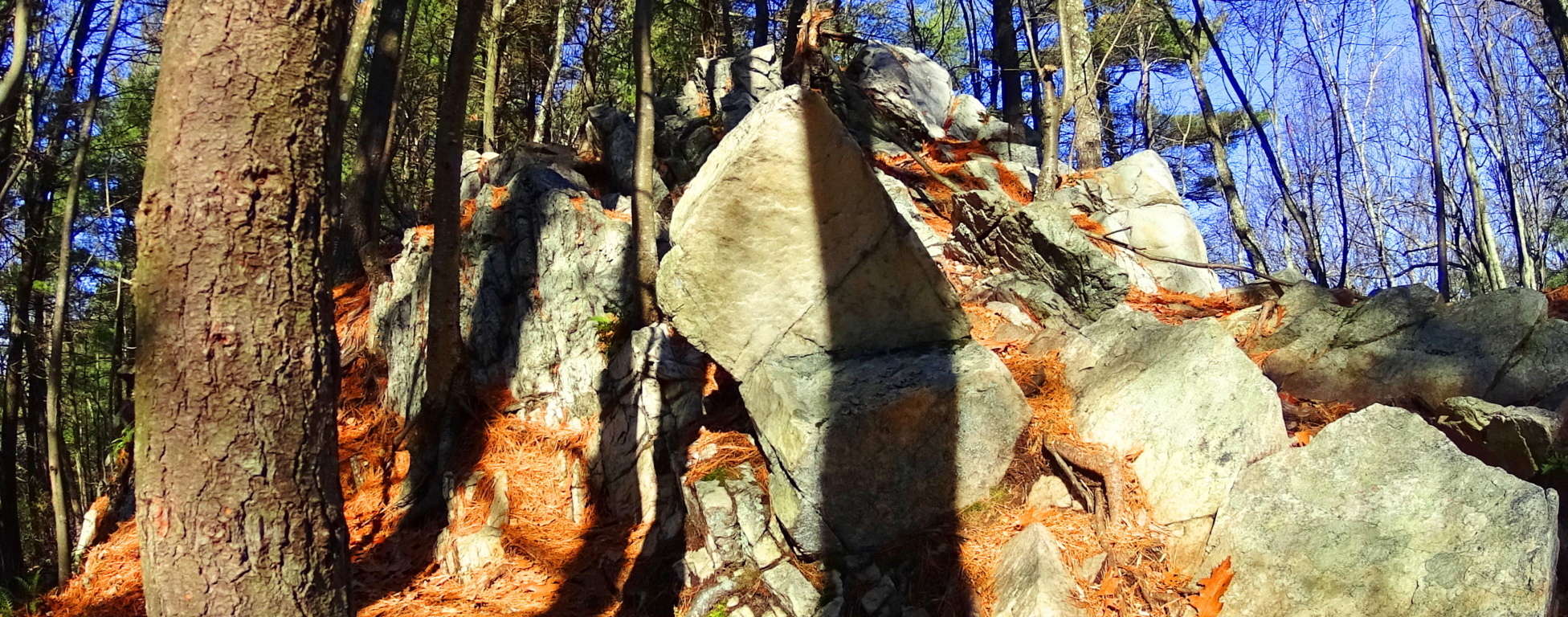 Here again is a Solar Stone with the exact same measurements at a different location.
Here again is a Solar Stone with the exact same measurements at a different location. We can at least conclude that whoever created these stones had a sense of ‘symbolism’, which in this case, was to convey how important they felt the Sun was, and that they were very much in tune with its properties.
We can at least conclude that whoever created these stones had a sense of ‘symbolism’, which in this case, was to convey how important they felt the Sun was, and that they were very much in tune with its properties.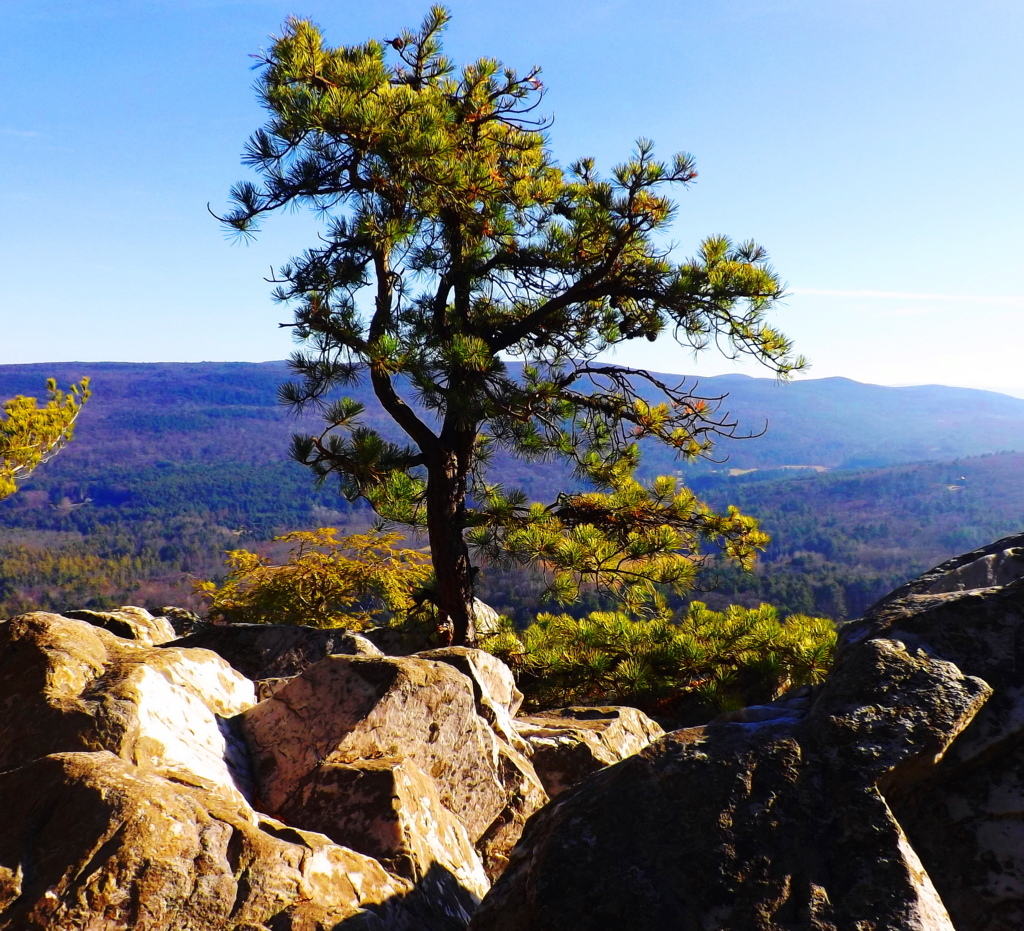 As you continue hiking along, the elevated stone porches emerge (image above) which head directly towards Squaw Peak. Your first clearing will arrive facing north-east, and its phenomenal.
As you continue hiking along, the elevated stone porches emerge (image above) which head directly towards Squaw Peak. Your first clearing will arrive facing north-east, and its phenomenal.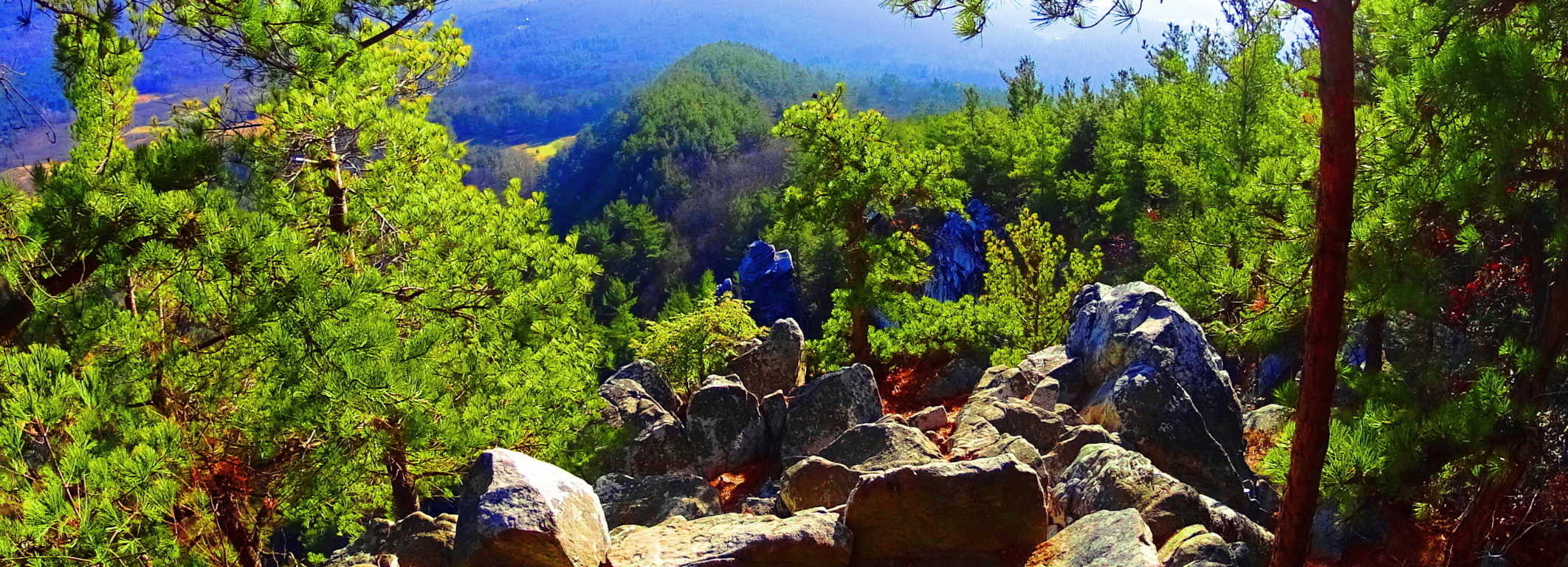
Aligned Stones: The edge of this porch has several stones that are centered and aligned with the massive square tower that stands almost 1000 feet high in the distance. This ledge also seems to be aligned to the peak of the mountain just beyond.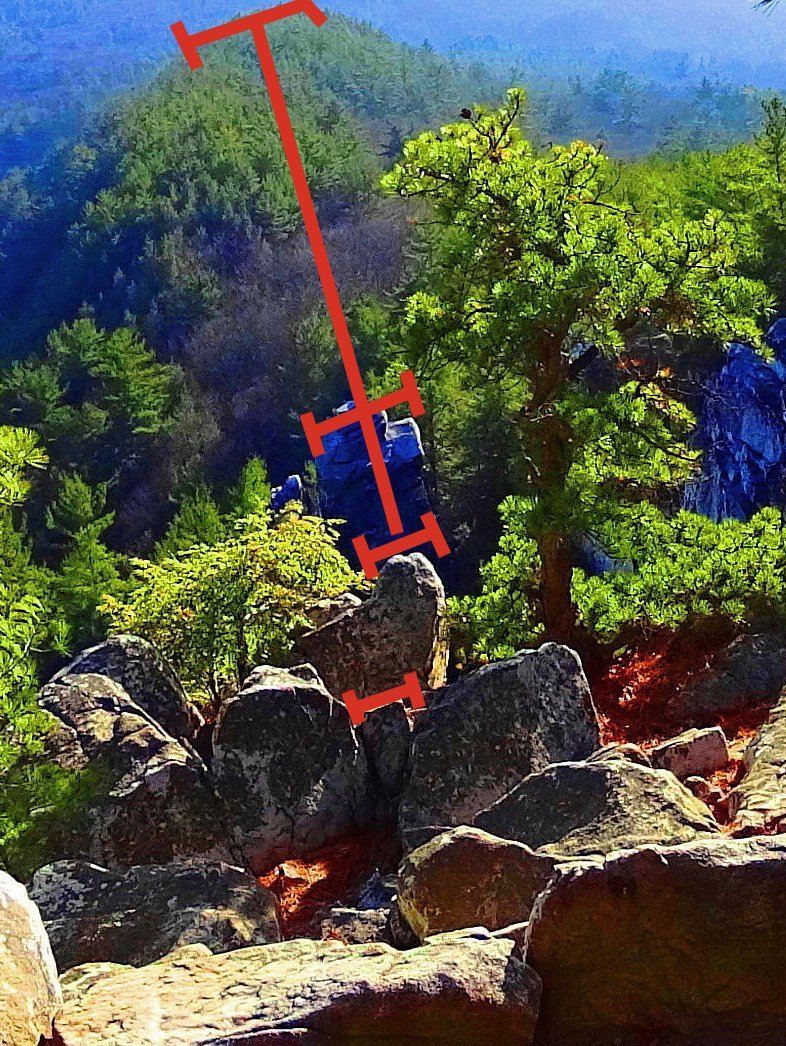 If it weren’t for places like Macchu Piccu, where stones are aligned in amazing ways at high elevations to mountains and peaks, something like this would certainly seem impossible. But notice the stones running in a straight line directly down the center of this porch, with tops that are squared perfectly with each other, as if leveled intentionally. Makes you wonder. What could possibly have done this? (left image) This is the magic of Monument Mountain’s porches.
If it weren’t for places like Macchu Piccu, where stones are aligned in amazing ways at high elevations to mountains and peaks, something like this would certainly seem impossible. But notice the stones running in a straight line directly down the center of this porch, with tops that are squared perfectly with each other, as if leveled intentionally. Makes you wonder. What could possibly have done this? (left image) This is the magic of Monument Mountain’s porches.
Pattern Stones: Along the trail at Monument” you will also see a type of stonework that fits a specific pattern. This can also be found at other sites in New England. Here is an image of a long singular megalithic slab specifically placed above three smaller supporting stones. Below this are other spots at Monument”, and other places in New England, with the same dimensions of: the long slab on top, with the three smaller below.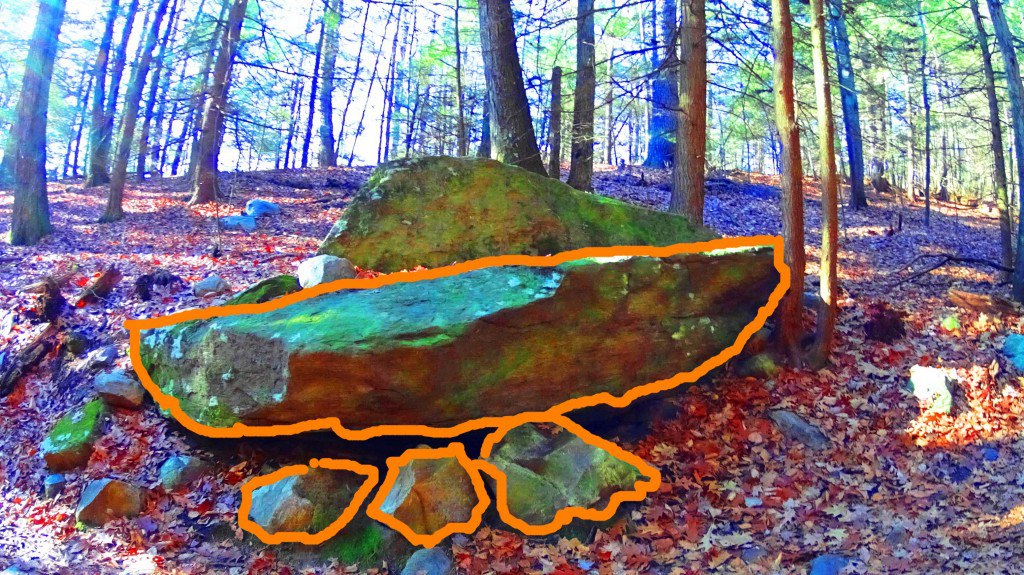 This is easily something you might pass by, believing it to be simple glacial displacement, but have a look at some other patterned stones in New England that fit this exact design.
This is easily something you might pass by, believing it to be simple glacial displacement, but have a look at some other patterned stones in New England that fit this exact design.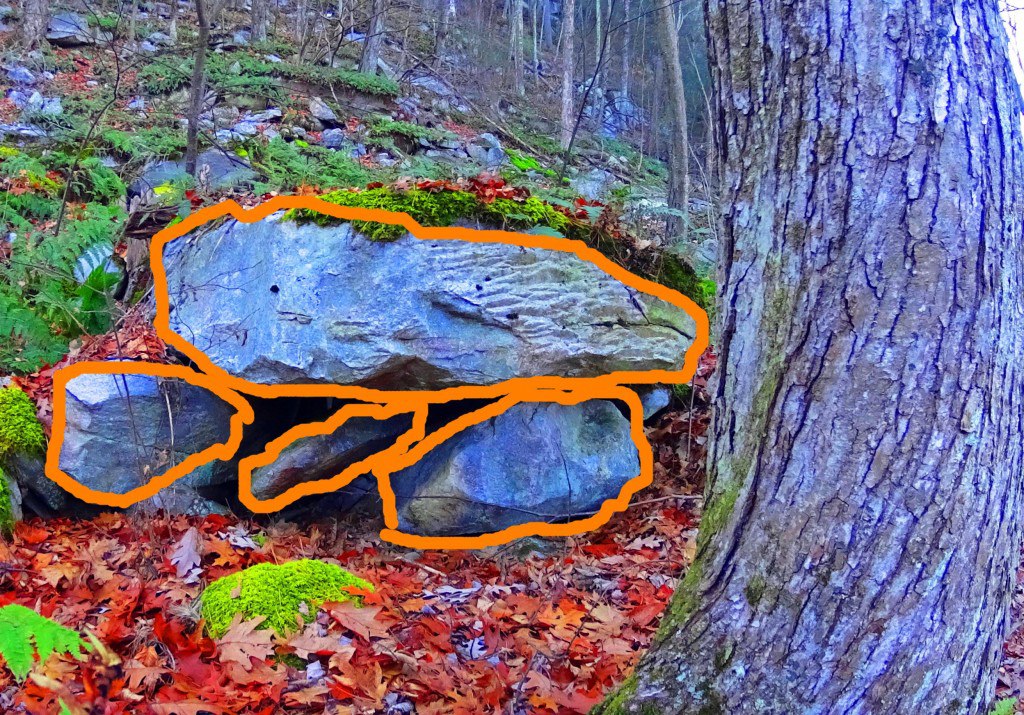
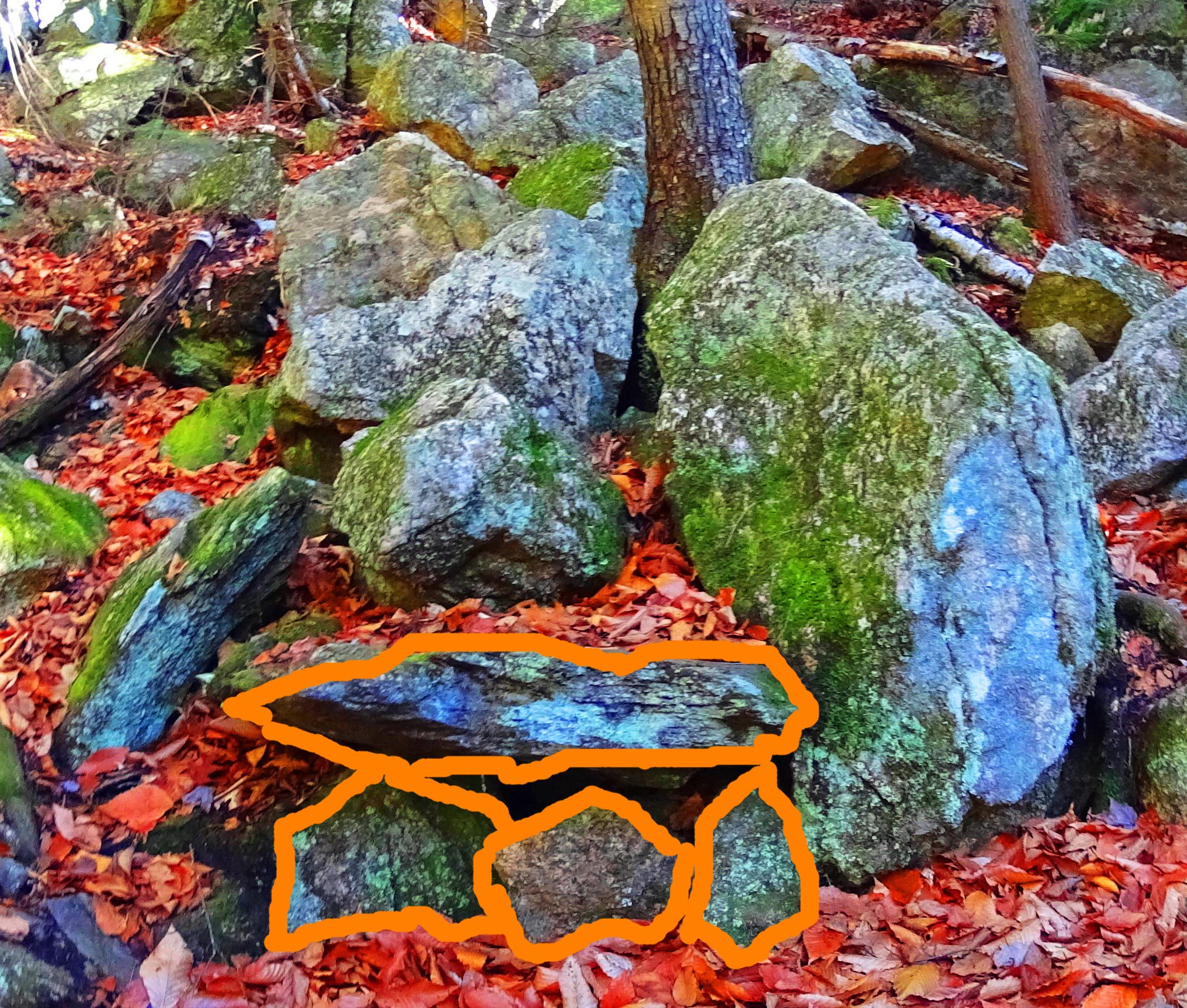
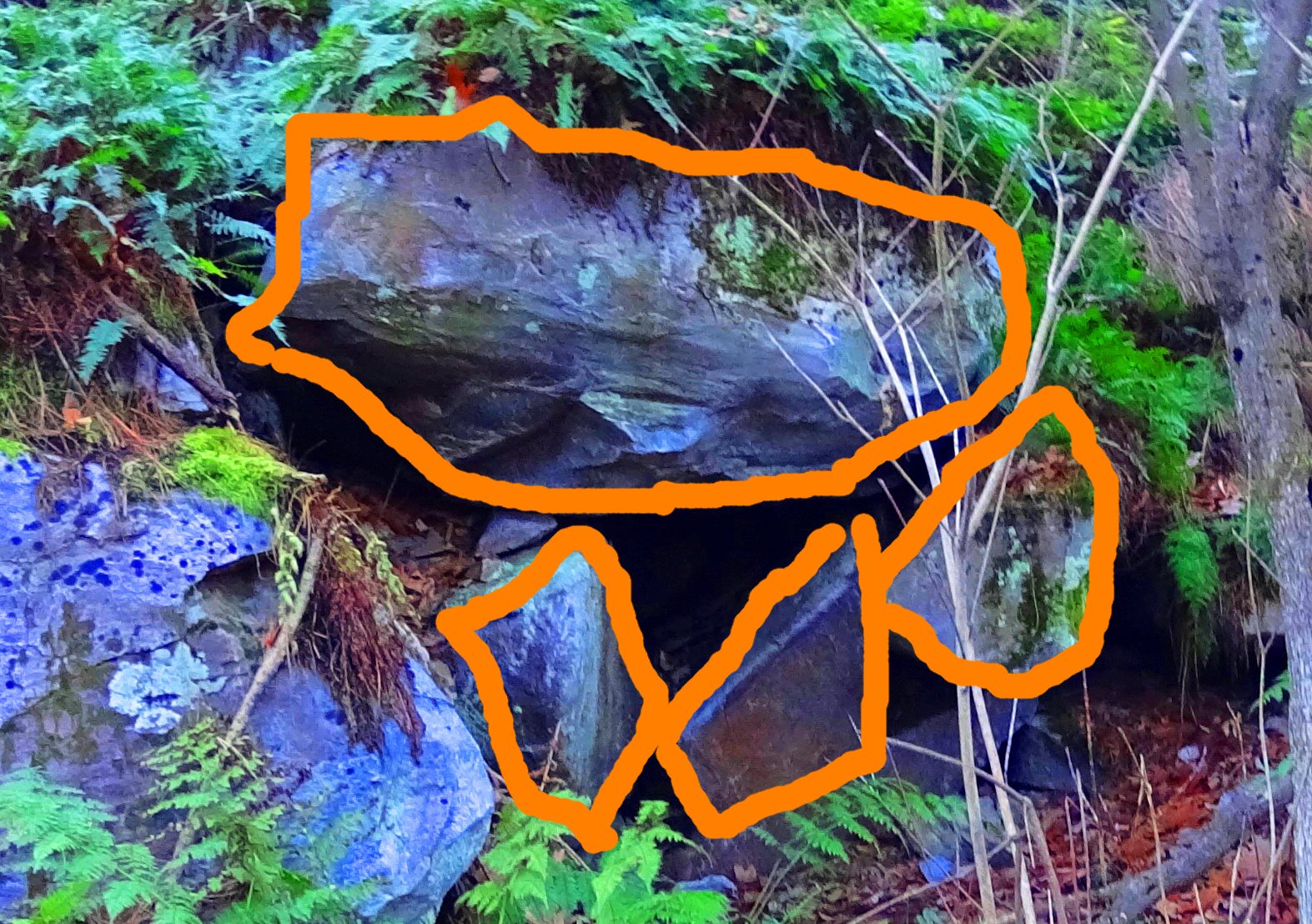
Interestingly, over 2000 miles away, there are Dolmens in Ireland that, in profile, fit this is exact numeric design: one long slab over three lesser stones This example is significantly larger, which is the Gaulstown Dolmen, with a capstone weighing 6 tons, suspended roughly 6 feet in the air. 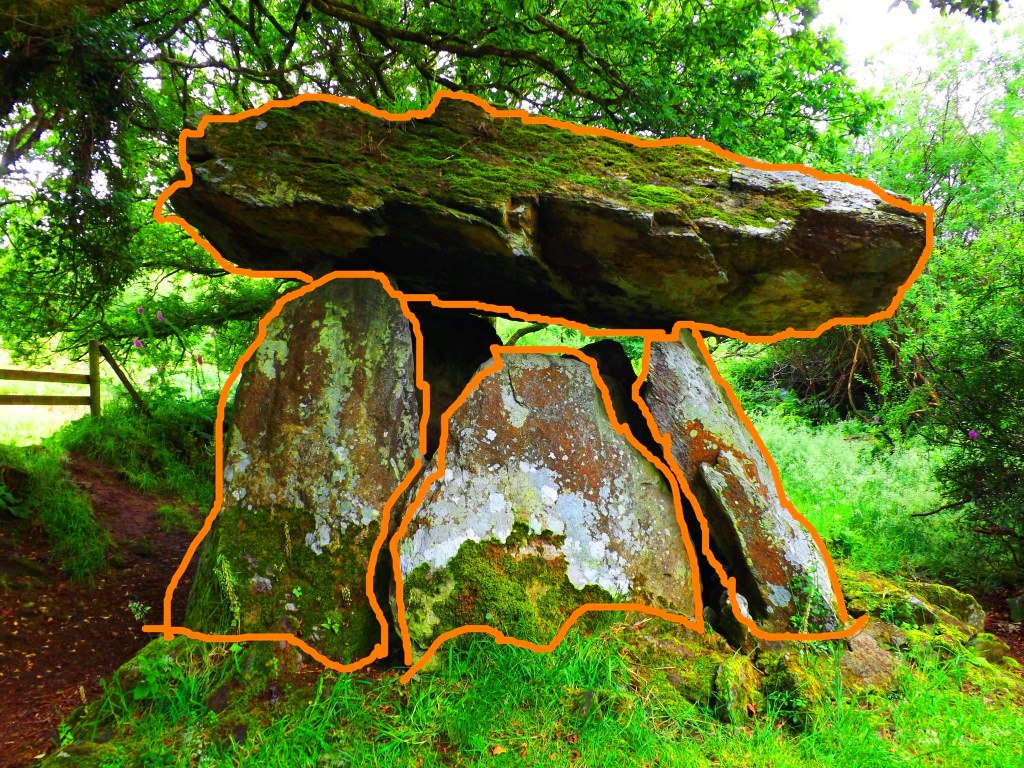 This relationship of 1 over 3 seems to be significant for these fixtures, and for the moment we can only guess at the significance of this.
This relationship of 1 over 3 seems to be significant for these fixtures, and for the moment we can only guess at the significance of this.
After continuing along the porch away from the north-east alignment you will find Squaw Peak, which has a wonderful 360 view of the river valley. On a clear day distant peaks cut the clouds at a distance. 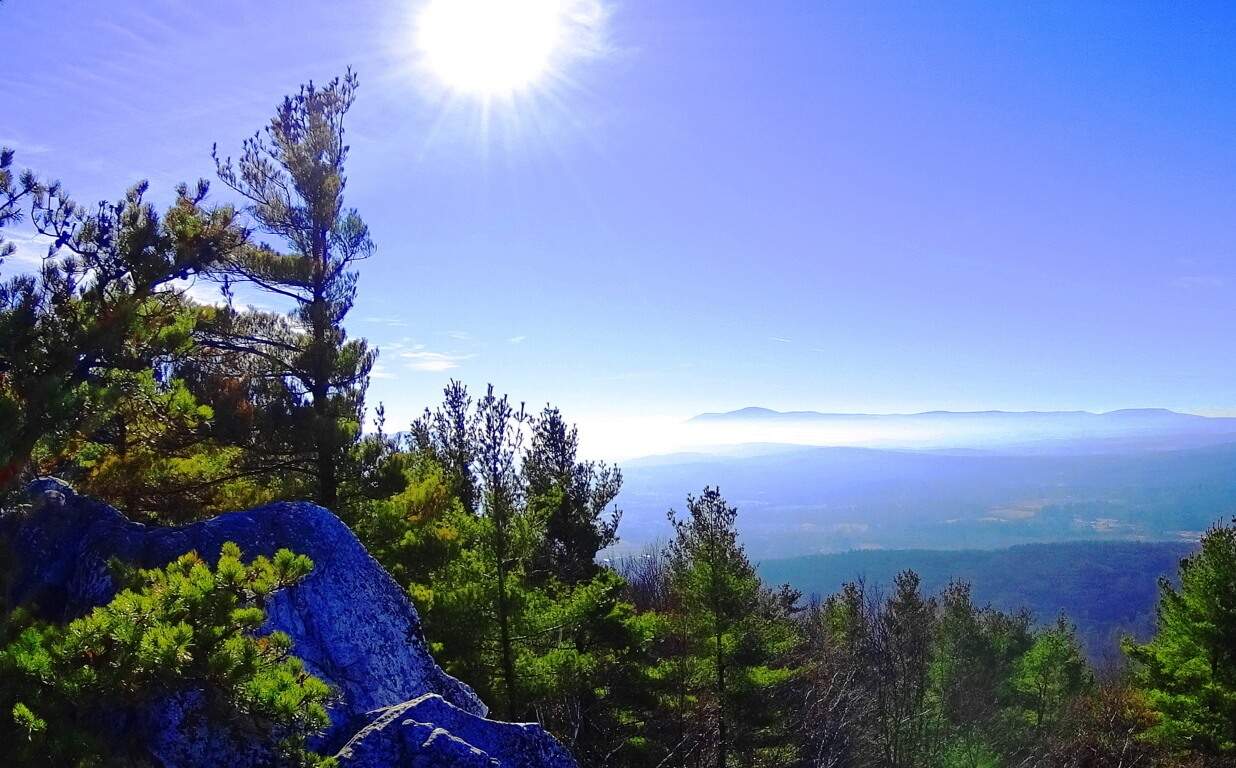 Monument” trails also sponsor some of the more common megalithic features found at places like Mount Monadnock and Mount Watatic. There are classic stone-linings that run straight up the mountain…
Monument” trails also sponsor some of the more common megalithic features found at places like Mount Monadnock and Mount Watatic. There are classic stone-linings that run straight up the mountain…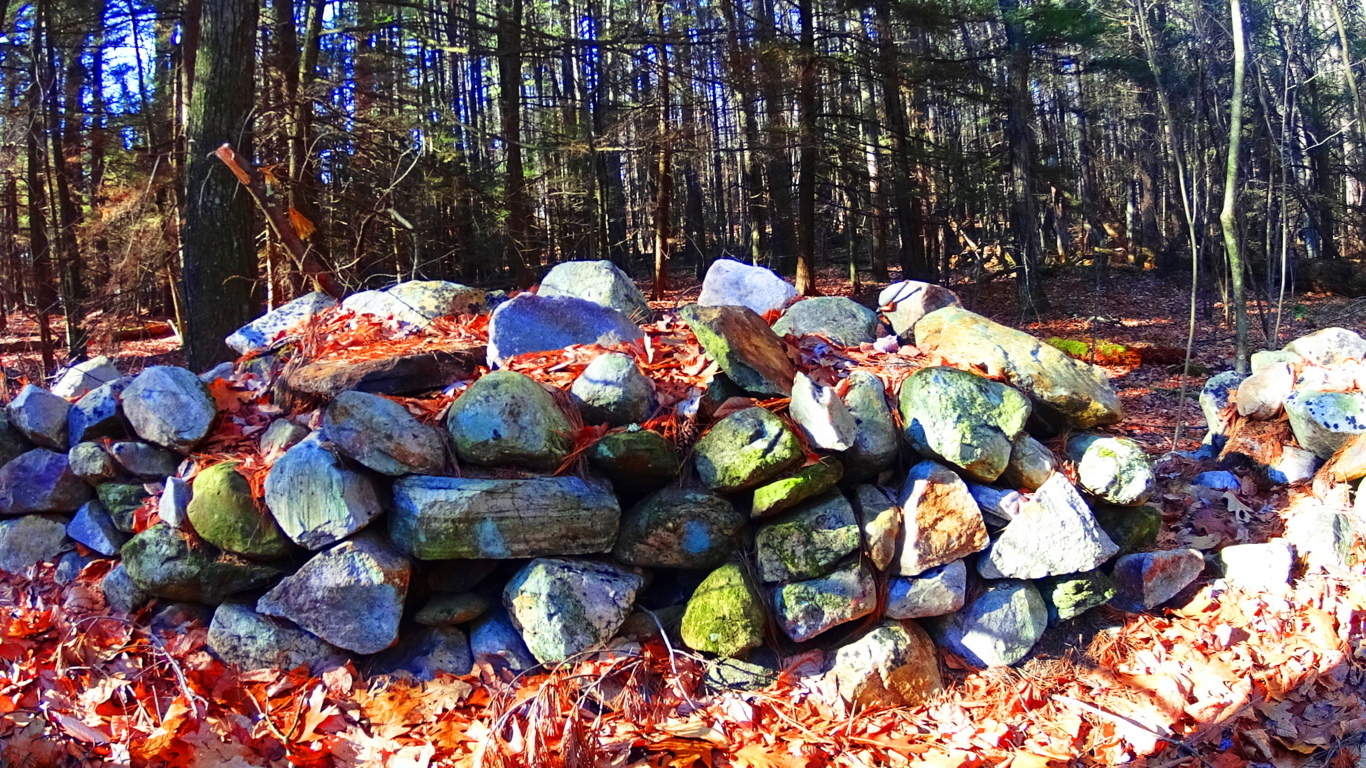 and the mysteriously cut “X” sections, that produces the diamond shape stones that appear all the way into Maine and New Hampshire.
and the mysteriously cut “X” sections, that produces the diamond shape stones that appear all the way into Maine and New Hampshire.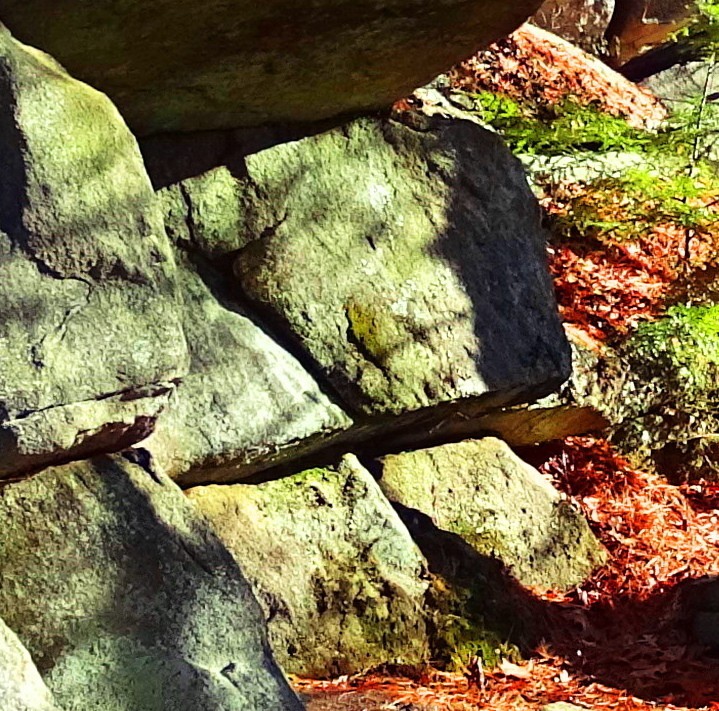 All of these are found here at Mounument”.
All of these are found here at Mounument”.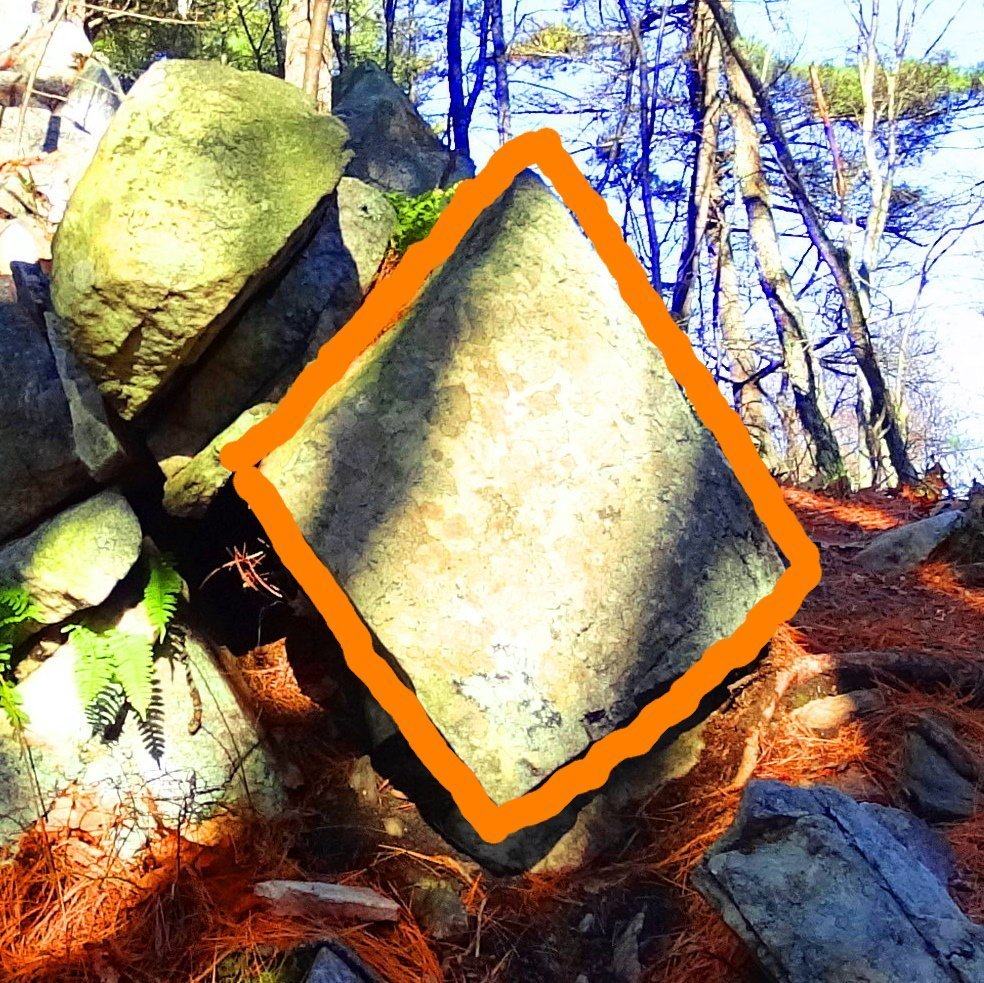 Give yourself an entire day to search out the pathways that lead through this wonderland in south western Massachusetts. Feel the texture and absolute smoothness of the creases in these megaliths as you go. This is an absolutely wonderful hike that stretches for about 4 miles along the larger picturesque loop. Someone loved and appreciated this place in ways we are only just beginning to understand. See it for yourself, the sooner the better.
Give yourself an entire day to search out the pathways that lead through this wonderland in south western Massachusetts. Feel the texture and absolute smoothness of the creases in these megaliths as you go. This is an absolutely wonderful hike that stretches for about 4 miles along the larger picturesque loop. Someone loved and appreciated this place in ways we are only just beginning to understand. See it for yourself, the sooner the better.
Upton Massachusetts/USA
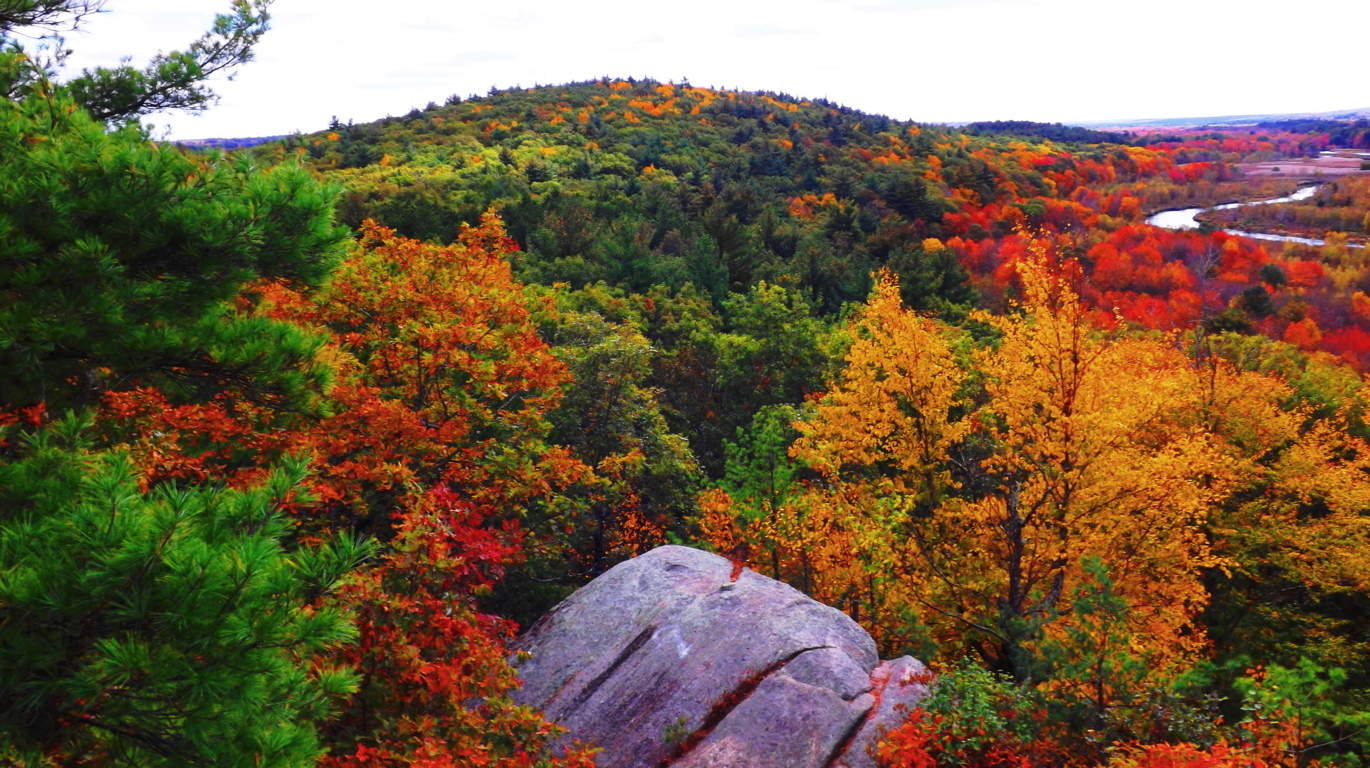 Location: Town of Upton, Massachusetts
Location: Town of Upton, Massachusetts
Note: In Upton Massachusetts The Blackstone Valley sponsors a full-spectrum ocean of foliage in the Autumn season. This is a classic New England hamlet that feels more like a rural village sitting just off the Ring of Kerry, rather than central Massachusetts.
This is a classic New England hamlet that feels more like a rural village sitting just off the Ring of Kerry, rather than central Massachusetts. 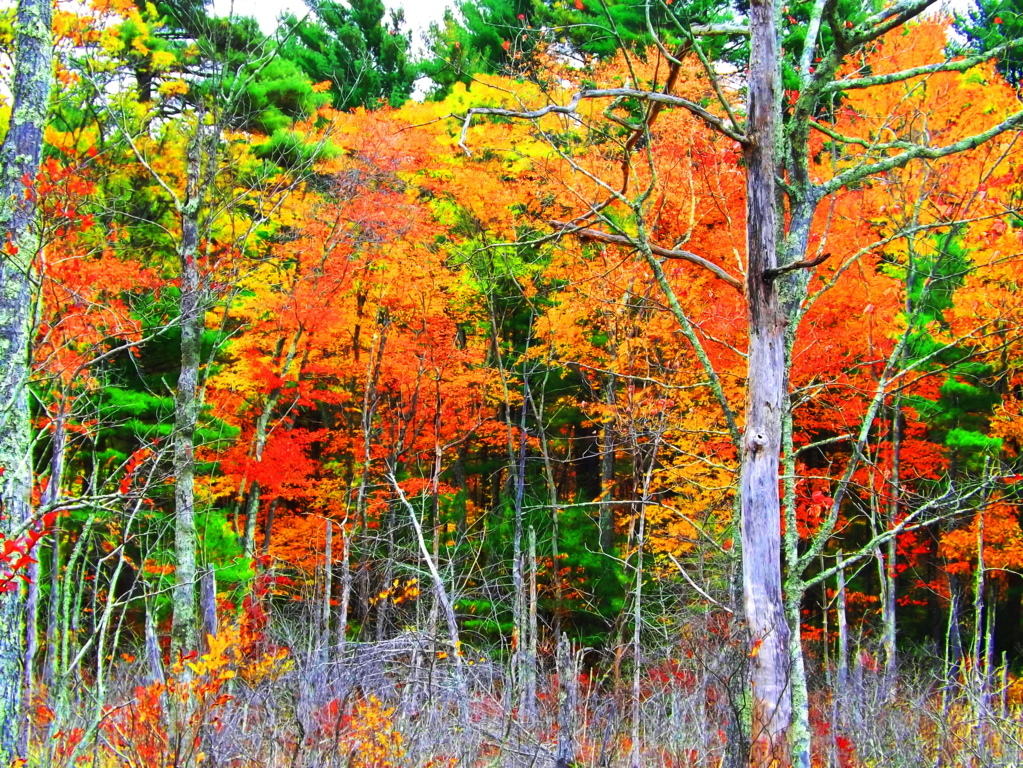 Natural features of the town include a State Forest with roughly 7 miles of trails, with other minor trails leading to stellar places like Look Out Rock (top image). Upton offers-up an “Old World” aesthetic with some very real historical substance, containing one of the finest Wedge Tomb’s in the world, known as the Upton Stone Chamber (image below).
Natural features of the town include a State Forest with roughly 7 miles of trails, with other minor trails leading to stellar places like Look Out Rock (top image). Upton offers-up an “Old World” aesthetic with some very real historical substance, containing one of the finest Wedge Tomb’s in the world, known as the Upton Stone Chamber (image below).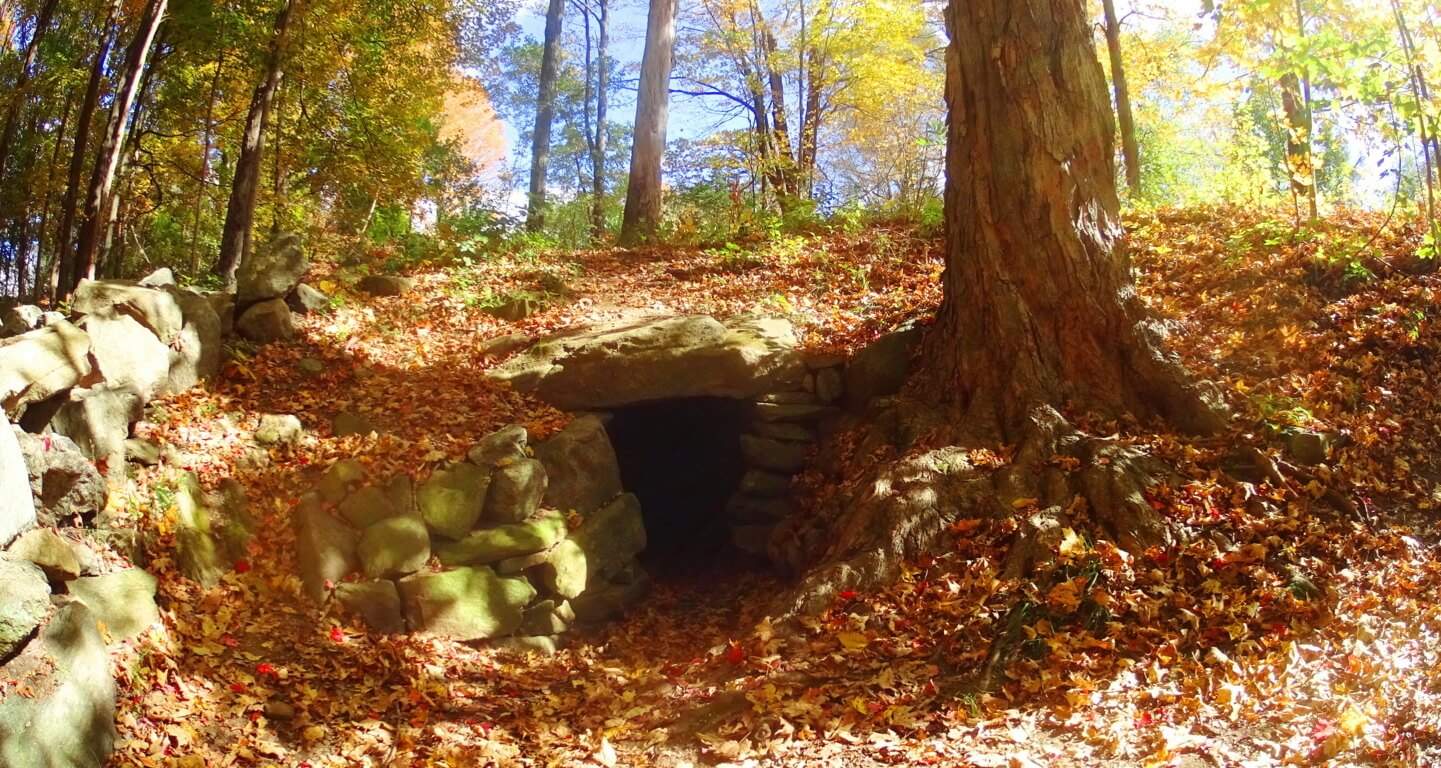 The scale of the Upton Stone Chamber is very similar to the Stone Chamber at the top of the sacred Hill of Tara in Ireland.
The scale of the Upton Stone Chamber is very similar to the Stone Chamber at the top of the sacred Hill of Tara in Ireland.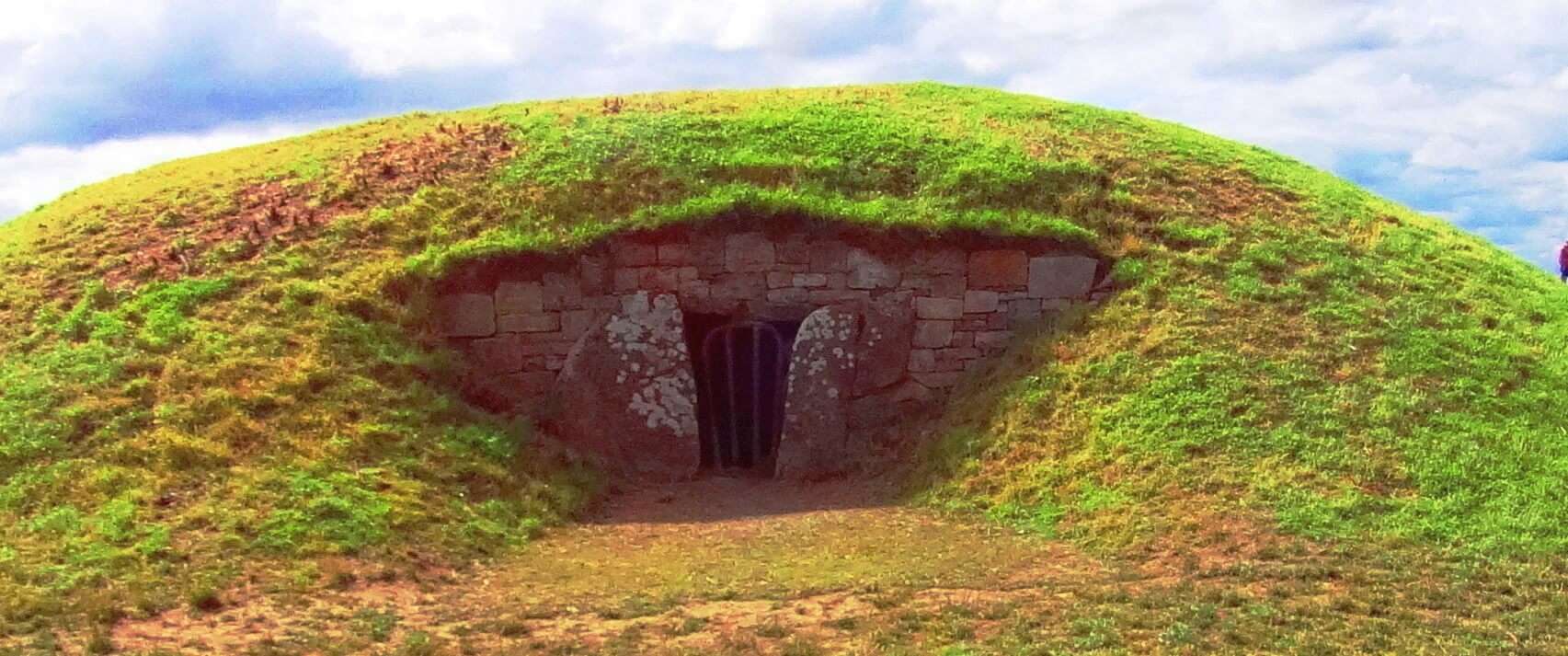 The stonework of the Upton Chamber is exquisite, with dry-laid corbel roofing that opens up from an entry passage into a 15foot dome, crafted into the Earth! The roof has four 5 ton slabs holding up the passage leading to the mini-dome.
The stonework of the Upton Chamber is exquisite, with dry-laid corbel roofing that opens up from an entry passage into a 15foot dome, crafted into the Earth! The roof has four 5 ton slabs holding up the passage leading to the mini-dome.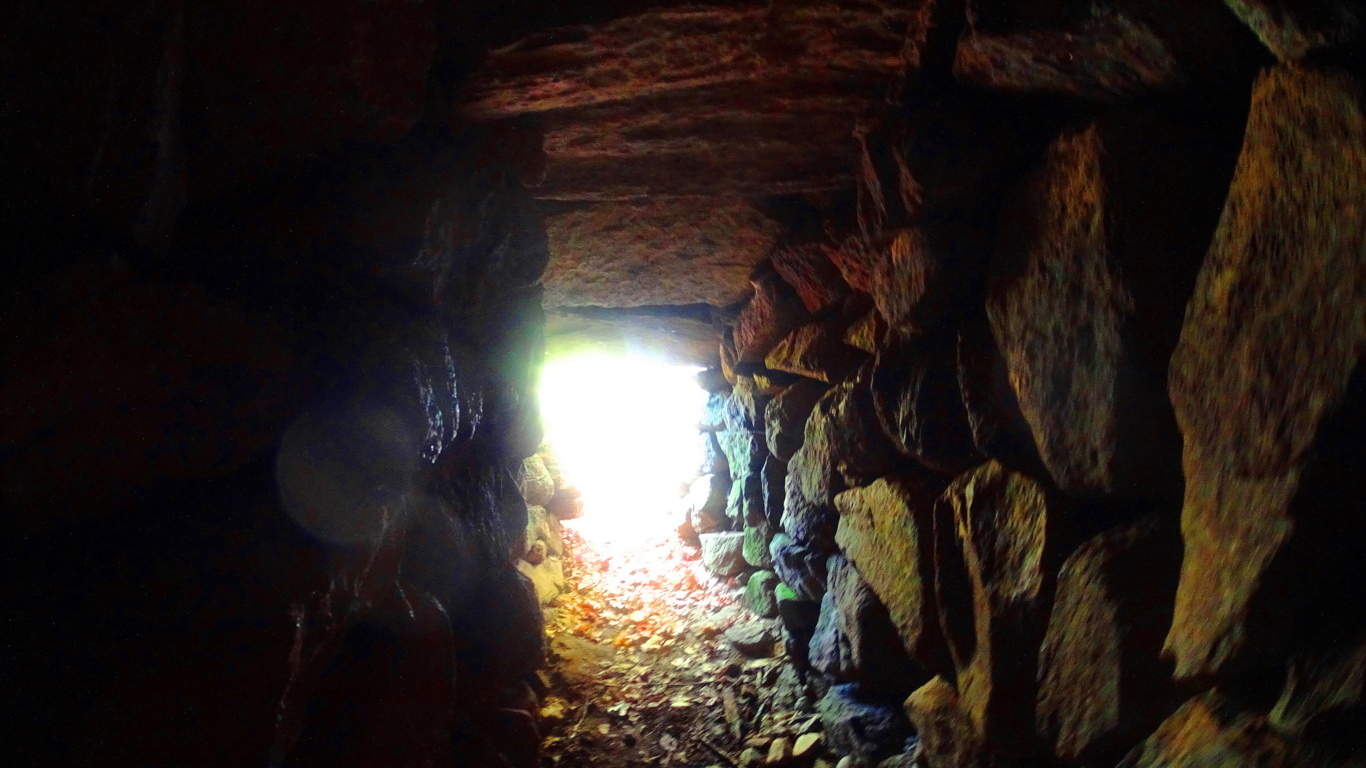 This is of the same style of roofing that was used, on a more massive scale, at New Grange, Ireland, the oldest megalithic site in the World (right image).
This is of the same style of roofing that was used, on a more massive scale, at New Grange, Ireland, the oldest megalithic site in the World (right image).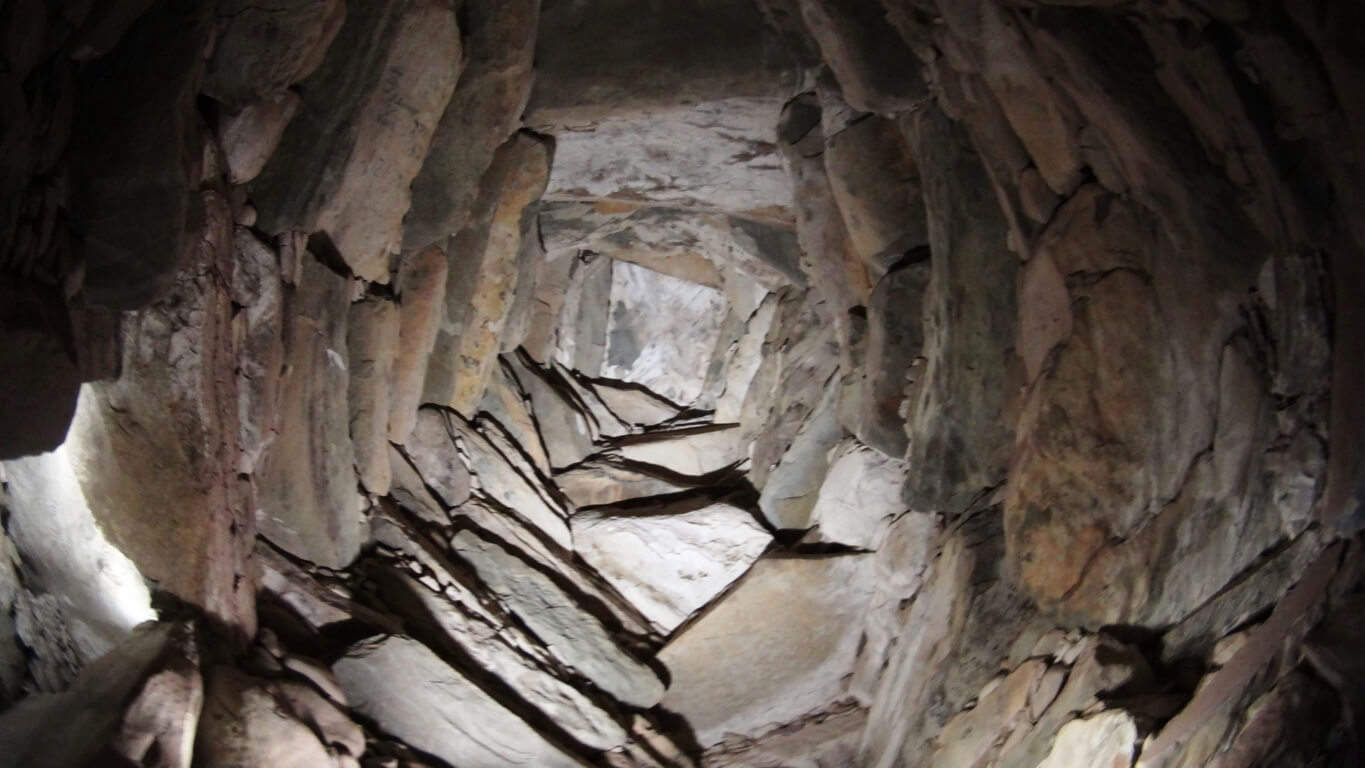 When I entered the Upton Chamber and turned to take pictures, orbs started floating around.(left image) (Click it to look closer). There is energy in these chambers. In general, these are some pretty strong stylistic connections to some very significant places, for just a simple small town in New England.
When I entered the Upton Chamber and turned to take pictures, orbs started floating around.(left image) (Click it to look closer). There is energy in these chambers. In general, these are some pretty strong stylistic connections to some very significant places, for just a simple small town in New England. 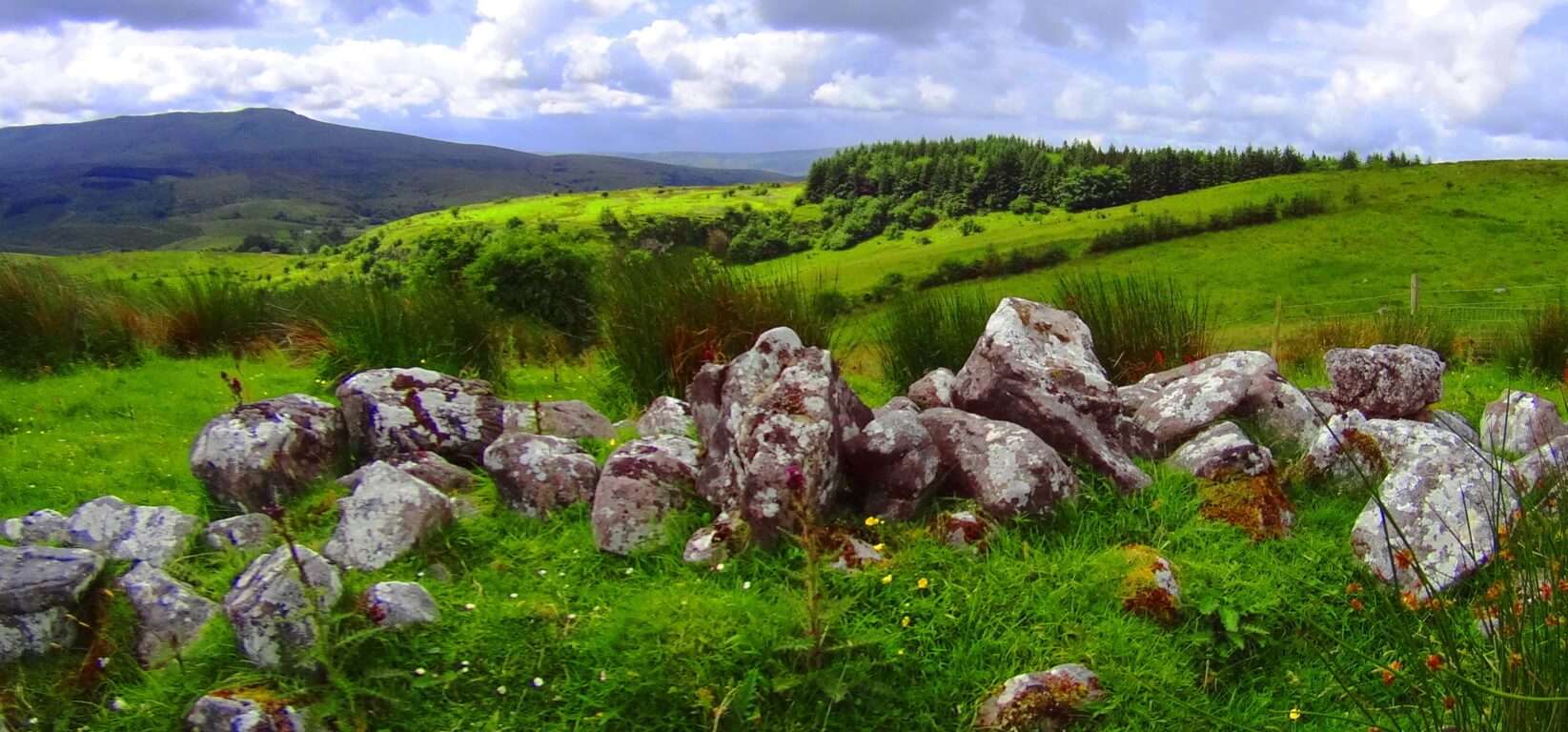 Just like in Glenveagh National Park, Ireland (left image), Upton has unique and complex megalithic stones that are beautifully mingled into various features of the landscape, with stone-linings that are much larger than Celtic linings (2nd and 3rd/left images/Upton).
Just like in Glenveagh National Park, Ireland (left image), Upton has unique and complex megalithic stones that are beautifully mingled into various features of the landscape, with stone-linings that are much larger than Celtic linings (2nd and 3rd/left images/Upton).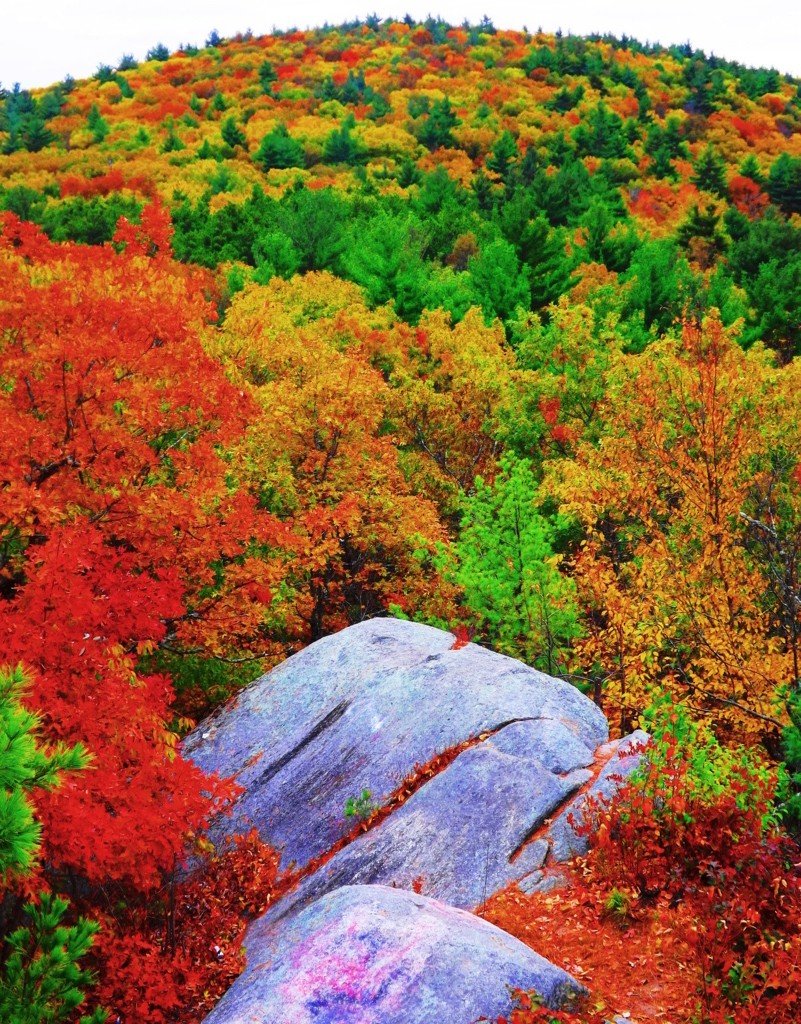 Massive granite boulders are stacked near peaks in the area, and all throughout the elevated trails. Some boulders, however hard it is to believe, seem to have been molded to imitate, and align, to the center of significant peaks in the distance.
Massive granite boulders are stacked near peaks in the area, and all throughout the elevated trails. Some boulders, however hard it is to believe, seem to have been molded to imitate, and align, to the center of significant peaks in the distance.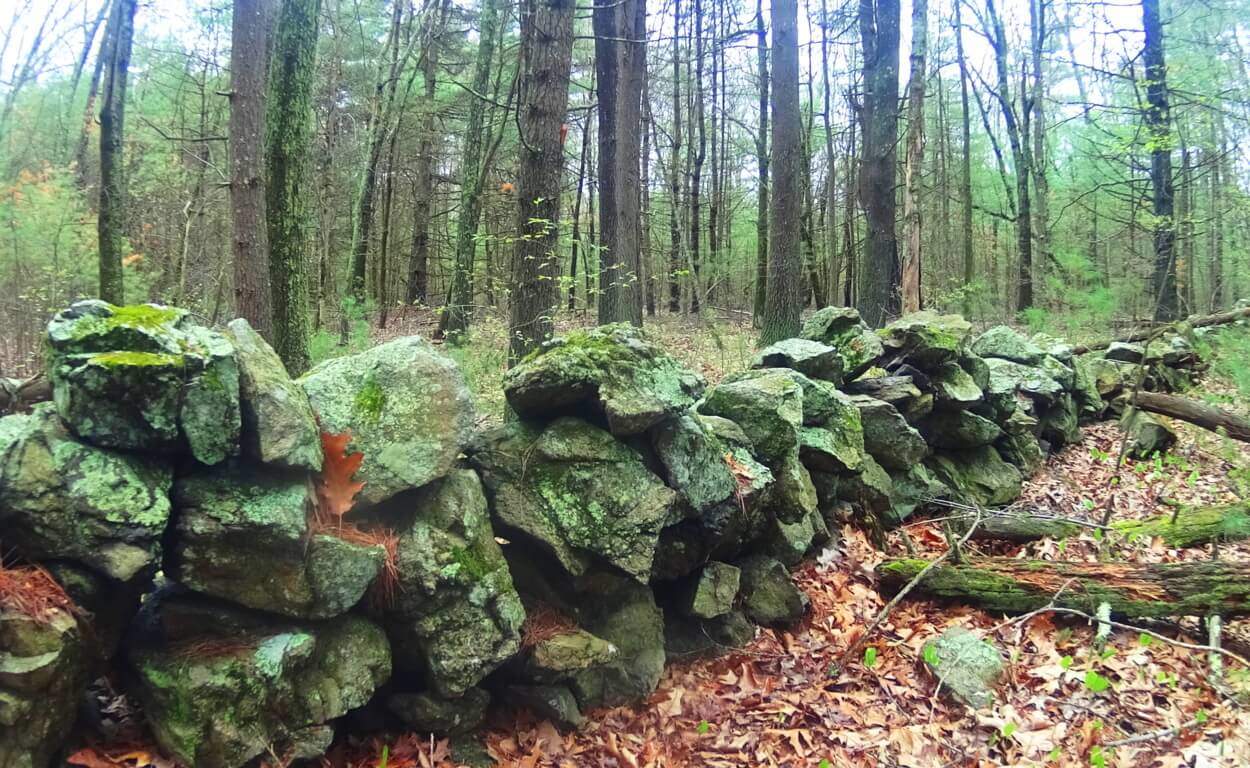 Look Out Rock is an amazing example this, with three parallel grooves carved into its face, seemingly calling attention to the boulder. It points, like an arrow, directly to the top-center of the mountain in the foreground, creating a kind of prismatic display (right image).
Look Out Rock is an amazing example this, with three parallel grooves carved into its face, seemingly calling attention to the boulder. It points, like an arrow, directly to the top-center of the mountain in the foreground, creating a kind of prismatic display (right image).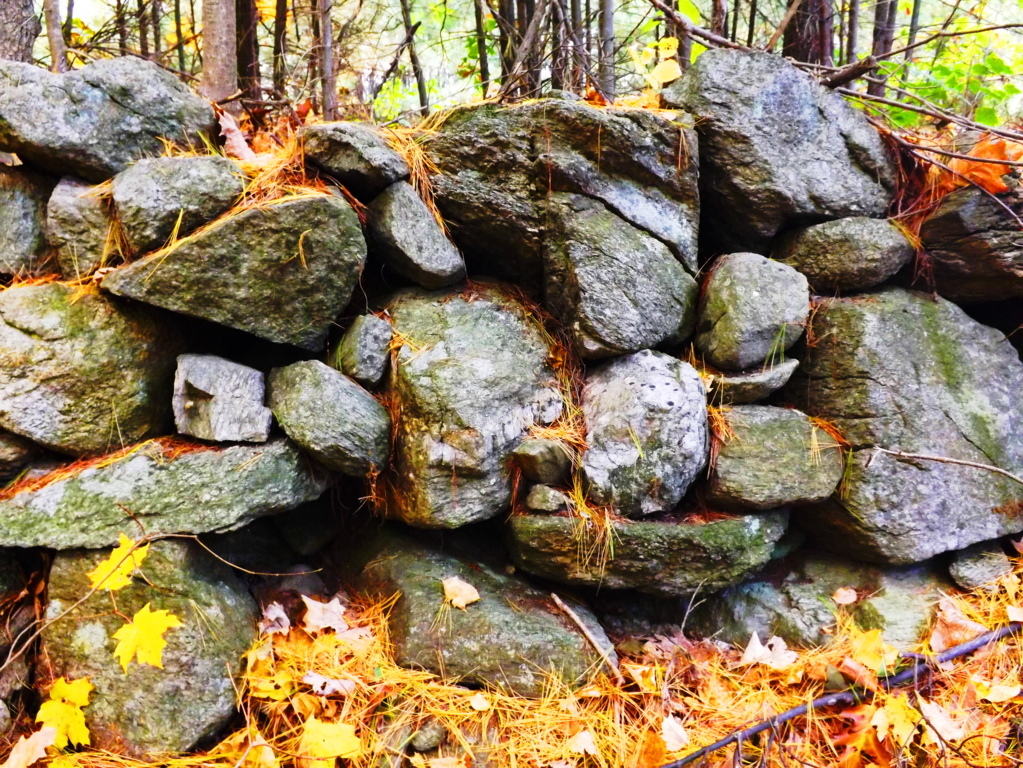 From an anthropological standpoint this is significant information, indicating that this culture was clearly “symmetry conscious”, and not only that, but symmetry capable. They could make it happen. Scope and scale of megalithic work by a culture that is capable of these statements should be reconsidered entirely to understand what is actually taking place. The neolithic culture in Upton, and all over New England, could craft granite boulders like a modern carpenter crafts wood. Forest floors in Ireland and New England look to be made up entirely of granite scraps that are cut from the larger boulders, eventually placed as statements further up the various mountains. This is the reason we find so many stones on elevated trails that have obvious cuts, right angles, and squares. The Blue Hills in Massachusetts (below left), and Mount Bearnagh in Ireland (below right), are prime examples of this. The trails in these sacred places are lined with the scraps of “megalithic carpentry”. If we were to look at the angles of the scraps on the floor of a carpenters cutting-table, the pieces, on their own, are a disheveled mess which doesn’t make any orderly sense, but the significance of each little piece is that they stem from the cutting of a ‘larger block’ on the table.
From an anthropological standpoint this is significant information, indicating that this culture was clearly “symmetry conscious”, and not only that, but symmetry capable. They could make it happen. Scope and scale of megalithic work by a culture that is capable of these statements should be reconsidered entirely to understand what is actually taking place. The neolithic culture in Upton, and all over New England, could craft granite boulders like a modern carpenter crafts wood. Forest floors in Ireland and New England look to be made up entirely of granite scraps that are cut from the larger boulders, eventually placed as statements further up the various mountains. This is the reason we find so many stones on elevated trails that have obvious cuts, right angles, and squares. The Blue Hills in Massachusetts (below left), and Mount Bearnagh in Ireland (below right), are prime examples of this. The trails in these sacred places are lined with the scraps of “megalithic carpentry”. If we were to look at the angles of the scraps on the floor of a carpenters cutting-table, the pieces, on their own, are a disheveled mess which doesn’t make any orderly sense, but the significance of each little piece is that they stem from the cutting of a ‘larger block’ on the table.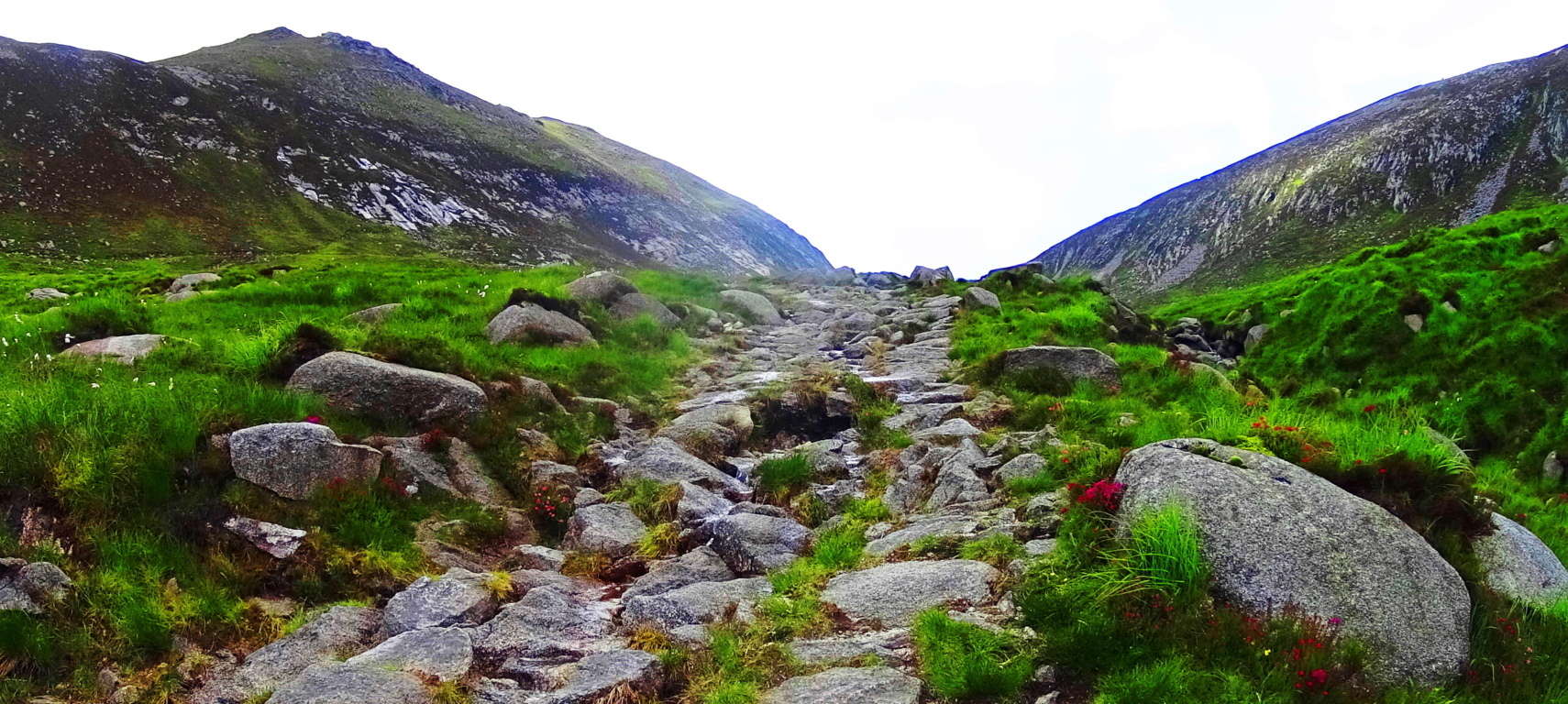
 The angled granite scraps are the overall proof that craftsmanship took place. Entire trails are lined with scraps of angular granite cuts throughout Ireland, Wales, England, and New England. Returning to Upton, a New-England style Dolmen sits just thirty yards from the peak at Look Out Rock. This is also a trait of sacred neolithic places. Wedge Tombs and Dolmens are often just out of view from the most advantageous spots of their specific site, very much like hikers and campers keep a tent out of the wind fairly close to the beautiful spots they want to photograph and camp near.
The angled granite scraps are the overall proof that craftsmanship took place. Entire trails are lined with scraps of angular granite cuts throughout Ireland, Wales, England, and New England. Returning to Upton, a New-England style Dolmen sits just thirty yards from the peak at Look Out Rock. This is also a trait of sacred neolithic places. Wedge Tombs and Dolmens are often just out of view from the most advantageous spots of their specific site, very much like hikers and campers keep a tent out of the wind fairly close to the beautiful spots they want to photograph and camp near.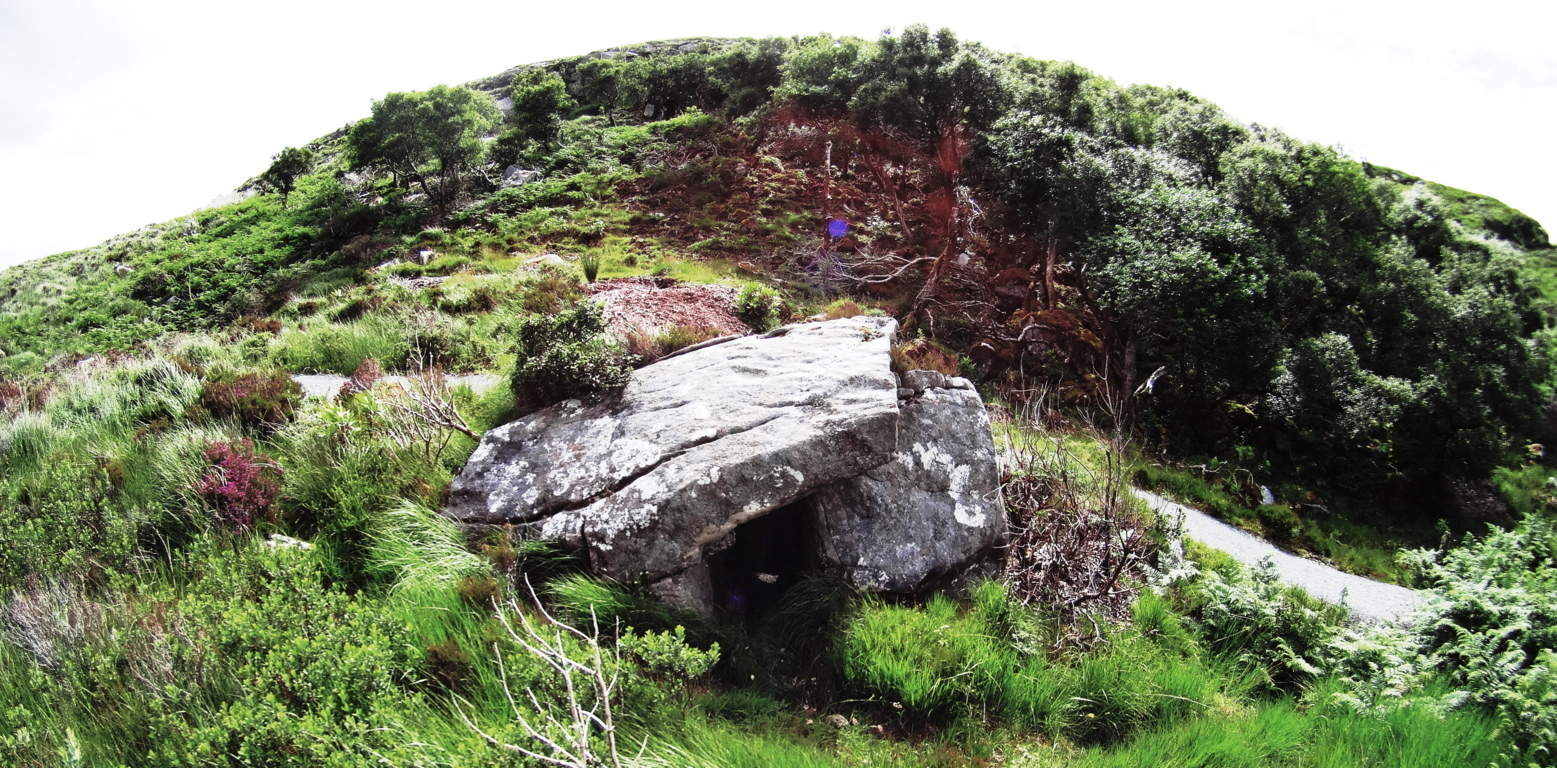 The Wedge Tomb in the heights of Glenveagh Forest, just like Look Out Rock, is centrally aligned to the mountain in front of it, with a Dolmen tucked just 30 yards from the best vantage in Glenveagh National Park. (image on right/Glenveagh Wedge Tomb). Something’s going on here. The boulders on this unique Dolmen (Image below) are cut utilizing massive and graceful lines, with long square boulders fit into each other, balancing perfectly into what looks like a primitive pyramid. The Stones are obviously cut. This Dolmen utilizes a ‘scale-scheme’ with the larger lower boulders, leading up to the smaller capstone at the top (image left).
The Wedge Tomb in the heights of Glenveagh Forest, just like Look Out Rock, is centrally aligned to the mountain in front of it, with a Dolmen tucked just 30 yards from the best vantage in Glenveagh National Park. (image on right/Glenveagh Wedge Tomb). Something’s going on here. The boulders on this unique Dolmen (Image below) are cut utilizing massive and graceful lines, with long square boulders fit into each other, balancing perfectly into what looks like a primitive pyramid. The Stones are obviously cut. This Dolmen utilizes a ‘scale-scheme’ with the larger lower boulders, leading up to the smaller capstone at the top (image left).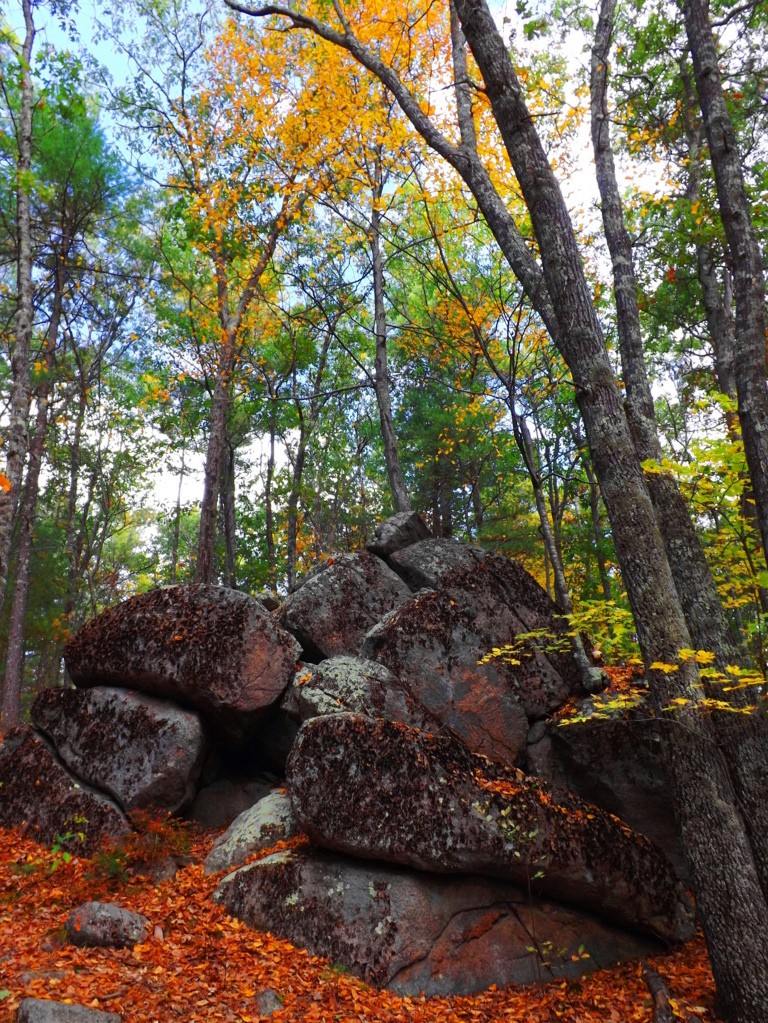 It is an incredibly thoughtful looking structure. In scale (not style) it is very much like the massive Proleek Dolmen in Ireland, which also shows nearly miraculous scale, and balance.
It is an incredibly thoughtful looking structure. In scale (not style) it is very much like the massive Proleek Dolmen in Ireland, which also shows nearly miraculous scale, and balance.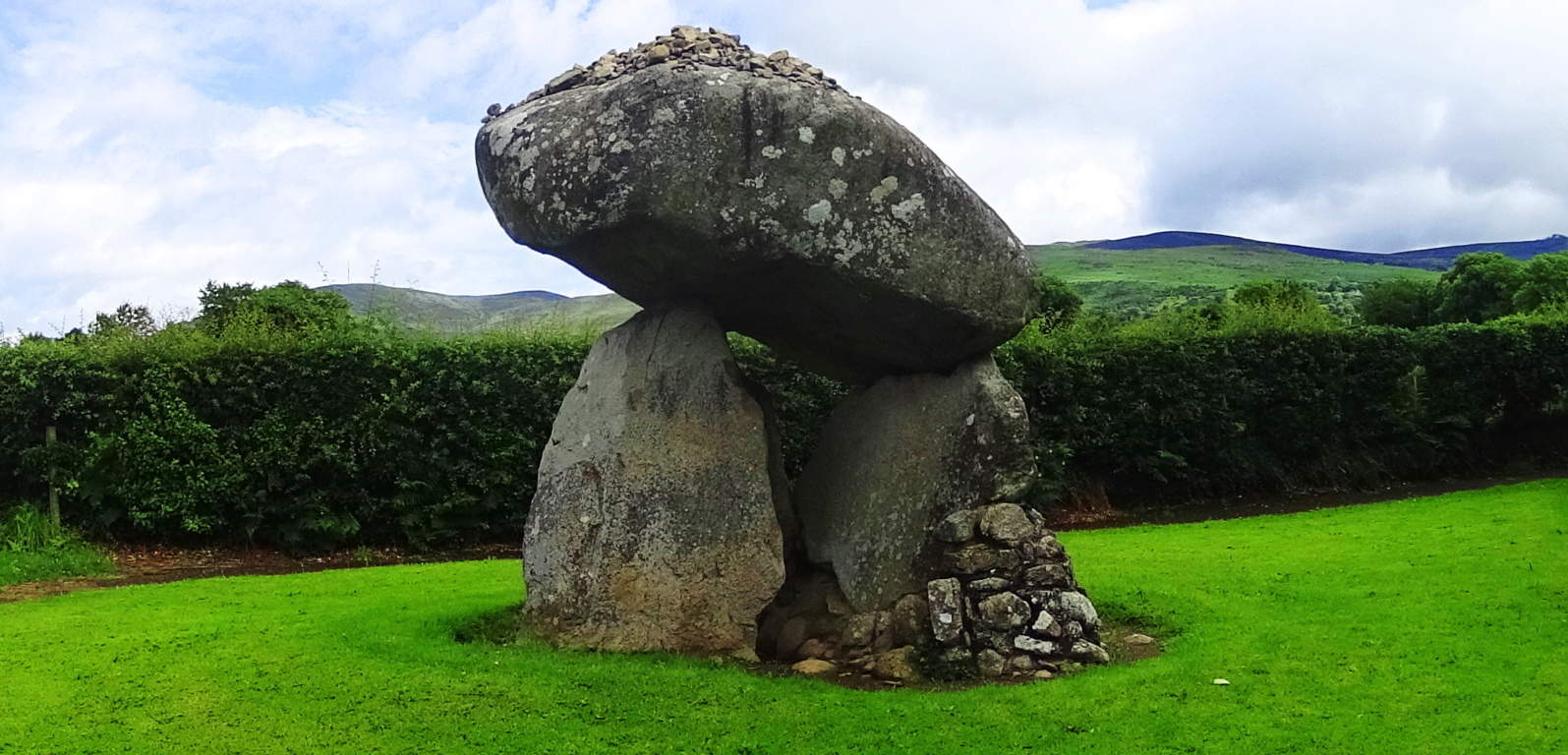 (right image). Interwoven into the old colonial town of Upton, there are ledges with massive megalithic fixtures, huge quartz streaks and balanced boulders. The geological explanation for these features just doesn’t make sense. Scientists usually impose some theory of how glacial ice exploded, or slid, in a certain way to make events like this happen, but it just doesn’t hold up logically. Take a look at these massive quartz parallel shafts, with a free sitting boulder cut and inserted into the underside of the ledge. The boulders may have been cut with the intention of having the quartz grow into the parallel gaps, which reveals an amazing comprehension of how quartz responds to granite in certain positions and places. I wouldn’t put this capability past the megalith builders. It seems that they had total understanding of how to use the landscape, and had the power to mold it as they saw fit. Conceptually, it breaks our reality wide open.
(right image). Interwoven into the old colonial town of Upton, there are ledges with massive megalithic fixtures, huge quartz streaks and balanced boulders. The geological explanation for these features just doesn’t make sense. Scientists usually impose some theory of how glacial ice exploded, or slid, in a certain way to make events like this happen, but it just doesn’t hold up logically. Take a look at these massive quartz parallel shafts, with a free sitting boulder cut and inserted into the underside of the ledge. The boulders may have been cut with the intention of having the quartz grow into the parallel gaps, which reveals an amazing comprehension of how quartz responds to granite in certain positions and places. I wouldn’t put this capability past the megalith builders. It seems that they had total understanding of how to use the landscape, and had the power to mold it as they saw fit. Conceptually, it breaks our reality wide open. 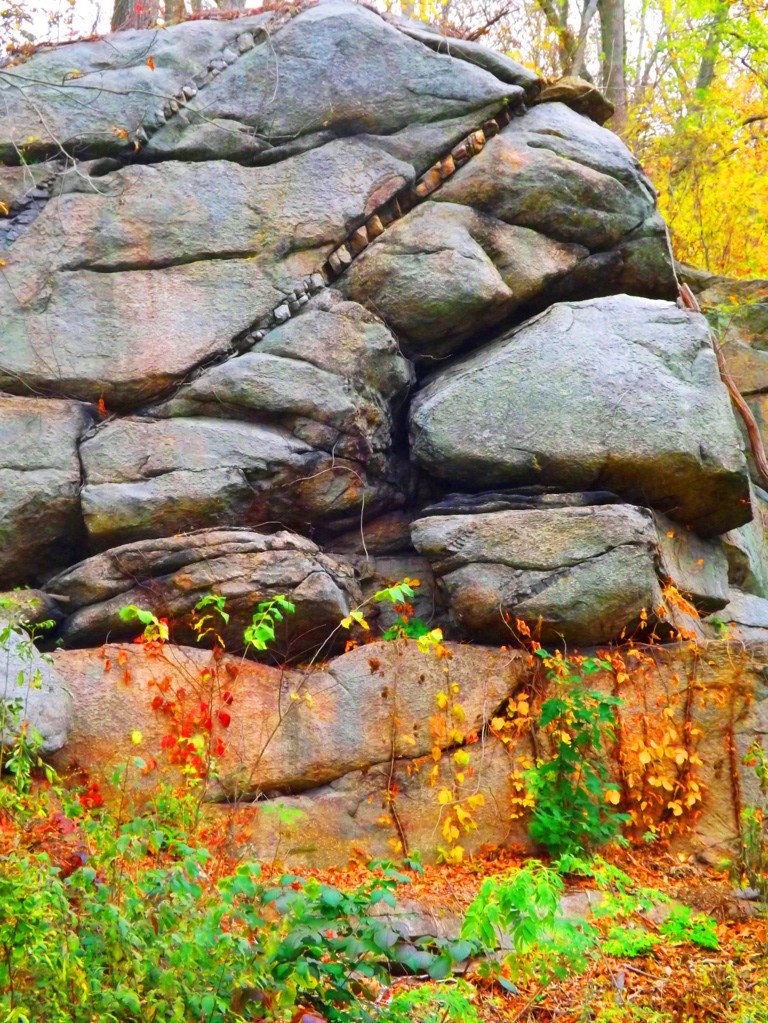 There are stone-linings so massive in Upton, that they look like they were intended to be walked on
There are stone-linings so massive in Upton, that they look like they were intended to be walked on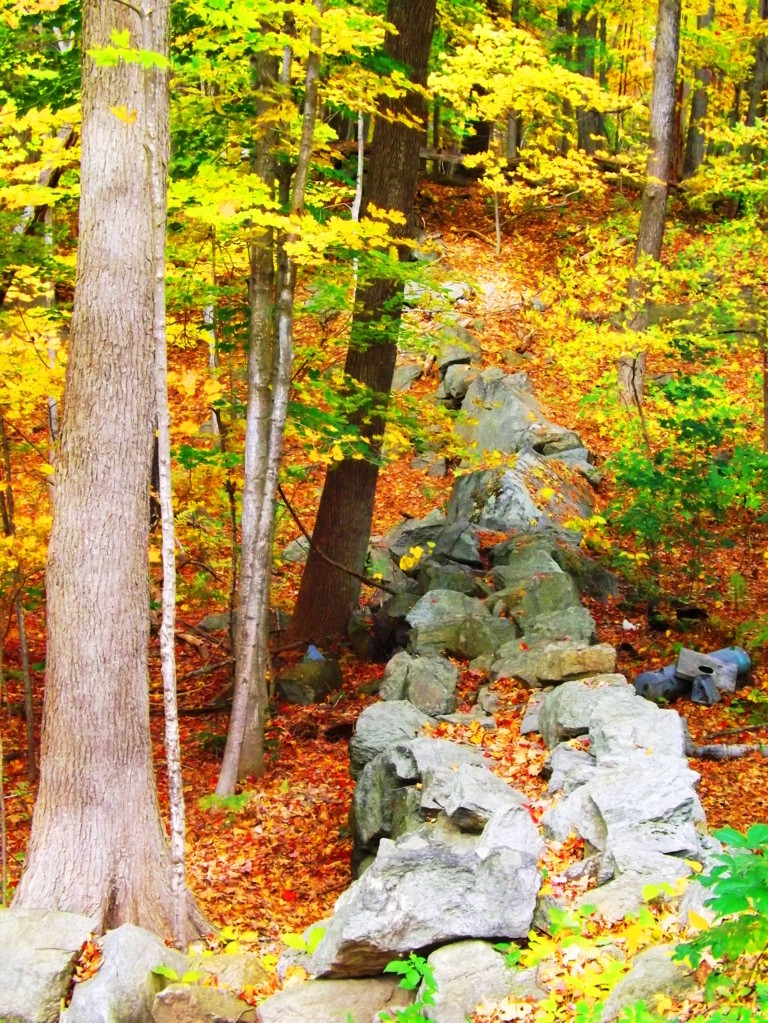 (image left below). Stone-linings literally converge on a Wedge Tomb at Glenveagh National Park from three directions (bottom image) (Click to look closer). These are all indicators that these stones were being used as energy harnesses, connecting features in the landscape, transferring energy from the Sun, to the stones, into the chambers. The entire town of Upton is sitting on a geologically engineered landscape. Take the trails through Upton Forest in October for a ‘fantastic full spectrum’ experience, and hike up to Look Out Rock to see for yourself the aligned ledges and Dolmen. This is truly a sacred and enchanted place in the heart of New England, comparable to any Celtic site. Seek it out.
(image left below). Stone-linings literally converge on a Wedge Tomb at Glenveagh National Park from three directions (bottom image) (Click to look closer). These are all indicators that these stones were being used as energy harnesses, connecting features in the landscape, transferring energy from the Sun, to the stones, into the chambers. The entire town of Upton is sitting on a geologically engineered landscape. Take the trails through Upton Forest in October for a ‘fantastic full spectrum’ experience, and hike up to Look Out Rock to see for yourself the aligned ledges and Dolmen. This is truly a sacred and enchanted place in the heart of New England, comparable to any Celtic site. Seek it out.
Tintagel
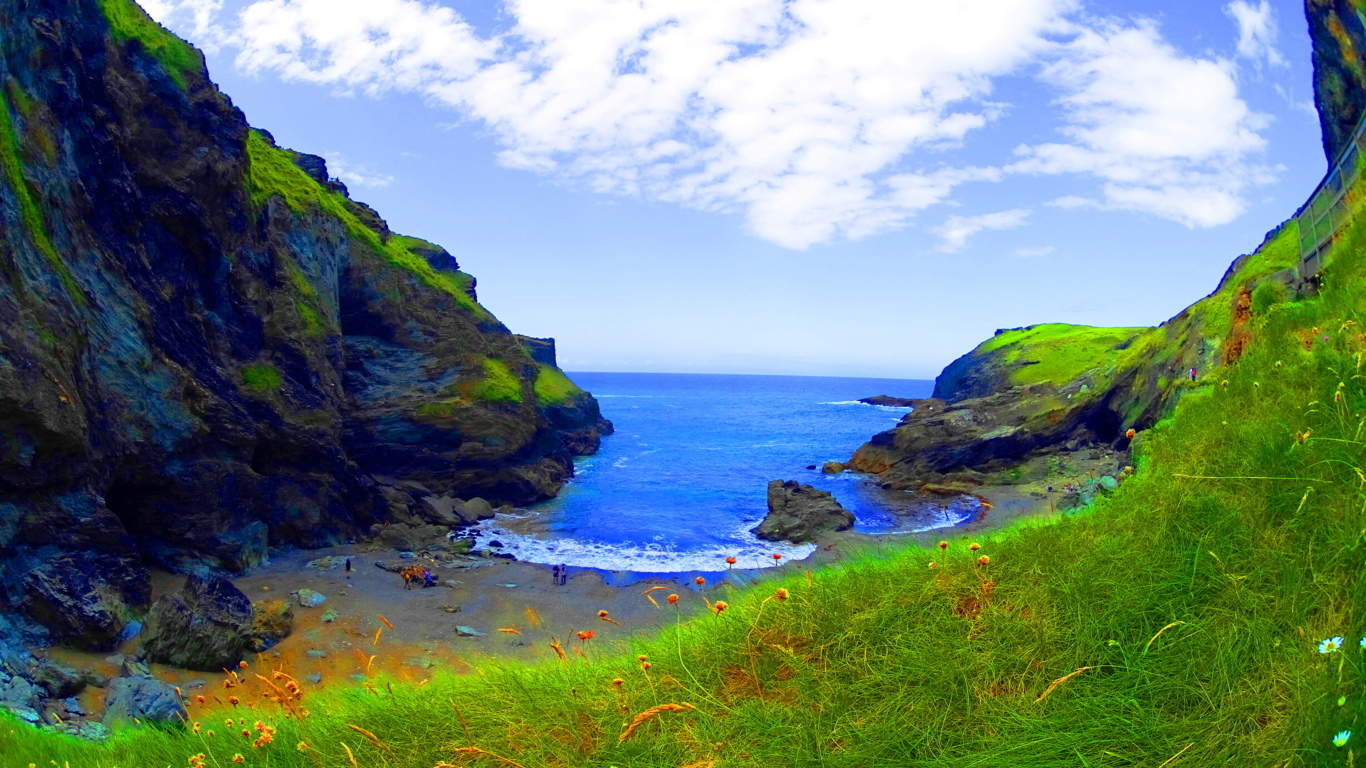 Location: Cornwall Coast, England
Location: Cornwall Coast, England
Note: There are trails that can take you to Standing-Stones sitting on the tops of distant valleys in places like Wales Scotland, and Ireland. There are Dolmens and Wedge Tombs in secret hedges along river paths, hard to find, on misty rocky plateaus in regions where roads have no names. Eventually pathfinders need to make their way back from the heights to tell the tale of where they’ve been, preferably to some simple comforts, good food, warm fire, and some cheer. This is Tintagel. The countryside before reaching Tintagel is timeless, with rolling fields contrasted by the sea, and horses grazing on the heights.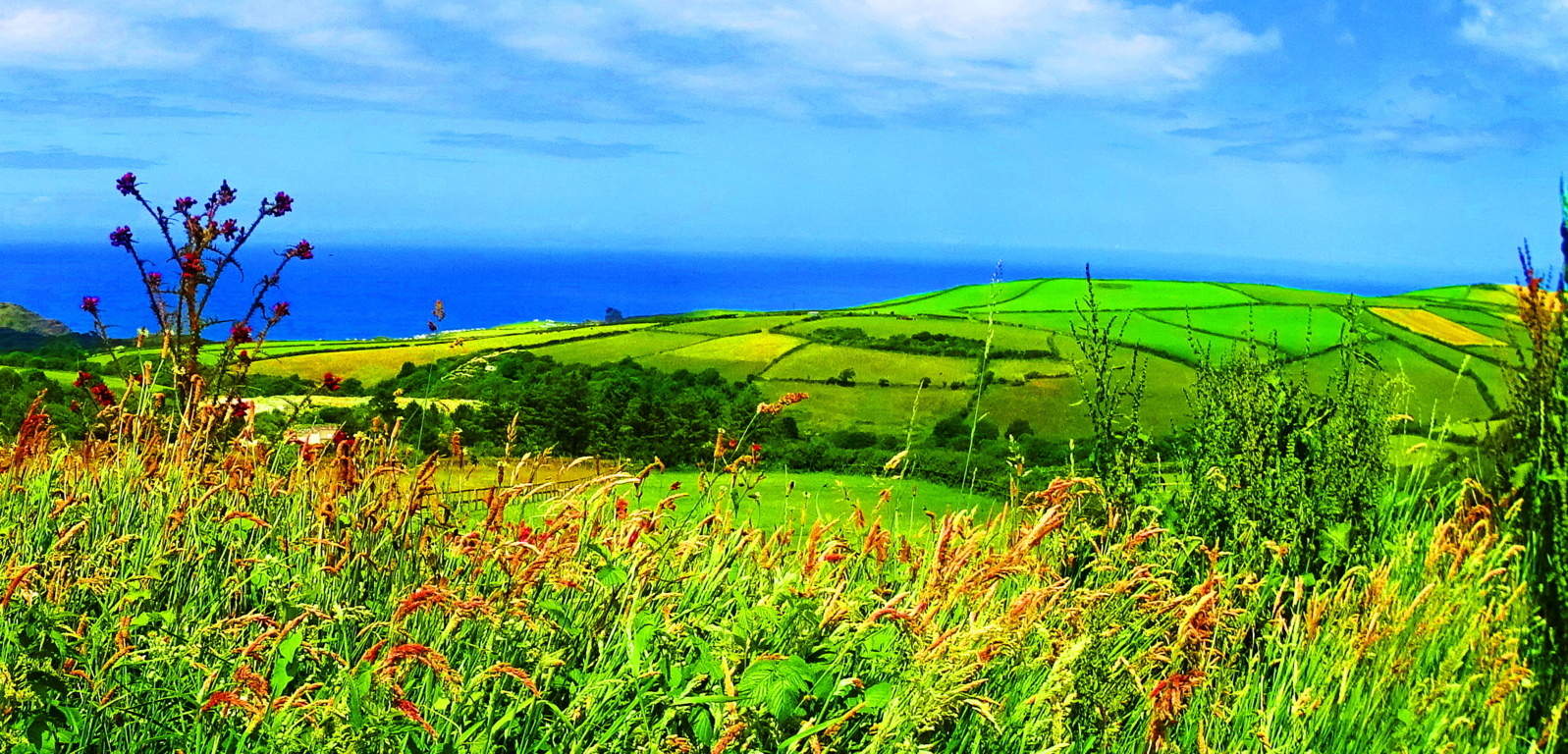 Tintagel is the epitome of the magical safe-haven travelers hope for, complete with an ancient Celtic castle built on a small but lofty island that looms along a 300 ft cliff reaching down to a sandy beach-bay, embraced by rocky cliffs, caves, and waterfalls. Seldom do hiking trails include so many major features in one place.
Tintagel is the epitome of the magical safe-haven travelers hope for, complete with an ancient Celtic castle built on a small but lofty island that looms along a 300 ft cliff reaching down to a sandy beach-bay, embraced by rocky cliffs, caves, and waterfalls. Seldom do hiking trails include so many major features in one place.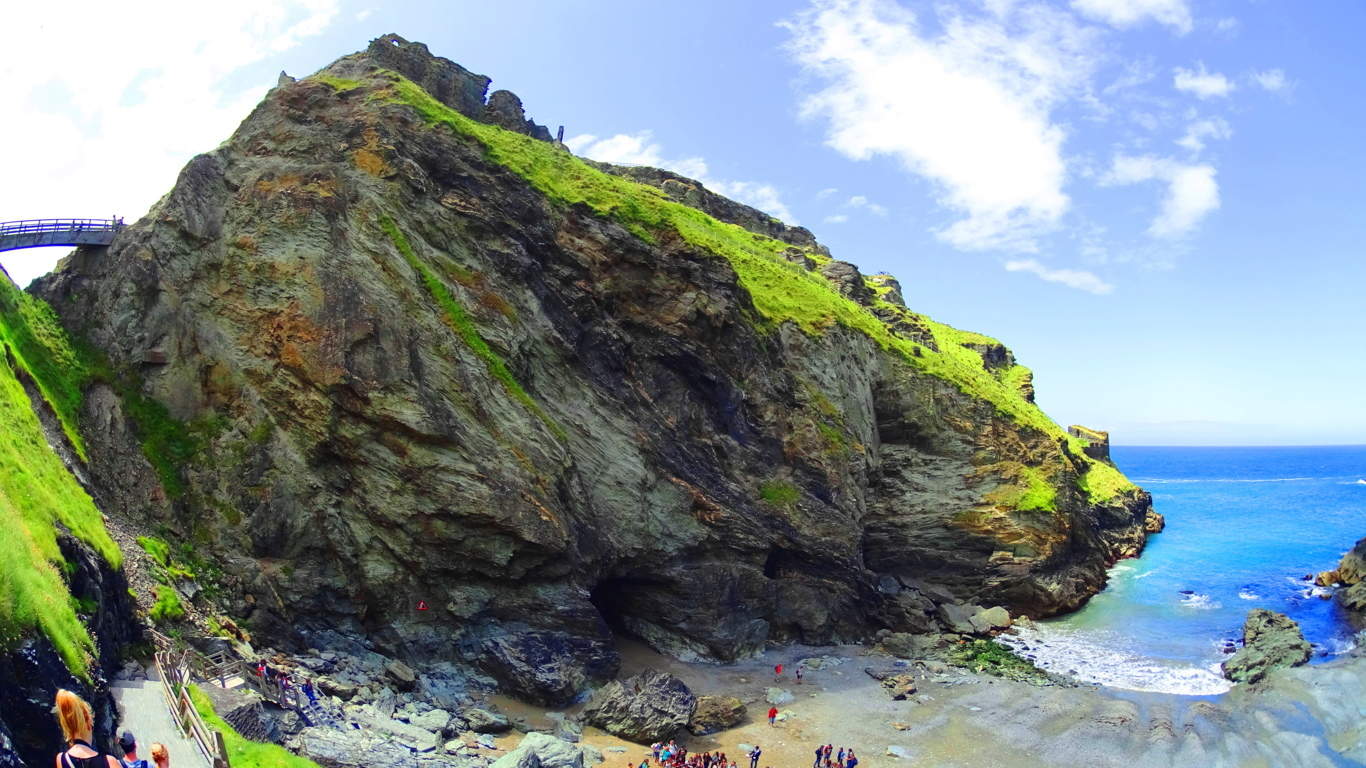 The trail for Tintagel Castle actually begins a mile before reaching the coastal scene, back in the center of the medieval town of Tintagel, which is now a beautiful bustling modern hamlet with every manor of comfort to offer. The trail literally begins from the main road in the center of town, extending down to a flowing freshwater stream with a path that leads straight to the Castle/Bay. Pass through a hilly cascade of tall grass and stony ledges that leads down to the coastal scene and gate.
The trail for Tintagel Castle actually begins a mile before reaching the coastal scene, back in the center of the medieval town of Tintagel, which is now a beautiful bustling modern hamlet with every manor of comfort to offer. The trail literally begins from the main road in the center of town, extending down to a flowing freshwater stream with a path that leads straight to the Castle/Bay. Pass through a hilly cascade of tall grass and stony ledges that leads down to the coastal scene and gate. There is a small fee to pass the modern gate, where you are then free to make a choice of walking the elevated wood-board trail that leads over a high bridge onto the island, on which the ruins of Tintagel Castle sits, or down a winding sandy loop to the beautiful beach, megaliths, and massive rock caverns. A portion of the main gate of the castle still stands today. This is is the original Celtic entrance-way to the paths leading to the inner grounds, and around the Island.
There is a small fee to pass the modern gate, where you are then free to make a choice of walking the elevated wood-board trail that leads over a high bridge onto the island, on which the ruins of Tintagel Castle sits, or down a winding sandy loop to the beautiful beach, megaliths, and massive rock caverns. A portion of the main gate of the castle still stands today. This is is the original Celtic entrance-way to the paths leading to the inner grounds, and around the Island.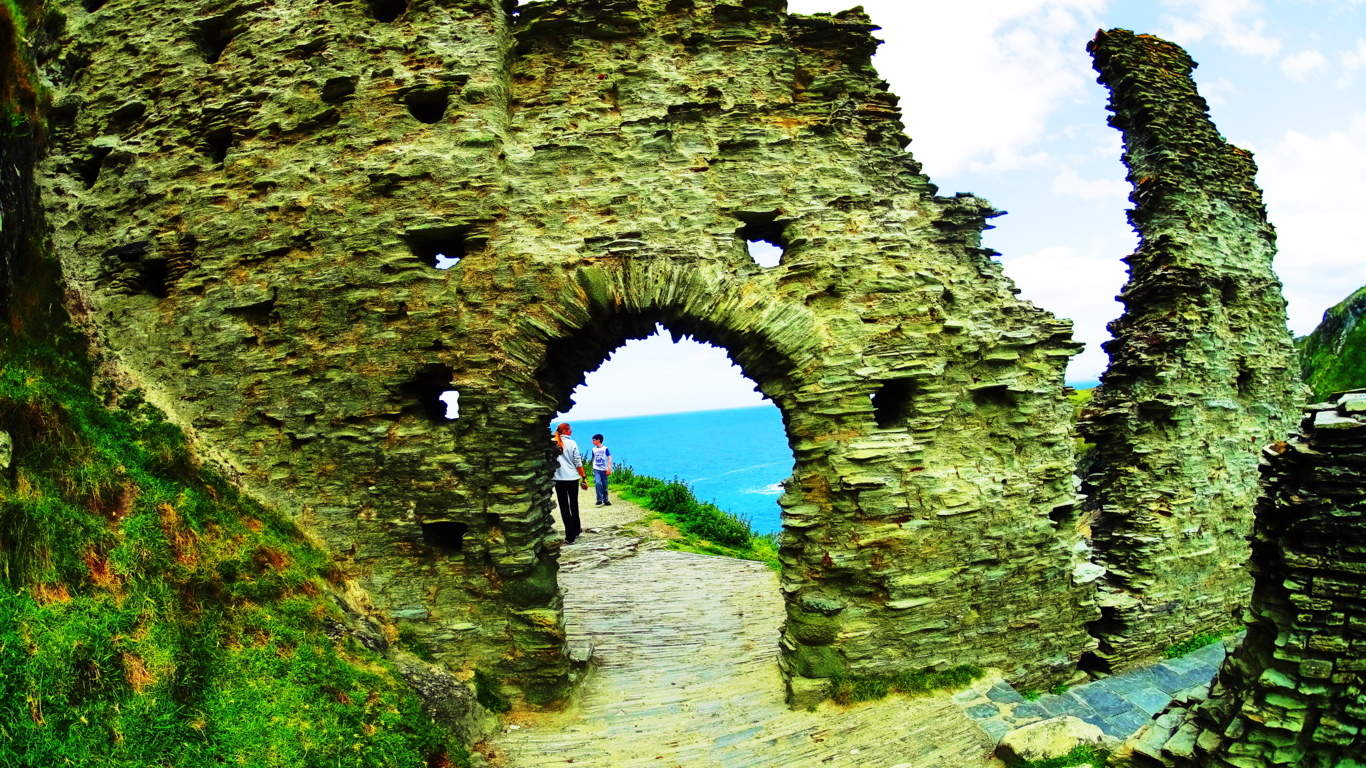 This rare archaeological site contains priceless remains of a Celtic Castle, one of the earliest Christian monastery’s in history, and Medieval period stonework. Almost every Celtic myth has origins here, including perhaps the most epic of all, The Arthur Legend. The story goes that Sir Gorlois, the Duke of ancient Cornwall, locked his wife Igrain in Tintagel while away battling for the Kingship of all England. Sir Uther Pendragon then disguised himself to look like the Duke by the magic of the legendary Druid Merlin, who lived below in the caves. Uther crossed the deep chasm of the bay on a magical mist created by Merlin. and entered the castle to conceive a child with Igrain. The child born of this intense mystical situation would be the legendary King Arthur. The myth of Sir Gawain and The Green Knight also began here. It is from this castle that Gawain sets off to find the ethereal crystal castle of the Green Knight, somewhere to the north, perhaps in Wales.
This rare archaeological site contains priceless remains of a Celtic Castle, one of the earliest Christian monastery’s in history, and Medieval period stonework. Almost every Celtic myth has origins here, including perhaps the most epic of all, The Arthur Legend. The story goes that Sir Gorlois, the Duke of ancient Cornwall, locked his wife Igrain in Tintagel while away battling for the Kingship of all England. Sir Uther Pendragon then disguised himself to look like the Duke by the magic of the legendary Druid Merlin, who lived below in the caves. Uther crossed the deep chasm of the bay on a magical mist created by Merlin. and entered the castle to conceive a child with Igrain. The child born of this intense mystical situation would be the legendary King Arthur. The myth of Sir Gawain and The Green Knight also began here. It is from this castle that Gawain sets off to find the ethereal crystal castle of the Green Knight, somewhere to the north, perhaps in Wales.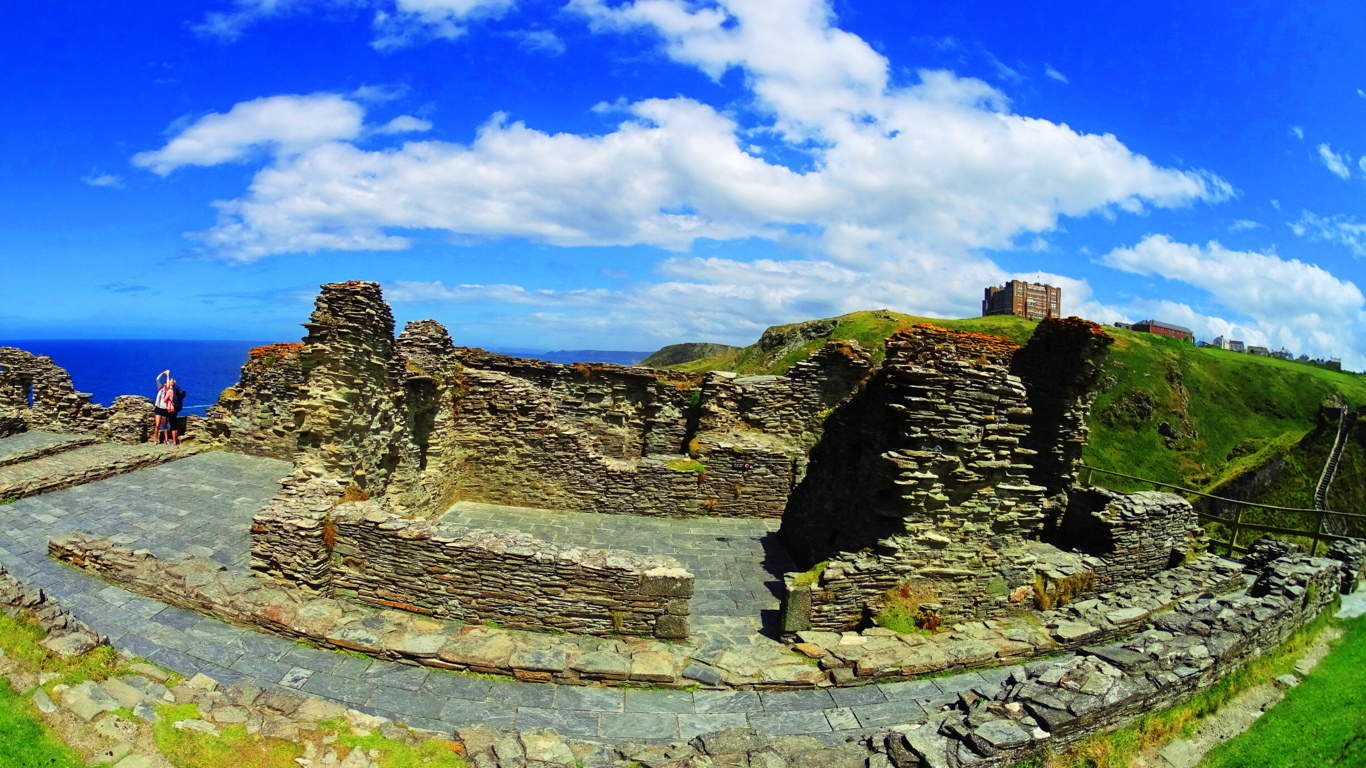 In recent years archaeologists unearthed a piece of Cornish slate with a version of the name ‘Arthur’ written on it, as well as items from France, Spain, and Ireland, indicating that this was an extremely busy and successful international seaport. These upper paths run for about a mile-and-a-half around the south-east edge of the island, with wild goats grazing, and gorgeous views of the blue-green Irish Sea.
In recent years archaeologists unearthed a piece of Cornish slate with a version of the name ‘Arthur’ written on it, as well as items from France, Spain, and Ireland, indicating that this was an extremely busy and successful international seaport. These upper paths run for about a mile-and-a-half around the south-east edge of the island, with wild goats grazing, and gorgeous views of the blue-green Irish Sea.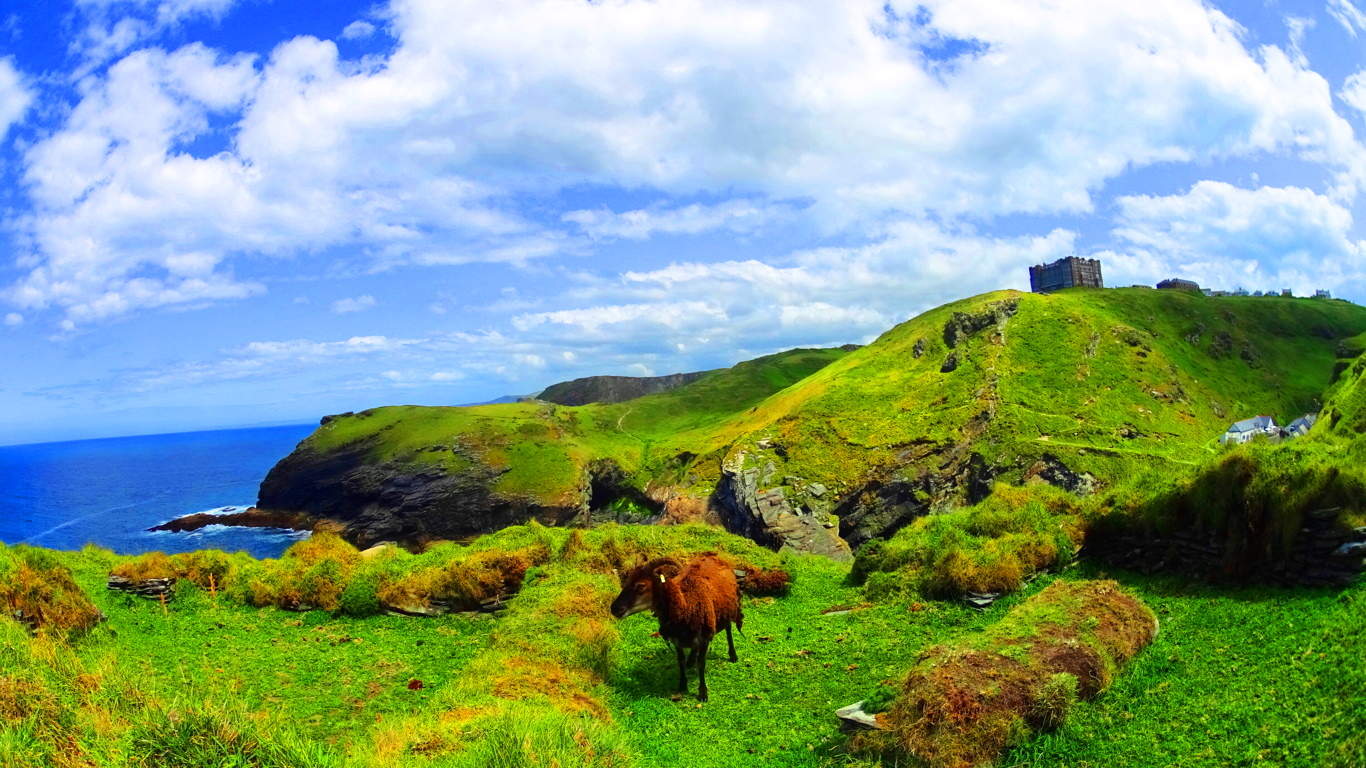 Once you’ve made your way around the Castle island, work your way down one of the most picturesque bays in England. With the Castle ruins looming over the entire scene, it is easy to see why the ancients chose this place to live.
Once you’ve made your way around the Castle island, work your way down one of the most picturesque bays in England. With the Castle ruins looming over the entire scene, it is easy to see why the ancients chose this place to live.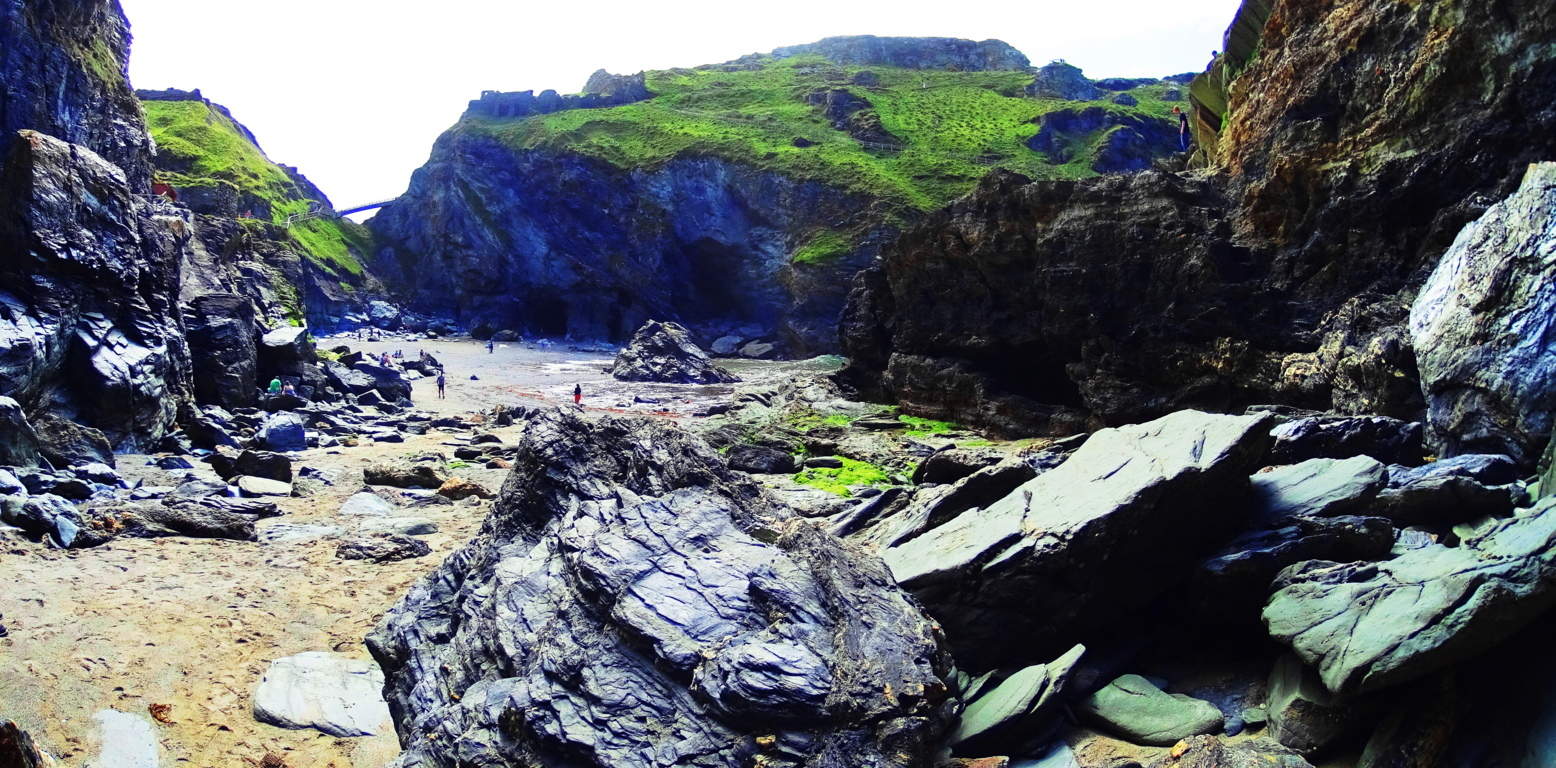 Freshwater streams roll down to the beach. Massive free-sitting boulders guard the cave entrances, along with mysterious standing-stones interlocked along the beach and rocks (top images). This interlocking style is very similar to the standing stones at the sacred alter in Heath Massachusetts, across the Atlantic. The boulders are sitting above other rock faces (pictured below), and centrally to the entire scene, as if they were placed. This is, again, very similar to boulders at other megalithic sites. These are specifically placed stones that date back to pre-Celtic times, associated with giants, when England was known as Albion, meaning, “Land of Giants.”
Freshwater streams roll down to the beach. Massive free-sitting boulders guard the cave entrances, along with mysterious standing-stones interlocked along the beach and rocks (top images). This interlocking style is very similar to the standing stones at the sacred alter in Heath Massachusetts, across the Atlantic. The boulders are sitting above other rock faces (pictured below), and centrally to the entire scene, as if they were placed. This is, again, very similar to boulders at other megalithic sites. These are specifically placed stones that date back to pre-Celtic times, associated with giants, when England was known as Albion, meaning, “Land of Giants.”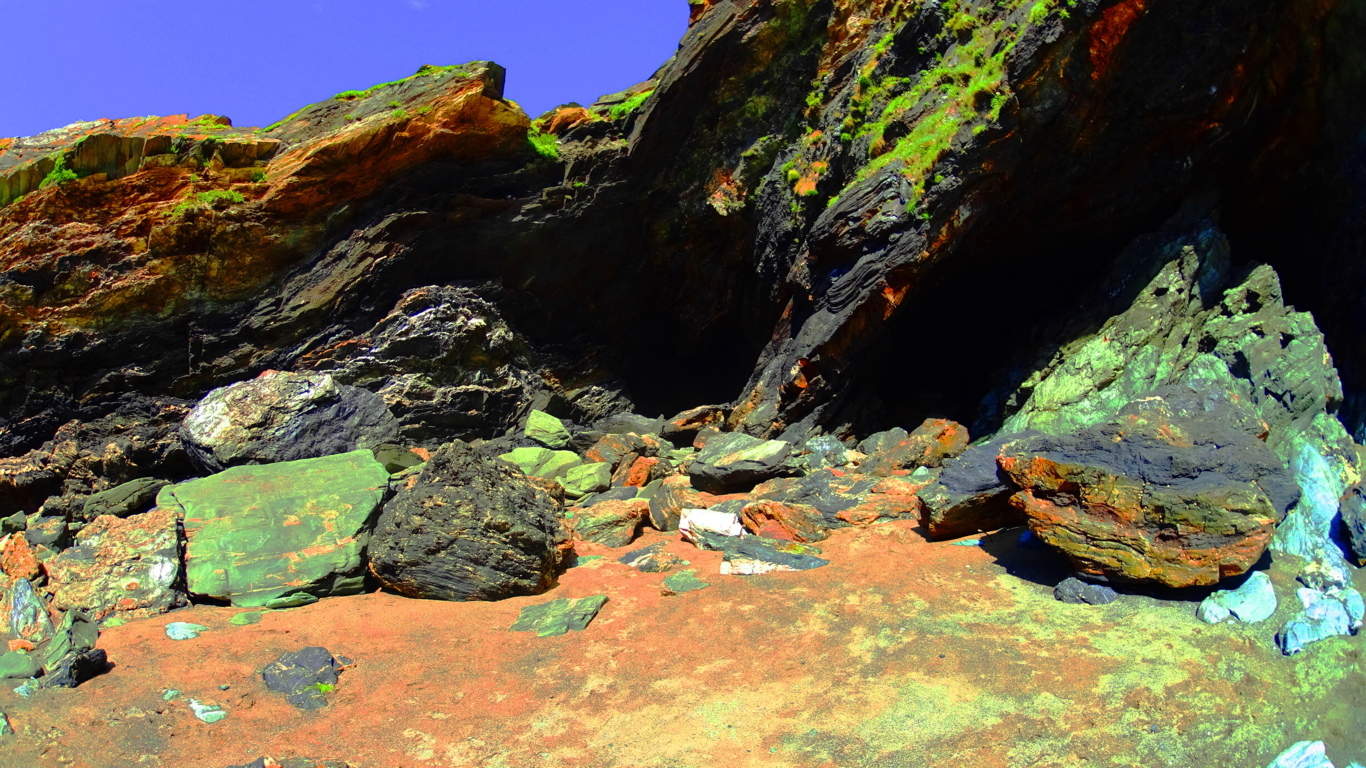 This beach is filled with white sand and mesmerizing tidal flow from the Celtic Sea, which paces everything like a hypnotic dream. You may very well find people reciting poetry about the birth of King Arthur on the beach, or getting some sun.
This beach is filled with white sand and mesmerizing tidal flow from the Celtic Sea, which paces everything like a hypnotic dream. You may very well find people reciting poetry about the birth of King Arthur on the beach, or getting some sun. 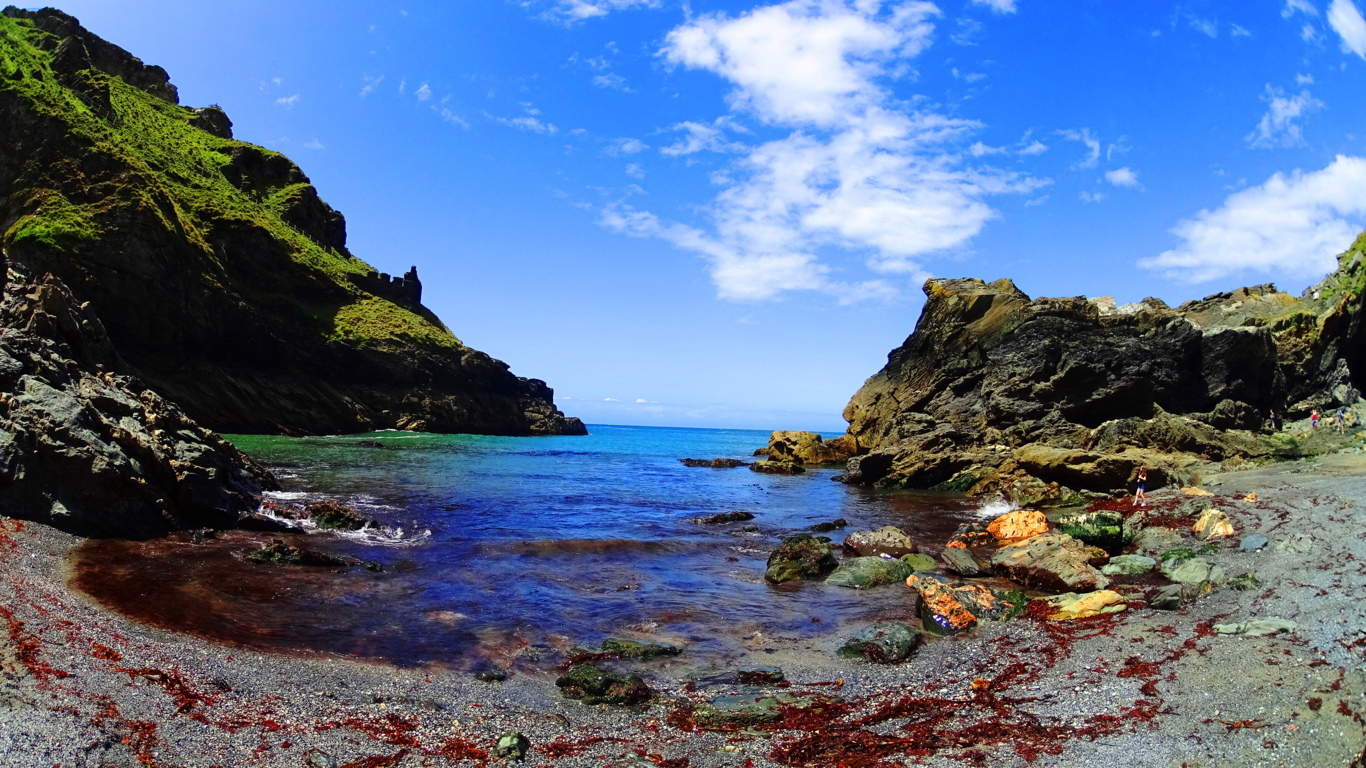 This is a place to take your time and revel in the history and scenery. The entire excursion is about 4.5 miles worth of hiking, after making your way back to town. The energy at Tintagel is palpable. Here you don’t just get an epic glimpse of how things once were in simpler times before the modern world had its way, you feel it.
This is a place to take your time and revel in the history and scenery. The entire excursion is about 4.5 miles worth of hiking, after making your way back to town. The energy at Tintagel is palpable. Here you don’t just get an epic glimpse of how things once were in simpler times before the modern world had its way, you feel it.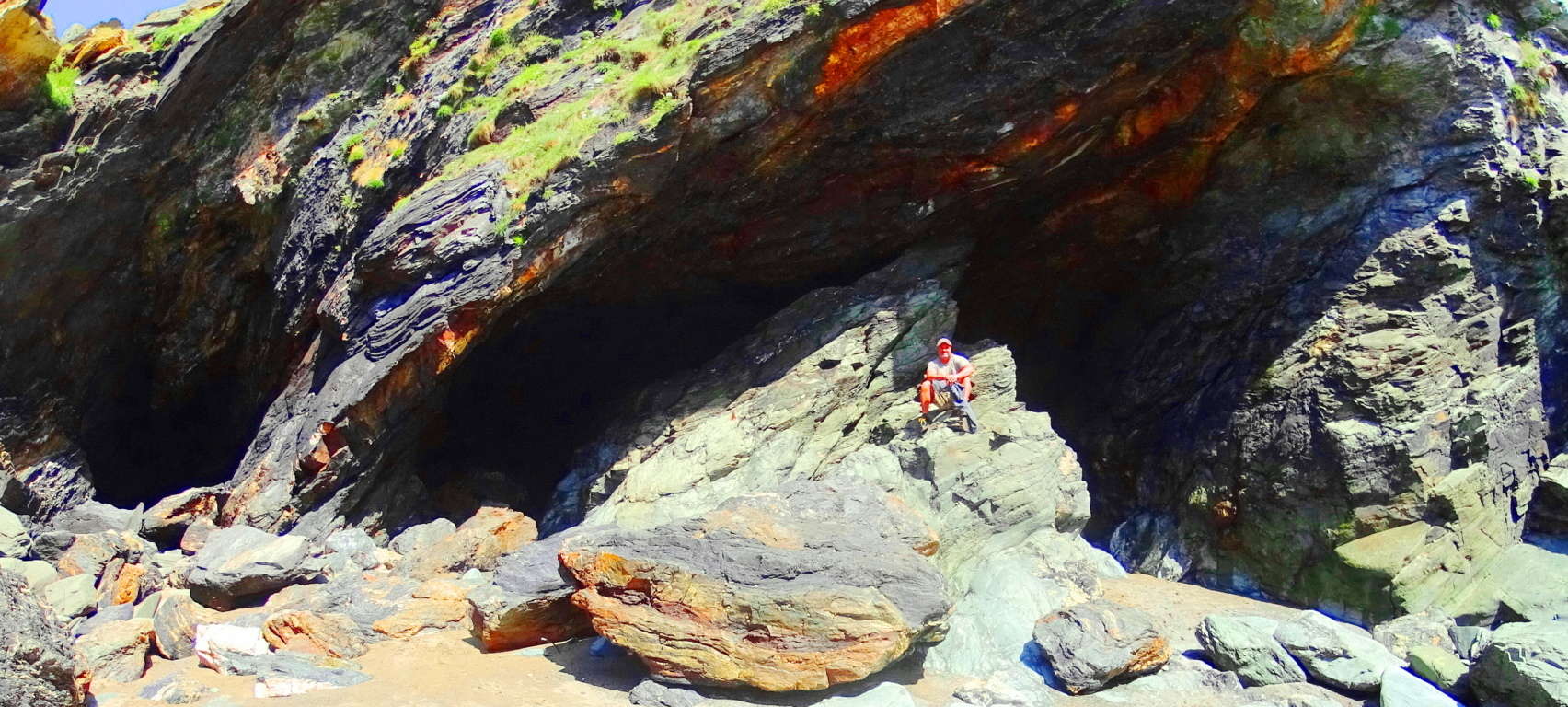
Watatic Mountain
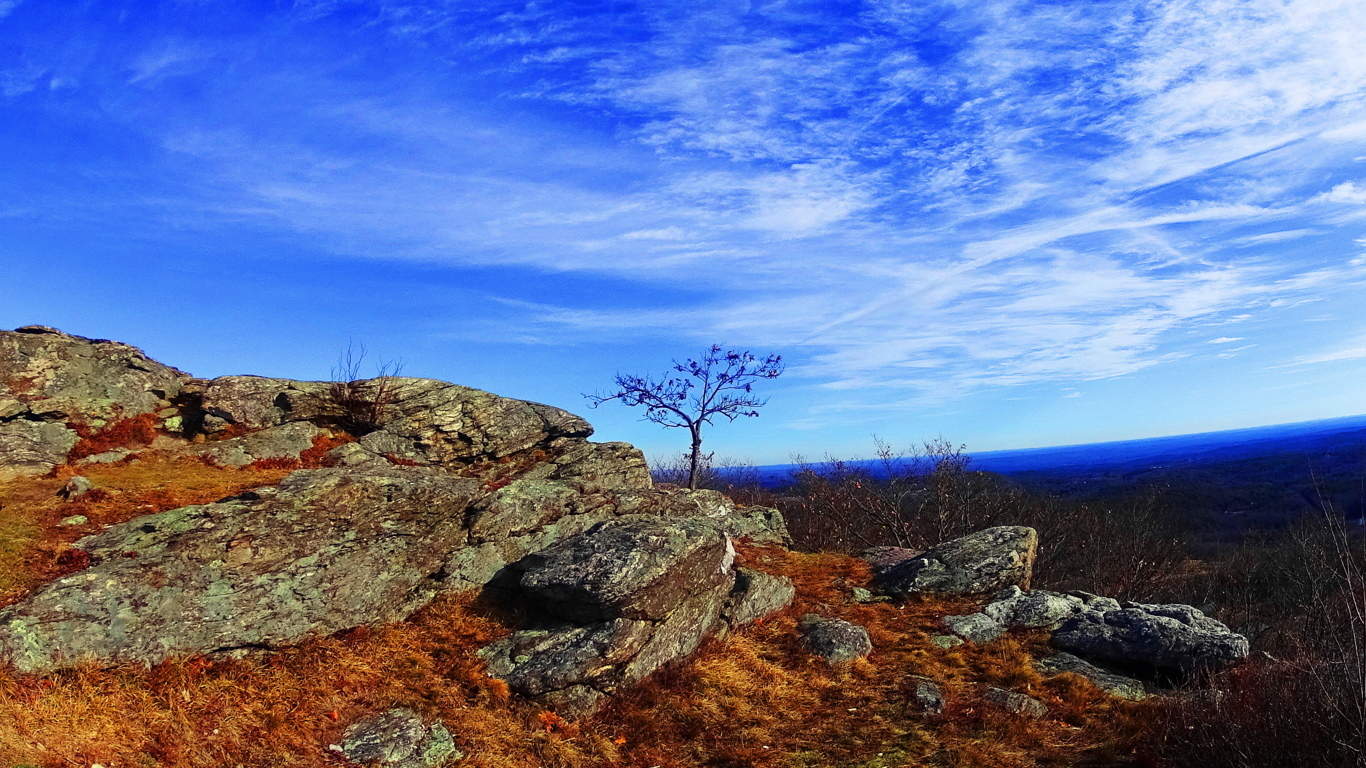 Location: Ashburnham Massachusetts, U.S.A
Location: Ashburnham Massachusetts, U.S.A
Elevation: !,831 feet.
Note: Massachusetts is a haven for the ‘small mountain’ experience, with most trails peaking under 2,000 feet. For hikers with the right vision, the experience on the trails is by no means small, however. A mysterious megalithic culture existed once on the rocky peaks, pine forests, and hilly river-valleys of this area. Strongest similarities show up across the Atlantic in the ancient Celtic elevations. The climb to the top of Watatic Mountain will grant you a great view of the State of Vermont to the north. In Autumn it is a visual miasma of colors, increasing the value of the trail exponentially. The main trail is called Nutting Hill, which is just over three miles long, half of which is just about straight up, so be prepared. The megaliths are here too, making this an anthropological experience. To begin, at ground level a set of small ponds accept the run-off from the mountain. The rocky mountainside deflects the wind coming from the north, stilling the ponds surface like glass as you pass by.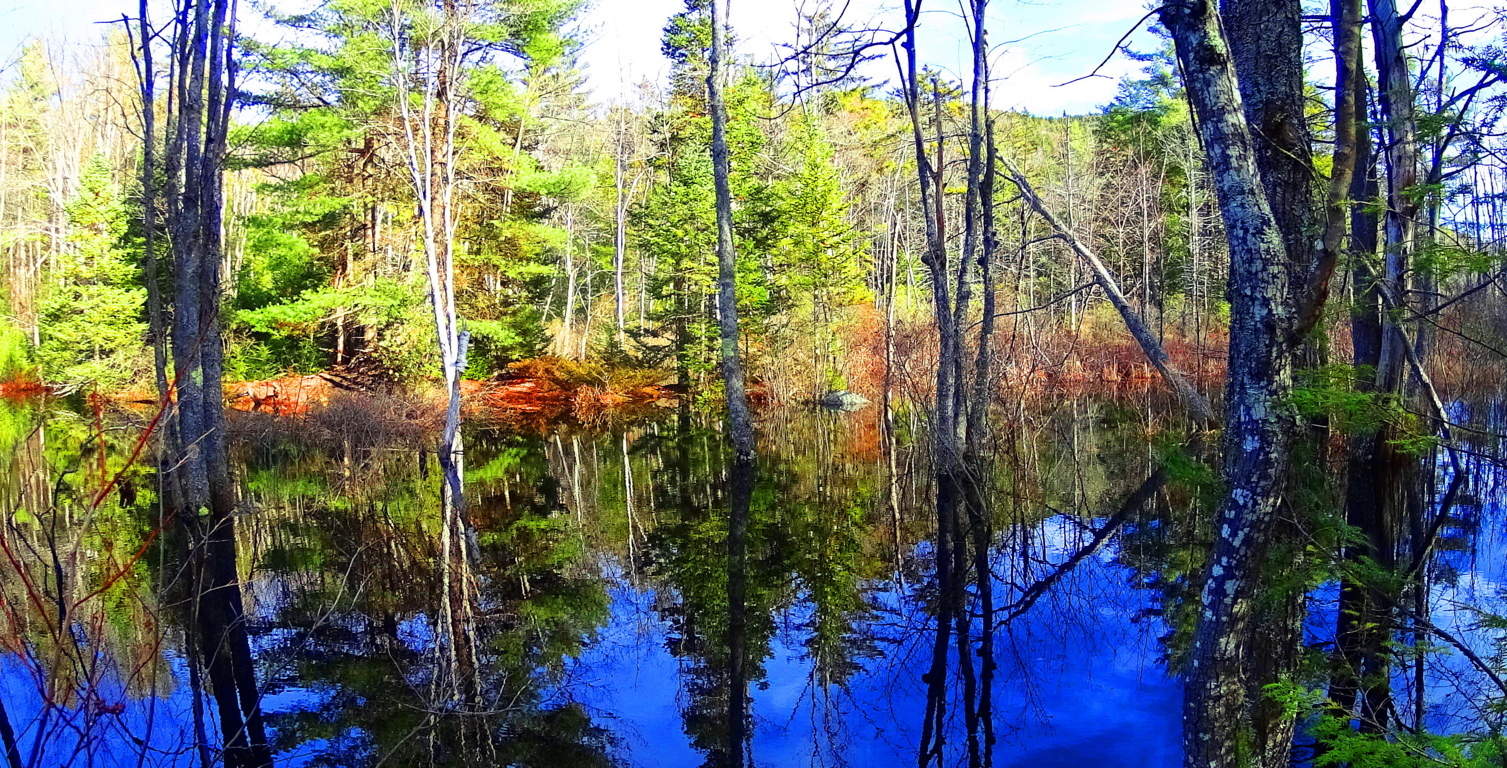 The level portion of the trail, just past the water, is only about 150 yards. Immediately strange stone fixtures protrude through the leaves all around. Among these fixtures are more significant signs of “signatures”, or specifically stylized workings in the stone. The ‘X’, or “diamond cross-section” is one of the most popular types.
The level portion of the trail, just past the water, is only about 150 yards. Immediately strange stone fixtures protrude through the leaves all around. Among these fixtures are more significant signs of “signatures”, or specifically stylized workings in the stone. The ‘X’, or “diamond cross-section” is one of the most popular types.
To look at these “X” sections it is nearly impossible to believe that they were created by ‘glacial displacement’. They create symmetries not only on the stones that they are carved into, but also in the stones within the vicinity of that particular signature. They are found on almost every Massachusetts trail where there is significant rock formations, both in the heights, and valleys.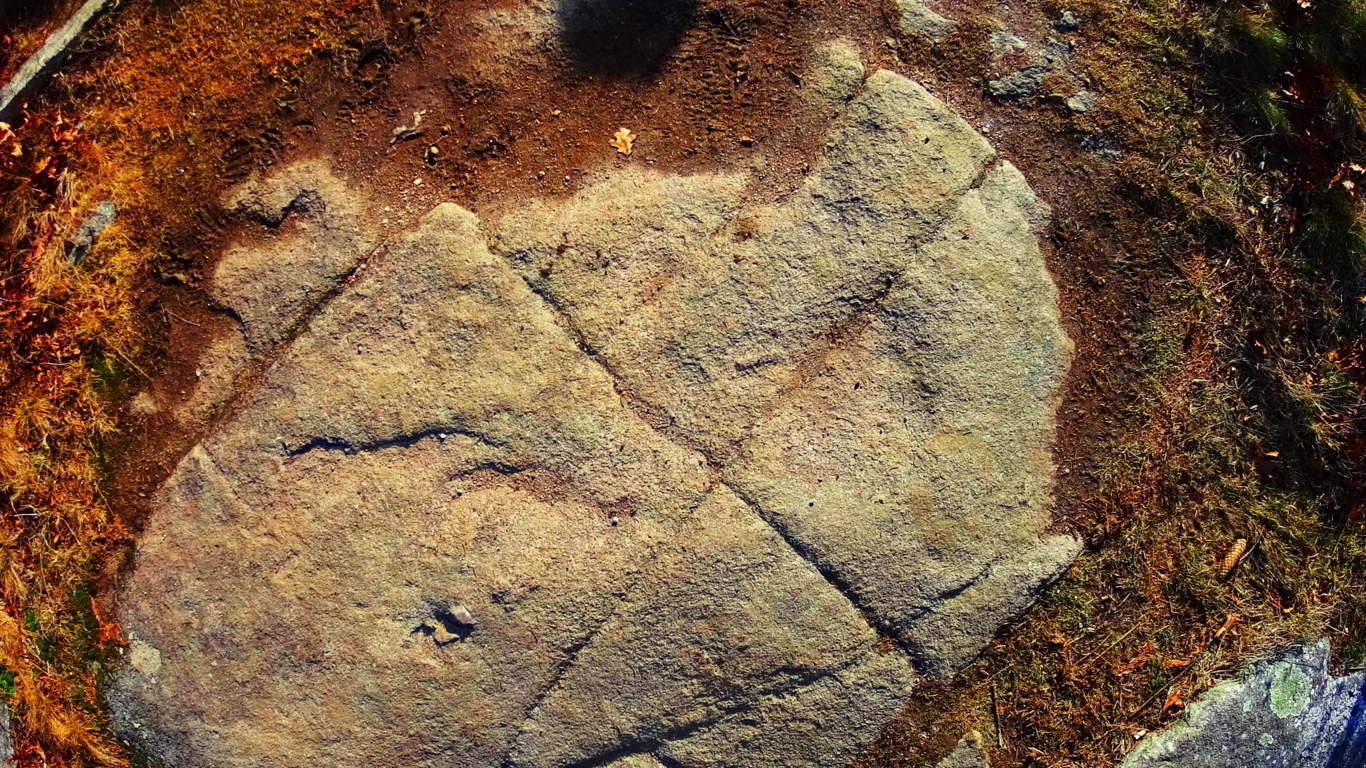 They are also found in the Celtic heights of Ireland.
They are also found in the Celtic heights of Ireland.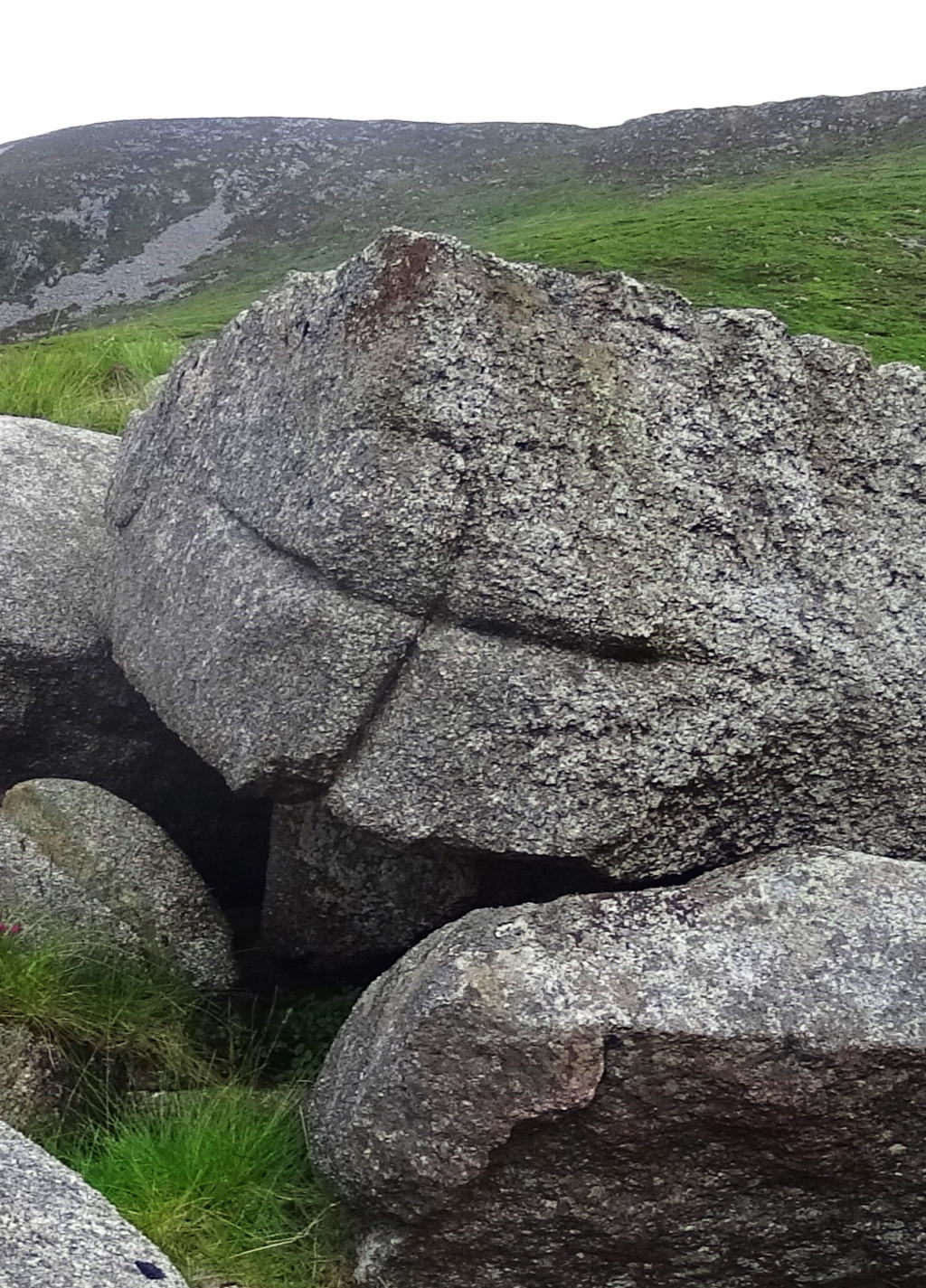 One possibility about the meaning of the “cross section” is that it is a type of utility that insures that if the section is cut, regardless of size, the remaining pieces will fit together if used to build other structures, such as stone-linings (“walls”), dwellings, or irrigation stones. Several examples of this “X” cross section from Watatic are shown here above, as well as one from the heights in the Mourn Mountains in Ireland (right). Before ascension on the trail begins, a classic megalith in the form of a smoothly split boulder, roughly 10 to 15 tons in weight, sits at the base of the mountain, like a gateway. The stone path literally passes straight through this massive cut boulder.
One possibility about the meaning of the “cross section” is that it is a type of utility that insures that if the section is cut, regardless of size, the remaining pieces will fit together if used to build other structures, such as stone-linings (“walls”), dwellings, or irrigation stones. Several examples of this “X” cross section from Watatic are shown here above, as well as one from the heights in the Mourn Mountains in Ireland (right). Before ascension on the trail begins, a classic megalith in the form of a smoothly split boulder, roughly 10 to 15 tons in weight, sits at the base of the mountain, like a gateway. The stone path literally passes straight through this massive cut boulder. If you stop to examine the area around this megalith, you will find several “cross-sections” waiting to be observed. Continuing, as you begin to climb, a beautiful old-forest glade of pines emerges, and the path becomes wider and rockier. For roughly a mile you will work your way through these pines. Interestingly enough, it is not until you reach about 1,400 feet in elevation, that a “stone-lining” emerges.
If you stop to examine the area around this megalith, you will find several “cross-sections” waiting to be observed. Continuing, as you begin to climb, a beautiful old-forest glade of pines emerges, and the path becomes wider and rockier. For roughly a mile you will work your way through these pines. Interestingly enough, it is not until you reach about 1,400 feet in elevation, that a “stone-lining” emerges.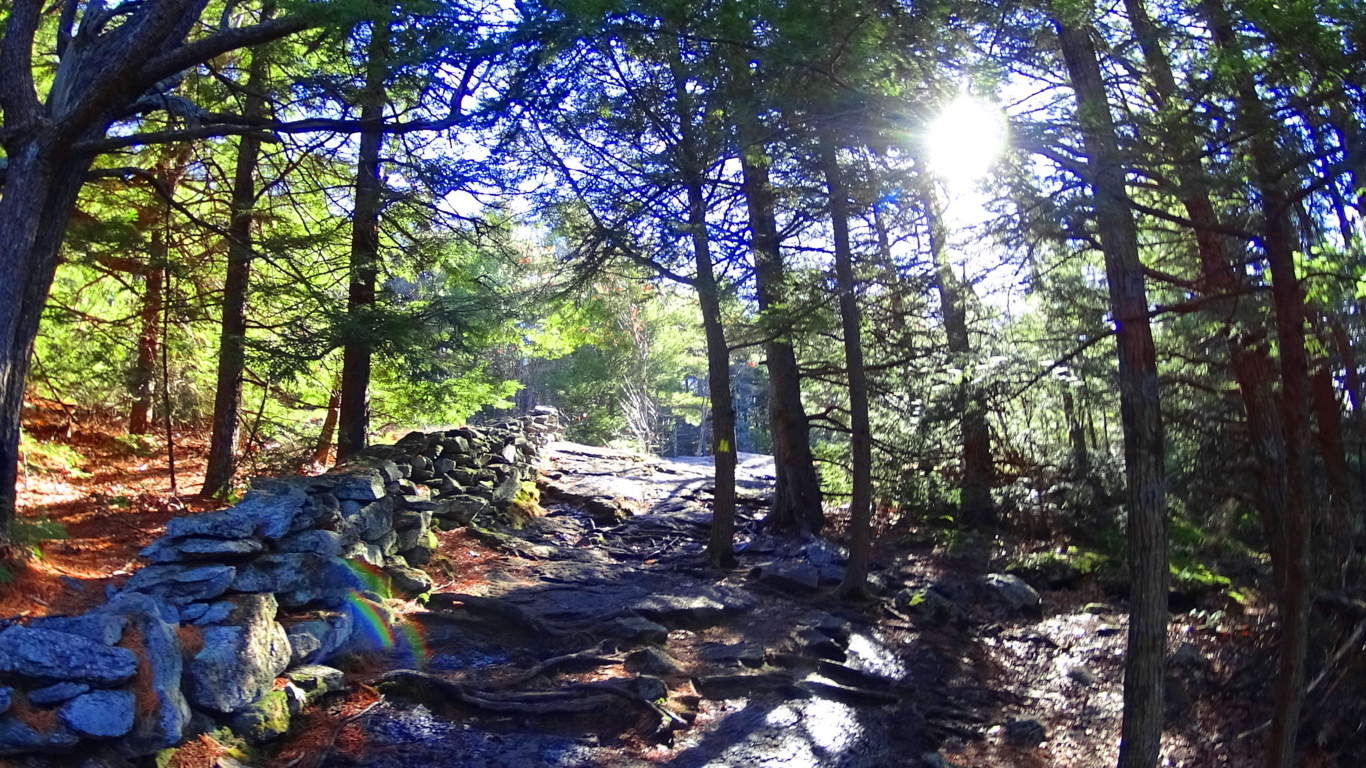 This particular “stone-lining” is another strong piece of evidence against the idea that this type of feature is not a “wall” by any means. It became clear that this feature ran circularly around the dome of the mountain, like a crown on a head. No colonial farm has ever existed at the top of this fairly narrow set of circular porches at Watatic Mountain, where there is no elevated water reserve or pasturing possibility. The case for this being the work of a colonial farmer marking off his territory is illogical. It would be a triply arduous task for any laborer to first gather enough semi-megalithic size stones to lay a three foot high, two foot thick, pile of massive cut rocks around the full circumference of the mountain, at an elevation of about 1,400 feet.
This particular “stone-lining” is another strong piece of evidence against the idea that this type of feature is not a “wall” by any means. It became clear that this feature ran circularly around the dome of the mountain, like a crown on a head. No colonial farm has ever existed at the top of this fairly narrow set of circular porches at Watatic Mountain, where there is no elevated water reserve or pasturing possibility. The case for this being the work of a colonial farmer marking off his territory is illogical. It would be a triply arduous task for any laborer to first gather enough semi-megalithic size stones to lay a three foot high, two foot thick, pile of massive cut rocks around the full circumference of the mountain, at an elevation of about 1,400 feet.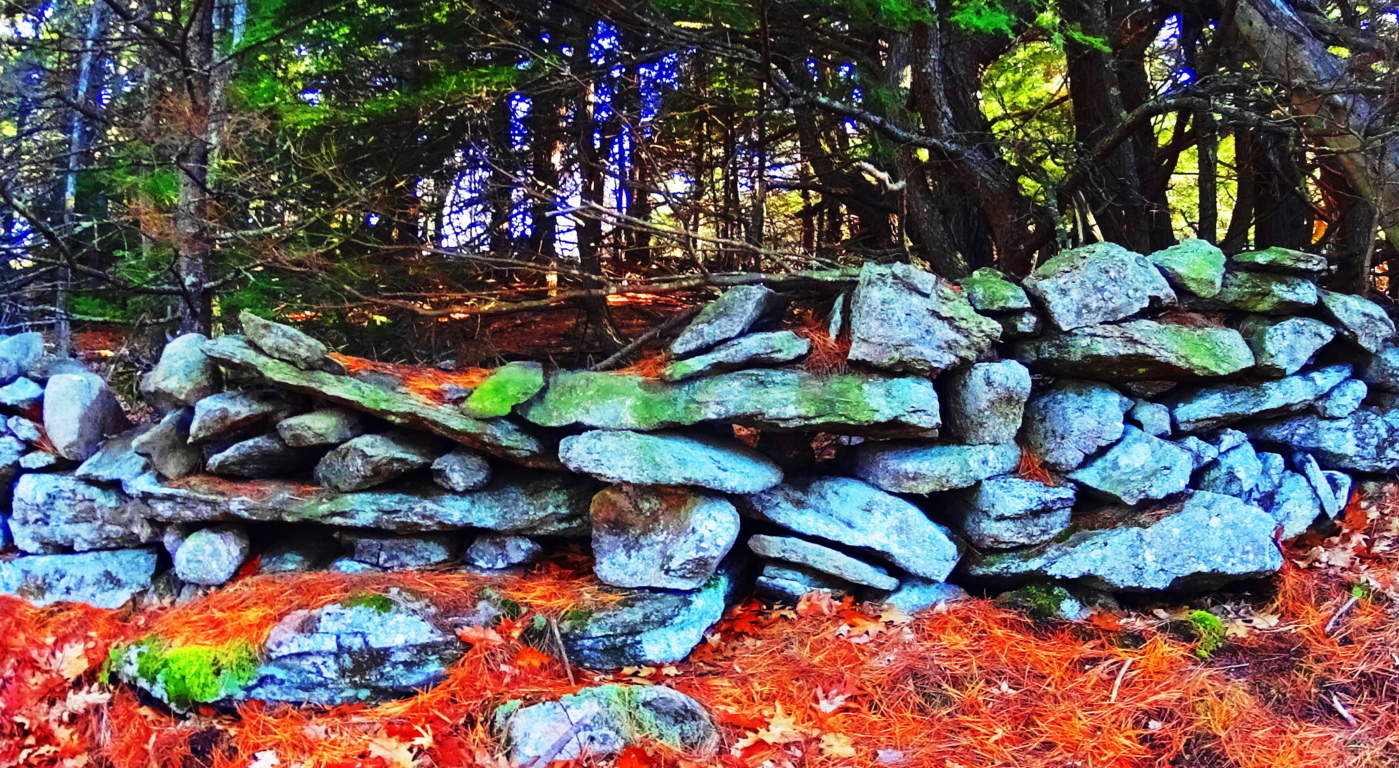 There are no signs that these stones were quarried at the top of Watatic, so they must have come from below. From below, after being crafted, piled, and gathered, the stones would have to be CARRIED UP, AND ALL THE WAY AROUND THE PEAK at an incline of roughly 60 degrees. If a laborer did manage to achieve this impossible feat, actually laying the stones, which weigh anywhere from 50 to 700 pounds each, it would take them a lifetime. Colonial living is an essay in practicality. Labors in Colonial times were conserved to efforts that yielded real sustenance, like digging wells for water, building barns for dairy and protein conservation, and clearing fields for crops. Building a stone wall for no reason around a mountain-side at 1400 feet, where there is no pasture, but only rock, would have been illogical, wasteful, and impractical to the point of preposterous. Something else is going on with these megalithic stone-linings. In places like Cavan Burren National Park in Ireland (Shown in green/right),
There are no signs that these stones were quarried at the top of Watatic, so they must have come from below. From below, after being crafted, piled, and gathered, the stones would have to be CARRIED UP, AND ALL THE WAY AROUND THE PEAK at an incline of roughly 60 degrees. If a laborer did manage to achieve this impossible feat, actually laying the stones, which weigh anywhere from 50 to 700 pounds each, it would take them a lifetime. Colonial living is an essay in practicality. Labors in Colonial times were conserved to efforts that yielded real sustenance, like digging wells for water, building barns for dairy and protein conservation, and clearing fields for crops. Building a stone wall for no reason around a mountain-side at 1400 feet, where there is no pasture, but only rock, would have been illogical, wasteful, and impractical to the point of preposterous. Something else is going on with these megalithic stone-linings. In places like Cavan Burren National Park in Ireland (Shown in green/right),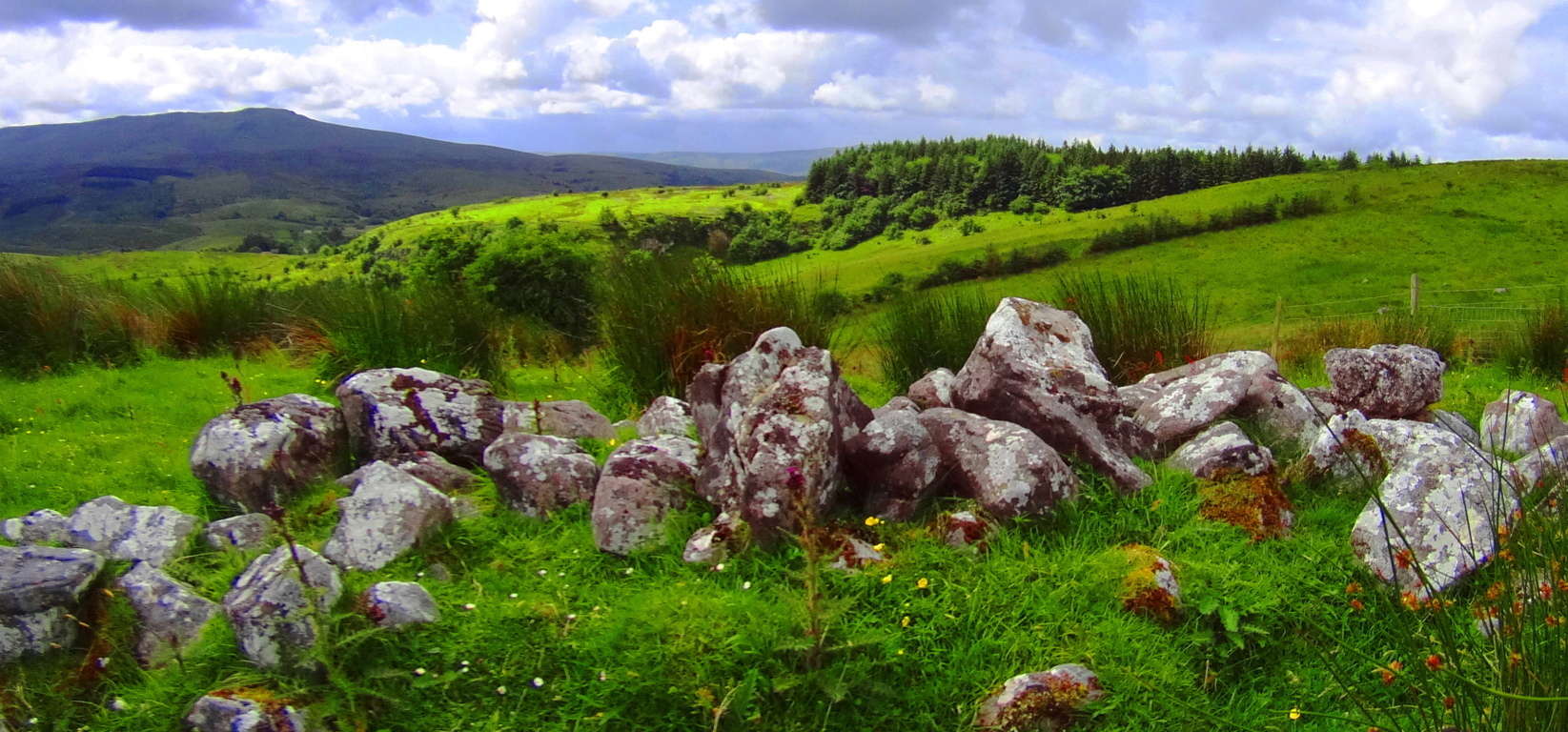 as well as the Blue Hills in south-east Massachusetts (Shown in red and orange, below/left), and the Mourn Mountains in Northern Ireland (Shown in green/left)
as well as the Blue Hills in south-east Massachusetts (Shown in red and orange, below/left), and the Mourn Mountains in Northern Ireland (Shown in green/left)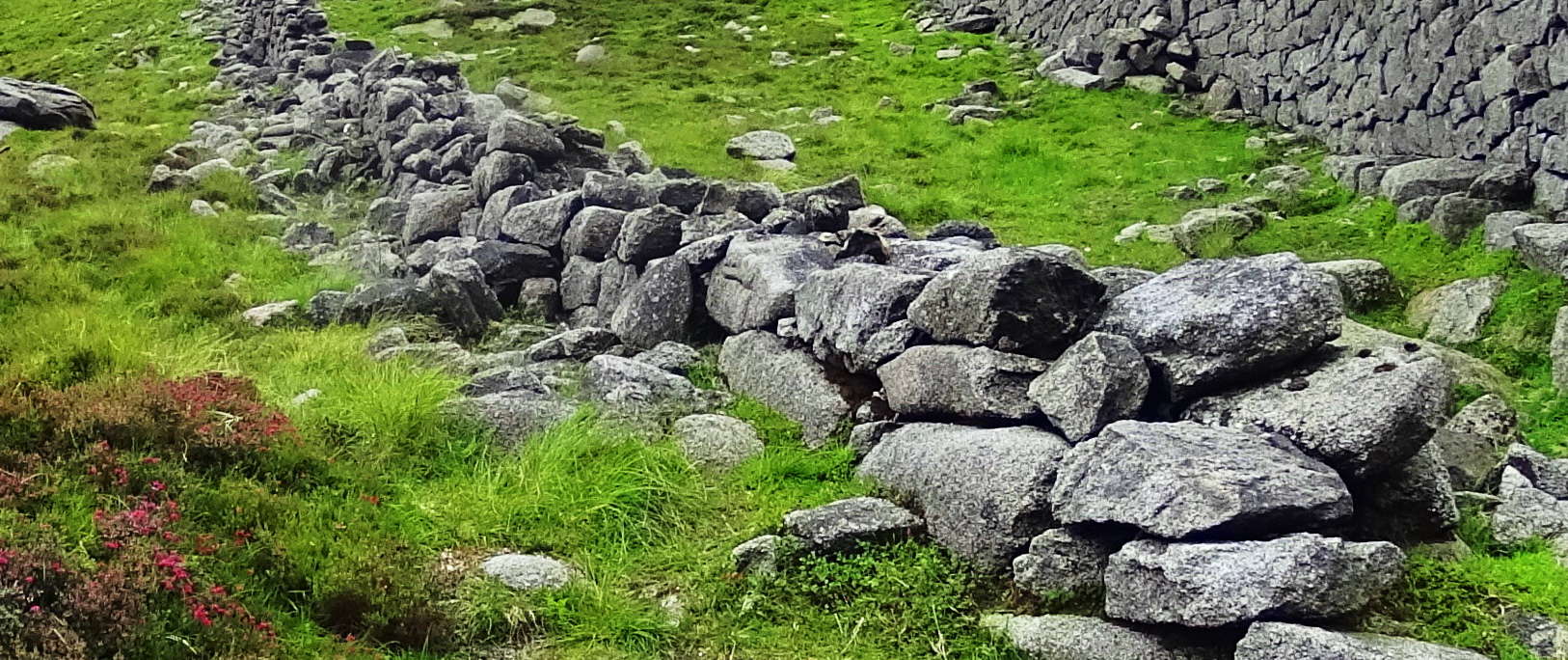 , stone lining seem to be energy connectors, or containers of energy in certain spaces.
, stone lining seem to be energy connectors, or containers of energy in certain spaces.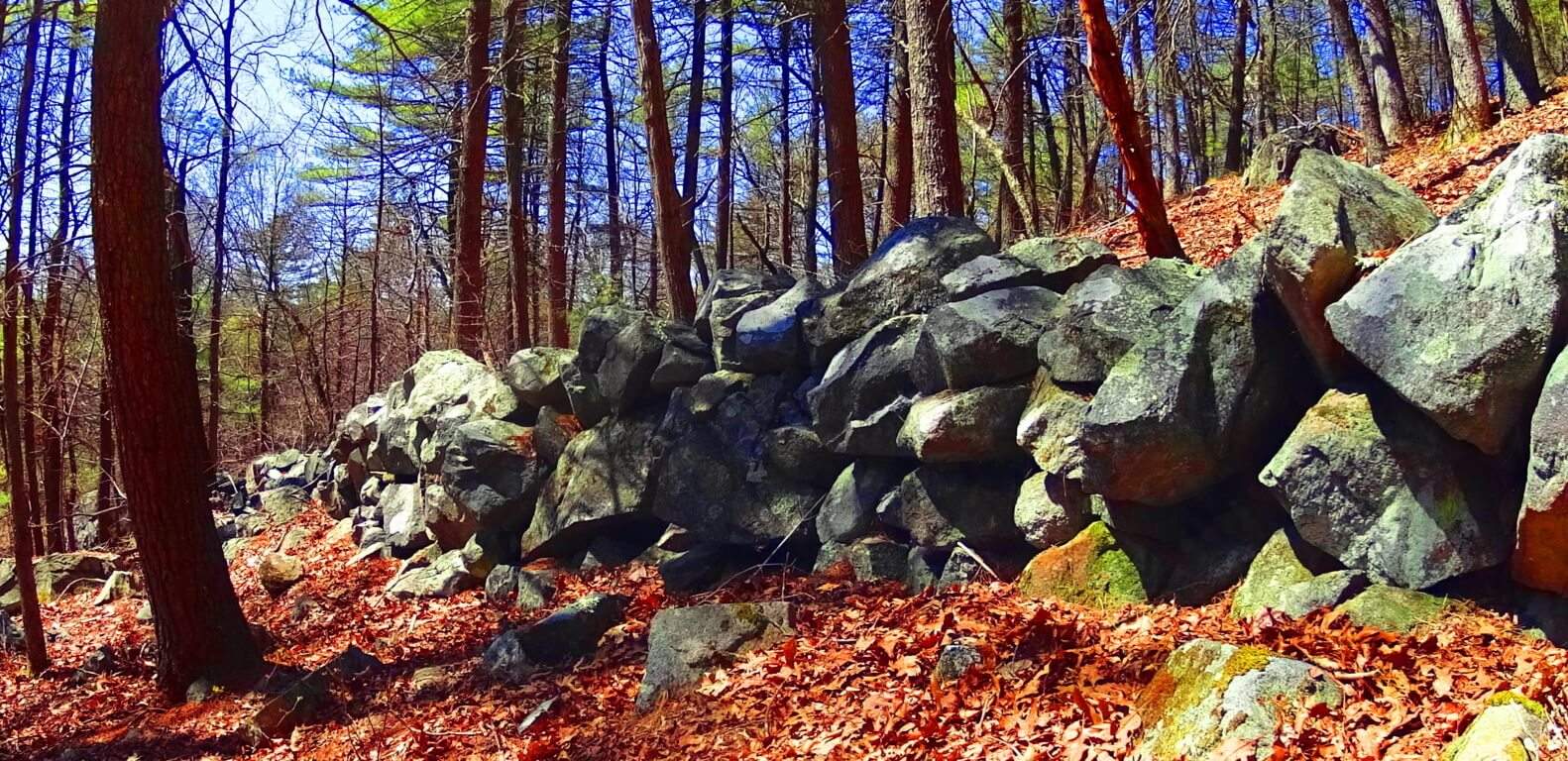 All of these linings are at significant elevations, and are not capable of containing any kind of herds; And this is what is happening at 1,400 feet on Watatic Mountain. Whoever set the stones in place wanted us to understand that the space created within the circle is a sacred energy center, charging the elevated dome of the Mountain with subtle energies. Continuing on again, after passing this 1,400 feet mark, your path will follow the stone-lining for about 100 yards until you cross-over into this special zone. At 1,650 feet there is beautiful Celtic style standing-stone just off to left of the path.
All of these linings are at significant elevations, and are not capable of containing any kind of herds; And this is what is happening at 1,400 feet on Watatic Mountain. Whoever set the stones in place wanted us to understand that the space created within the circle is a sacred energy center, charging the elevated dome of the Mountain with subtle energies. Continuing on again, after passing this 1,400 feet mark, your path will follow the stone-lining for about 100 yards until you cross-over into this special zone. At 1,650 feet there is beautiful Celtic style standing-stone just off to left of the path.
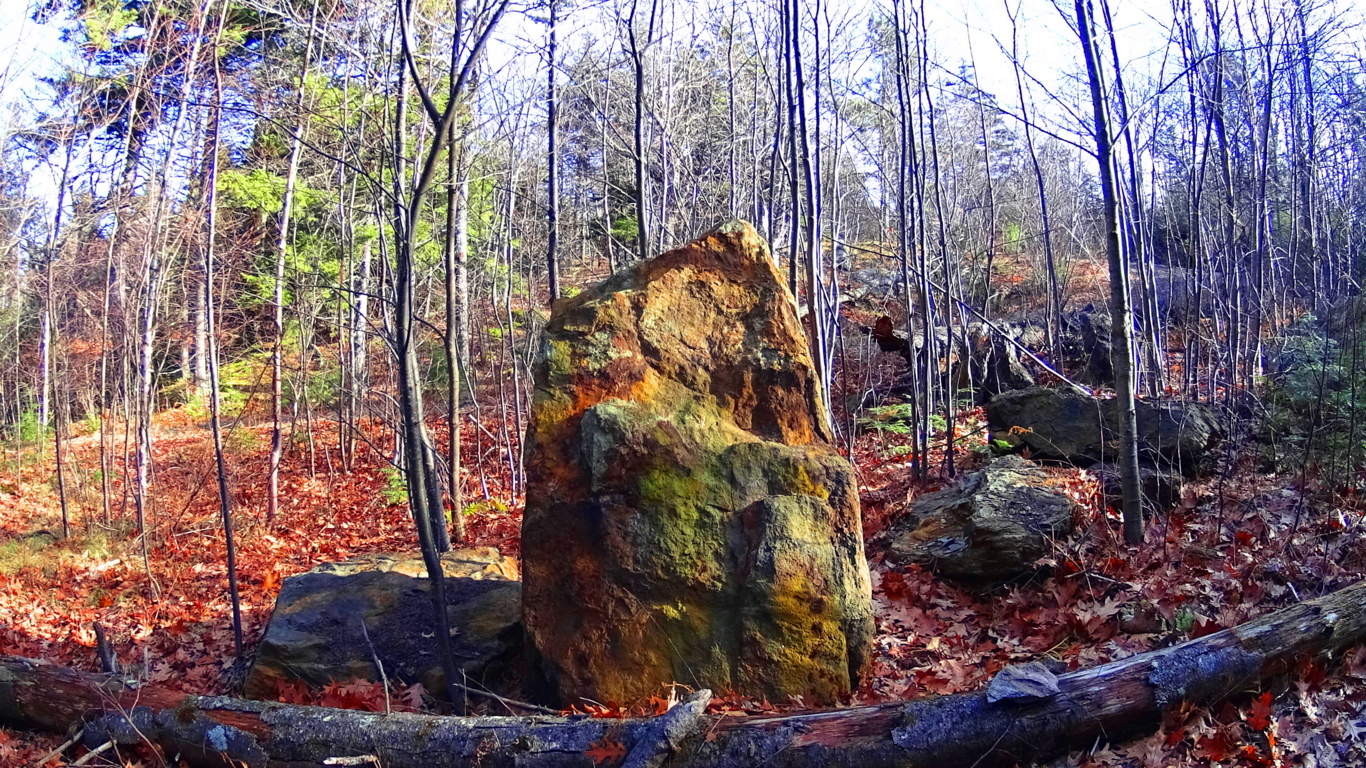 It stands 6 feet tall, and perhaps 7 feet in width, with a distinctly cut ‘face’ supported by a rotund rear side.
It stands 6 feet tall, and perhaps 7 feet in width, with a distinctly cut ‘face’ supported by a rotund rear side.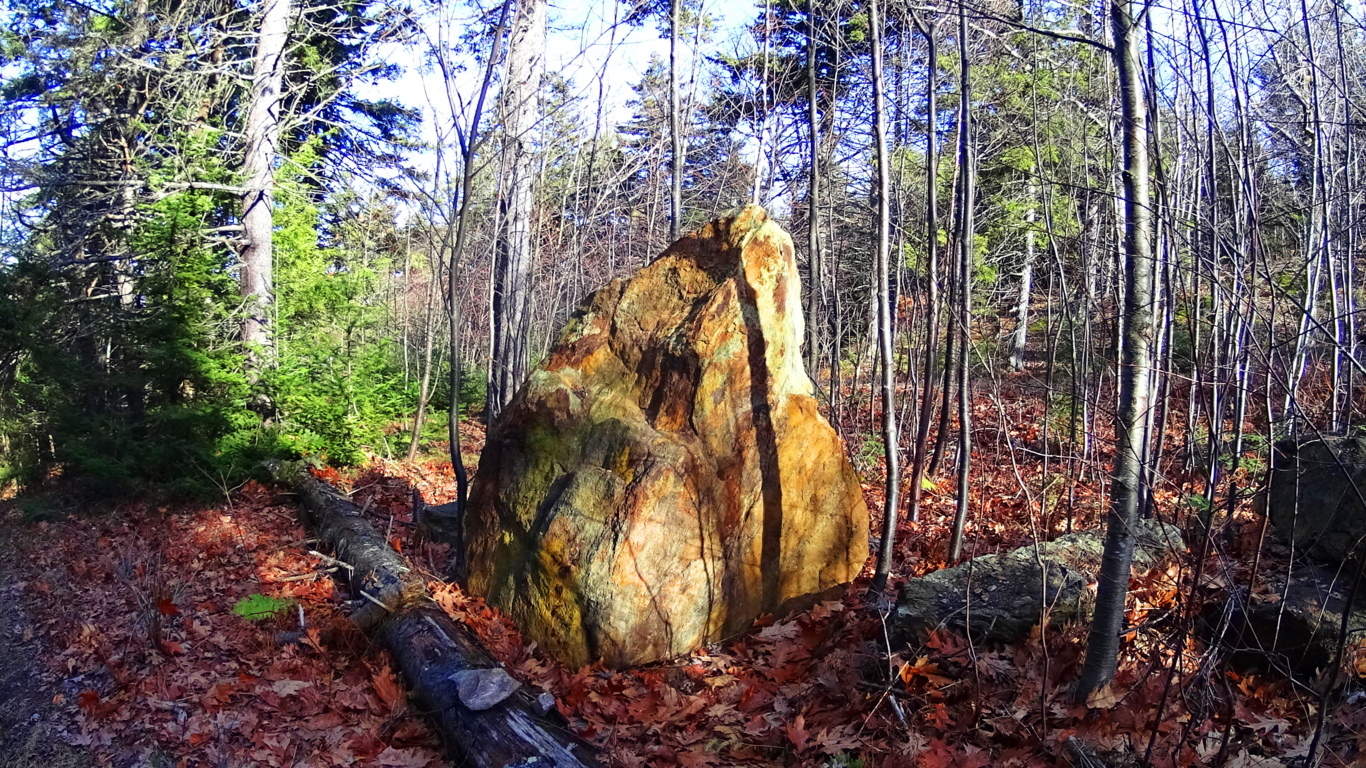 This exact style of “cut-facing with “rotund-rearing” can be found in a gorgeous diamond shaped, white standing-stone, along the castle trail at Glenveagh National Park in Ireland, (shown here in the next two images below).
This exact style of “cut-facing with “rotund-rearing” can be found in a gorgeous diamond shaped, white standing-stone, along the castle trail at Glenveagh National Park in Ireland, (shown here in the next two images below).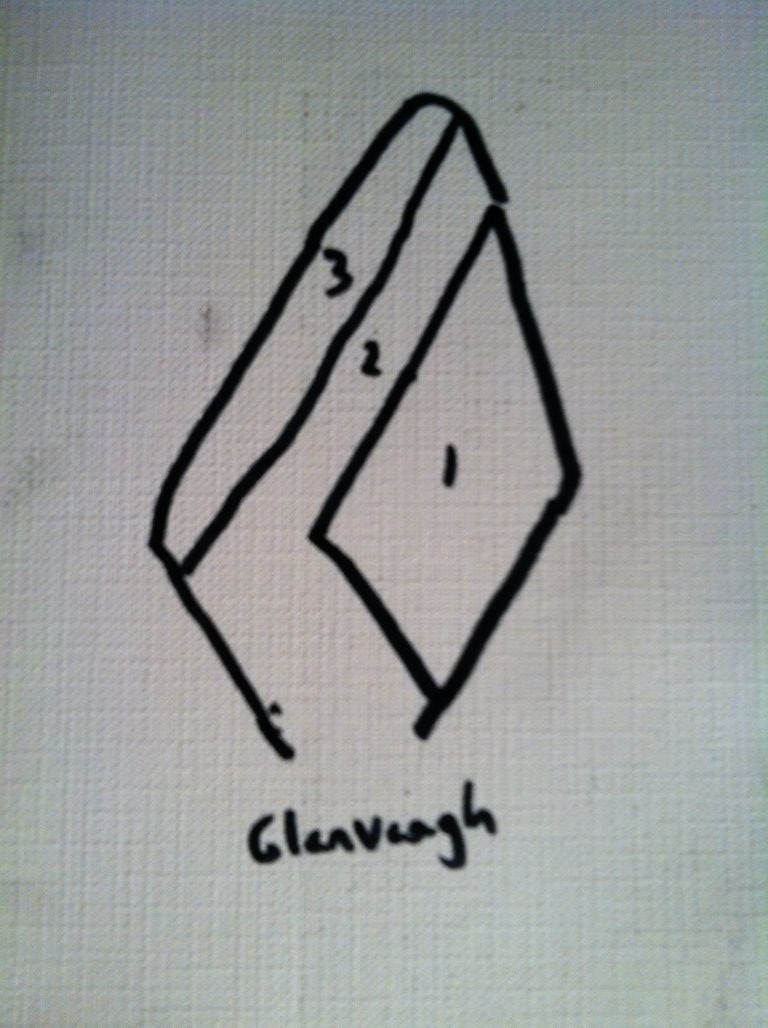
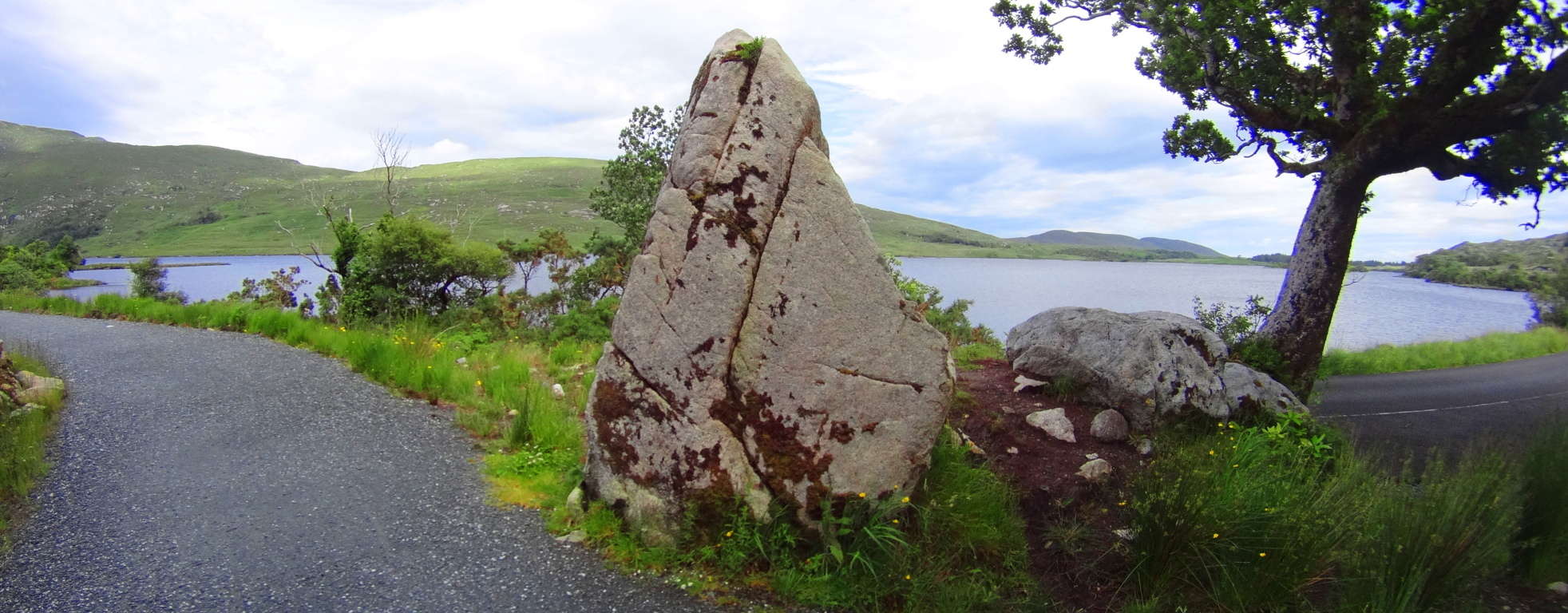
It is impossible to miss the distinctness of the “face” side with the “supporting rounded-rear side” in both stones, and therefor the similarity in craftsmanship. This is pretty solid evidence that the designers of these standing-stones had almost exactly the same knowledge about crafting them, as if they were from the same culture, although separated by an ocean. This is where the story of the Nephilim, as the first anthropological society on Earth, becomes relevant. Obviously the standing-stone at Watatic is so weathered by thousands of years of foliage layered on its distinct face, that it is practically camouflaged into the overgrowth, covering what looks to be pink granite beneath the grime, as opposed to the marble clarity of the Celtic stone, that has not experienced New England foliage. 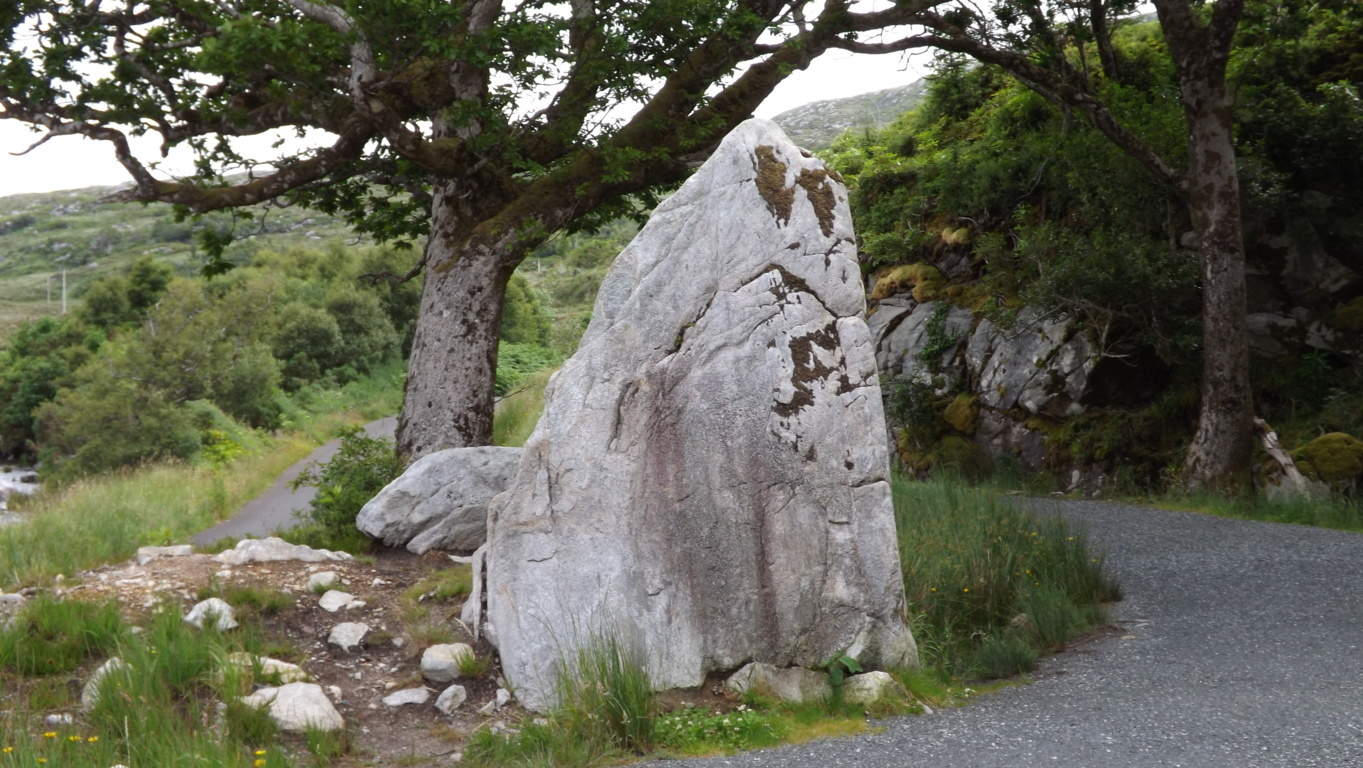 The standing-stone indicates, especailly at such an elevation, that this was once an incredibly endeared and valued space to whoever inhabited it. Finally, a quaintly cut-stone staircase climbs up to the last portion of the heights.
The standing-stone indicates, especailly at such an elevation, that this was once an incredibly endeared and valued space to whoever inhabited it. Finally, a quaintly cut-stone staircase climbs up to the last portion of the heights.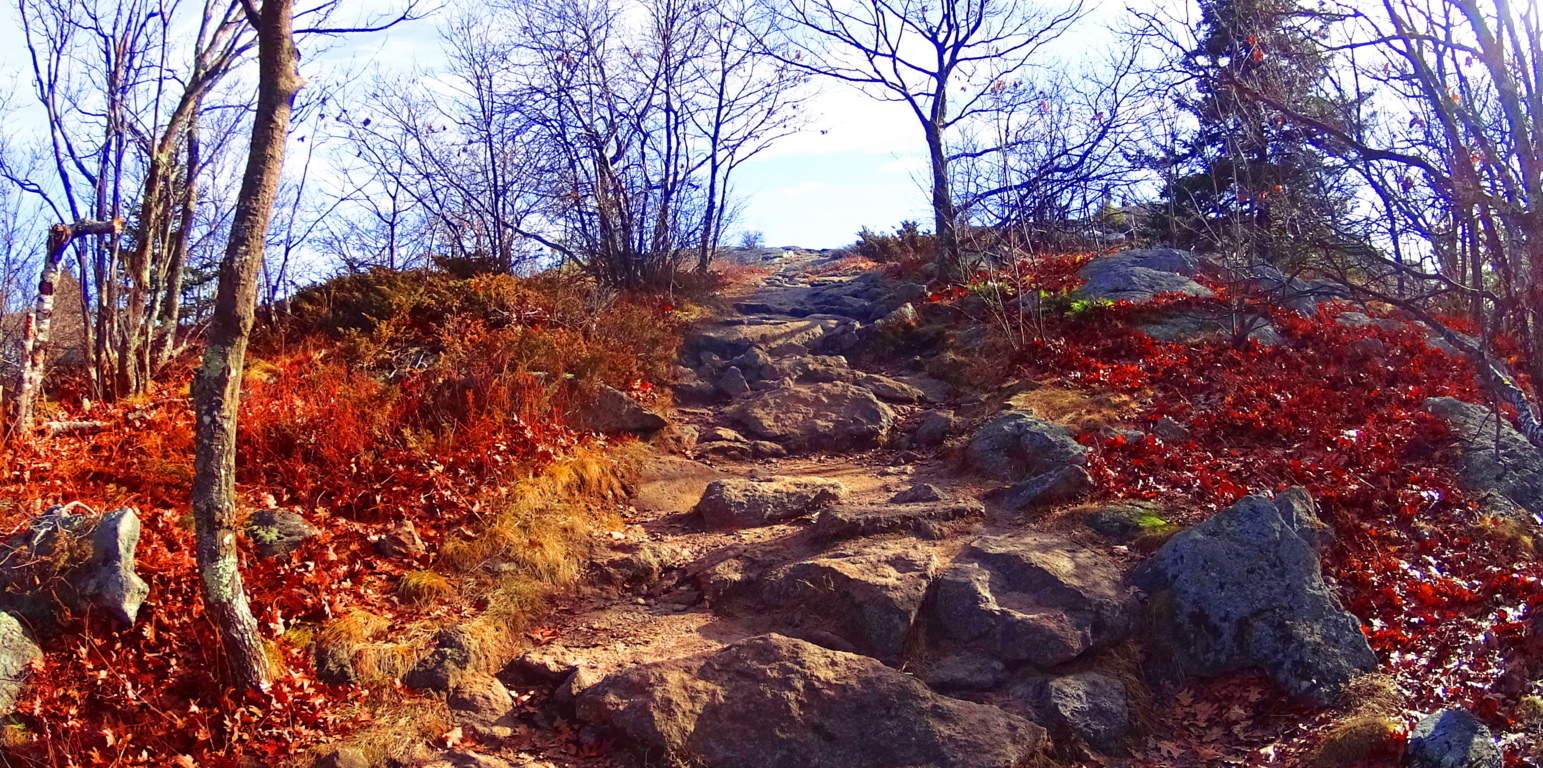 Here you will arrive at a grand porch with a 360 degree view. The rocky trail continues to a larger secondary porch, 50 yards south, lined with pines and rounded granite floors.
Here you will arrive at a grand porch with a 360 degree view. The rocky trail continues to a larger secondary porch, 50 yards south, lined with pines and rounded granite floors. It is well worth the effort to reach the top. Watatic is an essential “small mountain” experience in Massachusetts, literally crowned by ancient megalithic stones. Take a day and see for yourself, you won’t be disappointed.
It is well worth the effort to reach the top. Watatic is an essential “small mountain” experience in Massachusetts, literally crowned by ancient megalithic stones. Take a day and see for yourself, you won’t be disappointed.